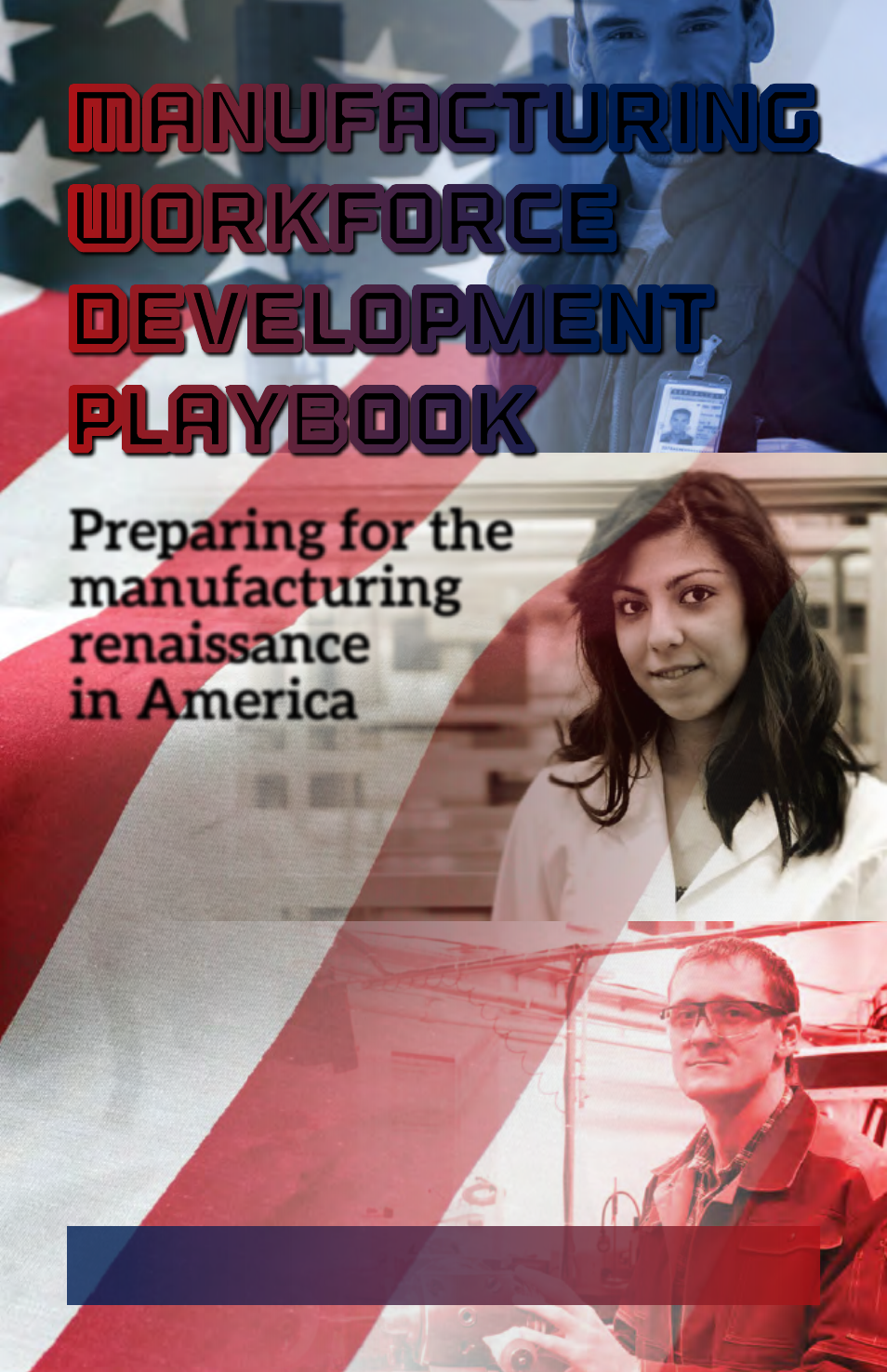
1
Manufacturing Workforce Development Playbook
Manufacturing
Workforce
Development
Playbook
Preparing for the
manufacturing
renaissance
in America
Edited by Keith S. Campbell

K
eith Campbell’s Manufacturing Workforce Development Playbook is a mul-chapter homage to the
revitalizaon of American manufacturing and how local communies are creang programs to get the
skilled workforce that companies need to build and grow. The authors recognize that workforce needs vary
across regions, but they present enough knowledge so that no one has to start at square one. From creang and
sustaining partnerships to building mul-disciplinary teams to just learning the translaons between “business
speak” and workforce and educaon jargon, reading this book will give you both a validaon of what you have
been doing right and an idea of how to move forward. The book illustrates how workforce professionals build
world-class instrucon and training quickly and then adapt what they have done to meet the ever-changing needs
and priories of their business partners. This is praccal advice from praccing experts, and I believe that the
result is something that every area with a growing manufacturing employer base, regardless of size, can use.
Jane Oates, Vice President for External Affairs, Apollo Group, Inc.
Formerly Assistant Secretary, Employment and Training Administration, U.S. Department of Labor.
“T
he pipeline of talented workers is the single greatest factor in the growth and vitality of our
economy. Campbell’s Playbook is a thorough analysis of how the manufacturing industry is trying to close
its skills gap. Campbell and his contributors prove that the best method to developing a lasng talent pipeline
for manufacturing is to bring together employers, educators, and community leaders to align manufacturing
educaon and training with industry standards.”
Jennifer M. McNelly, President, The Manufacturing Institute
I
t is easy for me to support the Manufacturing Workforce Development Playbook because it focuses much-
needed aenon on the hard work required by all stakeholders if we hope to keep U.S. manufacturing strong.
The Playbook’s message is consistent with my belief that we must all work together for an educated workforce.
Together we can reach our goal of keeping creave, challenging, and excing manufacturing jobs
in the United States.
Nick Wilson, President, Morrison Container Handling Solutions
Reviews
Reviews continue on the back cover
K
eith Campbell’s Playbook clearly arculates the fundamental needs of today’s manufacturers. It’s no secret
that an engaged and skilled workforce is a requirement to be a successful manufacturer. The current workforce
has to have the right skill sets to keep manufacturing a viable contributor to our economy. Each puzzle piece of the
Playbook highlights requirements for educaon, government, and industry to create long-term favorable soluons
to workforce development. We are experiencing a great loss in technical talent with Baby Boomer rerements.
Without suitable replacements, the future of manufacturing is suspect. Keith and his team of authors are
commied to America’s manufacturing prosperity.
Rob Harrison, Pepperidge Farm Plant Manager
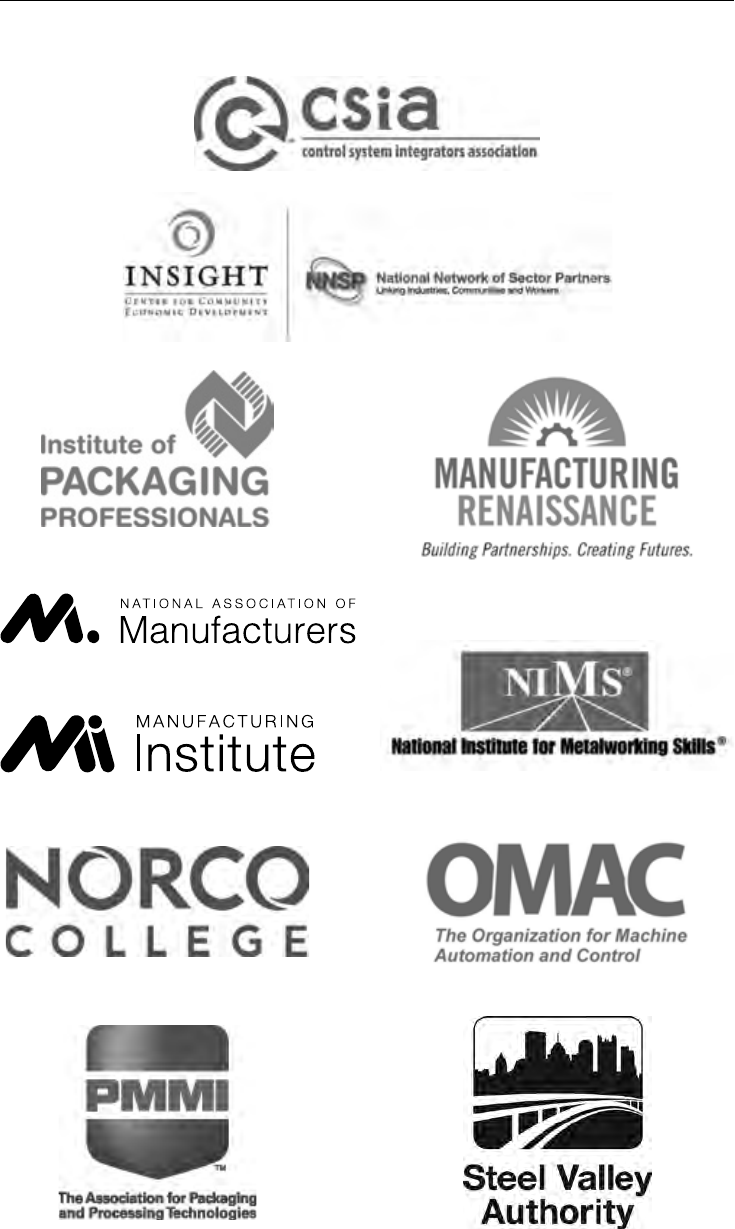
Supporters

Copyright © 2014 First Edition, by Summit Media Group, Inc. All Rights Reserved.
Manufacturing Workforce
Development Playbook
Keith S. Campbell
Summit Media Group, Inc.
330 North Wabash Avenue
Chicago, Illinois 60611 USA
Tel: 312.222.1010
Fax: 312.222.1310
ISBN 978-0-9903288-0-3
Cover and book design by Filippo Riello
Printed in the United States of America
A portion of net proceeds of this book will go
to the David A. Harvey Memorial Scholarship
to help fund workforce development efforts.
Materials in the publication must not be reproduced in any form
without written permission of the publisher.
Additional copies are available at the IoPP bookstore at http://www.iopp.org/bookstore
Discounts available for educational and not-for-prot organizations.
Please contact Summit Media Group at workfor[email protected] or go to
http://www.packworld.com/workforce for more information.
Manufacturing
Workforce
Development
Playbook
Preparing for the
manufacturing
renaissance
in America
Edited by Keith S. Campbell

Table of Contents
Before You Begin
Foreword by Keith S. Campbell
How to approach this Playbook and solve your puzzle.
Why this Playbook?
Chapter One by Daniel W. Fogarty
The crical shortage of manufacturing skills due to changes
in demographics, technology, and atudes.
Manufacturing is Complicated
Chapter Two by Keith S. Campbell
There are no one-size-ts-all soluons. Know your needs
and know your customers.
Manufacturing Career Pathways
Chapter Three by Sco J. Sheely
Where do manufacturing workers come from,
and how do they advance?
Preparing America for 21st Century
Global Compeveness
Chapter Four by William C. Symonds
The Pathways to Prosperity Report from the Harvard Graduate School of
Educaon points out where America stands on a global basis and suggests
changes we need to make.
The Role of the Workforce System
and How it has Changed
Chapter Five by Edward J. McCann
The system has changed, and those of us who have always been employed
may have missed that fact.
Manufacturing: By the Numbers
Chapter Six by Sco J. Sheely
Data can help manufacturers jusfy their needs and help educators
put the right programs in the right place.
p. 12
p. 14
p. 22
p. 30
p. 36
p. 42
p. 48
Perspectives

Table of Contents
p. 56
p. 62
p. 70
p. 78
p. 84
p. 92
p. 98
p. 104
Skill Standards, Not Curriculum Standards
Chapter Seven by John DeVere
Schools must provide a product that meets customer needs by idenfying the
appropriate skill requirements, not forcing students through idealized curricula.
Success in the New Economy
Chapter Eight by Kevin J. Fleming, Ph.D.
A post high-school credenal for all is a beer message
than college for all.
Training and College Credit
Chapter Nine by Carol Adukais, Ed.D.
According to best pracces, students should obtain college credit
for workforce training and prior knowledge.
The Role for Industry Credenals
Chapter Ten by Gardner A. Carrick
Manufacturing lacks industry-recognized credenals relave to other sectors.
NAM is trying to change that.
PMMI’s Mechatronics Cercaon Program
Chapter Eleven by Maria Ferrante
PMMI has stepped up to create credenals for manufacturing
where none existed.
Veterans—One Soluon to the
American Manufacturing Skills Gap
Chapter Twelve by Mike Aroney
Translang skills learned in the military to manufacturing.
Working Together for Manufacturing Workforce Development
Chapter Thirteen by Bonnie L. Spayd
Bringing the right pares to the table for open communicaons
can result in extremely successful programs.
A Look at the Learners
Chapter Fourteen by Pat Reynolds
We can’t forget the students. What are their needs and opinions?

Table of Contents
What the Future Workforce Doesn’t Know
Chapter Fieen by Simon Nance
Building awareness about how cool manufacturing really is.
JumpStart Shows Kids that Manufacturing is Cool
Chapter Sixteen by Michele Bupp
Geng youth interested in manufacturing careers.
Careers in 2 Years: Go From Learning to Earning Fast
Chapter Seventeen by Jon Sco
A local economic development partnership promotes
manufacturing careers to kids.
The Path from High School to Gold Collar Career
Chapter Eighteen by Kevin Lipsky
Students need guidance to help them make the choices that lead to a
sasfying and successful career.
Stackable Credenals at Work for Manufacturing
Chapter Ninteen by Emily Evans
A community college builds the capability to serve mulple industries
and address the needs of students on mulple pathways.
21st Century Manufacturing Success Depends on
Automaon Technology and a Skilled Workforce
Chapter Twenty by Chris Paynter
Creang a high-tech talent pipeline for Charloe businesses.
A New BS Degree Program: Mechatronics Engineering
Technology is a University Success
Chapter Twenty-one by Dr. Niaz Laf
Universies are slowly seeing the need for applied science programs.
Secondary School Solutions
Community College Solutions
University Solutions
p. 116
p. 124
p. 128
p. 134
p. 140
p. 148
p. 154

Table of Contents
Continuing Education Solutions
Moving Forward
Manufacturing Engineering: Innovaon through
Model-Based Design and Integraon
Chapter Twenty-two by Dr. Kevin Craig, Ph.D.
A look at engineering science educaon for manufacturing and beyond.
Connuing Educaon’s Role in Career Development
Chapter Twenty-three by Jim George
Examples of lifelong learning focusing on packaging professionals.
What I’ve Learned
Chapter Twenty-four by Keith S. Campbell
Using many of the strategies discussed in this book, I have seen regions
and companies solve their most pressing workforce development needs.
A Path Forward
Chapter Twenty-ve, A compilaon of suggesons from the authors.
A list of things that you can do starng today to address your
workforce issues.
Appendix
A resource list for your journey.
Benefactor Sponsors
Educaonal Sponsors
About Keith S. Campbell
p. 160
p. 166
p. 172
p. 178
p. 184
p. 186
p. 208
p. 214

Our thanks to these organizations for their
sponsorship of the Playbook. A portion of
net proceeds will go to the David A. Harvey
Memorial Scholarship to help fund workforce
development efforts.
Benefactor Sponsors
Amatrol, Inc.
Festo
Morrison Container Handling Solutions
PMMI, The Association for Packaging and Processing Technologies
Rockwell Automation, Inc.
Educational Sponsors
Campbell Management Services LLC
Dorner Mfg. Corp.
Industrial Maintenance Training Center of NA
IoPP
Omega Design Corp.
Pro Mach, Inc.
Spee-Dee Packaging Machinery, Inc.

Foreword
I
always told both my kids and my professional sta, “If you are going to play the game,
make sure you know the rules.” For example, for engineers to jusfy a manufacturing
automaon project, they had beer know the rules that the VP of Finance uses to
evaluate the proposal. You can’t expect to do well or win at someone else’s game unless
you understand their rules.
This applies directly to manufacturing workforce development. There are at least three
constuencies that need to be involved to solve the workforce development crisis in
America: industry itself, the educaon system, and government through its naonal, state,
and regional workforce and economic development boards. And we can’t forget the most
important constuents, the customers—those workers, students, and parents of students
who must navigate the choices made available to them for their best advantage.
Aer spending 30 years in industry and 10 years working with educators and workforce
development praconers, I can guarantee you that the rules that these groups play by are
VERY dierent. That is not to say that any of them are bad, just dierent. If we are to solve
this problem, each group must work to understand the other and then join together to
eect change. Seek rst to understand, and then to be understood.
That is why this Playbook has been prepared, rst to facilitate communicaon and
understanding and then to solve the problem. Solving the problem is like pung together
a big puzzle. Manufacturers may nd workforce professionals too theorecal; workforce
professionals may nd educators not focused enough on employment skills; educators
may nd manufacturers impaent and unwilling to parcipate in the process; and students
may nd that they are the most uninformed of all. All of these viewpoints are real and may
somemes come across in chapters of this Playbook. But that is why we need to present all
sides of the story, looking carefully at each of the puzzle pieces.
The early chapters of the Playbook present perspecves on the manufacturing workforce
crisis and its range of soluons as seen by a parcular author represenng one of these
constuencies. These perspecves have been sequenced to try to create a logical ow of
ideas for someone who doesn’t work across these domains every day. Each author was
Before you Begin
How to approach this Playbook
and solve your puzzle
by Keith S. Campbell

selected by me because, in my experience, he or she brings something construcve to the
soluon. Later chapters in the Playbook present real examples of how these groups have
been able to cooperate to create soluons that work.
Immediately preceding each chapter, you will nd a brief statement, idened with
three puzzle pieces, describing how that chapter ts into the puzzle. That will be followed
by the author’s bio, which includes a snippet about why I chose that individual to
parcipate in this project.
It’s OK if you choose to start out in the middle of the Playbook because a topic there
is of more direct interest to you. Just remember that if you hope to bring about real
change, you may want to revisit other chapters before engaging with all of the pares
around your table.
As we look to the future, we recognize that there are more topics that we would like to
have covered in this rst edion of the Playbook, and we know that there are many more
success stories out there that could be included. Through the magic of e-publishing, we
hope to connue to update the Playbook in the future , so we encourage you to send us
your ideas with recommendaons for addional chapters and authors, along with your
crique of what you see here. You may contact me at: Campbell@PackWorld.com

14
Chapter One
I
n considering who best to set the stage for the Manufacturing Workforce De-
velopment Playbook, I immediately thought of Dan Fogarty. Dan’s father was
the Human Resource Director who, in 1974, permied me to begin my journey
into the world of manufacturing. Following in his father’s footsteps, Dan has a lon-
ger-term view of manufacturing than most. His deep understanding of manufactur-
ing enabled him to lead an eye-opening study in Pennsylvania, the results of which
have become the basis for workforce development acvies across the country.
Dan is currently the Human Resource Manager for Schroeder Industries, an
advanced manufacturing company headquartered in Leetsdale, PA. Schroeder is
widely regarded as an industry leader in the manufacture of hydraulic lters and
lter systems.
Prior to joining Schroeder, Dan served as Director of the Pennsylvania Center for
Advanced Manufacturing Careers from 2009-2011 under the sponsorship of the
Pennsylvania Workforce Investment Board.
Dan previously held a number of human resource management posions with
Pennsylvania employers: Peirce-Phelps, Inc., an electronics distributor in Philadel-
phia; Providian Direct Insurance in Frazer; and Carpenter Technology Corporaon, a
manufacturer of specialty steels, in Reading.
Dan co-chaired the Governor’s Commission on College and Career Success (2005-
2006) and in 2007 was appointed to the Pennsylvania State Board of Educaon,
where he chaired the Commiee on College Access and Aordability unl the end of
his term in 2011. Dan also served on the Pennsylvania Workforce Investment Board
from 2004 – 2009 where he co-chaired the Board’s K-12 Educaon Commiee.
Dan currently serves on the Board of Directors for New Century Careers, the Park-
way West CTC Manufacturing Advisory Commiee, CCAC’s Mechatronics Program In-
dustry Advisory Commiee, and the Southwestern PA Math & Science Collaborave.
Dan is a graduate of the University of Notre Dame, which he aended on a Navy
ROTC scholarship. He has a Master’s Degree in Business Administraon from Saint
Joseph’s University in Philadelphia. Dan lives in Pisburgh with his wife Barbe and
their three children.
Most Americans think that manufacturing is dead or dying. They see
high unemployment rates. It doesn’t seem logical or possible to them
that there can be a manufacturing workforce crisis in America. Here,
a manufacturer explains the problem that leads to the need for this
Playbook. Recognizing a problem and understanding its causes are the
rst steps toward solving it.
Daniel W. Fogarty,
Human Resource Manager
Schroeder Industries

15
Manufacturing Workforce Development Playbook
Chapter One
T
he U.S. Advanced Manufacturing Skills Gap—
A Consensus and a Reality
I have a bias. I deeply believe that for ambious individuals with the necessary skills,
educaon, and training, now is a great me to begin a career in U.S. manufacturing! I
come to this conclusion based on my own experience as a human resources professional
working for two U.S.-based manufacturers. One is a successful mulbillion-dollar specialty
steel producer. The other is my current employer, a smaller advanced manufacturing rm
located along the Ohio River outside of Pisburgh.
My human resources colleagues in the manufacturing sector nearly unanimously see the
same opportunies. Our reality is that, through the ups and downs of the business cycle,
it has become increasingly dicult to ll good-paying manufacturing jobs because of a lack
of qualied candidates, especially for the skilled manufacturing technicians upon which our
modern technology-driven factories depend. My colleagues and I also share the convicon
that these skills shortages will worsen over the next decade, as many of our most highly
skilled workers will rere.
Having survived two bruising decades of transion caused by rising internaonal com-
peon, U.S. manufacturing execuves that I meet with are opmisc regarding the long-
term prospects of our sector. (Many of their European counterparts share this opmism
and have been acvely invesng in North American manufacturing.) However, our worry
is that our failure to address the manufacturing workforce skills gap could derail plans for
long-term growth and investment here.
If the concern about the skills gap in U.S. manufacturing was conned to conversaons
among those of us in an outdated and declining industrial sector, perhaps we could be
wrien o as just another narrow special interest unwilling to face 21st century economic
realies. Fortunately, this is not the case. We employers are joined by most economic and
workforce development professionals (and a smaller number of farsighted educators) who
understand the importance of a highly producve and expanding advanced manufacturing
sector to our naonal and regional economic well-being. These experienced profession-
als have worked with all economic sectors and bring an objecve perspecve and current
Why this Playbook?
The critical shortage of manufacturing skills is due to
changes in demographics, technology, and attitudes.
by Daniel W. Fogarty

16
Chapter One
research data to support our view. Some of the best workforce development leaders and
educators in the business have contributed to this Playbook.
Over the past decade, many public policy makers have gained a beer understanding of
the need to understand and respond to the rapidly changing workforce needs of manu-
facturing employers, and this was driven home to me at a very unlikely me and place. In
April 2009, I represented my former employer at a manufacturing roundtable discussion
convened by Pennsylvania’s Department of Labor & Industry (L&I) in conjuncon with the
state’s Department of Community and Economic Development (DCED). We were in the
trough of the great recession, and like almost all U.S. manufacturing employers, we faced
rapidly declining sales, yawning excess producve capacity, and a dramac lack of work
for producon employees. When asked by public ocials what could be done to help,
manufacturers reported that our most urgent priority was to nd new orders—a challenge
we understood that the state agencies were not in a posion to do much about. Aston-
ishingly, a number of manufacturing employers then volunteered that at the same me
they were engaged in laying o unskilled or semi-skilled producon workers due to the
disastrous business condions, they were sll acvely searching without success to ll
long-standing openings for skilled technicians! We all then described unprecedented steps
we were taking to retain our most skilled technicians through the downturn. The conver-
saon then shied to the intermediate and long-term challenges surrounding the expected
acute shortage of skilled workers we would again face once recovery was underway.
Within a year of the roundtable discussion, this is exactly where we found ourselves. By
the middle of 2010, U.S. manufacturing output and employment were on the rise, with the
sector serving as an engine of naonal economic recovery. In a bizarre manufacturing labor
market, we faced a growing backlog of unlled openings for skilled manufacturing posions
while millions of out-of-work American workers lacked the necessary skills or preparaon
for these aracve opportunies. Worse, very few displaced workers or interested new
entrants to manufacturing were enrolled in eecve training and educaon programs to
close the gap between what they had to oer and what employers need. This heart-break-
ing misalignment remains largely our reality today.
Structural Realities Contributing to
the Skills Gap in Advanced Manufacturing
There are many factors contribung to the skills gap in the U.S. manufacturing sector, and
these factors may vary by state and by region. However, my discussions with manufactur-
ing leaders and workforce and economic professionals across the country conrm that our
experience in Pennsylvania fairly illustrates why the manufacturing skills gap is a serious
naonal problem.
While Pennsylvania’s economy has evolved and diversied away from our iconic 20th
century “smokestack” legacy of steel-making and other heavy industry, our modern
manufacturing sector sll provides direct employment to more than half a million
Pennsylvanians (PA L&I). Unknown to many, manufacturing remains the largest single
sector of Pennsylvania’s economy as measured by Gross State Product (GSP). Perhaps even

17
Manufacturing Workforce Development Playbook
more important from a workforce and economic development perspecve, our vibrant
manufacturing sector provides outsized support for employment and growth in other
economic sectors. (Pennsylvania’s True Commonwealth: The State of Manufacturing—
Challenges and Opportunies, Hill et-al. 2011, p.1 hp://urban.csuohio.edu/publicaons/
center/center_for_economic_development/Pennsylvanias_True_Commonwealth.pdf).
Recognizing the importance of the skills shortages faced by manufacturers, L&l
established the Pennsylvania Center for Advanced Manufacturing Careers (PCAMC) in 2009
under the auspices of the Steel Valley Authority (a supporter of this Playbook). I was invited
to direct the PCAMC and its outreach and research acvies. The center subsequently
idened three key structural workforce realies that threaten the ability of manufacturing
employers to realize our full potenal as drivers of regional economic vitality (Crical
Shortages of Precision Machining and Industrial Maintenance Occupaons in Pennsylvania’s
Manufacturing Sector, PCAMC, 2010, p. 1 hp://www.paworkforce.state.pa.us/portal/
server.pt/community/l_i_advisory_council_on_advanced_manufacturing/18909 ). These
realies are:
a. Rising skill requirements for entry and growth in manufacturing careers.
b. An aging manufacturing workforce, parcularly in skilled technical occupaons.
c. The lack of an adequate and reliable training and educaon pipeline for talented new
entrants into manufacturing careers.
While the needs of manufacturing employers for technical talent vary from rm to rm,
there are readily idenable skilled technical occupaons that are chronically in short
supply, specically industrial maintenance/mechatronics and precision machining occupa-
ons. An appropriate supply of talented workers in these occupaons would enable U.S.
manufacturers to maximize crical investments in technology that allow them to compete
internaonally. In 2010, the center reported that Pennsylvania’s manufacturing sector
employed 72,000 skilled technicians in these high-paying occupaons, accounng for one
of every eight manufacturing jobs. The center went on to project that the state’s manufac-
turing employers would need to ll well over 15,000 job openings in these career paths by
2020 (PCAMC, 2010, p. 4). My experience since returning to the private sector in 2011 and
my ongoing conversaons with other employers and economic and workforce development
professionals have conrmed that these projecons are essenally accurate.
In addion to these relavely measurable shortages of skilled technicians, we too oen
nd that the larger populaon of less-skilled producon workers struggle to adapt to a
rapidly changing 21st century manufacturing environment. While we readily assist our
employees in acquiring valued intermediate manufacturing skills in areas such as quality
systems, process improvement, stascal measurement, blueprint reading, and basic pre-
venve maintenance, too many producon workers (both employed and unemployed) nev-
er acquire the necessary lifelong learning foundaon to take advantage of available training
opportunies. The reasons for this unfortunate reality are long-standing and complex;
however, as employers, we simply are not well-posioned or resourced to take on the

18
Chapter One
challenges brought on by substandard academic preparaon. I have seen that a lack of
prociency in applied math skills is the most common barrier; however, low-level reading
skills and a lack of familiarity with computer technology are also oen barriers to hiring
and training opportunies. Finally, a lack of crical “so skills” such as communicaons,
teamwork, reliability, and problem-solving disqualify others from hiring and promoon op-
portunies. As a result of these barriers, many less-skilled producon workers or potenal
entrants nd themselves stuck in relavely dead-end jobs or experiencing long-term unem-
ployment, while posions requiring higher-level skills go unlled.
Modern U.S. manufacturing companies can produce substanally more output than
ever before with fewer workers and must connue to do so in an increasingly compeve
internaonal economy. This success has contributed to the well-publicized decline over
the past two decades of manufacturing employment, both in absolute numbers as well as a
percentage of the overall workforce. These well-documented changes have had a parcu-
larly devastang impact on low-skilled manufacturing workers.
Successful U.S. manufacturers have navigated the turbulence of the last two decades
by retaining their most experienced, skilled, and producve workers. Employers hold on
to these talented workers to help implement process improvements and new manu-
facturing technology to grow and compete internaonally. As a result, we now have a
more-skilled but aging workforce. The center determined that a third of skilled industrial
maintenance/mechatronics and precision machining workers in Pennsylvania’s manufac-
turing sector may rere by 2020 (PCAMC, 2010, p. 4). Manufacturing employers around
the naon report facing similar demographic realies. Given U.S. manufacturing’s conn-
ued focus on producvity improvement, I am skepcal of recent predicons from some
experts that our sector will see signicant employment growth in the future. However,
even if overall U.S. manufacturing employment levels remain relavely stable, the inevita-
ble approaching wave of skilled-worker rerements will cause headaches for employers
and tremendous hiring and promoon opportunies for replacement workers with the
proper skills, educaon, and preparaon.
Besides rising skill requirements and an aging workforce, the third structural workforce real-
ity that puts us at risk is the lack of an adequate and reliable training and educaon pipeline
for talented new entrants into manufacturing careers. In many ways, we U.S. manufacturing
employers contributed to this reality. Unlike our competors in exporng powerhouses like
Germany and Switzerland, for many years we failed to broadly and consistently engage with
high-quality technical educaon, internship/co-op, and apprenceship programs. Without
ongoing industry engagement, exisng programs too oen atrophied, failing to meet the
changing technology requirements for emerging occupaons or being forced to accept poorly
qualied candidates just to ll seats. Many other programs shut down completely as talented
youth were steered onto other career and educaon paths. The center was able to quanfy
what employers already know: The number of candidates currently compleng high-quality
manufacturing technology training programs is a mere trickle compared to current and future
needs (PCAMC, 2010, p. 5).
We cannot underesmate the erroneous but persistent public percepon that any four-

19
Manufacturing Workforce Development Playbook
year degree is preferable to technical training for “middle-skill” manufacturing jobs. (More
on that later.) This imbalance provides tremendous opportunies for new graduates, as can
best be seen in well-dened precision machining occupaons. Graduates of high school
career and technical educaon (CTE) programs in precision machining throughout Penn-
sylvania usually earn industry-recognized Naonal Instute for Metalworking Skills (NIMS)
credenals and are oen working in their career eld even before high school graduaon.
These bright young men (unfortunately, few current precision machining graduates are
women) oen receive tuion reimbursement or similar direct nancial support from their
employers if they choose to enroll in associate degree or apprenceship programs. Unfor-
tunately, a similar network of credenals and internships does not yet exist for the other
crical manufacturing occupaons in industrial maintenance and mechatronics.
Realizing the need to reverse course, many advanced manufacturing employers have
joined regional educaon and training partnerships to try to rebuild the necessary talent
pipeline. In these eorts, we have found willing partners among workforce development
professionals and some farsighted educators. Unfortunately, despite the proven
employer demand, many iniaves resulng from these partnerships sll struggle to
enroll an adequate number of candidates who are well-posioned to take advantage of
these excellent opportunies.
The Larger Challenge: Outdated Perceptions vs.
Real Opportunity in Manufacturing Careers
While the structural problems I have described are signicant, perhaps the biggest chal-
lenge we face in nding talented new entrants into manufacturing career paths is the
outdated and false impression that our sector is dirty, dull, dangerous, and dying.
On the contrary, like most modern manufacturing companies, our facilies are clean,
well-lit, safe, and home to world-class technology and equipment. When I speak with
career seekers interested in manufacturing employment, I recommend that they focus their
search on the growing number of “advanced manufacturers” that focus on the three “P”s
of (1) innovave Products, (2) world-class manufacturing Processes and technology, and (3)
highly skilled People who are curious lifelong learners.
These days, most Americans have lile exposure to the advanced manufacturing sector,
and young people exit high school with no knowledge of the aracve career paths the
sector oers to those who have the proper preparaon. I believe this occurs because
parents, public school teachers, guidance counselors, and school leaders do not generally
understand the opportunies in manufacturing and fail to encourage talented young peo-
ple to fully explore their career and educaon opons while sll in high school. Few have
had the opportunity to see a 21st century manufacturing operaon, so I take advantage of
every opportunity to invite educators to visit our facilies. Inevitably, those who visit are
surprised by what they see and leave with a greater understanding that manufacturing jobs
by and large are technology jobs. My hope is that they will encourage the right students to
explore what we have to oer.
I should note that this general lack of awareness of current career opons and cost-eec-

20
Chapter One
ve preparaon strategies is not conned to skilled technical career paths in the manufac-
turing sector. Many other “gold-collar” occupaons in sectors such as energy, construc-
on, and healthcare oer excellent career paths that combine high-quality technical skills
with solid postsecondary academics, oen leading to technology-related associate degrees.
In fact, the skills required for success in these occupaons oen can lead to employment in
various sectors.
At the root of the problem is a deeply held arcle of faith in our society that a four-year
college degree, regardless of eld of study or actual employer demand, is the one way to
career success. As a result, too many ill-advised young people are steered toward such
degrees in and aer high school. The great tragedy is that many young people on this path
do not persist to degree compleon and end up with heavy debt and few skills to oer em-
ployers. Of similar concern, many college graduates in recent years have found themselves
taking dead-end jobs without career paths that don’t pay enough to repay their student
loans or allow them to live independently.
There is an aracve and realisc alternave. Technical career paths can follow a
“2+2+2” strategy that marries technical skills acquision with academic achievement. Such
paths start with the nal two years of high school spent in a rigorous CTE program of study.
Besides imparng valuable technical skills, such programs can provide the relevance neces-
sary to movate students to high levels of academic achievement, parcularly in math and
science. More and more, rigorous CTE programs provide students with the added bonus
of earning college credits while sll in high school that can be applied to related two-year
and four-year postsecondary degree programs. Since graduates of such programs already
have a sense of career direcon and skills that employers seek, these young learners can
oen nd aracve employment opportunies and become earners while they connue
their educaon beyond high school. Even beer, we manufacturing employers realize that
it’s in our best interest to support talented and movated employees nancially as they
pursue their educaonal goals through tuion reimbursement programs, pay-for-skills-
and-knowledge pracces (including apprenceships), etc. Two-year degree programs now
more frequently allow for extensive credit arculaon toward four-year degrees in related
elds (the nal “2” in the 2+2+2 strategy). Imagine the career and life opportunies that
present themselves to a college graduate (two-year or four-year) in his or her mid-20s
with industry-recognized credenals, current manufacturing technology skills, ve years of
industry experience, and savings in the bank instead of a mountain of student loan debt!
A nal major breakdown has been our inability to eecvely connect our many
military veterans with career and educaon opportunies in advanced manufacturing.
Through rsthand experience, I know that the movaon, operaonal experience, and
learning skills of many veterans are an excellent match for a modern manufacturing work
environment. Veterans who are available and prepared to succeed in manufacturing
careers are not easy to nd, but we have had some notable success in the last two years
at both of our facilies. Here again, veterans and the well-intenoned organizaons
aempng to help veterans reintegrate into civilian life too oen lack knowledge of these
opportunies and how to connect with relevant manufacturing training programs that

21
Manufacturing Workforce Development Playbook
can speed the transion.
The hard lessons of the great recession and our naon’s subsequent slow and painful re-
covery have made many young people and their families open to careers in manufacturing.
Our challenge is to organize all interested pares and implement eecve outreach and
communicaons strategies to get the word out to educators, students, parents, veterans,
and public policy makers.
A Playbook for Closing the Manufacturing Skills Gap
Our opportunity is that a potenal workforce exists to ll the good-paying and rewarding
careers within the modern manufacturing enterprises so crical to our regional economies.
Best-pracce programs have been developed, parcularly by our community colleges, that
oer high-quality manufacturing training to help bridge the gap between potenal candi-
dates and the skill needs of employers. Unfortunately, many of these programs are not
well-aligned with secondary educaon or other feeder programs and are oen unknown to
the general public.
Individual manufacturing employers simply cannot and will not be able to go it alone in
developing the pool of skilled talent they need to grow and prosper. This is parcularly true
for the many small and medium-size manufacturers that create many of the best oppor-
tunies. I have learned that workforce and economic development professionals, labor
representaves, secondary and postsecondary educators, and manufacturing employers
are more ready than ever to do their part. What we need now is a Playbook based on prov-
en best pracces from a broad spectrum of experts. Fortunately for us, such a Playbook
is found in the pages that follow. If we follow this Playbook, then my opmisc predicon
that now is a great me to begin a career in U.S. manufacturing will prove to be reality for
manufacturing employers and talented new hires alike.

22
Keith S. Campbell,
Principal, Campbell
Management Services LLC;
Formerly Director Automation,
The Hershey Co.
We tend to speak of manufacturing as though it is one thing. It’s not.
Therefore, when we try to apply just one solution, that solution frequently
misses the mark. Educators think they’ve done their part by offering a
manufacturing program and that manufacturers aren’t willing to train their
employees. Manufacturers think that educators aren’t listening to their
needs and back away from participation. The alternative is to customize
everything, which becomes impractical. Manufacturers, educators,
and government must recognize the characteristics that various
segments of manufacturing share in common and leverage those to
provide a limited variety of high-quality solutions.
Chapter Two
Please see bio of this author
at the back of this Playbook

23
Manufacturing Workforce Development Playbook
Chapter Two
M
anufacturing is complicated. So much so that educators over-simplify to survive
while companies over-complicate, thinking that they each need a unique soluon.
Both are formulas for failure. We can’t expect educators to customize programs for each of
the thousands of types of manufacturing; and we can’t expect manufacturers to be sas-
ed with ‘universal’ manufacturing training, educaon, and cercaon soluons.
Somemes the people represenng manufacturers don’t themselves understand why
their employees or potenal employees need the parcular skills that they use on the job.
Students don’t understand how what they are studying relates to a parcular industry. Ed-
ucators don’t understand how dierent manufacturing sectors use technology dierently.
One electrical maintenance employee reported to me that she had an associate degree
in electronics and didn’t understand why she struggled so much with her job in a confec-
onery plant. Only when she had the opportunity to complete an industrial maintenance
program aimed at the hybrid manufacturing sector did she report that she used her training
every day on the job. Job performance and job sasfacon improved so much that she
introduced her teenage son to the same program.
I frequently nd that the manufacturing HR people who are working with educators
don’t understand why their needs are dierent from the needs of the company down the
street—or why they may be the same. As a result, they devote too much eort trying to
customize a program to their “special” needs. Language is also a problem. Too oen,
schools get requests from manufacturers for things like “electronics” when they may
mean “instrumentaon” or they may mean “PLCs.” Schools respond with “electron-
ics” classes, which to them may mean semiconductor theory. This is partly an issue of
specifying classes or curriculum rather than specic competencies and skills. Later in this
book, we will learn more about competencies vs. curriculum. For now, let’s try to under-
stand how to simplify, but not oversimplify, manufacturing to make it easier for educators
and industry to work together.
Manufacturing is not well understood
Many Americans have dismissed manufacturing as a dying industry, and as a result, they
by Keith S. Campbell
Manufacturing is Complicated
There are no one-size-fits-all solutions to the
workforce development challenge, but we needn’t
customize everything either.
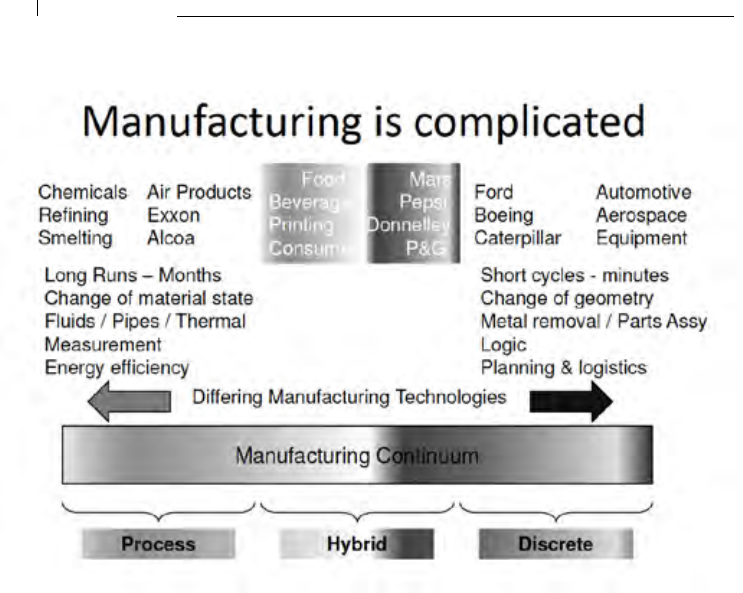
24
don’t spend much me trying to understand it. We might all agree that manufacturing
somehow involves making stu—but then we might get into some extended debate about
the meanings of the words “making” and “stu.” An illustraon of this point is a manufac-
turers’ associaon meeng where a colleague and I were invited to speak on the topic of
industrial maintenance and mechatronics. Before the meeng, I inquired of the aendees
what kind of manufacturing they were involved in. Almost all were from the discrete sec-
tor, and the program that I was prepared to discuss was targeted at hybrid manufacturers.
I asked the host if they didn’t have food, beverage, pharmaceucal, or similar consumer
products companies in the area. The answer was that they did, but their group didn’t con-
sider them as “manufacturers,” and they hadn’t been invited.
If those of us inmately involved with manufacturing have problems with our vocabulary
and understanding what we mean when we speak about manufacturing, how much more
dicult must it be for the general public?
Someone once described manufacturing to me this way: “It is something that takes place
inside a windowless building located behind a dike that you can only pass through with the
guard’s approval.” When I grew up, summer vacaons involved stopping to tour manufac-
turing plants; in Europe, major trade fairs sll include family days where parents can walk
through with youngsters in strollers to see all of the latest machinery innovaons. But in
America today, most plants are closed to the public, and trade fairs admit no one under the
age of 16. Our schools neither promote manufacturing as a career nor educate students in
the necessary technical skills, preferring instead to push everyone toward a college degree
in an economic society where less than one-third of jobs require a four-year degree and
where only 56% of four-year college students nish within six years. Is it any wonder that
Chapter Two
Figure 1.

25
Manufacturing Workforce Development Playbook
we have become so uninformed about and unprepared for manufacturing?
Manufacturing is broad in scope
In seeking clarity, I set out to nd out how the government denes manufacturing. This led
to the Census Bureau and the North American Industrial Classicaon System, known as
NAICS codes. The Census Bureau says, “The manufacturing sector comprises establish-
ments engaged in the mechanical, physical, or chemical transformaon of materials,
substances or components into new products. The boundaries of manufacturing and
the other sectors of the classicaon system can be somewhat blurry ....” The NAICS
codes for manufacturing at the six-digit level run from 310000 to 339999 within which
there are 10,537 types of manufacturers idened.
So, are we to understand manufacturing as one thing or as 10,000 dierent things?
When we seek training, educaon, and cercaon programs, should there be one
standard for manufacturing, or should there be mulple standards? Clearly a custom solu-
on—one for each type of manufacturing, or one for each manufacturer, or one for each
plant within a manufacturer’s company—is NOT a workable soluon. And manufacturing is
indeed too complicated for one-size-ts-all soluons, which are really lowest-common-de-
nominator answers that sasfy no one and will not make us compeve in today’s increas-
ingly complex and technically advanced world. Is there a useful soluon?
A useful subdivision
A useful way of viewing manufacturing is along a connuum, which may in fact include
10,537 dierent types. Manufacturers are placed along the connuum based upon
some chosen set of aributes, and the connuum is then divided into a limited number
of named sectors. In my simplied model, there are three sectors idened as Process
Manufacturing at one end, Discrete Manufacturing at the opposite end, and Hybrid Man-
ufacturing in the middle (Figure 1).
Process Manufacturing
The prototypical process manufacturer will operate with long runs that could extend 24
hours per day seven days per week with just one startup and shutdown per year. There
will oen be a change of chemical state of the material in a vessel or reactor, and the
material may be capve within pipes or other means of conveyance. Control will be of
a connuous nature and depend upon measurements of physical properes such as
temperature, ow rate, density, and chemical composion. Process control is frequently
hierarchical and distributed with large operator interface systems in centralized control
rooms that display operaons that may be miles away. Systems may be redundant with
automac failover to backup processers and locaons. Control may be based upon
mathemacal algorithms using feedback, cascade, and feedforward strategies. Money is
made or lost in the plant based upon fraconal improvements in operang quality and
energy eciency. Operators may be degreed engineers who are supported by techni-
cians and trades people who operate across some extended geography. Plant design is
less about individual machines and more about unit operaons that are congured from

26
components like valves, tanks, and pumps. The design is frequently done by or closely su-
pervised by an internal engineering sta, resulng in design details, soware, schemacs,
and other documentaon fully in control of the plant and available to the maintenance
technicians who may be expected to alter any of it under appropriate supervision. Basic
plant design changes infrequently (years or decades), while improvements may be con-
stant. Think about bulk chemicals, rening, or smelng operaons that might be done by
companies such as Air Products, Exxon-Mobil, or Alcoa.
Discrete Manufacturing
The prototypical discrete manufacturer will operate with short cycles that might be mea-
sured in minutes. An operaon may turn out many idencal but individual parts during
the course of a shi, or there could be very frequent changeovers to diering parts with
order quanes as small as one discrete unit. There will be changes of geometry involved
through material removal, material addion, bending, or assembly. Control will be largely
of a sequenal nature using logical operaons based upon sensors that feed back posion
and other physical aributes. Machines will oen employ electrohydraulic systems, ded-
icated CNC, robot controllers that coordinate half a dozen moon axes, and the PLCs that
oversee sequenal operaons and the interlocking between adjacent operaons. With fre-
quent changeovers the rule, the primary operator interfaces tend to be local to individual
machines. Money is made or lost based upon planning and logiscs, geng the right things
to the right place at the right me and keeping everything running. Operators load and
unload machines, adjust parameters, assemble components, and compare results to draw-
ings by making physical measurements. Plants, or the ow of materials through plants,
are frequently recongured (months). The basic machines and workcells are designed by
others, who may maintain control of the soware and detail documentaon, rendering it
unavailable to the plant’s maintenance sta. With a large variety of machines in use, rou-
ne maintenance may be done internally with troubleshoong and repair frequently done
by equipment manufacturers. Think about machined parts, aircra assembly, electronic
equipment, or automobiles that might be made by small machine shops, Caterpillar, Boe-
ing, Dell, or Ford.
Hybrid Manufacturing
The prototypical hybrid manufacturer will have connuous or batch-connuous operaons
that start o looking much like small-scale process manufacturing and end up looking more
like discrete but connuous manufacturing requiring an intermediate level of change-
over. Raw materials may be connuously blended and cooked, resulng in some chemical
change. Then they proceed through a forming stage, where changes to the physical
geometry may be made, and then on to packaging, where individual pieces are inspected,
wrapped, and assembled into larger units with similar or dissimilar components. Control is
oen a mix of analog feedback control and sequenal logic systems ghtly integrated with
general-purpose moon control and roboc cells. Systems with 100 servo axes coordi-
nated over large distances may be common, resulng in operator workstaons on the
Chapter Two

27
Manufacturing Workforce Development Playbook
oor that interact with mulple unit operaons and machines that are spread over some
distance. Money is made by balancing producon eciency and logiscs resulng in mass
customizaon. Plant design changes at an intermediate frequency (years) and may be
accomplished by a combinaon of internal and external resources; but because of ghtly
integrated operaons, machine soware and other documentaon is oen available to
maintenance personnel, who will be expected to troubleshoot and repair all but the most
dicult and infrequent failures. Think about food, beverages, prinng, or consumer prod-
ucts made by companies such as Mars, Pepsi, Donnelley, or Procter & Gamble.
The Economics
This classicaon of manufacturers may seem a bit arbitrary, and various excepons will be
plenful to the prototypical descripons oered above. But throughout my career, I have
found this segmentaon to be both meaningful and useful. Some validaon is provided by
looking at the economic numbers when manufacturing is segmented in this way (See Figure
2). Total U.S. manufacturing output is approximately $5 trillion. By sector, process and hybrid
each account for 31% of this output, with discrete claiming a slightly larger 38%. Manufac-
turing employment is 14 million persons, but the division by sector is quite dierent than by
output. Discrete manufacturing claims 50% of the employment, with hybrid accounng for
32% and process only 18%. Total wages of $1 trillion are also skewed, with discrete account-
ing for more than half of the wage base at 52%, hybrid 26%, and process 22%.
From this basic data, we can see some important facts that make intuive sense. First,
output per employee, or producvity, is much higher in the process industries, exceeding
Figure 2.

28
discrete producvity by almost 2 1/2 mes. Second, process employees, at $97,000, have
the highest wages per employee. If we think about large process plants with control rooms
full of distributed control systems operated by employees with some college, or maybe
even a degree, this data makes sense.
Discrete manufacturing has the lowest producvity, yet the second highest wages per
employee. This could be because of higher skill requirements or more changeover issues in
the discrete world, or it could be a reecon of the wages that are being paid in industries
that are more highly unionized. In any case, there would seem to be some signicant op-
portunity for discrete manufacturers to improve their producvity numbers.
Hybrid manufacturers pay the lowest wages and have producvity midway between pro-
cess and discrete. Many process plants went fully automated in the last quarter of the 20th
century. There are certainly opportunies for connuous improvement in process plants,
but many hybrid plants have not yet taken advantage of the opportunies available with
new mechatronic soluons, process control, and batch automaon. Real opportunies for
applying advanced manufacturing automaon techniques, and for worker upskilling, exist
in hybrid manufacturing, leading to higher prots for owners and lifestyle improvements for
workers. The dierence in wages and producvity alone are enough to aect the educa-
on and training expectaons of manufacturers from these three sectors.
An overarching fact not to be overlooked in this data is that manufacturing wages per
employee are 50% higher than average wages overall in the economy, and manufacturing
producvity is 2 1/2 mes the naonal average. The least producve manufacturing sector
is more than twice as producve as the economy as a whole.
Models are meant to be useful, not perfect
This model is meant to simplify, not to be all-inclusive. It provides rules of thumb, and rules
are meant to be broken. For example, some companies may have both process and discrete
Advanced Industrial Maintenance Skills Vary
Hydraulics
HydraulicsHydraulics
HydraulicsPneumatics
PneumaticsPneumatics
Pneumatics
Common core skills
–
math, electricity, mechanics, motors
Skill Level
Proportional
Proportional Proportional
Proportional
Valves
ValvesValves
Valves
Cascade
Cascade Cascade
Cascade
Control
ControlControl
Control
Coordinated
Coordinated Coordinated
Coordinated
Multi
MultiMulti
Multi-
--
-axis
axis axis
axis
Motion
Motion Motion
Motion
Control
ControlControl
Control
CNC
CNC CNC
CNC
Control
ControlControl
Control
Common core skills
–
math, electricity, mechanics, motors
Manufacturing Continuum
Process DiscreteHybrid
Chapter Two
Figure 3.

29
Manufacturing Workforce Development Playbook
operaons within the same plant and not be considered a hybrid. And there may be blurring
at the edges between manufacturing and non-manufacturing. For example, ulies, mining,
and agriculture will share some aributes with the various manufacturing sectors. A training
program for an electric ulity or a pipeline may look a lot like that for a chemical plant. A
farmer using geospaal mapping and soil sensors to batch the proper amount of ferlizer to
a eld using mechatronic systems in a tractor may have needs similar to a hybrid manufac-
turer, as will a supply chain technician in an automated fulllment warehouse.
The purpose of a model is to be useful. We know that Newton’s formula F=ma does
not explain everything correctly, but in many circumstances it is sll useful. The asseron
here is that this three-sector model is useful when developing manufacturing workforce
training, educaon, and cercaon programs. It may be applied to the unique skill
needs of operators, maintenance technicians, and supervisors.
Manufacturing sectors affect workforce development plans
Customizing training, educaon, workforce development, and cercaon plans by manu-
facturing sector is a workable strategy that will increase the sasfacon of industry and the
acceptance and penetraon of educators as we work together to solve the workforce crisis
in America (See Figure 3). It will eliminate the need for educators to create a customized
program for every plant or company. It will facilitate the use of industry-recognized creden-
als by eliminang the need for every kind of manufacturer to nd or develop their own. It
will allow companies to achieve the crical mass necessary to inuence local and naonal
decisions about educaon and workforce development. Recognizing that a small food com-
pany, a large automated warehouse, and a ferlizer plant share similar competency needs
for their workers will allow them to collecvely approach their workforce agency and local
high school technology center or community college to develop higher-quality programs that
meet the needs of a wider customer base for the educaon provider. That is not to say that
schools shouldn’t make customized training for individual employers. But it is to suggest that
if they start with the right plan for the sector, the customizaon should be minor.
Leveraging manufacturing sectors
As a manufacturer, your operaons may be unique, or they may be only like those of your
competors with whom you don’t wish to collaborate. But the underlying technologies and
aributes of your process, hybrid, or discrete sector have you sharing much in common
with other manufacturing companies in that same sector. Leverage your sector to inuence
automaon vendors, educators, soware providers, and others.
As a provider of products or services to manufacturers, don’t assume that one size will
t all. Idenfy the sectors of your customers, and start out by tesng the hypothesis that a
soluon customized for a parcular customer’s sector will meet most of the needs of any
customer within that sector.
Once both manufacturers and suppliers recognize and simplify manufacturing by sector,
the task of developing plans, strategies, and winning soluons will become less challenging
and the results more useful.

30
A
s I was winding down my involvement as Execuve Director of the OMAC
Packaging Workgroup (OPW), I was invited to a regional meeng on man-
ufacturing skills development, a topic that aligned with OPW’s PackLearn
iniave. I decided to aend, only to nd that the meeng had been cancelled,
and that Sco Sheely and I had not been told. As a result, we bumped into one
another in the hallway outside the room that the meeng was to have been held in,
introduced ourselves, complained about the meeng being cancelled, and then sat
and shared ideas about the need for advanced skill development in manufacturing.
That was 10 years ago, and Sco and I have been working toward common goals
ever since.
Sco J. Sheely has been the Execuve Director of the Lancaster County Workforce
Investment Board, one of 22 such boards in Pennsylvania, since 2000. Vocaonal-
ly, he has worked as the human resources director of a large mental health agency,
the operaons manager of a nursing home chain, the associate pastor of a church,
and the owner of a regional wholesale jewelry business. A graduate of Franklin and
Marshall College in government, Wright State University in mental health counseling,
and United Theological Seminary in pastoral counseling, Sco is currently a doctoral
candidate in adult and workforce educaon at Penn State University.
With many partners, he is the founder of the Food Manufacturers’ Training Con-
sorum of Southcentral PA, the Industrial Maintenance Training Center of Pennsyl-
vania, and the Mid-Atlanc Mechatronics Advisory Commiee. Sco was the chief
architect of the Mechatronics Competency Model that was adopted by the U.S.
Department of Labor. He works closely with PMMI as that organizaon builds out
the components of its mechatronics industry credenal.
Scott J. Sheely,
Executive Director,
Lancaster County
Workforce Investment
Board
Workers arrive at a manufacturing job having traveled many different routes.
Just as the previous chapter points out that there may be different prepa-
ration required depending upon the manufacturing segment one works in,
this chapter points out that the characteristics of that preparation may need
to vary depending upon the path being taken to that career. Although the
knowledge and skills obtained may be the same in the end, the strategies
for obtaining the knowledge and skills may vary widely for a full-time high
school student, a returning-to-the-workforce mother, a veteran, the long-
term unemployed, an incumbent worker, or an ex-offender. Under-
standing the pathways issue is essential to creating the programs
that meet the most needs. While an “all of the above” approach
might be desirable, it is not the place to begin.
Chapter Three

31
Manufacturing Workforce Development Playbook
O
ver the last several years, career pathways have become increasingly popular frame-
works for talking about the variety of career opons that are available to people who
are preparing to enter the job market or looking for work aer an employment dislocaon.
They use occupaons as a kind of roadmap for job seekers, and many have been organized
in “ladders” or “laces” showing occupaonal progression.
Characteristics of Pathways
Pathways are nearly always referred to in the plural. Any one job has mulple ways that
people nd the knowledge and skills to perform it. In the same way, any pathway oen
leads to many jobs that make use of the knowledge and skills acquired.
Extending the pathway metaphor, these theorecal constructs also help us understand
the “on-ramps” and “o-ramps” as people move through the lifelong learning that is
required to proceed along the pathway. Veterans, dislocated workers, new workers, ex-of-
fenders, and others will bring dierent knowledge and skills to the pathway at parcular
mes in their careers. As the pathway model is applied, it needs to account for these
dierent talents that the learner brings and allow them to move ahead with addional
knowledge and skill acquision.
If done most eecvely, career pathways must also reect the needs of employers and
recognize the reality of the way people progress through levels of the work environment.
They are just as important for incumbent workers as for entering workers, parcularly at a
me when employers in the U.S. (and around the globe) are dealing with the talent short-
age that will develop as the Baby Boomer generaon changes its relaonship to work over
the next several decades.
Industries like manufacturing and construcon that rely more on on-the-job training rath-
er than those such as healthcare, which require more academic credenals and licensing,
will have very dierent pathways.
As we look at all forms of educaon today, it is clear that formal educaon is more valued
than hands-on or tacit educaon…the kind that comes from sing next to and observ-
ing a journeyperson welder, mechanic, installer, or operator. Tacit educaon, along with
Chapter Three
by Scott J. Sheely
Manufacturing Career Pathways
Where do manufacturing workers come from,
and how do they advance?

32
foundaon skills and some basic didacc knowledge, forms the basis for training many
of the middle-skill jobs that will be in short supply over the next two decades as the new
demographic-based dislocaon moves into full swing.
Identifying a Pathway
Through a process of analyzing secondary occupaon data, it is possible to idenfy pathway
concepts that can be further developed into pathway models. Typically, the researcher
examines occupaonal projecons and organizes them into categories that can be tested
for wage and skill progression. A regional economy normally contains six to eight of these
pathway models.
For example, in Lancaster County, PA, which has a very large manufacturing sector that
includes food processing, metal fabricang, prinng, and packaging, we have idened
from the occupaonal data a Producon Career Pathway that looks like this:
• Entry-level
o
Industrial Truck and Tractor Operators (Forkli Operators)
o
Hand Packers
o
Inspectors and Testers
• Intermediate-level
o
Single trades
w Machinists
w Welders
w Heavy Tractor-Trailer Drivers
w Maintenance and Repair Workers
o
Machine operators
w Prinng Press Operators
w Print Binding and Finishing Workers
w Food Batchmakers
w Packaging Machine Operators
• Upper-level
o
Industrial Machinery Mechanics
o
Mechatronics Engineering Technologists
o
Supervisors of Producon Workers
Levels show a clear wage and skill progression, and the occupaons associated with the
levels are projected to grow in the region over the next decade. This is the theorecal
pathway model.
Pathways in Practice
However, to bring the model alive for praconers, one needs to add other informaon
that needs to be collected from the industry. We invited 25 industrial maintenance super-
visors from mid-size to larger manufacturers to a focus group to tell us about the mulple
Chapter Three
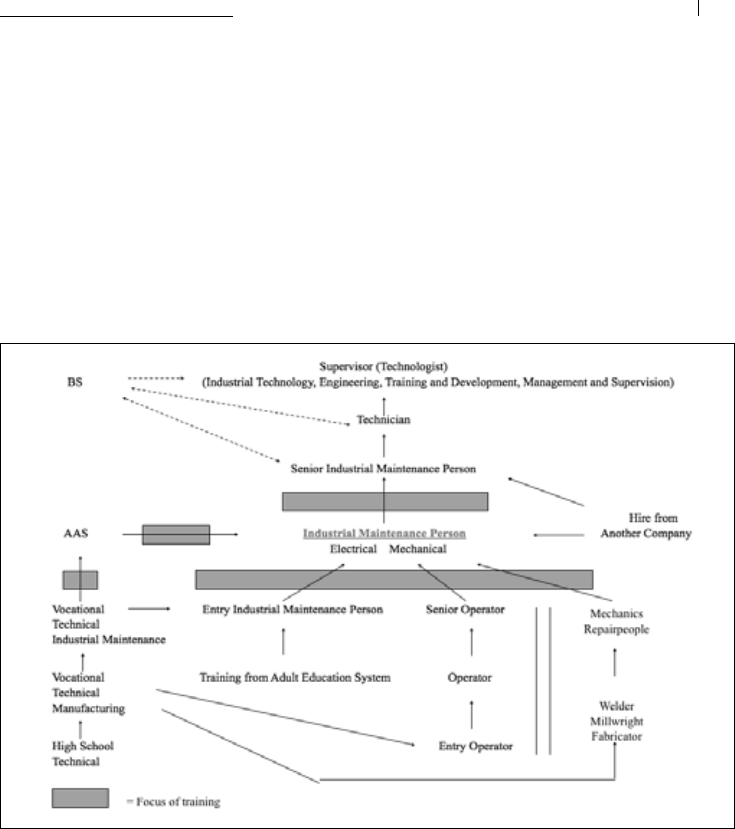
33
Manufacturing Workforce Development Playbook
pathways that people use to become an Industrial Machinery Mechanic or Mechatronics
Engineering Technologist (or several other job tles commonly associated with the Industri-
al Maintenance Technician cluster of jobs).
They told us a much more nuanced story about pathways that are illustrated on the
chart below.
• We began with the assumpon that many people enter the pathway through formal
educaon, beginning with high school technical programs that arculate to postsec-
ondary training, which ow people toward jobs in the Industrial Maintenance Techni-
cian (IMT) cluster. We found that fewer than 15% of people actually enter jobs in that
cluster by this path and, from the commentary from supervisors, that many people
who do come through these educaonal programs sll need a great deal of on-the-job
training to be fully funconal.
• Supervisors spoke in a posive way about people who aain some level of technical ed-
ucaon in maintenance either at the secondary or postsecondary level, get experience
in a small to mid-size manufacturer, and come to work with a larger manufacturer with
a broader level of knowledge and experience. Hiring people from other usually smaller
companies is another way that people move along this pathway.
• Another clear trend in talent development that takes place along the pathway involves
idenfying people with maintenance knowledge and skills in the machine operator ranks

34
and oering them ways to take on maintenance tasks on the job. Many companies spoke
of making operators “machine owners,” allowing them to take on prevenve maintenance
funcons that may then lead to an invitaon to do more in the maintenance area.
• Finally, companies have been very involved in taking single trades such as welders,
millwrights, electricians, and others and adding addional skill training to make them
into the mulskilled technician that is required in industrial maintenance. Several of
the supervisors spoke about welders’ abilies to do maintenance tasks because of their
ability to think three-dimensionally, read blueprints, and fabricate.
• We also found out one other thing. When our friends in higher educaon pushed the
idea that IMTs eventually needed a bachelor’s degree, the supervisors in the room dis-
missed that noon. They admied that a bachelor’s degree might be good if mainte-
nance people become trainers or supervisors or managers; but for praconers, there
was no value added in further formal educaon.
With our interest in workforce development, we also asked the focus group to share their
opinion of where further training would be most applicable. There was near consensus
that training for higher-level skills required for the IMT cluster should build on a solid base
of experience rather than the other way around.
This insight was pivotal as the workforce and educaon system in Berks and Lancaster
Counes in Pennsylvania build out a systemac approach to skills acquision along the
Manufacturing Career Pathway.
• People already on the job (incumbent workers) become the focus of higher-level skill
training in industrial maintenance and mechatronics. A network of employers idenes
candidates who parcipate in a program of online instrucon and laboratory pracce
culminang in tesng that stresses troubleshoong skills.
• Schools and workforce organizaons prepare potenal employees to join the Manufac-
turing Career Pathway at lower levels. However, they encourage people to parcipate
in skill training (blueprint reading, hand and power tools, safety, forkli operaon) that
lays a foundaon for future training and progression down the pathway.
• Veterans are able to bring skills from their military service and nd a place along the
pathway where they can be applied.
• In a similar way, persons who have experienced a dislocaon from a job can nd ways
to use the skills that they bring and addional skills that they may acquire at various
levels along the pathway.
• Many other people, including those reentering the community from prison and those
transioning o of welfare, can learn skills that qualify them for entry into lower-level
jobs on the pathway as their “on-ramp” to beer jobs in the future.
In Summary
Career pathways allow the individual to see a plan that becomes their pathway to the
future and establish what they, as individuals, must do to move into it and along it. Career
pathways allow educators and workforce planners to target training to the areas where it is
Chapter Three

35
Manufacturing Workforce Development Playbook
needed as people move through the system. Career pathways help employers to not only
idenfy the skill training that their incumbent workforce needs, but to also evaluate the
knowledge and skills of their prospecve workforce as they hire into it.
However, to be useful, pathway models must be tested and be informed by the reality of
the work world as they are put into pracce.

36
O
ne of the most telling and comprehensive reports on the state of workforce
preparaon in America was published by the Harvard Graduate School of
Educaon in 2011. I rst saw a presentaon on the report in late 2012 at
a community college near Pisburgh. The facts presented paint a picture dierent
from the one that many Americans assume. The soluons suggested are at once
both simple in concept but challenging in execuon. Who beer to summarize this
landmark report than the Project Director, William Symonds.
Dr. Symonds helped launch the Pathways to Prosperity Project at the Harvard
Graduate School of Educaon in 2008, and he served as its director through June,
2013. He was the primary author of the seminal report issued by the project in
early 2011: Pathways to Prosperity: Meeng the Challenge of Preparing Young
Americans for the 21st Century. Since the report’s release, Bill has spoken in 40
states. He was also the principal organizer of a naonal conference held at Har-
vard in March, 2013, called, “Creang Pathways to Prosperity.” Symonds is now
working to create the Global Pathways Instute to help lead a naonal movement
aimed at preparing all young Americans to lead successful lives. He also con-
nues to speak to groups around the country about how we might help young
people build successful careers.
Prior to coming to Harvard in 2007, Symonds spent nearly 25 years as a senior
correspondent and bureau chief with Business Week magazine. During his career
at Business Week, he covered businesses in virtually every industry leading bu-
reaus in Pisburgh, Denver, and Boston, as well as in Italy and Canada. He also
served as Business Week’s chief educaon correspondent for many years.
William C. Symonds,
Formerly Project Director,
Pathways to Prosperity
Project, Harvard Graduate
School of Education
The most commonly thought of pathway to a career, and arguably the most
effective one, is a direct pathway from high school to higher education to
work. Most parents want their children to graduate from high school, go to
a prestigious university, and enjoy a good-paying career. But unfortunate-
ly, in the 21st century, this expectation is increasingly not being met. We
need to change the national dialog about higher education and recognize
that there are alternative strategies that lead to a student’s success. The
facts are staggering. The solutions were well known to American plan-
ners at the end of World War II, but rejected. We need to rethink
the school-to-work pathways if we want more students to achieve
success, if we want to revitalize manufacturing, and if we want
to give a dynamic boost to our economy.
Chapter Four

37
Manufacturing Workforce Development Playbook
Chapter Four
E
ven though the U.S. economy is connuing to recover from the Great Recession, it is clear
that we sll lag behind many naons in preparing young people to lead successful lives
as adults. Evidence of this failure is seen everywhere—from the staggering levels of youth
unemployment/underemployment to the millions of young people who drop out of high
school or college before earning a degree. This epidemic has become so pervasive that it now
touches virtually every family in America. And if we don’t develop eecve soluons to this
crisis, it threatens to undermine the future strength of our economy.
This failure has especially serious implicaons for manufacturing. One of the key reasons
so many young people are struggling to nd good jobs is the huge disconnect that’s devel-
oped between educaon and the needs of industry. Business leaders increasingly complain
that many high school and even some college graduates don’t possess the skills they need
in today’s economy. Nowhere is this “skills gap” more apparent than in manufacturing.
Indeed, as I’ve traveled to 40 states speaking about this problem over the past three years,
I’ve heard repeated complaints from manufacturers about the problems they’re facing ll-
ing skilled jobs. This issue has come up everywhere from rural New England to the Midwest
to the Pacic Northwest. And it’s clearly a big problem. A 2011 study by Deloie and the
Manufacturing Instute esmated that 600,000 manufacturing jobs were unlled because
of this skills gap, with the shortages especially acute among skilled producon workers.
A major reason we confront this predicament is that in recent years, the U.S. has put
enormous emphasis on one pathway to success—aending and graduang from a four-
year college—while de-emphasizing alternave pathways, including career and technical
educaon (CTE). In sharp contrast, some other leading naons have taken a much more
balanced approach, by oering young people mulple pathways to success. Some of the
most prosperous countries in central and northern Europe, as well as Australia and New
Zealand, have developed high-quality systems of what they call vocaonal educaon and
training (VET). These systems oer young people rigorous programs of study designed to
by William C. Symonds
Preparing America for 21st
Century Global Competitiveness
The Pathways to Prosperity Report from the
Harvard Graduate School of Education points out
where America stands on a global basis and suggests
changes we need to make.

38
prepare them for a career in their chosen industry. VET oen includes an apprenceship at
a company in the industry. Germany, Switzerland, and Austria have developed especially
strong VET programs aimed at preparing young people for manufacturing—a key reason
why Germanic manufacturing connues to be so globally compeve.
The Pathways to Prosperity report, which was published by the Harvard Graduate School
of Educaon in 2011, argued that the U.S. had much to learn from these other countries
about preparing a globally compeve labor force. True, the U.S. cannot aspire to simply
import foreign approaches, such as the German dual-apprenceship system. But I and my
co-authors argued that we could build a much more eecve American system of pathways
to prosperity—one that would beer serve both young people and American industry.
Since the publicaon of the report, I’ve helped develop a list of some of the crical steps
the U.S. needs to take to develop vibrant pathways systems. These recommendaons—
which I’ll discuss toward the end of this chapter—are highly relevant for those concerned
about the manufacturing workforce.
To be sure, change is never easy, and perhaps no sector is more resistant to change than
educaon. But the Pathways report advanced two compelling reasons why the U.S. should
embrace fundamental change. The rst is that our naonal approach to preparing young
people is clearly failing to prepare many of them for success. Though we’ve spent hundreds
of billions of dollars trying to prepare schoolchildren for college, only 30% of young adults
actually earn a bachelor’s degree by their mid-20s. Tragically, many young people go to col-
lege, but drop out before graduang, leaving with no degree but oen with a huge student
loan debt. This scenario is so common that the U.S. now has the highest college dropout
rate in the industrial world.
Meanwhile, the U.S. lost its long-standing leadership in educaon. As the Pathways
report points out, the U.S. led the world in educaon by virtually every measure for a
full century—from the mid-19th century through the 1960s. During this period, the U.S.
made astonishing gains in educaonal achievement and aainment, which in turn laid the
foundaon for spectacular growth in U.S. prosperity. Yet over the past generaon, the U.S.
has fallen behind many other naons in educaonal aainment and achievement. A major
reason for our decline has been our adherence to the goal of “four-year-college-for-all.”
The second reason that we need to change is the overwhelming evidence from other
naons that there is a beer way to prepare young people for successful lives as adults. As
the Pathways report documents, some of the world’s most successful countries have em-
braced a “mulple pathways” approach to educaon and youth development. These coun-
tries have strong universies, just as the U.S. But they’ve also built vibrant VET systems,
which have become the pathway of choice for many young people. In northern and central
Europe, 40% to 70% of young people opt for the VET system beginning in about tenth
grade. While these systems vary from country to country, they typically combine classroom
and workplace learning over three years. These programs culminate with the student earn-
ing a diploma or “cercate” that has real meaning in the labor market. In Germany, which
has the best-developed system, students can choose among VET programs in 350 dierent
occupaons. And in Switzerland, students can choose from among more than 200.
Chapter Four

39
Manufacturing Workforce Development Playbook
While many Americans sll view CTE as a substandard or second class opon, the best
of these foreign VET programs are models of rigor and relevance. A VET qualicaon in
Germany or Switzerland is oen every bit the equal of a technical degree that might be
awarded by a U.S. community or technical college. And unlike the typical U.S. community
college program, the Swiss and German VET programs include an extensive apprenceship.
Students studying manufacturing thus have an opportunity to apprence with such world-
class manufacturers as Siemens, BMW, and Mercedes.
Recent internaonal research suggests there are three major benets to high-quality
vocaonal educaon. The rst is that for many adolescents, combining work and learning is
more eecve pedagogically: in other words, the students actually learn more. That’s part-
ly because they don’t have to wonder about the relevance of what they are being asked to
learn, since it is so clearly aimed at preparing them for a career. In sharp contrast, countless
U.S. high school students become bored with a curriculum they nd largely irrelevant, and
a signicant number of them go on to drop out. A second benet is that because foreign
VET students are more engaged, they are more likely to remain in school unl they gradu-
ate. This is one reason why the U.S. has slipped behind many naons in graduaon rates.
The third and perhaps most impressive benet is that vocaonal educaon helps young
people nd jobs in their chosen careers. Learning for Jobs, a 2010 study completed by
the Organizaon for Economic Cooperaon and Development (OECD), studied vocaonal
educaon in 17 dierent countries, including the U.S. It found that countries with the
strongest VET systems—including Switzerland, Germany, Austria, the Netherlands, and
Norway—have much lower levels of youth unemployment than the U.S. or other countries
with weak vocaonal educaon. Youth unemployment has remained under 10% in these
exemplar countries, even as it’s exceeded 50% in Spain and Greece. In the U.S., youth
unemployment has been hovering between 15% and 20%, yet it’s compounded by the fact
that the percentage of young people in the labor force has dropped to the lowest levels in
recent American history.
Developing a more eecve American approach will require a fundamental cultural
change—a move away from our over-emphasis on four-year college and toward a more
holisc, mulple-pathways approach. In the fall of 2013, I helped convene a number
of leading business and educaon organizaons to develop a “vision” for a new Global
Pathways Instute that aims to promote this new approach. This is the vision statement
that we adopted: “We are commied to creang an America in which all young people are
prepared to lead producve and successful lives. We believe that providing young people
with high-quality mulple pathways is the best way to help them discover and develop their
potenal and achieve economic independence. Achieving this vision will require creang a
world-class pathways system in which industry collaborates with educaon to beer dene
the skills needed to compete in the global economy, develop programs that will equip stu-

40
dents for success, and provide ample opportunies for work-based learning. We believe this
will help rebuild the middle class, increase social mobility, and promote the dignity of work,
while strengthening American compeveness and the U.S. economy.”
Achieving this vision will require that we embrace several core principles. Four are espe-
cially important:
1. First, we must make career guidance a far more central part of school—and thus
strive to provide every student with high-quality guidance. Today, many young people
receive lile or no guidance, and so not surprisingly end up making poor decisions.
Good guidance would encourage young people to explore possible careers, to become
excited about their future, and to then develop realisc pathways plans. Eecve
career guidance is an especially promising answer to the skilled-labor shortages in
manufacturing. Because so many American manufacturing jobs disappeared in recent
decades, many parents have developed a negave view of manufacturing, and so
discourage their children from even considering such a career. That’s true even in
places where the economy is dominated by manufacturing. Take Fond du Lac, WI, a
medium-sized city whose economy is built around manufacturing. In 2011, the area
Associaon of Commerce did a survey of the workforce, and found that 51% planned
to rere in 15 years. At the same me, they also surveyed area high school students,
and discovered that many students have a negave percepon of manufacturing. In
fact, only one-third said they would even consider taking a manufacturing-related
course. This suggests that Fond du Lac will face a severe skills shortage in coming
years unless it can reverse these negave percepons among young people and their
parents. Beer career guidance is one obvious soluon.
2. Second, we need to ensure that all young people have access to mulple pathways
to success, including high-quality CTE. True, we already have some world-class CTE
programs, including some that prepare students for careers in manufacturing. Wichita,
KS—a city located in the midst of the largest geographic center of aircra manufactur-
ing in the U.S.—has established the Naonal Center for Aviaon Training to prepare
students for this industry. Similarly, Francis Tule Technology Center in Oklahoma City
is somemes called the “Taj Mahal” of CTE. It oers excellent programs in advanced
manufacturing, precision machining, CNC programming, and many other in-demand
areas. The problem is that these exemplars are more the excepon than the standard.
Whether a young person has access to high-quality programs thus oen becomes an
accident of geography—where they happen to live. We need a far more determined
eort to take the best programs to scale.
3. Third, we must engage employers in this vital work. The best foreign VET systems
depend on the heavy involvement of leading employers. That shouldn’t be surprising.
Who knows more about the career opportunies in manufacturing than the people
who already work for manufacturers? Employers can enlist their employees to talk to
students about these opportunies in manufacturing, and to serve as mentors to stu-
dents interested in manufacturing. In addion, manufacturers should invite counselors,
Chapter Four

41
Manufacturing Workforce Development Playbook
school administrators, and teachers to visit their facilies, so they can learn more about
the industry. Manufacturers must also work closely with educators to help develop pro-
grams of study designed to produce the well-trained workers that companies need.
4. Finally, employers must join with educators to dramacally increase opportunies for
“work-based learning.” Work-based learning refers to learning that takes place at the
place of employment. It can range from brief exposures such as job shadowing to
full-blown apprenceships. The OECD’s Learning for Jobs report provides abundant
evidence of the value of work-based learning. Given the bias against manufacturing
careers, it is especially important in manufacturing. Again, there are some wonderful
examples of good work-based learning. Wisconsin, for instance, has a long-standing
Youth Apprenceship program, under which high school juniors and seniors complete
up to 900 hours of work-based learning. The results are impressive. Over 75% of
youth involved in youth apprenceships connue their educaon at one of Wiscon-
sin’s impressive technical colleges, or at a university. And more than 80% work in their
eld aer graduaon. The Youth Apprenceship program has also encouraged some
students to complete high school, rather than drop out. In Waukesha, WI, Generac
Power Systems launched “Second Chance Partners” to allow high school students to
work and learn in manufacturing facilies. More than 80 other manufacturers have
now joined this program. Even though many of the students who sign up for this pro-
gram are struggling with convenonal academics, 90% of those who enroll successfully
complete the program, and many go on to nd jobs in manufacturing.
The beauty of these four principles is that they can be adopted and implemented in a
willing district, city, or region—without waing for the rest of the naon to get on board.
Manufacturers who are concerned about the skills gap can enlist like-minded companies
and then work with educators to expand career guidance, improve programs that prepare
students for manufacturing careers, and expand opportunies for work-based learning.
This is an extremely promising strategy for recruing and preparing the manufacturing
workforce of the future. So stop complaining about the skills gap, and get engaged in solv-
ing the problem!
The full Pathways to Prosperity report may be found at: hp://www.gse.harvard.edu/
news_events/features/2011/Pathways_to_Prosperity_Feb2011.pdf

42
Edward J. McCann,
Director of Workforce
Development & Chief
Operating Ofcer, Berks
County (PA) Workforce
Investment Board
I
have been fortunate to have had connuous gainful employment since grad-
uang from college. As a result, my last personal contact with the workforce
system was over 30 years ago with what was then the “unemployment oce.”
Aer 30 years in manufacturing, I was reintroduced to the “workforce system”
as I began to promote technology educaon. I quickly learned that I had no idea
about what the workforce system had become. Ed McCann became a valuable
mentor for me as I learned about the system and its culture. Ed oers a quick
wit, deep insight, and a rapid grasp of new ideas. I am oen surprised to hear him
arculate complex new ideas in extremely simple ways, and you are never le
with any doubt about where Ed stands on an issue. Who beer to reect upon
the changing role of the workforce system and to advise manufacturers on how
to ulize it to their best advantage?
Ed currently serves as Director of Workforce Development and Chief Operang
Ocer for the Berks County Workforce Investment Board in Pennsylvania. He is a
graduate of Lehigh University with graduate work at Pennsylvania State University,
and he has nearly 40 years experience in the planning and management of work-
force development programs. He is a charter member of the Naonal Associaon of
Workforce Development Professionals (NAWDP); he served on that organizaon’s
Board of Directors for 18 years and as Chairman of the Board for 3½ years. He is a
Cered Workforce Development Professional. Ed connues to be acve in local,
state, and naonal organizaons, including NAWDP, the PA Workforce Development
Associaon (PWDA), the Greater Reading Economic Development Professionals,
the Berks Advisory Board for the Ben Franklin Technology Partnership, and the
Government Aairs Commiee of the Greater Reading Chamber of Commerce and
Industry. In 2009 he was named Partner of the Year by the PA Economic Develop-
ment Associaon (PEDA) and received the H. G. Weisman Award for Leadership
from NAWDP.
The workforce system, what many of us think of as the “unemployment
ofce,” gets involved with many of the workers who don’t follow the direct
school-to-lifelong-career pathway. But the workforce system has changed
dramatically. It has evolved from a supply-focused system trying to rid itself
of its supply of unemployed workers to a demand-focused system trying to
meet industry’s demand for an appropriately skilled workforce. One ap-
proach is to improve the skills of existing workers, driving our economy and
creating entry-level jobs as others move up. The workforce system is well
positioned to serve as a neutral arbiter between industry and educational
institutions, whose grant funding may depend upon the endorsement of the
local workforce agency. Workforce agencies also have signicant inuence
on the ow of students from industry or unemployment to high-priced
training programs upon which schools depend. Industry and educa-
tion is well advised to always have their workforce partners at the
table and to leverage their inuence and advice.
Chapter Five

43
Manufacturing Workforce Development Playbook
Chapter Five
T
o paraphrase the Oldsmobile ads of a few years ago: “It’s not your father’s Workforce
Development System anymore.”
The truth is, however, that it never really was. There were, to be sure, visible manifes-
taons of what was purported to be a Workforce Development System. But in truth, what
we had aer 50-plus years of federal and state iniaves was a hodgepodge of “siloed”
programmac approaches, each of which operated fairly independently and each of
which had, over the years, assembled its own constuencies inside and outside of Con-
gress to defend itself against any aempt to change it.
Now, that’s not to say that these programs did no good or that they were not staed
with capable and conscienous people. But they weren’t a “system.” The individual
elements didn’t talk much to each other. They had lile authority to make any changes at
the local level, and input from the “outside,” especially from employers, was oen both
perfunctory and minimal.
So the state employment services, the vocaonal-technical schools, the community
colleges, the various community based organizaons, and other “service providers” did
what they could do, as well as they could. The planning and operaons of the successive
iteraons of federally funded “employment and training programs” did so as well, with
all of them coming together, if at all, around whatever version of advisory commiees
and planning bodies for the total “comprehensive” federal programs were then in place.
If anyone thought of a connecon with economic development, it usually didn’t go much
further than trying to recruit for new employers or occasionally an aempt to include
some commitment of federal “training funds” along with state incenves on an “oer
sheet” to a prospect without running afoul of the federal law.
Good things were done, but probably very few of them to the complete sasfacon
of those who really wanted a Workforce Development System, nor was there much of a
strategic or long-term community workforce development focus.
But there’s good news for those who have that kind of inclinaon, which I suspect
includes most employers, a whole lot of people who have worked in the current congu-
raon, and certainly economic development professionals. These folks fully understand
by Edward J. McCann
The Role of the Workforce
System and How it has Changed
The system has changed, and those of us who have
always been employed may have
missed that fact.

44
that the most signicant way they can disnguish their areas from others—whether next
door or in a global market—is by the quality and compeveness of their labor force.
The rst piece of good news is that a number of things have changed. One is that the
Workforce Investment Act (WIA), the latest in series of federal legislave intervenons,
reected a belated realizaon that those responsible for pung a “local” system together
had to be independent of those who delivered direct services. They had to be “honest bro-
kers” or “neutral brokers” if we want to avoid oending anyone. The other was that, even
without any real “command and control” authority, the new Workforce Investment Boards
(WIBs) were nevertheless given a broad charge of authority to bring together elements
to improve the workforce. They didn’t all do it immediately, and some may not even have
done it over me, but gradually it occurred to a lot of them that they could.
The “One-Stop Career Center” concept has also made a contribuon. To be sure,
pung these conguraons together has not been a completely awless process. I am
reminded of an old friend who had seen this aempted before and concluded, “Coordi-
naon and cooperaon are unnatural acts performed by non-consenng adults.” A bit
overstated, of course, but not without an uncomfortable ring of truth.
Well, the “One-Stops,” under whatever “brand name” the states chose to give them,
haven’t turned out to be all that bad, except in the rare instances where someone was
determined to make them bad. There may sll be remnants of rear-guard obstrucon-
ism here and there, but it’s not really a serious condion anymore. Remarkably, when all
those local actors were encouraged and even empowered to work together and to see
the world in a larger context, they started to do so, oen adding a local or regional vision
and some more-eecve operang processes to the basic structure encapsulated in
federal and state legislaon.
A number of things helped this process along. Labor market data got beer and was
packaged in more comprehensive and usable forms, both by the various state “data
shops” and by research-based private for-prot providers that followed the tradional
entrepreneur’s model of nding out what people needed and selling it at a reasonable
price. Newly emerging jobs in areas like healthcare, informaon technology, and industri-
al automaon were dened and classied with skill sets, and related Knowledges, Skills,
and Abilies (KSAs) were codied.
“Cluster” or “sector” partnerships were created, and relavely small amounts of in-
cenvizing funding leveraged input from employers. This led to much beer understand-
ing of their workforce requirements and an enhanced capacity to communicate those
requirements to educaonal and training providers. More and more, these eorts oen
include beer assessment systems like WorkKeys®, which produce a common language
across employers, educators, and workforce intermediaries.
Economic development discovered that a race to determine who could produce the
cheapest labor was a poor substitute for the ability to deliver a workforce with the
education and skill levels that could demand family-sustaining wages in growing indus-
tries. Perhaps even more important, the resulting dialog between workforce develop-
ment and employers led to a new and broad-based understanding of the critical need
Chapter Five

45
Manufacturing Workforce Development Playbook
for “middle-skill” jobs.
While substanal parts of the educaonal system remained loyal to the tradional
o-the-shelf academic credenals with a baccalaureate degree at the pinnacle, discus-
sions with employers, oen facilitated by local WIBs, have now made many converts to
a mulple-exit-point model. Such a model provides either a younger person entering
the labor market or a displaced worker or even a working incumbent with industry-val-
ued credenals sucient to qualify for middle-skill, well-paying jobs with prospects for
advancement. Credenals under such a model may also be arculated to advanced
standing in new associate degree-level programs and/or updated apprenceships, which
in turn might be accepted as credits toward Bachelor of Science degrees.
Parents are starng to see that this kind of regimen might have considerable advan-
tages over a four-year degree that may have limited salability, usually accompanied by a
sizable student loan debt.
So, do we now have a Workforce Development System? In many areas (and remember
that labor markets, as Tip O’Neill used to say about polics, are local) we do, or we do
at least in the leading industries. What’s more important, however, is that we can now
see that if we’re not there yet, we can get there. If no one else has started the requisite
conversaon, we can start it for them.
The important thing to remember is that the “system” we’re looking for has to be
organic and market-driven. Many of the current complement of workforce development
praconers have long complained about the essenal schizophrenia of federal policy.
It seems that government can never seem to decide if their investment in workforce
programs is intended to produce and maintain the most skilled and compeve labor
force we can possibly produce to give us an advantage in global markets or to ameliorate
the perceived disadvantage of certain segments of our populaon whether dened by
employment status, income level, or other demographic markers.
That vision can be claried by frank discussions, led and facilitated by employer-driven
but broad-based boards who see their task as dening a real strategic posion that both
puts all the current available assets together and advocates for posions that could close
all remaining gaps. That might include consolidaon of some of the multude of dierent
programs that the U.S. Congress has brought into existence over the years and more
exibility and fungibility for the funding that supported them.
So we look at youth programs not primarily as income transfers to poor kids but as in-
struments to encourage high school compleon and es to advanced educaon, all com-
bined with valid career informaon and training. We look at unemployment policy not
as a simple income support on a cyclical basis but possibly also as a real reemployment
system ed to skill development. We build incumbent worker skills and system upgrades
with sectors or cluster industry partnerships ed to decisions made by empowered con-
sora of employers.
The workforce system looks at what’s needed for a whole variety of customers—for
younger people entering the labor market or trying to move ahead in it; for dislocated
workers looking to reenter the labor force; for companies sll struggling with skill gaps

46
even in a me of high unemployment; for career and technology schools, community
colleges, or proprietary schools trying to put in place the quality programs that they can
honestly market as the means to a brighter future; and for the economic development
organizaons that want their areas’ economies to aract and grow companies that can
compete in global markets.
To drill down into the needs of one class of customer, let’s enumerate some of the topics
employers nd themselves looking for answers to and look at areas where the public work-
force system, WIBs in parcular, could help.
Recruitment
There’s a common misconcepon that all the job-seeker customers this system aracts
have chronic and largely self-iniated problems that make them unaracve prospects,
and further, that those are precisely the kind of referrals an employer is likely to get from
it. That was never completely accurate, and it certainly isn’t now in a me where reliable
long-term employees displaced by economic condions, aspiring recent college graduates,
returning highly movated veterans, and others like them are compeng in a very loose
labor market. The Workforce Development System has not only a lot of capable job-seeker
customers available, but also both the means and imperave to help you nd them.
Assessment and Screening
The system can work with recognized and highly eecve assessment systems (like Work-
Keys®) but also with other valid assessments and tesng modalies that t your organiza-
on’s needs. Some may be a part of a universally available “package;” others something to
be negoated. Talk to them about it.
Training
For individual job seekers who need it, the system usually has at least some funding to
facilitate and pay for training, including, in some cases, skill upgrades for your current in-
cumbents. Again, tell them what you want, ask them what’s available, and nd out if there’s
anything they can get for you.
On-the-Job Training
Having trouble nding someone who has everything you need? It happens even in mes of
high unemployment. The system can reimburse you for some of the added costs of bringing
new hires up to your expected levels of producvity while you train them.
Finding the Right Education and Training Providers
The Workforce Development System knows the assets in your community. They can act as
a “neutral broker” between training instuons like career and technology centers, com-
munity colleges, private proprietary schools, and higher educaon to nd the right match
either short or longer term.
Chapter Five

47
Manufacturing Workforce Development Playbook
Technical Assistance
The same kind of brokerage funcon can help you with access to higher-educaon research
instuons or government and economic development agencies.
Communicating With the K-12 or Higher Education Systems
In many communies, this is a major concern of the Workforce Development System, and
you’ll be able to join with your colleagues to clarify your needs and the skills and behaviors
employees must have to keep your company in the community and growing. Your voice is
imperave, but the common voice of the business community can be even beer. And, you
could be part of the soluon.
So go to your local workforce system representaves (WIBs) and ask them what they’re
doing to dene what your community needs and to launch your community’s conversaon.
This Playbook contains a myriad of examples of what can and has been accomplished aer
communies have opened up the discussion around manufacturing. As the conversaon
proceeds, see if you have the old or the new version of the Workforce Development System.

48
Please see bio of this author with the chapter:
Manufacturing Career Pathways
Scott J. Sheely,
Executive Director,
Lancaster County
Workforce Investment
Board
Someone has said, “In God we trust. All others bring data.” In our Internet
age, we have all become acutely aware of how important data about us is to
those trying to get us to buy something. Data is not foreign to manufactur-
ers, but perhaps they’ve never thought about how data may be obtained and
used to inuence workforce development decisions. Similarly, educators
may not have considered using data to help them decide what types of pro-
grams are needed in their area and how big “sales” could become. Grant
providers react to data, but are too infrequently presented with good data, if
any at all, and too infrequently follow up to see if results predicted by the data
are achieved. Those trying to solve the manufacturing workforce
development problem need to think more like data-driven marketers.
The tools are available, and in the hands of someone skilled in
their use, the data can lead to compelling arguments.
Chapter Six

49
Manufacturing Workforce Development Playbook
A
s we begin to formulate strategies to address manufacturing workforce development
issues in regional economies, experience dictates that planners should look at the
employment and output data rst to determine the nature and scope of the manufacturing
cluster with which we intend to work.
In building the infrastructure that will form the framework for whatever partnership is
formed, planners rst need to look at the place of manufacturing in the enre economy.
Oen, the issue of scale (or being large enough to do something signicant) requires one to
look at not only the industry locally, but also at other conguous (and somemes non-con-
guous) areas. We also need to inquire as to the nature of the manufacturing networks in
the local economy and the larger regions, if that is a factor. Some sense of the compabili-
ty of skills between manufacturing and other industries in the region helps to dene career
pathways to keep the manufacturing talent pipeline full.
This chapter will briey address where to nd the data and how to analyze it in a way
that helps program planners think about what is needed in their areas.
The Place of Manufacturing in the Regional Economy
When we compare manufacturing to other industry sectors, we have found it useful to plot
the informaon on a chart that makes interpretaon easier.
One important factor involves the way one looks at the industries themselves. Some peo-
ple use the standard government taxonomy, which is the North American Industrial Classi-
caon System (NAICS), while others develop their own cluster concepts. We have developed
our own based on the way that Michael Porter and others talk about clusters: a core industry
that includes the supply and distribuon chains and other organizaons that support the
cluster. We have used 20 cluster concepts, which have prey much stayed the same over
the last 15 years, and that usually account for 98% to 99% of all employment in a region.
Over the years, we have found it useful to look at manufacturing as an agglomeraon of
several clusters—agriculture and food processing; metals and metal fabricang; chemicals,
rubber, and plascs; communicaons (prinng); and bio-manufacturing—rather than one
mega-industry of manufacturing.
Chapter Six
Manufacturing:
By the Numbers
Data can help manufacturers justify their needs
and help educators put the right programs
in the right place.
by Scott J. Sheely
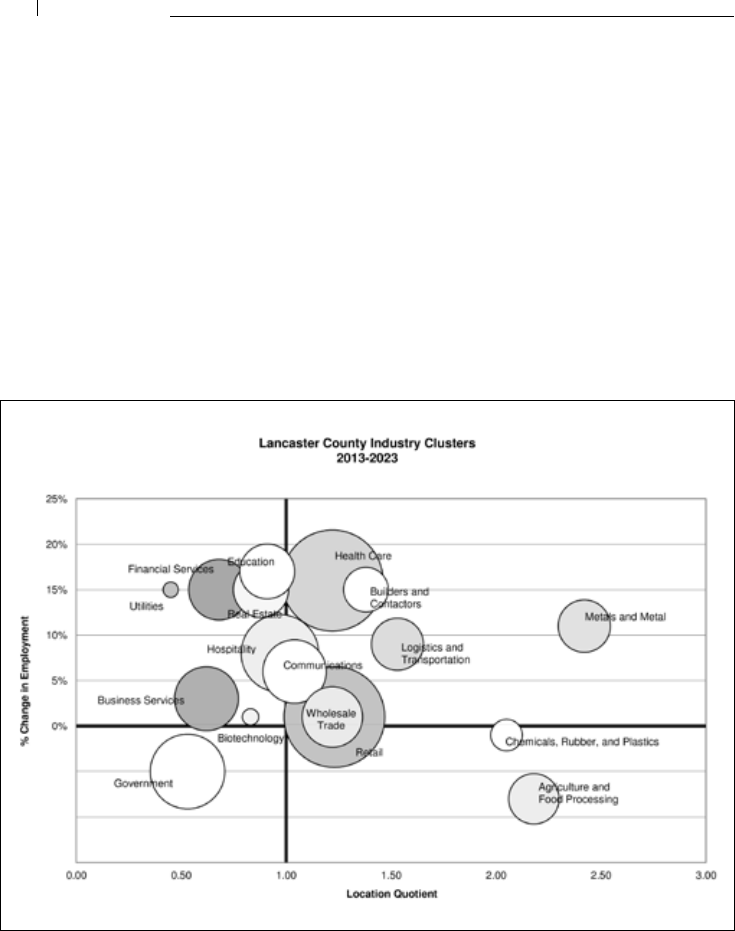
50
Charng can be done on a retrospecve basis (backward-looking) using data that is pub-
licly available from the Bureau of Labor Stascs of the U.S. Department of Labor. It is also
possible to do a bubble chart based on prospecve or forward-looking data by using data
provided by proprietary sources such as Economic Modeling Specialist Internaonal (which
is our provider).
For each industry, we normally look at three variables: size, expected growth, and
compeveness as measured by locaon quoent. Then we plot them out. We use the
bubble chart feature of Excel and connect the size of the industries to the size of the
bubbles. We plot those on a chart where the Y-axis is projected growth, and the X axis is
the locaon quoent.
Here is an example of a bubble chart of the Lancaster County, PA, regional economy,
which looks at the economy going forward from 2013-2023.
Noce how three of the four manufacturing-related industries have a locaon quoent
above 2. This means that they are concentrated at a rate that is 2 mes the naonal
average (which would be 1). These industries are highly compeve among their naonal
competors. Also, see that two of the four are expected to lose employment in the 10
year period. These are also two industries (agriculture and food processing and chemicals,
rubber, and plascs) that are highly automated and where technology is taking the place of
workers. None of the four industries is very big when it comes to total employment.
Compare this chart to one similarly constructed for greater Myrtle Beach, SC (Waccamaw
Workforce Investment Area, which includes Horry, Georgetown, and Williamsburg Counes).
Chapter Six
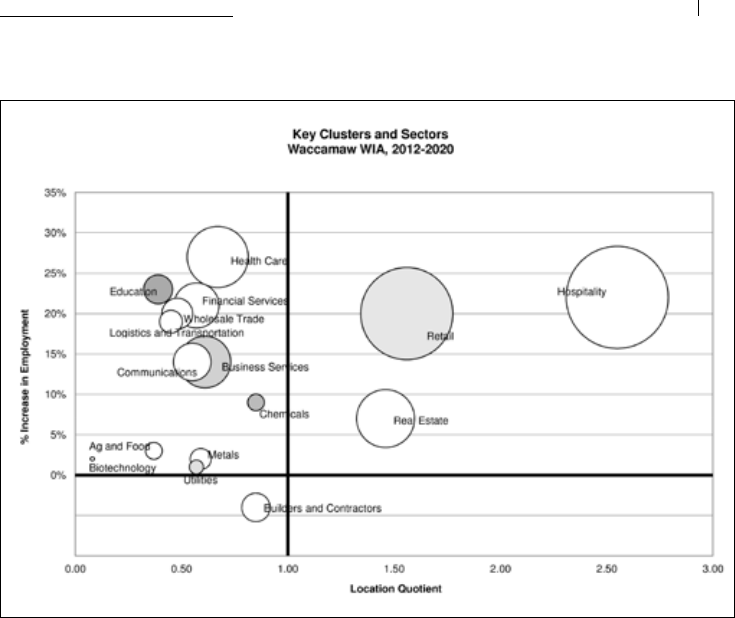
51
Manufacturing Workforce Development Playbook
Here, one barely sees any manufacturing, with hospitality and retail dominang in size,
compeveness, and growth.
On the surface, a planner might say that Lancaster County is a beer place to set up a
partnership to work on manufacturing skill aainment because of the large concentraon
of manufacturing-based industries. But let’s hold that thought for a minute.
Manufacturing in the Bigger Region
Oen, we need a certain level of scale to be able to develop structures to serve employers
in the way that they want to be served. Areas with a smaller workforce may need to look
beyond their local area to see whether manufacturing occurs elsewhere in the region.
Larger concentraons of manufacturing may be a part of even bigger concentraons in a
larger geographical area that may be capable of even larger-scale projects.
Typically, we use the On the Map tool from the U.S. Bureau of the Census to determine the
“laborshed” of the region. In other words, what are the average drive mes and the direcons
around which commuters move? Lancaster County is in a very dense laborshed that actually
includes heavy commung from the east (Chester County), west (York County), and north
(Lebanon and Berks Counes). Very few commuters come from across the state line in Mary-
land. The Waccamaw Workforce Investment Area has strong commute paerns from the
west (PeeDee Workforce Investment Area) and some to the south (Charleston metro area).
Commung paerns lead us to look at the regions where there are strong commung
connecons to see where manufacturing may or may not appear. In the case of Lancaster
County, we nd that Berks, Lebanon, and York Counes, all conguous to Lancaster County,
also have high concentraons of manufacturing, enough to think of a major manufacturing

52
super region with one of the heaviest concentraons on the East Coast. In the case of the
South Carolina region, we found some addional manufacturing in the areas to the west
and south, enough to think that the region was not only about hospitality and retail.
The Nature of Manufacturing Networks
Bubble charts give us a general sense of the place of manufacturing in the regional econ-
omy. Commung paerns paint a picture of how our regional economy ts into other
economies that are connected. We now have to develop an understanding of the intercon-
nectedness of the manufacturing cluster, both in the local area and in any other conguous
regions if that is a factor.
We nd that this is the me to drill down in the data and look for cluster “drivers”: indus-
try segments usually at the six-digit level of NAICS that outperform other manufacturing
segments. We normally go back to the same stascs as above—size, projected growth,
and projected concentraon (compeveness)—to nd the segments in manufacturing
that are outperforming others.
With the results, we are able to build a cluster from scratch that is signicant in the area.
In Lancaster County, this was the basis of forming the agriculture and food processing; met-
als and metal fabricang; chemicals, rubber, and plascs; communicaons (prinng); and
bio-manufacturing clusters that further break out manufacturing in the area. These four
groupings are large, growing, and have above-average concentraon (compeveness).
We nd it useful to take these more ne-tuned clusters and look further at their supply
chains in the hope of nding connecons among the industries in the cluster and among
other clusters in the economy.
• Agriculture and food processing is closely connected to the agriculture producon part
of Lancaster County, which ranks as one of the top-20 agriculture-producing counes
in the country.
• Chemicals, rubber, and plascs is closely ed to the packaging required for the agricul-
ture and food cluster and bio-manufacturing cluster and to building products (ooring
and ceilings) required for the construcon industry.
• Certain parts of the metals and metal fabricang cluster have strong es to agriculture
(agriculture equipment).
• Machine shops are subcontractors for many metal fabricators.
• Many industries within clusters are in another industry’s supply chain. Many clusters
are also in the supply chains of other clusters.
Career Pathways
It should be no surprise that, as we look at these relaonships, we also see interrela-
onships between the knowledge and skills within the network that we describe above.
Knowledge and skill ow freely across clusters and industries. We somemes see them in
occupaonal job tles that are shared. A material handler is a material handler whether
working in a prinng business or a metals manufacturing plant or in the fulllment center
Chapter Six

53
Manufacturing Workforce Development Playbook
of a large distributor. Carpenters and electricians are found in nearly every industry sector.
Informaon technology workers also keep the data owing in every aspect of every cluster.
Oen the trick for planners is a willingness to look below occupaon tles to the
knowledge and skills that the job requires. The O*Net occupaonal informaon system
maintained by the U.S. Department of Labor is very helpful in doing comparisons among
occupaons. We also suggest that the reader look at my earlier chapter on Career Path-
ways that is a part of this publicaon for more detail.
In Myrtle Beach, we were able to not only nd anies among manufacturing jobs in
other counes in the region, but we also found a great deal of overlap in the hospitali-
ty sector, where someone needs to maintain the elevators, the heang and venlaon
systems, and other features of the infrastructure for the sector. In fact, many of these jobs
have an 80% or beer compability rate with the jobs in manufacturing.
For Lancaster County, nearly every manufacturer tells us that they will always hire some-
one who grew up on a farm over someone who did not because the work ethic and the
skills that are part of the agricultural lifestyle make such a person an aracve hire, from
welding to construcon to lubricang equipment. Skills are portable, prized by industry,
and move across industries and clusters.
Summary
In summary, if you are a manufacturer involved in developing partnerships to address
workforce pipelines, we strongly recommend that you start with the numbers:
• Understand the place of manufacturing in your regional economy so that you get some
sense of its overall contribuon to gross regional product.
• Explore the issue of scale using commung paerns. If your manufacturing economy
is too small, you may need to think on a bigger geographical scale. If your manufactur-
ing economy is too big, you may need to concentrate on a sub-sector that is thriving
while, at the same me, looking for opportunies to take that sub-sector to a broader
geographical area.
• Supply and distribuon chain analysis may help you to understand the complexity of
the relaonships in manufacturing.
• Career pathways speak to the way that people acquire knowledge and the way that skills
move across clusters. Planners and ulmately the people who will be the implementers
of career counseling and training need to become conversant in the language of skills.
For Myrtle Beach, this analysis led to an understanding that the region was more than
“just hospitality.” Not only was it a part of a larger region that had a signicant number of
good-paying manufacturing jobs, but it also had jobs with similar skills embedded in the
hospitality industry. Any knowledge and skills training programming that was developed
could prepare people for jobs in both (and other) industries.

54
Chapter Six
In Lancaster County, the Lancaster County Workforce Investment Board has used this
process to:
• Priorize agriculture and food processing; metals and metal fabricang; communi-
caons (prinng); and bio-manufacturing as well as automove services; healthcare
(long-term care); and construcon as its priority industries in its strategic planning.
• Select representaves of those industries who are champions for the sector to serve
on the Board.
• Annually produce a list of the “Top 100 Hot Jobs in Lancaster, PA,” which is widely used
to do career educaon in the community.
• Develop within the PA CareerLink of Lancaster County, which is the comprehensive
One-Stop Service Center for the area, an intensive workforce readiness program along
with a robust curriculum to prepare people to enter the manufacturing workforce.
• Aend to the needs of the manufacturing industries in the area by forming the Center for
Manufacturing Excellence to work on the training needs of the incumbent workforce.
• Collaborate with PMMI to develop a naonal cercate program in industrial mainte-
nance and mechatronics through the Industrial Maintenance Training Center of North
America, an aliate of the Board.
Every area will have dierent needs. However, to build the right system, at the right
scale, in the right geography, and with the right curriculum, we need a foundaon of good
data to provide us with foundaonal informaon.

55
Manufacturing Workforce Development Playbook

56
J
ohn DeVere was one of the rst educators that I encountered as I embarked on
my quest to promote technology educaon for American manufacturing. John
was introduced to me because others told me that “he gets it.” Over the years, I
observed John living up to that compliment as he encouraged educators and others
to step outside of their boxes and try something new. One of those new ideas was
to focus on skills rather than curriculum, and then to nd a way to grant college
credit for skills achieved.
John has more than 25 years of experience at the community college level in
teaching, curriculum development, planning, evaluaon, and administraon. Pri-
or to rering, he was Vice President of Workforce and Economic Development at
Reading Area Community College. During his career he was: Chair of the Arcu-
laon Commiee for Advanced Manufacturing; member of the Advisory Council
for the Pennsylvania Statewide Performance Accountability System for Career and
Technical Educaon; member of the Tech Prep Advisory Commiee for Pennsylva-
nia Southeast Region; Project Director for Accelerated Training for Process Analyst
funded by the Pennsylvania Department of Community and Economic Develop-
ment; and a member of the Mid-Atlanc Mechatronics Advisory Council.
In his past posion, he oversaw the college’s Manufacturing Technology, Infor-
maon Technology, Occupaonal, and Adult Literacy programs. He is a member
of the Berks County Workforce Investment Board and parcipates in their Training
Commiee. He is a trained DACUM facilitator and has served as a consultant for
workforce development curriculum to state agencies, higher educaon instuons,
and secondary educaon instuons. In his last posion at RACC, he oversaw the
design, construcon, furnishing, and equipping of the Schmidt Training and Tech-
nology Center, a “world class” advanced manufacturing and informaon technology
training facility serving south central Pennsylvania. Prior to joining RACC’s sta,
John worked in quality assurance and research and development in the chemicals
industry. He has spent me as a high school science teacher, too.
Since rering from public educaon, John has formed Educaon and Training
Soluons, LLC. He provides feasibility studies, focus group facilitaon, training
needs analyses, DACUM proling, curriculum development, facility planning and
design, equipment specicaons, strategic planning, outcomes assessment, sta
development, and project management.
John DeVere,
Principal,
Education & Training
Solutions, LLC
When we think of what someone is about to study in school, we think
about curriculum. We look at a list of course titles, and if the courses
sound like they teach the right thing, we nod approvingly. But should
the goal be that we studied mechanical systems, or should it be that we
acquired the skills to correctly align and tension a chain drive or to specify
a gearbox? Appropriate skills for a career may be obtained through many
different curricula. On the ip side, many different curricula may leave one
wanting for the required career skills. By focusing upon skills rath-
er than curricula, one can readily adapt programs to the pathway
needs described in earlier chapters and provide a result that is
more acceptable to students and employers.
Chapter Seven

57
Manufacturing Workforce Development Playbook
B
y examining the history of American higher educaon and the evoluon of granng
college credit for liberal arts, career preparaon, and skills training programs, we can
gain insight into why change from a curriculum focus to a skills focus is so dicult in many
American colleges and universies. Schools that have successfully made this transion are
nding that their programs are valued by industry and their students are in high demand.
Examples of such programs will be found elsewhere in this Playbook.
The history of American higher educaon tells us that instuons began oering degree
programs in the 1600s. These colonial colleges were modeled aer Cambridge and Oxford,
and like these Brish universies had a religious aliaon focused on spiritual teachings.
Aer the Revoluonary War, Thomas Jeerson became a proponent of state educaon that
was based on scienc exploraon rather than religious teachings and indoctrinaon. This
included teaching using the lecture method, which laid the foundaon as to how higher
educaon was to be delivered at colleges emerging across the expanding U.S. The Morrill
Land Act of 1862 was responsible for the rapid growth of American higher educaon that
included the building of new colleges and expanding disciplines at exisng preeminent
universies. While a weak economy at the turn of the century stymied growth, prosperity
aer World War I caused college aendance to nearly double.
As higher educaon expanded and ourished, one of America’s wealthiest philanthro-
pists, Andrew Carnegie, became worried about faculty pensions. The soluon he success-
fully pushed, with the largesse of his foundaon, led to the creaon of the credit hour,
which has become the de facto standard of measuring academic work. He never intended
the me-based credit hour to be used to measure student learning; he saw it as a means
to create a free pension plan for underpaid faculty so they could rere at a reasonable
age. In order to opt in, the Carnegie Foundaon required colleges to adopt the me-based
standard: one credit hour for each hour of faculty-student contact me per week over a
15-week semester (Carnegie Unit), with most bachelor’s degrees consisng of 120 credits.
Skill Standards,
Not Curriculum Standards
Schools must provide a product that meets
customer needs by identifying the appropriate
skill requirements, not forcing students through
idealized curricula.
by John DeVere
Chapter Seven

58
However, the foundaon warned about the inadequacy of the credit hour as to measuring
student learning. To further instuonalize this measurement, for the sake of convenience,
the Carnegie Unit was adopted by the U.S. Department of Educaon as a means to estab-
lish nancial aid awards, thus inuencing how college credit classes were structured and
sll are today.
Following World War II, the Serviceman’s Readjustment Act (GI Bill) resulted in another
rapid increase in enrollments as veterans enrolled in colleges. A large number of people
who would not have previously considered higher educaon entered college as it became
a “licensing agency for middle-class Americans who wanted to enter professions.” It was
because of this surging opmism that the college degree came to be viewed as the cket to
upward mobility that it remains to this day.
In 1948, the Truman Commission suggested the creaon of a network of public, com-
munity-based colleges to meet local needs. This was due to the demand for educaon
and job-training programs as post World War II industries created jobs that required new
knowledge and skills. By the 1960s, 457 two-year public community and technical colleges
were opened. This trend connued, and at present there are over 1,100 community and
technical colleges in the U.S. For most community and technical colleges, the mission in-
cludes the following program oerings: credit programs that enable students to transfer to
baccalaureate programs aer compleng their rst two years, credit programs that prepare
students for careers, and noncredit skills training that enables students to gain employ-
ment or be promoted to higher-level posions. According to the faculty who control the
curriculum through shared governance (faculty have the responsibility to determine the
appropriate curriculum and procedures for student instrucon), these three endeavors are
quite dierent.
Transfer programs mirror the educaon that takes place at four-year instuons. The
courses, many of which are liberal arts, that make up these programs of study are struc-
tured just like those oered for the bachelor’s degree. The curriculum standards that
faculty establish for such courses come from their own experiences while earning advanced
degrees. These standards are subject maer-based and reect the faculty’s own classroom
learning or academic research. Added to this is the me required for classes to meet
according to the Carnegie Unit described above. This model sets the stage for establishing
curriculum standards for all courses that are awarded college credit.
Career programs dier from transfer programs in that the curriculum standards are es-
tablished by faculty who are professionals with experse in an occupaonal niche. Faculty
members oen hold licenses or professional cercaons and subscribe to accreding
agencies, which dictate certain curriculum requirements. For example, the Accreding
Board for Engineering and Technology (ABET) recognizes accreditaon from the Engineer-
ing Technology Accreditaon Commission (ETAC), or the Naonal Accreding Agency for
Clinical Laboratory Sciences (NAACLS) recognizes accreditaon for Medical Laboratory Sci-
enst. In order for courses in these programs to be approved for credit and degree status,
they must be sanconed by a governing body, including faculty represenng all academic
departments. Some courses termed general educaon requirements, which are usually
Chapter Seven

59
Manufacturing Workforce Development Playbook
liberal arts in nature, become part of the curriculum through this process. Thus, the driving
forces for establishing curriculum standards sll come from within the instuon with some
guidance from outside organizaons.
Noncredit skills training diers from credit-granng degree programs in that the stan-
dards are established by outside businesses and industries. Employers, solely or collecve-
ly, idenfy a skill set needed for a given occupaon. Oen the skill sets are recommended
or endorsed by a trade organizaon or cerfying body. For example, the Naonal Associ-
aon of Manufacturers (NAM) endorses the following skills credenals: Naonal Instute
for Metalworking Skills (NIMS) – Machining Level 1; Manufacturing Skills Standards Council
(MSSC) – Cered Producon Technician; and The Associaon for Packaging and Processing
Technologies (PMMI) – Mechatronics Cercate/Industrial Electricity 1. The college then
develops a training program designed to meet this idened need. Industry-recognized
skills credenals are awarded to those compleng such training and passing an assessment.
Seat me requirements are not relevant because the outcome is to be able to perform
idened skills that can be transferred back to the work place in short order. Since college
credit is not granted, the colleges’ governing bodies, including faculty, need not approve
such programs.
Having idened needs for specic skills training from industry, progressive communi-
ty and technical colleges throughout the U.S. have created two-year career programs by
incorporang such skills training into their credit curricula. They have established program
advisory councils consisng of key employer representaves and workforce development
leaders to idenfy appropriate skills needed for a given occupaon. Credit course outlines
have been developed by incorporang the idened skills into competency-based learning
outcomes. (In order to address the issue of required class meeng me for granng college
credit according to the Carnegie Unit, they have ulized its denion: One laboratory credit
hour requires at least two hours of supervised or independent laboratory work per week
over a 15-week semester.) Germane general educaon courses required for a two-year
career program have been added to supplement the skills-based courses. The enre com-
plement of courses, which makes up the two-year degree, has been veed by the colleges’
faculty and governing bodies and approved. Where required, these programs of study have
been submied to the state’s department of educaon for review and approval. The bonus
to students is that they can simultaneously earn naonally, statewide, or locally recognized
skills credenals while pursuing the two-year degree, since such are embedded in the cred-
it curriculum. In some cases, these two-year degrees have been arculated with four-year
degree programs aording students the opportunity to also pursue a bachelor’s degree.
The bonus to educaonal instuons is that the same faculty can deliver the noncredit
skills training and credit courses simultaneously, thus maximizing instruconal resources.
As more and more technology makes its way into American manufacturing, the need to
include skills training in community and technical college degree programs has become
evident. Rather than looking within the instuon to establish new curriculum, commu-
nity and technical colleges need to be cognizant of the rapid advancement in manufac-
turing technology and turn to the customer (manufacturers) of its product (skill-trained

60
graduates) for curriculum input. Manufacturers need to play an acve role in this process
by volunteering to serve on community and technical colleges’ career programs adviso-
ry boards and communicang their skills training needs. Competency-based instrucon
(acve learning through hands-on skills mastery and the ability to troubleshoot systems)
needs to be added to tradional didacc instrucon (passive learning through reading, lec-
ture, problem solving, and examinaons) as a way to deliver student learning. Faculty need
to change, too. They need to recognize that the skills training needed to support and grow
our manufacturing economy is as relevant and important as the subject maer woven into
tradional transfer and career programs.
References
Accreding Board for Engineering and Technology (ABET): Accreditaon Criteria and
Supporng Documents. Retrieved from hp://www.abet.org/accreditaon-criteria-policies-
documents/
Fain, P. (2012). Hour by Hour, Inside Higher Educaon. Retrieved from hp://www.
insidehighered.com/news/2012/09/05/credit-hour-causes-many-higher-educaons-
problems-report-nds
History of American Higher Educaon: Pursuing the College Degree. (2008). Random
History and Word Origins for the Curious Mind. Retrieved from hp://www.randomhistory.
com/1-50/039degree.html.
Manufacturing Skill Standards Council: Producon Cercaon (CPT). Retrieved from
hp://www.msscusa.org/producon-cercaon-cpt/ .
Naonal Accreding Agency for Laboratory Sciences (NACCLS): Accreditaon. Retrieved
from hp://www.naacls.org/accreditaon/
Naonal Associaon of Manufacturers: Workforce Development and Training. Retrieved
from hp://www.themanufacturinginstute.org/Skills-Cercaon/Cercaons/NAM-
Endorsed-Cercaons.aspx#MM .
Naonal Instute for Metalworking Skills: Complete Guide to NIMS
Credenaling. Retrieved from hps://www.nims-skills.org/c/document_library/get_
le?folderId=230729&name=DLFE-2503.pdf .
Naonal Educaon Associaon (NEA): faculty governance in higher educaon (n.d.) In
Wikipedia online. Retrieved from hp://en.wikipedia.org/wiki/Governance_in_higher_
educaon#Naonal_Educaon_Associaon_.28NEA.29:_faculty_governance_in_higher_
educaon.
Packaging Machinery Manufacturers Instute: PMMI –Mechatronics
– Educaon. Retrieved from hp://www.pmmi.org/Educaon/content.
cfm?ItemNumber=1010&navItemNumber=1061 .
Phillippe & Paon, (2000). Community Colleges Past to Present, Naonal Prole of
Community Colleges: Trends & Stascs.
Structure of the U.S. Educaon System: Credit Systems. (2008). Internaonal Aairs
Oce, US Department of Educaon. Retrieved from hp://www.ed.gov.
Chapter Seven

61
Manufacturing Workforce Development Playbook

62
In an earlier chapter, we learned about how planners need to rethink the
pathways available to students as they move through the education system
and on to work. But we already have some of these alternatives in place,
and students are not taking advantage of them. In a region where CNC
machinists are well paid and highly sought after, CNC machine shop class-
es, which are free to local high school students, are being closed down for
lack of students. Guidance counselors are not informed on manufacturing
careers, and parents remember too vividly when cousin Joe was
laid off from a steel mill. Students need to be better informed about
alternatives for their future and how these alternatives can give
them a competitive advantage as they seek success.
Kevin J. Fleming, Ph.D,
Dean of Instruction, CTE &
Principal Investigator, NSF,
Norco College
A
year or two ago, I wrote in OnTheEdgeBlog.com that I believe that Amer-
ica needs to change the dialog surrounding higher educaon. Recently, a
colleague pointed me to a video on the web that truly made that case and
backed it up with numerous facts and references. With the design of this Playbook
underway, I immediately contacted the video’s author and asked if he would be a
contributor. Kevin Fleming agreed, and our dialog is connuing.
Dr. Fleming currently serves dual roles at Norco College (CA) as the Dean of In-
strucon, Career & Technical Educaon, and as the Principal Invesgator for the
Naonal Center for Supply Chain Technology Educaon funded by the Naonal
Science Foundaon. In addion, Dr. Fleming is the Managing Partner of Telos Edu-
caonal Services, an internaonal consulng rm that provides markeng research
and organizaonal strategy with experse in the educaonal sector. Dr. Fleming has
been facilitang workshops and conducng leadership training sessions accompa-
nied by numerous conference presentaons and published arcles.
Previously, Dr. Fleming analyzed industry trends to provide economic develop-
ment and labor market research through the Centers of Excellence for the Califor-
nia Community College system, the largest public educaonal system in the world.
A true entrepreneur, Dr. Fleming has also co-founded three companies in dierent
service sectors (West Coast All Stars LLC, Green LMI, and Living The Ritual) and
serves on the advisory boards for Paragon, Inc. and California Bapst University’s
School of Educaon.
Chapter Eight

63
Manufacturing Workforce Development Playbook
Chapter Eight
E
ducaon is core to our economy. But to guide our educaonal systems and
maximize future income, we must understand the misalignment between
educaon and our workforce.
In my pursuit of higher educaon, I have earned two bachelor’s degrees, two master’s
degrees, and a Ph.D. In total, this has cost me over $150,000. I’ve done all of this because
I believe formal educaon is important. Part of this belief came from seeing charts like this,
which shows on average that a person with a college degree earns far more money than the
average person without a high school diploma.
1
Success in the new economy
A post-high school credential for all is a
better message than college for all.
by Kevin J. Fleming, Ph.D.
EDUCATIONAL LEVEL EARNINGS
Professional Degree
Doctoral Degree
Master’s Degree
Bachelor’s Degree
Associate Degree
Some College, No Degree
High School Graduate
Not a High School Graduate
$100,000
$79,400
$61,300
$50,900
$40,600
$37,100
$31,500
$23,400
This percepon that higher earnings come with having a four-year degree has fueled a
“college for all” philosophy. It’s caused educators and parents to encourage going to the
university—any university—to major in anything in pursuit of future job security, social
mobility, and nancial prosperity.
2
This philosophy has increased college enrollment,
resulng in 66% of high school graduates in this country enrolling in higher educaon right
aer high school.
3
That’s two out of three. Inially, they are deemed the successful ones.

64
But what you won’t see adversed is the reality that most drop out, and only a quarter of
those who enroll will nish a bachelor’s degree.
4
Only aer these few graduate do many of them start exploring careers.
5
It is here that
they discover that their degree may not have prepared them for the world of work.
6
You
may be well educated, but not every degree is direct preparaon for employment.
7
This
misalignment between degrees and job skills causes half of university graduates to be
underemployed in what are called gray-collar jobs.
8
That is, they’re in posions that do not
require the educaon they have received, at a cost that is more than they can aord.
9
Convenonal wisdom suggests that a university degree guarantees a higher salary.
But with rising educaon costs, a shrinking job market, and the oversaturaon of
some academic majors in the workforce, this old advice is now a myth for a majority of
students.
10
The economy and the world have dramacally changed. Over the last three
generaons, we’ve gone from 13% of the populaon stepping into a college classroom, to
60% aending some form of higher educaon.
11
In 1960, when taking into account all jobs in the American economy, 20% required a
four-year degree or higher, 20% were technical jobs requiring skilled training, and 60% were
classied as unskilled.
12
But what’s the right percentage to meet the labor market demand
for tomorrow? In 2018, Harvard University predicts only 33% of all jobs will require a four-
year degree or more, while the overwhelming majority will be middle-skilled jobs requiring
technical skills and training at the credenal or associate degree level.
13
A four-year degree may have many benets, but think about people you may know who,
from an economic perspecve, ineciently spent me and money to get a degree that
perhaps they didn’t really need for the career they are in.
14
The true rao of jobs in our economy is 1:2:7.
15
For every occupaon that requires a
master’s degree or more, two professional jobs require a university degree, and there are
seven jobs requiring a one-year cercate or two-year degree. The jobs requiring a one-
year cercate or two-year degree are technician jobs in very high-skilled areas that are in
great demand.
16
This rao is a fundamental to all industries. It was the same in 1950, the
same in 1990, and will be the same in 2030.
17
The hope for encouraging university educaon is that as the number of university-
trained workers increases, the demand for their services in the workplace will increase as
well. Unfortunately, this is not so. The whole pie may get bigger as the labor force and
the economy grow, but the rao will not change.
18
The reality is there will not be more
professional jobs available within the labor market.
19
And some professional jobs have
been replaced by technology, or are being outsourced.
20
Well-intenoned aempts to send more and more students straight to the university
will not change the types of jobs that dominate our economy, nor will a “college-for-
all” mentality mask these labor market realies.
21
The “college-for-all” rhetoric that has
been so much a part of the current educaon reform movement is oen interpreted as
“university for all.” This message needs to be signicantly broadened to, “a post-high
school credenal for all.”
22
Students at various educaonal levels have le school without
employable skills, seng up our children for failure and cosng them and taxpayers
Chapter Eight

65
Manufacturing Workforce Development Playbook
millions.
23
All while the labor market is desperate for highly-trained, skilled technicians.
24
So
how do you posion yourself for high-wage, in-demand jobs?
Let’s say you were considering a career as either an electrician or a business manager.
You would nd that the average annual income for electricians is $51,000, only about half
of the $105,000 average wage for management occupaons.
25
So at rst glance it looks
as if geng a bachelor’s degree in business is a no-brainer, but adding skills and ability
into the picture adds a whole new dynamic. What if you have the potenal to become an
excellent electrician, but lack the skills and ability to be an excellent manager? Then you
should be looking at projected incomes toward the boom of the pay scale for managers
and toward the top for electricians.
26
You would then discover that electricians near the top
of the pay scale make around $86,000, far higher than the income of a manager near the
boom of the pay scale at $52,000.
27
Now, this is just one example, but the concept is true throughout all industries.
28
The
claim that you will make more money with an increased amount of educaon is not
necessarily inaccurate, it’s just incomplete.
29
That advice is based just on the averages.
But no one is perfectly average. Everyone has unique skills, talents, and interests. In fact,
the income for the top individuals in a wide variety of skilled jobs that require an industry
credenal or two-year degree is far higher than the average income for many occupaons
that require a four-year degree.
30
Naonally, associate degree earners range between $27,000- $68,000, while bachelor’s
recipients earn between $34,000 - $97,000.
31
But this data only accounts for the 25th percenle
to the 75th percenle of full-me, adult workers. This means 25% of associate degree holders
earn more than $68,000 annually, and 25% of bachelor’s degree holders earn less than $34,000!
Our world has changed, and in this new economy, the university degree is no longer the
guaranteed path toward nancial success as it was for previous generaons.
32
And even
if you do earn one, that educaon alone may not be enough.
33
In today’s highly technical
knowledge-based economy, having hands-on skills and perfecng what you’re good at can
be more valuable than geng a degree in “something” simply to get one.
34
Employers want
to know what you can do, and what you can do well; not just what degree hangs on your
wall.
35
Since new and emerging occupaons in every industry now require a combinaon
of academic knowledge and technical ability, we need to ensure that we’re also guiding
students toward careers and not just to the university.
So before enrolling in classes or deciding what you’re going to do next in your life, step
one is self-exploraon.
36
In addion to your interests, really analyze your talents and
strengths. Step two is career exploraon; understand the jobs available and the income
ranges they pay, and evaluate the skills they require. Idenfying an area that appeals to
your interests, skills, and the labor market may be your rst career. And then you can
develop a tentave career plan complete with mulple training and educaon opons.
37
The key is to align your interests and abilies with your rst career choice and the
educaon and training you’ll need to receive.
38
This alignment will help bring your future
into focus, and ensure your posion at the top of the pay scale in your chosen career.
What all this data shows is that success in the new economy is as much about acquiring

66
the knowledge, skills, and abilies needed for in-demand occupaons as it is to be well
educated. Both paths may work for you, but educaon combined with technical training
is how you ulmately secure a compeve advantage in the new economy.
39
Community
colleges are in the ideal posion to provide over 70% of tomorrow’s workforce with an
educaon combined with applied technical skills, industry-driven credenals, and specic
preparaon for employment.
40
Being a skilled crasman or technician is highly valued.
Investments in career educaon programs in high schools and community colleges will help
all students obtain an educaon that includes technical training and preparaon for the
workplace. Ulmately, this is how all students can be successful.
In the new economy, both educaon and technical skills are the new currency.
Will you be ready?
This chapter was adapted from: Fleming, K (2013). Success in the New Economy: How
prospecve college students can gain a compeve advantage. Funded by Title IC grant
#12-CO1-009 awarded to Citrus College by the California Community Colleges Chancellors
Oce: Telos Educaonal Services. Retrieved from www.TelosES.com.
1. The College Board, Educaon Pays 2010, cing U.S. Census Bureau wage data.
2. The Conference Board. (2006). Are they Really ready to Work?: Employers’ Perspecves on the Basic Knowledge
and Applied Skills of New Entrants to the 21st Century U.S. Workforce. And: Bosworth, B. (2010). Cercates
Count: An Analysis of Sub-baccalaureate Cercates. Washington, DC: Complete College America. And: Deil-Amen
& DeLuca. (2010). The Underserved Third: How our Educaonal Structures Populate an Educaonal Underclass.
Routledge. And: Gray, K. & Herr, E. (2006). Other Ways to Win: Creang Alternaves for High School Graduates.
Third Edion. Thousand Oaks: Corwin Press. And: Symonds, W., Schwartz, R., & Ferguson, R. (February 2011).
Pathways to Prosperity: Meeng the Challenge of Preparing Young Americans for the 21st Century. Report issued
by the Pathways to Prosperity Project, Harvard Graduate School of Educaon.
3. The rate of college enrollment immediately aer high school compleon increased from 49 percent in 1972
to 67 percent by 1997, but since 2002 has uctuated between 62 and 69 percent. Source: US Dept of Educaon,
Naonal Center for Educaon Stascs.
4. Horn & Berger. (2005). College persistence on the rise? Changes in 5-year degree compleon and postsecondary
persistence rates between 1994 and 2000. Washington DC: Naonal Center for Educaonal Stascs. And:
Symonds, W., Schwartz, R., & Ferguson, R. (February 2011). Pathways to Prosperity: Meeng the Challenge of
Preparing Young Americans for the 21st Century. Report issued by the Pathways to Prosperity Project, Harvard
Graduate School of Educaon, And: Gray, K. & Herr, E. (2006). Other Ways to Win: Creang Alternaves for High
School Graduates. Third Edion. Thousand Oaks: Corwin Press.
5. CA Postsecondary Educaon Commission. And: Deil-Amen & DeLuca. (2010). The Underserved Third: How our
Educaonal Structures Populate an Educaonal Underclass. Routledge.
6. Bureau of Labor Stascs. (Winter 2007-08). What can I do with my Liberal Arts Degree? Occupaonal Outlook
Quarterly. And: The Workforce Alliance. (2009). California’s Forgoen Middle-Skill Jobs: Meeng the Demands of
a 21st Century Economy. Washington DC.
7. Jacobson, L., et al. (2009). Pathways to Boosng the Earnings of Low-Income students by Increasing their
Educaonal Aainment, Gates Foundaon/Hudson Instute. And: The Workforce Alliance. (2009). California’s
Chapter Eight

67
Manufacturing Workforce Development Playbook
Forgoen Middle-Skill Jobs: Meeng the Demands of a 21st Century Economy. Washington DC.
8. Industry Workforce Needs Council (www.iwnc.org). And: Gray, K. & Herr, E. (2006). Other Ways to Win: Creang
Alternaves for High School Graduates. Third Edion. Thousand Oaks: Corwin Press.
9. Greene, K. (Oct 27, 2012). A New Peril for Older Parents: Student Loans They Co-Signed. The Wall Street Journal.
p.A1&A12. And: Deming, D., Claudia, G., & Lawrence, F. (2012). “The For-Prot Postsecondary School Sector:
Nimble Criers or Agile Predators?,” Journal of Economic Perspecves, American Economic Associaon, 26(1):
139-164. And: Carnevale, A., Rose, S., & Hanson, A. (2012). Cercates: Gateway to Gainful Employment and
College Degrees. Center on Educaon and the Workforce, Georgetown University.
10. Epperson, S. (August 28, 2012). No College Degree Required for these $100,000 jobs. USA Today. And:
Godofsky, J., Zukin, C., & Van Horn, C. (2011). Unfullled Expectaons: Recent College Graduates Struggle in a
Troubled Economy. John J. Heldrich Center for Workforce Development, Rutgers. And: Jacobson, L., et al. (2009).
Pathways to Boosng the Earnings of Low-Income students by Increasing their Educaonal Aainment, Gates
Foundaon/Hudson Instute.
11. The College Board, Educaon Pays 2010, Figure 2.7; U.S. Census Bureau, 2009b, Table A-1.
12. Project Lead the Way (www.pltw.org). And: GetReal (www.getrealca.com).
13. 90% of all jobs in the future will require some educaon and training beyond high school according to: The
Naonal Science Foundaon (2012) PI Conference keynote by Jane Oates, Assistant Secretary ETA, Department
of Labor. And: Symonds, W., Schwartz, R., & Ferguson, R. (February 2011). Pathways to Prosperity: Meeng
the Challenge of Preparing Young Americans for the 21st Century. Report issued by the Pathways to Prosperity
Project, Harvard Graduate School of Educaon. And: Deil-Amen & DeLuca. (2010). The Underserved Third: How
our Educaonal Structures Populate an Educaonal Underclass. Routledge. And: The Bureau of Labor Stascs,
Occupaonal Outlook Handbook, 2010-2011 Edion. And: The Workforce Alliance. (2009). California’s Forgoen
Middle-Skill Jobs: Meeng the Demands of a 21st Century Economy. Washington DC.
14. Recent publicaons all raise this queson in dierent ways, For example, Forbes’ August 2012 arcle, “Do you
Really need to go to College?,” or the New York Times’ May, 2010 piece “Plan B: Skip College,” or The Washington
Post’s September, 2010 story, “Some say bypassing higher educaon is smarter than paying for a degree,” or The
Chronicle of Higher Educaon’s October 2010 story, “Here’s Your Diploma. Now Here’s Your Mop,” and even viral
videos from Mike Rowe, the host of ‘Dirty Jobs’ promong CTE educaon (hp://www.mikeroweworks.com/) and
Sir Ken Robinson’s speech, “Changing Educaon Paradigms” advocang for the reform of educaon.
15. Gray, K. & Herr, E. (2006). Other Ways to Win: Creang Alternaves for High School Graduates. Third Edion.
Thousand Oaks: Corwin Press.
16. U.S. Bureau of Labor Stascs. Occupaonal Outlook Handbook 2012-13. Oce of Occupaonal Stascs and
Employment Projecons.
17. Gray, K. & Herr, E. (2006). Other Ways to Win: Creang Alternaves for High School Graduates. Third Edion.
Thousand Oaks: Corwin Press.
18. Bureau of Labor Stascs (2010). Occupaonal Outlook Handbook 2010-11 Edion. U.S. Department of Labor.
19. Department of Labor (December 8, 2010), Table 1.3 Fastest Growing Occupaons, 2008 and projected 2018.
Employment Projecons Program, U.S. Bureau of Labor Stascs.
20. Friedman, T. (2005). The World is Flat: A Brief History of the Twenty-First Century. New York: Farrar, Straus,
and Giroux.
21. Deil-Amen & DeLuca. (2010). The Underserved Third: How our Educaonal Structures Populate an Educaonal
Underclass. Routledge.

68
22. Symonds, W., Schwartz, R., & Ferguson, R. (February 2011). Pathways to Prosperity: Meeng the Challenge
of Preparing Young Americans for the 21st Century. Report issued by the Pathways to Prosperity Project, Harvard
Graduate School of Educaon.
23. Fleming, K. (April 2012), The Inland Empire’s Neglected Majority: By the Numbers. Paper presented at
California Community College Associaon for Occupaonal Educaonal. Costa Mesa, CA. And: Symonds, W.,
Schwartz, R., & Ferguson, R. (February 2011). Pathways to Prosperity: Meeng the Challenge of Preparing Young
Americans for the 21st Century. Report issued by the Pathways to Prosperity Project, Harvard Graduate School of
Educaon. And: The Workforce Alliance. (2009). California’s Forgoen Middle-Skill Jobs: Meeng the Demands of
a 21st Century Economy. Washington DC. And: Sco, J., and Sarkees-Wircenski, M. (2004). Overview of Career and
Technical Educaon: Third Edion. Homewood, Illinois: American Technical Publishers, Inc.
24. Carnevale, A., Jayasundera, T., & Hanson, A. (2012). Career & Technical Educaon: Five Ways that Pay along
the Way to the B.A. Center on Educaon and the Workforce, Georgetown University. And: The Workforce Alliance.
(2009). California’s Forgoen Middle-Skill Jobs: Meeng the Demands of a 21st Century Economy. Washington DC.
And: Gray, K. & Herr, E. (2006). Other Ways to Win: Creang Alternaves for High School Graduates. Third Edion.
Thousand Oaks: Corwin Press.
25. California Labor Market Informaon Division, Employment Development Department data.
26. Example adapted from Charles Murray’s Real Educaon: Four Simple Truths for Bringing America’s Schools Back
to Reality, as well as W.N. Grubb’s research on postsecondary educaon and the sub-baccalaureate labor market.
27. California Labor Market Informaon Division, Employment Development Department data, 10 and 90
percenle excluding sole proprietorships.
28. Carnevale, A., Strohl, J., & Melton, M. (2011). What’s It Worth?:The Economic Value of College Majors. Center
on Educaon and the Workforce, Georgetown University.
29. Epperson, S. (August 28, 2012). No College Degree Required for these $100,000 jobs. USA Today. And: Center
on Educaon and the Workforce, Valuing Cercates. (2009). Presentaon. And: Osberg, L. (2001). Needs and
Wants: What is Social Progress and how should it be measured. The Review of Economic Performance and Social
Progress 2001. Vol. I pp23-41. And: Fiedrich, M. and Jellema, A. (2003). Literacy, Gender and Social Agency:
Adventures in Empowerment, DFID Research Report 53. And: The Workforce Alliance. (2009). California’s
Forgoen Middle-Skill Jobs: Meeng the Demands of a 21st Century Economy. Washington DC.
30. Carnevale, A., Jayasundera, T., & Hanson, A. (2012). Career & Technical Educaon: Five Ways that Pay along
the Way to the B.A. Center on Educaon and the Workforce, Georgetown University. And: Carnevale, A., Rose, S.,
& Hanson, A. (2012). Cercates: Gateway to Gainful Employment and College Degrees. Center on Educaon and
the Workforce, Georgetown University. And: Epperson, S. (August 28, 2012). No College Degree Required for these
$100,000 jobs. USA Today. And: Adler, L. (2010). California Career & Technical Educaon 2010 Longitudinal Study,
University of California, Riverside; School Improvement Research Group. And: The College Board, Educaon Pays
2010, Figure 1.5; U.S. Census Bureau, 2009. And: Mitchell, D. (2006). California Regional Occupaonal Centers and
Programs 2006 Longitudinal Study. University of California, Riverside; School Improvement Research Group. And:
Jacobson, L., et al. (2009). Pathways to Boosng the Earnings of Low-Income students by Increasing their Educaonal
Aainment, Gates Foundaon/Hudson Instute. And: The Workforce Alliance. (2009). California’s Forgoen Middle-
Skill Jobs: Meeng the Demands of a 21st Century Economy. Washington DC. And: Deil-Amen & DeLuca. (2010). The
Underserved Third: How our Educaonal Structures Populate an Educaonal Underclass. Routledge.
31. The College Board. (2010). Educaon Pays 2010, Figure 1.5; U.S. Census Bureau 2009 data.
32. Jacobson, L., et al. (2009). Pathways to Boosng the Earnings of Low-Income students by Increasing their
Chapter Eight

69
Manufacturing Workforce Development Playbook
Educaonal Aainment, Gates Foundaon/Hudson Instute. And: Carnevale, A., & Derochers, D. (2003). Standards
for what? The economic roots of K-16 reform. Princeton, NJ: Educaonal Tesng Service. And: Sco, J., & Sarkees-
Wircenski, M. (2004). Overview of Career and Technical Educaon: Third Edion. Homewood, Illinois: American
Technical Publishers, Inc.
33. Carnevale, A., Strohl, J., & Melton, M. (2011). What’s It Worth?: The Economic Value of College Majors. Center on
Educaon and the Workforce, Georgetown University.
34. Davidson, P. (October 17, 2012). Employment Surges for Community College Grads. USA Today. And: Epperson, S.
(August 28, 2012). No College Degree Required for these $100,000 jobs. USA Today. And: Coyle, Daniel (2009). The
Talent Code. New York: Bantam Books. And: Center on Educaon and the Workforce, Valuing Cercates. (2009).
Presentaon, as sourced in “ACTE Fact Sheet.” And: Jacobson, L., et al. (2009). Pathways to Boosng the Earnings of
Low-Income students by Increasing their Educaonal Aainment, Gates Foundaon/Hudson Instute.
35. Achieve, Inc. (2004). Ready or Not: Creang a High School Diploma That Counts. The American Diploma Project.
And: Corporate Voices for Working Families. (2011). Why companies invest in “grow your own” talent development
models. And: Carnevale, A., Jayasundera, T., & Hanson, A. (2012). Career & Technical Educaon: Five Ways that Pay
along the Way to the B.A. Center on Educaon and the Workforce, Georgetown University.
36. Whiield, Feller, & Wood. (2009). A Counselor’s Guide to Career Assessment Instruments, Fih Edion. Naonal
Career Development Associaon. And: California State Board of Equalizaon’s Working Your Way Up campaign. And:
Wallace-Broscious, A., Seraca, F. C., & Osipio, S. H. (1994). Adolescent career development: Relaonship to self-
concept and identy status. Journal of Research on Adolescence, 4(1), 127–149.
37. Levine, M. (2005). Ready or not: Here life comes. Chapel Hill, NC: University Press.
38. Carnevale, A., & Derochers, D. (2003). Standards for what? The economic roots of K-16 reform. Princeton, NJ:
Educaonal Tesng Service.
39. Carnevale, A., Jayasundera, T., & Hanson, A. (2012). Career & Technical Educaon: Five Ways that Pay along the
Way to the B.A. Center on Educaon and the Workforce, Georgetown University.
40. Castellano, M., Stringeld, S., & Stone III, J.R. (2003). Secondary career and technical educaon and
comprehensive school reform: Implicaons for research and pracce. Review of Educaonal Research, 73, 231-272.
And: Cohen & Besharov. (2004). The important role of career & technical educaon: Implicaons for federal policy.
Welfare Reform Academy Report. Washington DC: American Enterprise Instute for Public Policy Research. And:
Brown, C. H. (2000). “A Comparison of Selected Outcomes of Secondary Tech Prep Parcipants and Non-Parcipants
in Texas.” Journal of Vocaonal Educaon Research,25, no. 3, 273-295. And: Cardon, P. L. (Winter-Spring 2000). “At-
Risk Students and Technology Educaon: A Qualitave Study.” Journal of Technology Studies,26, no. 1, 49-57. And:
Plank, DeLuca & Estacion (2008). High school dropout and the role of CTE: A survival analysis of surviving high school.
Sociology of Educaon, 81, 345-370. And: Deil-Amen & DeLuca. (2010). The Underserved Third: How our Educaonal
Structures Populate an Educaonal Underclass. Routledge. And: Harvey, M. W. (Spring 2001). “The Ecacy of
Vocaonal Educaon for Students with Disabilies Concerning Post-School Employment Outcomes: A Review of the
Literature.” Journal of Industrial Teacher Educaon 38, no. 3: 25-44.

70
Carol Adukaitis, Ed.D,
Director, Pathways for
Career Success, PA
State System of Higher
Education
A
s I’ve traveled around Pennsylvania to discuss manufacturing technology ed-
ucaon, one person who has consistently oered posive encouragement
has been Carol Adukais. Carol encourages dialog among stakeholders and
is an advocate for new ideas and new technologies.
Carol is Director, Pathways for Career Success at the PA State System of Higher
Educaon (PASSHE). This iniave is funded by the Department of Community and
Economic Development (DCED) and managed by PASSHE to develop 2+2+2 seam-
less arculated curricula from secondary to postsecondary schools in emerging
technologies to supply industry with trained and cered workers to compete in
a global economy.
She has served as Director, Advanced Manufacturing STEM Academies; Director,
Health Sciences STEM Academies; and Director, Girls in STEM Academies. She was
the Co-Principal Invesgator for the Naonal Science Foundaon award, Advanced
Manufacturing: Establishing Foundaons for Educaon and Career Pathways from
Middle School through College. Carol has provided leadership to a number of other
PASSHE projects, including Project Lead the Way funded by the Society of Manufac-
turing Engineers Educaon Foundaon.
Carol holds a Doctorate in Educaon from Temple University, a Masters in Busi-
ness Educaon from Bloomsburg University of PA, a Bachelors in Business Educa-
on from the University of Delaware, a Superintendents and Principals Cercaon
from Lehigh University, and an English as Second Language Cercaon from Penn
State University.
It is a common misperception that vocational education is not a pathway to
college and that industrial training is not a substitute for a college degree.
Both of these have been proven wrong. The degree completion rate for
students entering college from a vocational education program is about twice
that of students entering from an academic high school program. Progressive
educators have crafted systems whereby students may alternate from school
to work to school to work without penalty. Students may leave high school
with a signicant number of college credits under their belts—for free—and
may transfer credits from one institution to another. Incumbent workers may
translate existing skills to credits, through testing and examination, and may
obtain credit for training programs sponsored by their employers. Students
may supplement that training with general education requirements, leading
to a degree, sometimes with their employer’s nancial support. All of
these solutions offer alternative means for students and workers to
obtain a college degree that is built upon employment skills.
Chapter Nine

71
Manufacturing Workforce Development Playbook
Training and College Credit
According to best practices, students should
obtain college credit for workforce training
and prior knowledge.
by Carol Adukaitis, Ed.D.
Chapter Nine
A
dvanced manufacturing is crucial to America’s economic vitality and includes many
occupaons that pay above family-sustaining wages. In my state of Pennsylvania,
the Commonwealth’s manufacturers must have access to a larger pool of skilled workers
to remain compeve in the global economy. As reported by the PA Center for Advanced
Manufacturing Careers Statewide 2010 Report (www.paworkforce.state.pa.us), Pennsylva-
nia’s manufacturing sector faces three disnct challenges:
• An aging workforce currently holding key manufacturing posions
• The lack of an eecve talent pipeline
• Higher skill requirements for modern manufacturing
Low-skilled employment opportunies are disappearing, and our economy is shiing to
a knowledge base that requires more American workers with postsecondary credenals.
This chapter will focus on idenfying established strategies that allow students who are
more mobile and nontradional to earn postsecondary credenals that will save them me
and money while ulizing the prior learning experiences they may already have. These
strategies reward the student for knowledge, skills, and abilies rather than me spent in
the classroom.
The Need for Training, Certificates, and Degrees
The U.S., and Pennsylvania in parcular, will not be able to meet the skilled labor needs of
2018. In a 2010 report tled, “Help Wanted: Projecons of Jobs and Educaon Require-
ments Through 2018,” Anthony Carnevale, Director of the Georgetown University Center
on Educaon and Workforce, projected that employers will need 22 million new workers
with postsecondary degrees by 2018 … or we will fall short by 3 million workers without a
dramac change. This translates to a decit of 300,000 college graduates every year now
through 2018.
Lack of degree compleon negavely aects Pennsylvania’s economic growth. The
Lumina Foundaon’s 2013 Report, “A Stronger Naon Through Higher Educaon,” stressed

72
that Pennsylvania’s economic future depends on producing more college graduates. Half of
all jobs, 51%, require some postsecondary educaon, though not necessarily a bachelor’s
degree, even though more than half of all Pennsylvanians lack the skills to perform them.
The disconnect leaves many adult Pennsylvanians compeng for the jobs available to those
with only a high school educaon.
Nontraditional Student is the Normal
Most of the processes of our postsecondary instuons, from scheduling classes to
availability of nancial aid, were designed around the assumpons that the learner is a
tradional 18 to 22-year-old, full-me college student who aends one instuon through
degree compleon. According to the Naonal Center for Educaon Stascs (NCES), 73%
of students today fall into one or more of the following categories:
• Have delayed enrollment in postsecondary educaon beyond the rst year aer
high school graduaon
• Aend part me
• Are nancially independent from their parents
• Have dependents other than a spouse
• Are a single parent
• Have no high school diploma or GED
Mobility is a reality for many students and requires higher-educaon policies that support
credit transfer. Many students enter college with learning they gained at other postsec-
ondary instuons, military training, or in the workplace. Too oen, instuons have not
recognized this transfer credit, resulng in wasted student me and eort and addional
monetary expenses and college debt. According to the Center for American Progress, “De-
gree Compleon beyond Instuonal Borders (2010),” more than 60% of college students
transfer at least once in their undergraduate programs. Secondary students are arriving
on college campuses with postsecondary credits, such as arculated, college in the high
school, and AP. Such students also arrive with skills learned from work and life experiences.
Military personnel are transioning to civilian jobs aer serving in Iraq and Afghanistan.
Undergraduate and graduate students are stopping in and out of college or graduate school
for nancial, family, health, or work reasons.
The problem has been most postsecondary instuons’ credit policies assume most or
all of a student’s credits were earned at one instuon. Colleges and universies make it
dicult to transfer learning across instuons, and they are too reluctant to recognize that
learning may have occurred outside of the classroom. Those Pennsylvania postsecondary
instuons that created arculaon agreements that transfer credits among instuons
diered signicantly from instuon to instuon. Also, such agreements were not well
publicized to instuon counselors, admissions stas, or students, and they only applied to
general educaon or elecve credits.
Chapter Nine

73
Manufacturing Workforce Development Playbook
Articulation Agreements
Arculaon agreements in Pennsylvania had typically been between secondary to two-year
postsecondary (2+2) or postsecondary two-year to four-year instuons that allowed a
college to treat another college credit as equal to its own. A Pennsylvania workforce inia-
ve called 2+2+2 Workforce Leadership Grants was funded in 2003 under Governor Ridge’s
administraon through the Department of Community and Economic Development (DCED)
and managed by the PA State System of Higher Educaon (PASSHE). This program was
instrumental in developing seamless arculated curricula from secondary to two-year and
four-year postsecondary instuons in emerging technologies.
These arculaon agreements are formal policies between two or more regional educa-
onal instuons specifying specic courses, amount of credits, and a me limit for arcu-
lang the credit. Instuons are responsible for educang their sta, counselors, advisors,
admissions ocers, any others responsible for student advising, and especially students
enrolled in the courses. This awareness is designed to provide transparency of the credit
transfer process.
Statewide, there are 28 DCED-funded 2+2+2 projects, 14 in advanced manufacturing. These
include seamless career pathways in addive manufacturing/3D prinng, advanced manufac-
turing and materials, applied engineering technology, nanotechnology, electronics, plascs and
polymer technology, mechatronics, and robocs. www.pathwaysforcareersuccess.org
The 2012 Governor’s Manufacturing Advisory Council Report Recommendaons to
Encourage Growth in Pennsylvania’s Manufacturing Sector listed the 2+2+2 Workforce
Leadership Program, currently named Pathways for Career Success, under strategies to
increase the workforce pipeline in manufacturing. The report recommended expanding and
replicang proven models such as the 2+2+2 program in developing a consistently qualied
and highly skilled workforce.
PA Statewide Program of Study (POS) Secondary CTE to
Postsecondary Articulation of Credits
The Carl D. Perkins Career and Technical Educaon Improvement Act of 2006 required
the development and implementaon of career and technical Programs of Study (POS).
Programs of Study incorporate secondary educaon and postsecondary educaon ele-
ments, and they include coherent and rigorous content aligned with challenging academic
standards and relevant career and technical content in a coordinated, non-duplicave
progression of courses. These courses align secondary educaon with postsecondary edu-
caon to adequately prepare students to succeed in postsecondary educaon leading to a
high-priority occupaon. This includes the opportunity for secondary educaon students
to earn postsecondary educaon credits through arculaon agreements with parcipang
postsecondary instuons, which could lead to an industry-recognized credenal or cer-
cate at the postsecondary level or an associate or baccalaureate degree. Students aending
career and technical instuons that are Program of Study career pathway-cered can
earn up to nine college credits toward a community college cercaon or degree while in
high school.

74
PA College Credit Transfer System—Secondary to Postsecondary
The Pennsylvania Transfer and Arculaon Center system idened 49 courses in six disci-
plines that are guaranteed to transfer among 34 parcipang instuons, and it created a
Transfer Credit Framework advising tool along with an interacve website and markeng
campaign. To inform the public about the transfer system and to make them aware of arc-
ulaon and transfer opportunies across the Commonwealth, PDE created the Pennsylvania
Transfer and Arculaon Center (www.patrac.org), a one-stop online portal for transfer stu-
dents, administrators, and advisors/faculty. The site contains informaon about the Transfer
Credit Framework, transfer course equivalencies, college proles for the parcipang instu-
ons, searchable databases, and transfer planning assistance. The challenge for students is
to seek out any vercal credit transfers from secondary to postsecondary instuons.
Courses listed in the Transfer Credit Framework represent the type of coursework that
is generally completed during the rst and second year of a four-year degree program.
Compleng courses in these categories is a good choice for students who are undecided
about the major they wish to pursue or the instuon to which they plan to transfer.
The Transfer Credit Framework allows students to transfer up to 30 credits of foundaon
courses to any of the parcipang colleges and universies and have those courses count
toward graduaon. Certain majors have specic requirements prescribed by external
agencies. It is the student’s responsibility to work with an advisor to select appropriate
courses as they relate to the major.
In addion to the mandated community colleges and universies, voluntary parcipaon
in the transfer system by private colleges and universies and state-related instuons is
allowed under the law. In addion to the 14 community colleges and the 14 PASSHE uni-
versies, Carlow University, Lackawanna College, Lincoln University, Neumann University,
Pennsylvania College of Technology, and St. Francis University parcipate in PA TRAC.
The statewide transfer system does not address major-specic courses or pro-
gram-to-program arculaon, which would allow a student to transfer an enre degree as
opposed to individual courses. The system is also limited in that only 28 of more than 100
instuons of higher educaon in Pennsylvania are required by law to parcipate.
Career Ladder from CTE to A.A.S. and B.A.S.
The Commonwealth recognized the need for a 2+2+2 career ladder available to profession-
als with technical skills learned either at a career and technology center or on-the-job to
connue their educaon for an industry cercate, or a two-year and/or four-year degree.
The Associate of Applied Science (A.A.S.) degree was viewed as a terminal degree. Graduates
were previously limited in career advancement possibilies. In 2010, a collaborave 2+2+2
partnership between the Lehigh Career and Technical Instute (LCTI), Lehigh Carbon Commu-
nity College (LCCC), and Bloomsburg University (BU) oered an innovave, aordable career
pathway with a new A.A.S. and Bachelor of Applied Science (B.A.S.) in Technical Leadership
degree opon to meet workforce needs. The career and technology educaon becomes a
new college prep pathway.
Chapter Nine
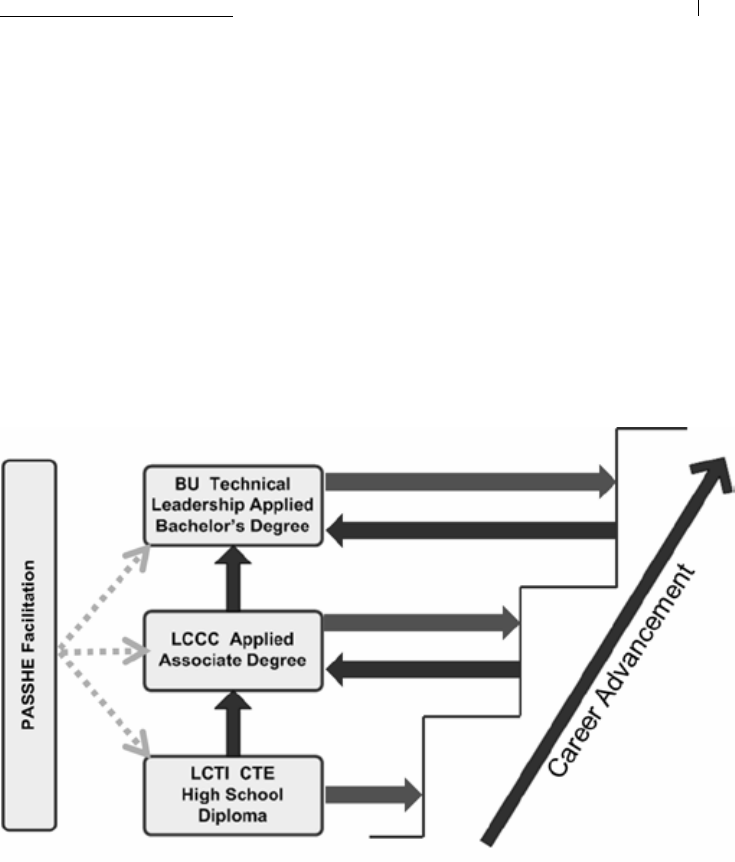
75
Manufacturing Workforce Development Playbook
The B.A.S. and PASSHE Collaborative
PASSHE Strategic Iniaves 2010 is grounded in the system’s mission to be among the
naon’s leading systems of public universies, recognized for (1) access and aordability of
excellent undergraduate and graduate educaon; and (2) responsiveness to state, regional,
and naonal needs through quality academic programs, research, and service. The Bache-
lor of Applied Science ( B.A.S.) supports the PASSHE Strategic Iniaves 2010 to transform
students and the learning environment, resources, university-community relaons, and
PASSHE’s role in determining the Commonwealth’s future.
The new degree provides educaonal opportunies with stackable skills, competencies,
and credenals. It also serves the needs of Pennsylvania’s workforce and employers. For
students, it is an aordable and exible pathway.
The Technical Leadership B.A.C. degree program is designed to build on experse ob-
tained in over 30 dierent associate degree programs at LCCC. The Pennsylvania Communi-
ty College system will serve as a linchpin for a seamless grade 9-16 educaonal pathway.
In summary, arculaon agreements are common between specic regional Pennsylva-
nia secondary and two- and four-year instuons. Pennsylvania can strive to develop and
expand these agreements statewide to facilitate degree compleon for the mobile student.
Prior Learning Assessment
Prior Learning Assessments, or PLAs, measure what a student has learned outside of the col-
lege classroom. PLA methods determine what the student knows and evaluate whether the
learning is college-level and how many college credits are equivalent for that learning. Credits
earned through PLA are closely ed to learning outcomes rather than measures of seat me.
Students who earn credits through PLA oen save me by not having to take courses
in subjects they have already mastered. Addionally, PLA assessments typically cost

76
less than a student paying tuion for the actual course or credit hour. Unfortunately for
students, the PLA is not universally available, is oen accepted in limited ways, and/or is
not accepted in transfer.
PLA Assessments make it possible for students to earn credits for prior learning through
various assessments:
• Individualized student porolios. Students are provided specic learning experiences
and outcomes from which to prepare and document a porolio equang learning to
college course(s). Faculty with specic subject maer experse can evaluate the port-
folio and determine whether credit is granted.
• Military training for college credit. The American Council on Educaon (ACE) may con-
duct these evaluaons www.acenet.edu/ ACE publishes credit recommendaons for
formal instruconal programs. Employers oen work directly with local postsecondary
instuons to evaluate the company’s training for college credit.
• Apprenceship training associated with trade associaons may evaluate training for
college credit. The Naonal Joint Apprenceship and Training Commiee (NJATC) may
work with community colleges to review credit opportunies. www.njact.org
• Customized Exams, also called challenge exams, verify end of course learning.
Standardized exams may include:
o
Advanced Placement Exams, or AP exams
o
College Level Examinaon Program Exams, or CLEP exams
A renewed focus of improving not only the access but compleon of postsecondary cer-
cates and degrees among students can benet Pennsylvania in a number of ways. These
strategies will boost working adults’ educaon and help states become more economically
compeve. In addion, employers’ demand for skilled US workers will connue to grow
over me helping employers in high demand nd it easier to compete globally. Boosng
workforce development increases regional economic development. The relaonship be-
tween levels of educaon and economic performance is becoming stronger over me.
Chapter Nine

77
Manufacturing Workforce Development Playbook

78
I
rst met Gardner Carrick when a colleague of mine and I visited the Naonal Associa-
on of Manufacturers (NAM) headquarters in Washington D.C. Gardner embraced the
message that we hoped to deliver about the need for mulple strategies for manufac-
turing workforce development. He has provided encouragement and support for many
of the eorts going on around the country, and he and I will periodically show up on the
same program or in the same meeng where this topic is being discussed.
Gardner Carrick is the Vice President of Strategic Iniaves at The Manufacturing In-
stute. He leads the instute’s research acvies, including partnerships with interna-
onally recognized consulng rms and the producon of a regular series of reports on
the issues and challenges aecng the U.S. manufacturing sector. Gardner also leads the
instute’s eorts with the U.S. military to assist transioning personnel and is responsible
for the workforce and educaon outreach acvies in several states.
Prior to joining the Instute, Gardner worked at the U.S. Department of Labor’s Em-
ployment and Training Administraon where he served as the Project Director for a $325
million iniave focusing on talent development in 39 regions across the country. The
project worked to integrate the workforce development, economic development, and ed-
ucaon strategies of a region to create the talent base required to drive economic growth.
He managed a team of more than 100 sta and consultants working on the project.
Gardner also served as the Communicaons Director for the agency. He was respon-
sible for developing outreach materials describing the programs and services oered by
the Labor Department, wring speeches for the Assistant Secretary, expanding the agen-
cy’s web presence, and managing special projects on recruing and developing talent for
the construcon industry.
Prior to joining the U.S. Department of Labor, Gardner was a Senior Associate at TATC
Consulng, a Washington D.C.-based rm focused on providing experse to federal and
state agencies on employment and educaon-related issues.
By Gardner A. Carrick,
Vice President,
The Manufacturing Institute
National Association of
Manufacturers
Many of the services that we receive are performed for us by individuals
who have obtained a certication that is given by an industry group or by
the government with oversight by an industry group. These include lawyers,
doctors, accountants, medical and dental assistants, nurses, clergy, con-
tractors, electricians, plumbers, pest control technicians, etc, etc. These
credentials indicate to an employer or to a customer that the credentialed
individual has demonstrated a level of skill and/or knowledge that qualies
him or her for the job being performed. With a few exceptions, creden-
tials have not been a requirement of working in manufacturing, although
some manufacturing segments, such as machining, do make some use of
credentials. Vocational high schools are frequently required by law to offer
an industry-recognized credential for any program of study that they offer.
A condition of receiving federal grant dollars for manufacturing education is
that the programs of study must lead to a recognized credential. It should
be apparent, given these conditions, that credentials take on a whole
new meaning for manufacturing. Manufacturers that want the educa-
tional system to support their needs will have to deal construc-
tively with the credentials issue.
Chapter Ten

79
Manufacturing Workforce Development Playbook
The presence of industry-dened credenals has been common in the economy going back
hundreds of years. Guilds of crasmen in Europe dened who could parcipate in their
occupaons and what skills were demanded. Organizaons like the bar associaon and the
medical board played similar roles for professional occupaons. As the administrave and
regulatory state grew in Western economies, some of these credenals became licenses, re-
quired by law to pracce in the eld. The success of these licenses was in ensuring dened
levels of quality for specic occupaons, parcularly those aecng public health.
For many industries though, state-regulated licenses are neither appropriate nor desir-
able. But the interest in having dened and recognized levels of quality for employees sll
exists, parcularly for those occupaons that require technical skills and where educaonal
degrees are not suitable proxies for skill aainment. These industries are where we have
seen the development and acceptance of industry-based cercates and cercaons.
Two examples are easily recognized by the general public:
1. The Naonal Instute for Automove Service Excellence created its ASE cercaon
for auto mechanics in the early 1970s to help the public idenfy competent repair
technicians. Today, the ASE logo is found in auto repair shops around the country and
is used by employers in markeng materials to signal a trusted level of quality.
2. The largest informaon technology companies like Microso, Cisco, and Oracle have
established IT cercaons for their specic products. Those companies have prod-
ucts used by millions of people, but the companies do not directly employ those who
service and maintain their products (compared to the model used by Xerox, which
oered end-to-end services with great success for several decades). To ensure com-
petence and experse of independent IT service professionals, the company created
cercaons, and in some cases academies, to train individuals. These IT cercaons
are now widely recognized and demanded by companies in the eld.
While industry-based cercaons have ourished in both mature and new industries,
they have never taken hold in manufacturing. This may seem odd because manufacturing
Chapter Ten
The Role for Industry Credentials
Manufacturing lacks industry-recognized credentials
relative to other sectors. NAM is trying to
change that.
by Gardner A. Carrick

80
is a natural candidate for such credenals in that it requires millions of employees with
technical skills. It has a lot to do with the way manufacturing companies have organized and
prepared their workforce for more than 100 years.
Manufacturing was tradionally an industry in which individual companies trained their
own workers. Young men would nd work at the local mills aer some level of secondary
schooling and enter a tradional training program. The jobs were physically demanding but
relavely unskilled, so the training programs could be very short in duraon before the men
would be put to work on the line. A much smaller percentage of young men would enter a
formal apprenceship program run by the company for skilled posions like machinists or
mechanics or electricians. These apprenceships would last several years unl individuals
became fully procient in their discipline. In all cases, individuals would expect to spend
their enre career at that company that originally trained them, so the need for a portable
or recognized cercaon simply did not exist.
This system was extremely eecve for companies large and small across the U.S. for
more than 75 years. But by the late 20th century, compeon from foreign companies be-
gan to have a sizable impact on U.S. manufacturers. Companies sought to reduce labor and
overhead costs while adopng new principles like lean manufacturing, which preached a
focus on core competency and the eliminaon of non-crical funcons. At the same me,
a more acvist federal government adopted employment policies that created obstacles
for internal training programs, especially if tesng was involved that led to selecon or
promoon. The result was that most of the formal training programs were eliminated. The
consequences of these acons were not immediately apparent.
During the rst decade of the 21st century, the U.S. lost one-third of its enre em-
ployment base in manufacturing, more than 6 million posions in total. This meant that
experienced labor was readily available for companies that were hiring. But it was also
around this me that manufacturing jobs began to change. The widespread adopon of
automaon and robots and the integraon of informaon technology all but eliminated the
unskilled posions in manufacturing and greatly changed the skill sets required for skilled
posions. The exisng workforce developed these new skills in tandem with the changes to
the industry, but there no longer existed either a pipeline of new entrants into the industry
or a system to train those entrants in the advanced technical skills now required in the
industry. The talent supply chain did not exist to respond to an increase in demand.
Policymakers, educaon ocials, and even the general public were not overly concerned
because it was assumed that U.S. manufacturing was irreversibly declining. This was
not enrely true, as total output connued to grow, but certainly the number of jobs in
manufacturing was on a steady decline and comparisons to agriculture were oen heard.
But beginning in 2010, a conuence of events, including rising global costs and risks, and
signicant energy nds in the U.S., began a resurgence of American manufacturing. Jobs
in manufacturing in the U.S. have increased for four consecuve years for the rst me
since the 1960s, and manufacturers everywhere are complaining of signicant shortages of
qualied applicants for skilled posions.
Unfortunately, manufacturers are unable to simply restart the apprenceship and
Chapter Ten

81
Manufacturing Workforce Development Playbook
training programs that were eliminated in years past. The experse to run such programs
has been lost, and the cost to run them is prohibive for most companies under constant
global compeon. Community colleges and technical schools are now lling that void. In
addion to the many exisng programs across the country, several hundred million dollars
have been awarded from the U.S. Department of Labor to expand and improve manufac-
turing educaon oerings. This includes tradional programs like welding and machining
and newer programs like mechatronics that combine the disciplines of mechanical systems,
electronic systems, logic controls, and others into an interdisciplinary approach needed
parcularly for industrial maintenance posions—maintaining and servicing the robots and
machines that replaced unskilled posions.
As manufacturing educaon and training programs are now being conducted by third par-
es, the need to ensure a consistent level of quality emerges. This is a natural opportunity for
widespread adopon of industry-based credenals, and it is where the Naonal Associaon
of Manufacturers (NAM) and The Manufacturing Instute are making a signicant impact.
The Manufacturing Instute is the educaon and training aliate of the Naonal Asso-
ciaon of Manufacturers and has been charged with improving manufacturing educaon
programs across the country to solve the skills gap that manufacturers face. The primary
means of accomplishing this goal is through the NAM-Endorsed Manufacturing Skills
Cercaon System.
Ancipang the need for an industry-recognized set of credenals, in 2008, The Manu-
facturing Instute reviewed every cercate, cercaon, and credenal related to man-
ufacturing educaon and evaluated them against a set of criteria. Were those credenals:
1) naonally portable, 2) industry recognized, 3) third-party validated, and 4) data-driven?
Aer applying these criteria, the instute idened 15 organizaons that met that standard
of quality and, through NAM, endorsed their credenals. The goal of this approach was to
bring order to a chaoc credenal market. Now, manufacturing companies would know
which credenals were backed by quality processes and could have condence in the skill
levels of individuals possessing such credenals. And since many of these credenals are
“stackable,” companies can use them across a range of higher-level occupaons, and em-
ployees can use them to advance in their careers.
For any industry-based credenal to be useful though, it requires both a crical mass of
individuals possessing such credenals and a crical mass of employers recognizing and
preferring such credenals in their hiring and human resource pracces. The Manufac-
turing Instute chose to begin this process by focusing on the supply side, specically
community colleges and technical schools. If the tradional manufacturing educaon pro-
grams like machining and welding at those schools could begin to oer the NAM-Endorsed
credenals, that would raise the quality and consistency of those programs and quickly
increase the number of individuals possessing such credenals.
Fortunately, the work done by The Manufacturing Instute was occurring at a me when
major foundaons in the educaon arena were seeking to improve the quality of programs
and redene the measures of compleon. The instute was able to obtain early nancial
support from the Bill and Melinda Gates Foundaon and the Lumina Foundaon for Edu-

82
caon to fund the integraon of NAM-Endorsed credenals into tradional manufacturing
educaon programs at community colleges. Students would now earn credit toward an
associate degree while simultaneously earning one or more industry credenals from the
NAM-Endorsed list.
The early success of this approach in raising the quality and consistency of manufacturing
educaon allowed the instute to work with the U.S. Department of Labor to make the
use of NAM-Endorsed credenals a requirement for any instuon seeking grant funds for
manufacturing educaon. From four original community colleges in 2009, there are now
more than 200 schools oering the Skills Cercaon System as a standard part of their
programs. And in 2013, more than 115,000 cercaons were awarded naonwide.
The rapid success in building the supply side of the industry-based credenal market
now allows The Manufacturing Instute to focus on the demand side of the market. As
discussed above, manufacturers have no history with industry-based credenals and have
been cauous in adopng them across their workforce. But ongoing, signicant challenges
in aracng qualied applicants for available posions connue to plague the industry.
This has led individual companies in regions across the country to begin working with their
educaon partners and asking for NAM-Endorsed credenals. It has also enabled The Man-
ufacturing Instute to move beyond support from educaon foundaons to direct funding
from the industry to expand industry-based credenals, including General Electric and the
Alcoa Foundaon. But more is required from manufacturers to reach a crical mass of
parcipaon where industry-based credenals can become an enduring standard in the
manufacturing sector.
The shiing of responsibility for training the future manufacturing workforce from com-
panies to schools sll requires the parcipaon of manufacturers. Manufacturers must
recognize that schools may not apply federal grant funding to programs where credenals
are not available and oered. In many states, credenals are also required by law to be
oered for most high school career and technology programs. Manufacturing segments
that choose to sit out the credenaling process will nd funding and programs being
diverted to other segments. From acvies as simple as asking those schools to oer
industry-based credenals to providing internships to students who earn those credenals,
manufacturers’ involvement with the training providers is crical to the long-term success
of this arrangement. NAM connues to promote the Skills Cercaon System to its mem-
bership, and The Manufacturing Instute partners with state and local associaons to reach
a wider audience of manufacturers.
Through industry-based credenals, the manufacturing sector has the opportunity to
elevate and standardize the educaon programs oered by community colleges and tech-
nical schools across the country. Credenals also carry a presge that conveys respect on
both those individuals who have earned the credenal and the occupaons that demand
it. Building an eecve talent supply chain for technical careers requires industry-based
credenals, and the NAM-Endorsed Manufacturing Skills Cercaon System is the soluon
for the U.S. manufacturing industry.
Chapter Ten

83
Manufacturing Workforce Development Playbook

84
I
have worked with Maria Ferrante since the early days of the OMAC Packaging
Workgroup when Maria chaired the PackLearn Commiee, helping to educate
the workforce on the vocabulary associated with the emerging use of coordinated
axis moon control. Maria and I shared the experience of 9-11 in Las Vegas and
opted to connue with a meeng that we had planned for that day, determined not
to let whomever was behind that tragedy interfere with progress.
Maria has spent 20+ years researching, wring about, and engaging with the
packaging and processing industry. As Vice President of Educaon & Workforce
Development at PMMI, she works with industry and academics on programs to
develop a qualied, skilled workforce for the packaging and processing sup-
ply chain. Since taking over PMMI’s educaon eorts, Maria has iniated eorts
such as PMMI’s Mechatronics Cercate program, eLearning technical training
courses, and JumpStart, which is PMMI’s latest outreach to educate, engage, and
excite youth about careers in packaging and processing. You can reach Maria at
mferran[email protected]
Maria Ferrante,
Vice-President Education
& Workforce Development,
PMMI, The Association for
Packaging and Processing
Technologies
As pointed out in the preceding chapter, few credentials have been avail-
able for manufacturing, especially in certain segments. With industry-rec-
ognized credentials assuming more importance with regard to educators’
ability to offer programs and obtain grant funding, and with PMMI’s mem-
bers seeing the workforce crisis in America affecting both themselves and
their customers, PMMI decided to do something about it. For advanced
machines to be successfully deployed in manufacturing, manufacturers
must have the skill sets necessary to operate and support those
machines. To address these issues, PMMI embarked upon creation
of a suite of stackable credentials aimed at the needs of their
members’ customers—the hybrid manufacturing segment.
Chapter Eleven

85
Manufacturing Workforce Development Playbook
T
he Challenge
PMMI’s role in supporng and encouraging packaging educaon dates back to 1966
when the associaon recognized the importance of developing a constant pool of new tal-
ent to support innovaon in this dynamic industry. Throughout the years, PMMI’s support
of educaon and workforce development has taken on many shapes and forms—from
oering scholarships and grants to providing educaonal books and materials to now devel-
oping e-learning courses, mechatronics credenals, and so-skills training. As the industry
landscape has changed and PMMI’s focus has expanded, PMMI’s educaonal oerings have
evolved with it.
In 2008 as the economy took a downturn, the industry began to feel the shortage of
skilled labor, and the pressure to develop new talent mounted as many of the more ex-
perienced workers began preparing for rerement. Most manufacturers were focused on
making product, and too few invested in any type of knowledge management system to
capture the experse that was potenally walking out the door. To compound the situaon,
manufacturers began to add automaon to their packaging and processing lines, but they
were discovering that the next generaon of workers did not have the right skills to support
the new technology.
Manufacturers have told us the lack of skilled, qualied workers connues to aect
their ability to maintain producon schedules, restricng their ability to expand opera-
ons. More than 82% of manufacturers report a moderate or serious shortage in skilled
producon workers. More than 75% of manufacturers say the skills shortage has negavely
aected their ability to expand.
And it appears this shortage is not improving. When manufacturers were asked what
they expected over the next three to ve years, 69% expect the availability of skilled pro-
ducon workers to worsen, according to the Naonal Associaon of Manufacturer’s Skills
Gap Report. Manufacturers also expect a greater challenge in hiring engineers, with 45%
of companies expecng fewer qualied applicants. Manufacturers of all sizes feel the pain.
PMMI heard this challenge from both its member companies—packaging and processing
equipment manufacturers and technology providers—as well as the end-user (consumer
by Maria Ferrante
PMMI’s Mechatronics
Certification Program
PMMI has stepped up to create credentials for
manufacturing where none existed.
Chapter Eleven

86
packaged goods manufacturers) community it serves. This lack of skilled workers and the
challenge to idenfy them led PMMI to look at the situaon closely to see if we could help.
Why mechatronics?
In 2008, PMMI teamed up with the Mid-Atlanc Mechatronics Advisory Commiee (MA-
MAC), an industry group represenng end user and equipment manufacturers that’s head-
quartered in the Lancaster, PA, area. Joining this eort were PMMI member companies and
professors from several PMMI partner schools to address this issue.
The group met at Purdue University Calumet where we discussed the skills shortage and
began to formulate a plan to address it. The group discussed the types of skills needed
according to the dierent types of workers (i.e., operator, maintenance mechanic, machine
designer, etc.). The group looked at work that was done by the Naonal Center for Integrat-
ed Systems Technology (NCIST) through a U.S. Department of Labor grant, and used this as
a rst step to idenfy the skills required in the packaging and processing industry.
As the group eshed out the skill sets, we determined that mechatronics was the best way
to describe the complete set of skills. The group agreed on the following denion of mecha-
tronics: Mechatronics is the synergisc applicaon of mechanical engineering, electrical
engineering, controls engineering, and computer science to create useful products. It is a skill
and knowledge set used by mechatronics engineering technicians to assure the automaon
that drives modern manufacturing delivers its potenal for higher producvity and output.
We idened 23 skill blocks that could be handled as stackable credenals and that are
needed in manufacturing from the operator level up to the engineering technologist level.
(See chart on page 91)
What are the PMMI Mechatronics Certificate Tests?
Based on the original work done in 2008, PMMI took a leadership role in developing skills
standards customized for the hybrid manufacturing space where the majority of packaging
and processing companies operate. A professional test development rm, McCann Asso-
ciates, was hired to assist with the process of developing fair, balanced, industry-driven,
third-party-validated tests. In 2009, work began to develop the Level 1 tests, which include
some of the base skills required by virtually all manufacturers.
One of the challenges we faced was diversity within the packaging and processing indus-
try. Machinery builders need one set of skills, end users of packaging equipment have a
dierent set of needs, while technology providers have their own needs. Even within orga-
nizaons there are dierences. For example, a machinery manufacturer needs engineers to
design and develop equipment but also needs service technicians with skills like those of
industrial maintenance mechanics at end-user companies. As more PMMI member compa-
nies are being asked to act as system integrators, mechatronics skills increase in impor-
tance. In addion to core technical knowledge, these maintenance and service technicians
need to know how to troubleshoot.
In an aempt to develop a credenaling program that would be meaningful and adapt-
able to the packaging and processing industry, it was decided that this cercate system
Chapter Eleven

87
Manufacturing Workforce Development Playbook
should be modular in nature—meaning a professional working in the eld would take only
the tests pernent to their posion. They could add on addional cercates as needed
and as their job responsibilies increased.
PMMI recruited subject-maer experts from industry as well as educators to help
develop each test. The rst test, Industrial Electricity 1, was launched in April 2010. The
detailed competencies for this test are published on the www.pmmi.org website, and
curriculum developers around the country are able to use these competencies to develop
consistent and rigorous training that the packaging, processing, and other manufacturing
industries are seeking.
This partnership between PMMI, industry, and educators has played a signicant role
in the success of this program. Several of PMMI’s partner schools are working to build
these tests into their curriculum. To help in this process, we have extended discounted
educaonal pricing to these schools to make it easy and cost-eecve for them to oer
the tests to all students.
Where are we now?
Currently PMMI has completed ve of the 23 tests originally idened and connues the
test development process year-round. All tests are available online, and all competencies
are published at www.pmmi.org/mechatronics.
Mechatronics Cercate Tests Now Available Online:
• Fluid Power 1
• Industrial Electricity 1
• Industrial Electricity 2
• Mechanical Components 1
• Programmable Logic Controllers (PLCs) 1
We are also developing a hands-on test to complement the suite of Level 1 core compe-
tencies (Fluid Power 1, Industrial Electricity 1, Mechanical Components 1, Programmable
Logic Controllers 1). This hands-on test is expected to be available later in 2014 and is in
direct response to industry requests for a tool to evaluate not only skills and knowledge but
also the ability to apply skills and knowledge to real-life scenarios.
PMMI’s Mechatronics Cercate program has been added to The Manufacturing Ins-
tute’s Manufacturing Skills Cercaon Systems (SCS) oerings. The Manufacturing Ins-
tute is a 501(c)(3) aliate of the Naonal Associaon of Manufacturers (NAM).
The Manufacturing Instute established SCS to develop the naon’s science, technology,
engineering, and math (STEM)-capable workforce for advanced manufacturing. Among the
goals of the partnership with PMMI are:
• To align these naonally portable, industry-recognized credenals with educaonal
curricula and pathways in grades K-12, and in community colleges’ and four-year colleges’
programs of study, that lead to high-wage, high-growth technical careers.

88
• To provide informaon on these educaonal pathways that lead to advanced manu-
facturing or automaon career pathways, to help connect students and workers to lifelong
learning and advancement opportunies.
• To ensure that advanced manufacturing employers and automaon professionals rec-
ognize the value of these credenals in their recruitment, screening, and hiring processes
by recognizing, preferring, or requiring naonally portable, industry-recognized credenals.
In 2009, PMMI’s skill standards for mechatronics were added to the Competency Model
Clearinghouse of the U.S. Department of Labor (US DOL). www.careeronestop.org.
The U.S. Department of Labor published a hybrid-industry, packaging-oriented mechatron-
ics competency model that may be used by industry, government, and educaon to provide
guidance on the skills for a mulskilled technician in a world-class packaging facility.
PMMI worked closely with MAMAC, the Industrial Maintenance Training Center of Penn-
sylvania, the Lancaster County Center of Excellence in Packaging Operaons, and a consor-
um of schools involved in packaging and/or mechatronics educaon to create this model.
Where are we going?
PMMI’s Mechatronics Cercate Program connues to grow and expand. We are always
looking for industry professionals to help with test development. We are currently working
on the test for Motors and Motor Control and plan to begin work on Mechanical Compo-
nents 2 and PLCs 2 later this year.
We are also working with schools around the country to educate them about the pro-
gram and encourage them to develop curriculum to prepare students for these tests.
In northwest Indiana, educators at Purdue University Calumet are making the corpo-
rate-collegiate connecon and implemenng a $2.74 million U.S. Department of Labor
(DOL) Trade Adjustment Assistance Community College and Career Training (TAACCCT)
grant. The grant, which supports training for displaced workers, requires parcipants to
earn a naonally recognized credenal, and Purdue University Calumet has chosen PMMI’s
Mechatronics Cercates for similar credenals.
With this grant, PUC will provide cung-edge training to northwest Indiana residents
who are eager to ll important jobs and make valuable contribuons to the region. The TA-
ACCCT grant and the integraon of PMMI’s Mechatronics Cercate program will support
training for more than 300 individuals as mechatronics technicians and industrial machin-
ery mechanics.
Addional schools in other states such as Florida, Pennsylvania, Washington, Minnesota,
Wisconsin, and Illinois are working to build the PMMI Mechatronics Cercates into their
curriculum, some with assistance from other TAACCCT grants.
Lastly, PMMI is working in partnership with the Industrial Maintenance Training Center
of Pennsylvania and the U.S. Department of Labor to establish Naonal Apprenceship
Guidelines for mechatronics technicians based on the PMMI Mechatronics Cercates.
Once nalized, these guidelines will be available to help employers create apprenceships
and internships to develop the next generaon of skilled workers.
Chapter Eleven

89
Manufacturing Workforce Development Playbook
What does this mean for you?
Through a series of assessments that are based on industry-developed competencies,
PMMI’s Mechatronics Cercate program helps you advance the skills of your team. The
tests assess your workforce for the core technical skills and real-world applicaon needed
in today’s manufacturing environment. PMMI’s Mechatronics Cercates are recognized by
the U.S. Department of Labor and endorsed by the NAM’s Skills Cercaon System.
These tests allow both new and incumbent workers—entry-level operator through tech-
nologist—to demonstrate the skills needed for high-growth, technology-intensive manufac-
turing jobs. Mechatronics cercate tests are ideal for industrial maintenance sta and can
provide many benets to your workforce:
These cercates help workers:
• Improve skills
• Stay compeve
• Advance in their career
• Test and validate their knowledge—parcularly helpful to those reentering the work-
force or transioning from a military to civilian workforce
Get your workers the training they need to ll your crical manufacturing posions—and
retain those workers!
Employers can benet from using these cercates as a hiring and career advancement
tool. We encourage employers to use our cercate program as an incenve to reward
individuals who master new skills. This helps employees overcome their resistance to
change and keeps them excited about the inux of new equipment or new technology
coming into the workplace. Moreover, giving employees recognion, nancial rewards, or
other benets for compleng cercate tests can be a powerful incenve for them to stay
with your company. Employees are more likely to stay when they have tangible evidence
that their experse is appreciated. The results will become obvious. Your company will have
beer-trained, more-experienced employees and lower employee-turnover expenses.
There are many ways that manufacturers can integrate the PMMI Mechatronics Cer-
cate program into exisng human resource pracces:
• Use the program to screen individuals during the recruing and hiring process to help
priorize the applicant pool.
• Inform current employees about the value of connuing educaon using the pro-
gram, encourage parcipaon to build their skills, and help qualify them for advance-
ment opportunies.
• Add language to job posngs to highlight your desire to hire workers who have passed
industry-recognized skills assessments.
• Incorporate the tests into the performance appraisal process as an objecve way to
measure technical strengths and weaknesses.

90
Workers in transion who earn the PMMI credenal can gain a compeve edge,
strengthen their ability to be mobile in the workforce, and compete for higher-level jobs
and move to in-demand careers.
Finding eecve training for the skills is starng to get easier. PMMI connues to develop
a network of schools that we know prepare students for our tests, and we connue to
grow this network all the me. One of the best ways for you to make sure your workers are
geng the training they need is to partner with local technical schools and colleges. PMMI
has a list of mechatronics partner schools on our website, and we can also help you assess
whether or not a school has a program that meets your needs—just contact us. We are
also willing to help bring a school up to speed on our cercate program and the steps they
need to take to develop the right curriculum. Let us know, and we will reach out.
How you can help
PMMI’s Mechatronics Cercate tests are a reecon of industry needs—and can only
grow and develop through acve industry parcipaon. We know that the development of
the technical workforce is a common problem across all manufacturing—whether you are a
large consumer packaged goods company or a mid-size machinery manufacturer. Working
together we can connue to develop these tests, use them as a hiring and advancement
tool, educate schools that we work with about the cercates, and encourage them to
build these tests into their training programs.
If you are interested in working with PMMI on this important iniave, contact Stephan
Girard at sgirar[email protected] or call 571 612-3196.
Chapter Eleven
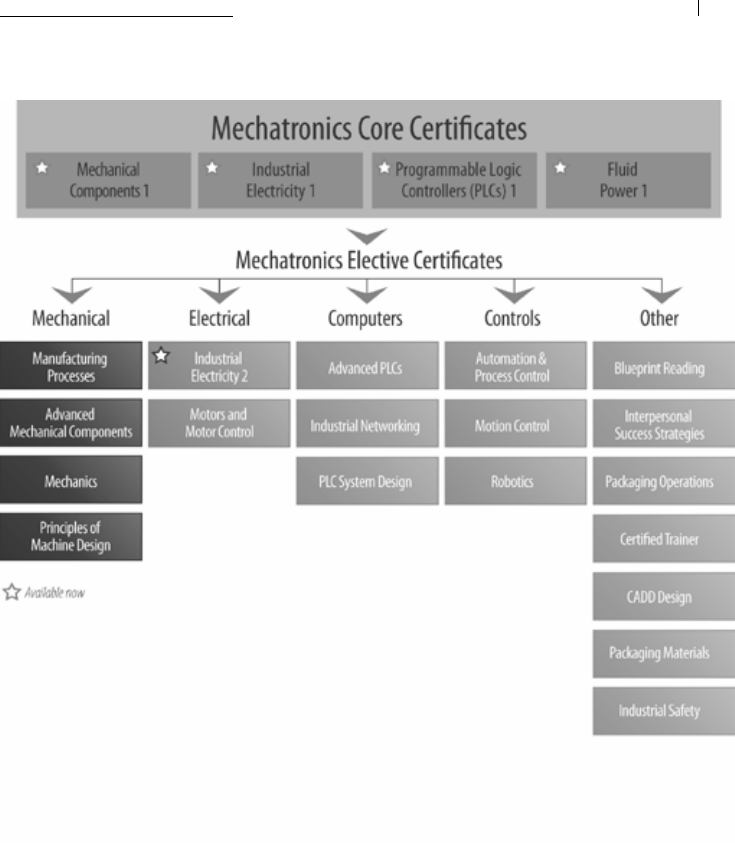
91
Manufacturing Workforce Development Playbook

92
Mike Aroney,
Director of Operations,
Impact Recon
A
s the ow of the Playbook developed, I realized that we needed to include a chap-
ter on bringing vets into the workforce. One day, out of the blue, an e-mail showed
up in my inbox with a proposal to get the word out about the veteran’s suitability
for jobs in maintenance and reliability. I must admit that I had never heard of the Society
for Maintenance and Reliability Professionals, but as we dug into it further, it looked like
a great opportunity. Industrial maintenance technicians and CNC machinists have been
idened in some areas as the most in-demand occupaons for manufacturing. Vets
come out of service with a lot of maintenance experience, and Mike Aroney seemed like
the right person to tell this story.
Mike rered from the United States Navy in 1994 aer a career ying the F-4 Phan-
tom and F-14 Tomcat. He is a graduate of the Naval Fighter Weapons School (TOPGUN)
and the Italian Naval War College. Immediately upon rering, Mike served as Associate
Director of Organizaonal Development and Deputy Director of Corporate Planning for
the Navy Exchange Service Command, a Fortune 500 retail company. Mike le NEXCOM
in 2000 to become Director of Change Management for Naval Sea Systems Command’s
ve-year maintenance and reliability process reengineering project called NEMAIS (Navy
Enterprise Maintenance Automated Informaon System). In 2004, Mike joined Life Cycle
Engineering, a manufacturing and engineering consulng company, as Director of Op-
eraons and then Manufacturing Maintenance & Reliability Principal, where he led the
leadership and change management pracce. He joined Allied Reliability Group in 2008
as a Manufacturing Maintenance & Reliability Principal and then Director of Operaons
of its talent acquision business unit—IMPACT RECON—in 2013.
In this role, he has worked in over 100 plants around the world in mulple industry
vercals. As Director of Operaons for Allied Reliability Group’s Talent Acquision busi-
ness unit, Mike guided his team to idenfy and nd talent to meet the maintenance and
reliability needs of the manufacturing industry in North America. His specic interest was
in matching up the talent brought with the service men and women transioning from
the military to ll these manufacturing posions.
Mike is also an adjunct Professor of Management for Cambridge College, and Faculty
Academic Advisor and adjunct Assistant Professor of Aeronaucal Science for Embry-Rid-
dle Aeronaucal University. He is a 1977 graduate of Columbia University, and holds ad-
vanced degrees from Old Dominion University and Embry-Riddle Aeronaucal University.
Mike resides in Charleston, SC, with his wife Kathy and three of their ve children, and he
enjoys bird hunng, y shing, kayaking, and gardening.
The last couple of years has brought special focus to the importance of
employing our returning veterans. Many of these vets have served as
skilled technicians, operating under extreme pressure in their military roles
and have demonstrated the ability to perform under pressure. However,
they lack information on the availability of manufacturing jobs. They may
be unfamiliar with the language of manufacturing, and the technical lan-
guage that they have used in manuals and system documentation is unlike
that used in industry. There are opportunities for dramatically reducing the
length of the educational pathway for these veterans by simply looking at
the gaps between their skills and the skills required in manufacturing
and focusing on them. The following chapter shares stories of
successful transitions from the military to manufacturing.
Chapter Twelve

93
Manufacturing Workforce Development Playbook
I
n July of 2013, I was at a Hire America’s Heroes conference in Alameda, CA, speaking
to veterans and high-level service members about men and women from the military
nding work in manufacturing, specically in the maintenance and reliability industry. Aer
explaining that the 12 dierent manufacturers that I represent were looking to hire indi-
viduals with experience xing equipment and prevenng future failures, a surprised Coast
Guard Command Master Chief asked me if the veterans need to get a college degree for
these jobs. He thought—like so many higher-ups in the military—that transioning service-
men need a college degree to compete for any jobs in the civilian sector.
I described to the crowd the role of a reliability engineer—how he or she is responsible
for keeping the plant and its equipment running to achieve producon objecves—to
which the Master Chief exclaimed, “That’s what my guys do everyday! I had no idea these
opportunies existed.”
There are thousands of qualied veterans who worked as maintenance technicians or
reliability engineers in the service xing aircra carrier equipment or combat vehicles, and
there are hundreds of thousands of open posions in manufacturing for skilled workers. But
these jobs are hard to ll, and the veteran unemployment rate remains high. With the skills
gap in the manufacturing sector in the U.S., I believe it is imperave that we connect veterans
to these jobs. Manufacturers are looking to ll these posions with experienced veterans,
but service men and women are unaware of these jobs. We must enable veterans to move
quickly into these roles rather than leave it up to chance at military job fairs.
The U.S. Manufacturing Skills Gap
Fewer and fewer young people are pursuing careers as “skilled workers” or workers that have
the specic knowledge to ll a trade or cra job such as a maintenance technician or plant
engineer. Our high schools and colleges deglamorized trades and put an emphasis on earning
a four-year university degree. While there is certainly value in earning a degree, trade skills
have fallen by the wayside, and young people, for the most part, simply are not looking into
these types of jobs. There are hundreds of training and cercaon programs that young peo-
ple could pursue in addion to a college degree, but they do not receive the proper aenon.
Veterans—One Solution to the
American Manufacturing
Skills Gap
Translating skills learned in the military
to manufacturing.
by Mike Aroney
Chapter Twelve

94
A report by the Organizaon for Economic Cooperaon and Development showed that
America’s labor force is falling behind the rest of the world when it comes to skill level. Ac-
cording to the study, “Countries with lower skill levels risk losing in compeveness as the
world economy becomes more dependent on skills.” The report summary goes on to note,
“Of the three skills domains, and comparing the U.S. with other countries, the U.S. perfor-
mance is weak on literacy, very poor on numeracy, but only a lile worse than average on
problem solving in technology-rich environments. Broadly speaking, the weakness aects
the enre skills distribuon, so that the U.S. has proporonately more people with weak
skills than some other countries and fewer people with strong skills.”
This lack of skilled workers aects manufacturers’ ability to properly sta their facilies.
A survey by the Manufacturing Leadership Council reported that 27% of manufacturing
companies have diculty nding workers for producon and operaon in North America.
According to the council, this concern will persist in the future: “Looking ahead ve to 10
years, however, the percentage of respondents expecng a high degree of diculty in
aracng talent in North America jumps to 35.9 percent.”
Employers have been complaining for years about not being able to nd enough skilled
workers. It’s nothing new that manufacturing companies are struggling to ll posions
with skilled workers or that these posions are somemes going unlled, but this lack of
trained workers is only going to get worse. More and more companies are building plants
in the U.S. in order to simplify and cut cost on their supply chains, increasing the number
of facilies in the country. At the same me, the Baby Boomer populaon, whose members
currently ll many roles in manufacturing, is set to rere in the next ve years. There are
thousands of open posions now, and the expectaon is for that to increase 100-fold.
The Demand for Maintenance and Reliability Professionals
As a recruiter for manufacturing companies, I noced over the years that employers are
not familiar with the enre sector of maintenance and reliability, but they acknowledge its
importance and its absence from their operaons. Employees with a background in mainte-
nance and reliability (M&R) are skilled in xing equipment and machinery, but they’re also
good at monitoring this equipment to prevent future failures and planning to x something
when there is a failure. By focusing on reliability, manufacturers have a safer plant with few-
er incidents and a more producve facility because assets are performing at the best possi-
ble level. Years ago I joined GPAllied as a consultant, helping companies improve producon
and get materials out the door to consumers. These manufacturers began to talk about
the need for skilled workers with experience in maintenance and reliability, and out of this
demand, the recruing division of GPAllied was created. GPAllied bought a headhunng
company, which became Impact Recon, to specialize in nding these skilled workers. Over
the past two years, Impact Recon established its ability to nd talent for North American
manufacturers and is now Allied Reliability Group’s talent acquision arm.
Companies were all saying the same thing: they were starng to see the importance of
maintenance and reliability technicians, and they realized that they didn’t have employees
with these skill sets. They didn’t have employees who could not only repair equipment but
Chapter Twelve

95
Manufacturing Workforce Development Playbook
also monitor its eciency and predict future failures. They realized that their operaonal
standards did not match the most highly regarded best-pracce metrics as set by the Soci-
ety for Maintenance and Reliability Professionals (SMRP), but they did realize the need to
hire these types of workers.
It is in a company’s best interest to hire workers who keep equipment running at opmal
levels and improve producvity. I worked as an M&R professional consultant in the civilian
sector for the past 18 years, helping manufacturers improve their asset reliability. Since
the late 1990s, best pracces have been implemented in the eld of asset reliability that
directly translate to reduced operang costs and increased capacity. If the equipment is
broken, it isn’t producing, and it costs more money to x it than it does to keep it running.
Organizaons like SMRP provide best pracces and professional standards to help compa-
nies standardize their pracces and improve asset reliability, and it is necessary to have a
reliability engineer around to implement best pracces and avoid equipment failures.
Maintenance & Reliability in the Military
The military service is an ideal place to learn physical asset management skills. Aer I rered
from the navy, I connued to work with the military helping to implement the Navy Enter-
prise Maintenance Automated Informaon System (NEMAIS), which supported the restruc-
turing of the forces in the early 1990s to combat terrorism through a rapid strike force. An
important part of this iniave was reducing waste and cycle mes for repairing the navy’s
ships. If equipment was broken, then it wasn’t producing, and the military was losing money.
One of the main problems was that there were numerous departments and oces that
were not communicang or coordinang. Maintenance would show up to x or perform
maintenance tasks on a ship, cut the side of the hull, complete their task, and then seal up
the side of hull, only to have another crew stop by shortly aerwards to x a part in the
same area of the ship and once again cut into the side of hull. Coordinaon was a nightmare.
Aside from the oor of a manufacturing plant, there is no beer place to learn about
maintenance and reliability than in the service. From experience, I can say the military
does not always have the best maintenance programs, but through working in the service,
veterans learn how to improve these programs and what mistakes to avoid. Working with
NEMAIS, I worked to coordinate thousands of tasks by implemenng reliability processes
and using condion-based maintenance (instead of me-based) to more accurately plan for
equipment malfuncons and failures.
Navy veteran Darrin Wiko, who currently works as a senior technical advisor with
Allied Reliability, created his career through his experience in the navy. As a machinist
mate second class in submarine warfare for nine years, he was responsible for the coordi-
naon of nearly 50 electrical and mechanical technicians and the execuon of prevenve
maintenance on navy submarines. Using a new prevenve maintenance roune, he saved
the navy over $300,000 annually in shipboard maintenance and was awarded a Navy
Accommodaon award.
Aer rering from the military, Wiko earned a maintenance posion with an oil and
gas drilling company by helping them idenfy potenal problems in one of their factories.

96
Using knowledge from his me in the service, he walked the oor of the plant with his po-
tenal employer and pointed out maintenance deciencies and was later hired on as their
technical consultant.
The Veterans’ Struggle
Finding a job, much less nding gainful employment, has been a struggle for veterans in
recent years. In the past ve years, veterans have struggled more than the average popula-
on to nd jobs and build their careers out of the service. This struggle has been parcular-
ly dicult for young veterans age 18 to 24. The Bureau of Labor Stascs showed that the
unemployment rate for this group averaged 20% in 2012. The civilian rate for the same age
group was 15% during the same period. This disparity has been consistent over the past
ve years.
Veterans are not prepared to enter the civilian world, and their military leaders are ill-
equipped to help them nd work in the civilian sector. Skills learned in the service oen do
not match up with civilian job requirements, even though veterans are oen very qualied.
The problem is military job descripons do not match with the civilian sector job descrip-
ons, and employers do not know how to interpret military skills and experience. The
military also does not train soldiers to leave the service and build careers outside of the
military. It’s not interested in spending millions of dollars to prepare soldiers for a civilian
career. It’s interested in training soldiers and keeping them in the service. Superiors in the
military also are not necessarily qualied to help vets nd jobs, because they’ve been in the
service themselves for so long. Someone who has made a career in the military does not
have the best advice on building a career outside the military.
Consequently, most veterans are being told that they need to get a college degree to
compete in the workforce, but there are other—oen beer—opons, such as training or
cercaon programs. The Coast Guard Command Master Chief at the Hire America’s Hero
conference was telling his men that they needed a college degree because he was told that
a college degree was the best opon for veterans. While a college degree would certainly
improve a veteran’s career, going back to school for four years is oen not an opon for
these men and women, who oen already have families.
In the early 1990s, Alan Knight rered from the army where he worked as a mechanic, re-
pairing electrical and turret systems on M1 Abrams tanks, and struggled to nd work before
seling for a job as a truck mechanic making $6.50 an hour. Working as a civilian mechanic,
he had to take on a second job, and his wife had to get a job, just to have the same income
as when he was in the military. He was told that he should get a college degree, but like so
many other veterans, going back to school was not a feasible opon when he needed an
income immediately.
Many veterans qualify for open posions in manufacturing already, and a cercaon or
training program would validate their skills. SMRP oers two cercaon programs—the
Cered Maintenance and Reliability Professional (CMRP) and the Cered Maintenance
and Reliability Technician (CMRT)—that comprehensively cover a wide variety of mainte-
nance and reliability topics and show employers which candidates are the most qualied.
Chapter Twelve

97
Manufacturing Workforce Development Playbook
Alan Knight Darrin Wikoff
Cercaon programs are more aordable and take less me than geng a degree from a
university. Veterans could also get a cercaon, start working, and plan to aend college
down the road. The Department of Veterans Aairs also actually reimburses the cost of the
CMRP exam, and the Society oers the exam at a discounted price to veterans.
The Role of Veterans
Alan eventually found a job as a plant maintenance mechanic, started a career in reliability
as a vibraon analyst, and built a career in reliability engineering. Alan and the hundreds
of other veterans who worked with machinery or ran maintenance programs on combat
vehicles or aircra carriers are perfect addions to manufacturing companies looking to
increase producvity. I know of at least 20 companies in food and beverage, metals, phar-
maceucals, mining, packaging, pulp and paper, housing material, and automove sectors
looking for these addions.
More important than their experience, veterans assimilate and adapt quickly, learn fast,
and think on their feet to troubleshoot and solve problems. And they are used to pung
in long days when necessary. They also know how to use and leverage the latest technolo-
gy. They have a great work ethic, are predictable, team-oriented, and focused on the mis-
sion. They have been trained to maintain sophiscated equipment in harsh condions and
keep it running to achieve a common objecve. Veterans are leaders. They quickly move
into supervisory posions and thrive.
The problem is that while companies are looking for veterans with M&R skills, veterans
are unaware of these job opportunies. I believe that educang veterans about these jobs
is a crucial step toward decreasing veteran unemployment and solving the skills gap crisis in
the manufacturing industry in the U.S.

98
Bonnie L. Spayd,
Director of Business &
Industry Programs,
Reading Area
Community College
W
hen you want advice on how to do something, the best advice comes
from someone who has been successful at doing it. Bonnie runs one of
the most successful industrial maintenance, mechatronics, and manufac-
turing programs that I have come across at the community college level. It was for
that reason that I asked her to write a chapter on how manufacturers and educators
can work together to solve the manufacturing workforce crisis.
Bonnie Spayd is currently employed as the Director of Business & Industry Pro-
grams for The Schmidt Training and Technology Center at Reading Area Community
College. In her posion, she is responsible for developing and delivering a con-
nuum of credit and noncredit programs specically in workforce development,
business, industrial maintenance, mechatronics, machine tool, and informaon
technology geared to local and regional business and industry, to dislocated, under-
employed workers, and to credit-seeking students. She is the credit advisor for the
AAS in Mechatronics Engineering Technology. Prior to joining RACC’s sta, Bonnie
worked in business development for The Manufacturers Associaon of Berks Coun-
ty, in engineering/quality control/quality assurance/sales and markeng commu-
nicaons for a safety products manufacturer, and in producon and supervision
for a pharmaceucal reagent manufacturer. She holds a BS and MEd in Biological
Science from Kutztown University.
Chapter Thirteen
There are scattered about the country some outstanding examples of
how the strategies discussed above have been put to work to develop
education and training programs that meet the needs of students and
manufacturers. This chapter looks at one such successful program to
show what industry, education, and government can accomplish. This
program was initiated to ll a skills gap in the incumbent workforce of a
group of consumer products companies. It has since grown to include
programs for multiple manufacturing segments, serves students coming
through multiple pathways, and has served over 100 companies. Not only
does this chapter provide great recommendations for educators,
manufacturers, and government—it also provides some insight into
the value of people who understand the problem rsthand and
have passion for solving it.

99
Manufacturing Workforce Development Playbook
I
grew up in a small country town about 10 miles east of Reading, PA, which was cited in a
2011 newscast with Tom Brokaw as the poorest city in America. According to the Brokaw
report, 41.3% of the residents lived below poverty. As a “tween” in the late 60s/early 70s,
I lived on a block of 10 to 12 single-family homes where no one was rich but everyone was
comfortable. In my neighborhood, one or both of your parents worked at either Carpenter
Technology (large steel manufacturer), DEKA Baery (large baery manufacturer), AT&T
(large electronics manufacturer), or The Dana Corporaon (large truck body manufacturer).
My dad worked for Carpenter Technology. Life was prey darn good.
As kids (aka “The Race Street Gang”) we knew each other K through 12. Our families stayed
put because our parents had solid, well-paying, 30+-year careers in manufacturing. I entered col-
lege in 1980, majored in Biology, graduated in May of 1984, and in that same month started my
rst “real” job in producon for a local pharmaceucal reagent manufacturer. It wasn’t that I was
lucky; that was the way it was. Manufacturing jobs were plenful; I had choices upon graduaon.
Higher Ed did its job and educated me well in science. I learned a good work ethic from
my parents. What I didn’t know was anything about working in manufacturing. Even
though I graduated with a Bachelor of Science degree in Biology, and I certainly learned
about microbiology, chemistry, and immunology, I had no clue about working in a clean-
room and about how one small “gowning” oversight could contaminate an enre product
that could cost the company tens of thousands of dollars. I had no clue that a customer
could be lost if the order was incorrect or not shipped on me; or that there were SOPs and
GMPs; or that producon equipment (even back then) was semi-automated, had controls,
and was expensive to repair and maintain. And if equipment wasn’t operang, product
wasn’t being produced, customers weren’t geng their orders, the company wasn’t geng
paid, and I might not have a job! Thank goodness for the “buddy system.” It was common
in manufacturing then to “buddy up” the new hire with an incumbent. Your rst three to six
months were spent learning the specics of your job and the company environment.
I worked in manufacturing for another 16 years unl the large safety product manufacturer
by Bonnie L. Spayd
Chapter Thirteen
Working Together for
Manufacturing Workforce
Development
Bringing the right parties to the table for open
communications can result in extremely
successful programs.

100
where I was employed began to exhibit signs of unhealthy prot and loss. Oshore compeon
was driving down product pricing. Sales employees were resigning and not being replaced. Pro-
ducon equipment was aging. Manufacturing technology was J-curving. New equipment was
being purchased, but few of our maintenance employees understood the new technology and
controls. Even our best industrial and process engineers struggled to keep producon running.
By 2000 we merged with a larger competor, and by 2001 the doors were closed on that plant.
Over 300 employees (many under-skilled) were now out of work.
I was fortunate. I quickly found a job, but this me not in manufacturing; I found a job
in the service sector. As manufacturing jobs connued to decline, the local community
college (Reading Area Community College - RACC) was working through the outcomes of
focus group studies with local manufacturers, educators, workforce-investment boards, and
community organizaons to determine if the Reading region needed an “advanced” tech-
nology center. Technology for the purposes of this new educaon center was dened as
manufacturing, specically maintenance and informaon technology. In 2006 I was hired
by RACC as Director of Business and Industry programs. What we quickly realized was that
if a company was sll in “producon” and holding its own, it was likely because it was using
automated manufacturing equipment to make things smarter and faster. The soluon for
American manufacturers to make products compevely with the global compeon had
been found; meanwhile, however, a perfect storm had been brewing.
1. The instrumentaon and computer controls technology in manufacturing producon/
packaging equipment had been advancing rapidly.
2. A large poron of knowledgeable manufacturing workers (Baby Boomers) were aging
and rering.
3. We had not encouraged our younger generaons to pursue manufacturing-related
technical educaons/careers.
Currently, if you are a manufacturer that is growing in producon, upgrading equipment,
or in need of hiring any type of technically skilled worker, then the storm is on top of you
right now. Companies that don’t invest in technology, in faster and smarter equipment,
and in a technically skilled workforce will soon nd themselves in the same posion as my
former employer–with their doors closed!
This Playbook is about manufacturing workforce development. I have come full circle for the
need of this Playbook. I am technically educated, I have worked in numerous manufacturing
jobs/careers, and I am now responsible for preparing students and incumbents for technical
manufacturing jobs and careers. It is imperave for me to be part of the soluon in keeping
manufacturing strong and healthy in America. The technology center for which I am respon-
sible has been hugely successful in establishing processes for educators and manufacturers to
work together to develop a technically skilled workforce. Starng with no manufacturing pro-
grams at all in 2006, we have established a world-class manufacturing training center and have
trained, retrained, or educated more than 1,800 students in advanced manufacturing skills
working with more than 110 companies in our immediate area. A student graduang from our
Chapter Thirteen

75-credit AAS program in Mechatronics Engineering Technology can carry up to 75 of those
credits directly into one of several major universies toward a bachelor’s degree, or he or she
can go to work starng at a base salary of $50,000 to $60,000 and probably earning six gures
aer a short me with just an associate degree. When the state asks our industrial customers
to comment on our programs, they have responded with comments like this from one plant
manager from a food company: “We’ve spent over six gures on training with RACC so far and
plan to keep spending. What more do you want to know?” I believe that the recommenda-
ons that follow have been proven by us as soluons to the workforce problem, and I hope
that they will assist you with your quest to develop your manufacturing workforce.
Recommendations
Manufacturers and Suppliers to Manufacturers
Invest in your current workforce; do what you can to keep the technically skilled workers that you
currently employ. Get your employees into technical training courses and programs. Pay for it
or provide tuion reimbursement, and give your employees the me to learn and complete the
courses/programs. Don’t expect employees working 60 hours a week to make the me out of
their own to get to school; it’s simply unrealisc.
Let your employees apply on the job what they are learning. If you send an employee for
controls training, then let them have access to apply those learned skills on your equip-
ment. My students tell me one of the biggest de-movators is when their employer sends
them for training and then doesn’t let them use it.
Find an educator or technical school that can pre-assess your incumbent employees’
needs and then customize the training for those employees. It will save you me and mon-
ey and will keep employees engaged and challenged.
Find an educator or technical school that teaches using both theory and hands-on skills
with current equipment/technology. The technology center at RACC puts equal emphasis
on students understanding the theory as well as the hands-on skills. Integrated systems
troubleshoong is the undercurrent in all of our courses and programs. A solid understand-
ing of industrial mechanical, electrical, instrumentaon, and computer controls theory is
essenal for teaching ecient troubleshoong.
Assist in helping your local educators/technical schools to dene skills, courses, and pro-
grams that t your needs. But then put your money where your mouth is. And If you assist
in curriculum design, then use it for your incumbent and new hire needs.
Don’t be afraid to give younger graduates of a good theory and hands-on technical pro-
gram/degree a chance at employment. While certainly less experienced on the oor, likely
they will be exceponal in controls and computer technology, and when paired with your
exisng workforce, the sharing can produce exponenal results.
Reinstute the “buddy” system. Yes, it will slow down your most experienced employees, but
aer a few short months your “newbie” will be more independent and autonomous.
Use internships to introduce non-industrial workers to the industrial world.
Pay wages that are compeve in your area. Tie in a bonus or incenve for performance if you
can. We all want to believe that employees won’t jump ship for a lile extra money, but the truth
101
Manufacturing Workforce Development Playbook

102
is that they will, and they’ll do it for as lile as 25 cents an hour more.
Encourage your kids, nieces, nephews, grandkids, neighbors to pursue manufacturing-
related educaon and careers.
Educators at the postsecondary, technical school, community college, and university levels
Think dierently. Stop with the “here’s what we have to oer,” and ask your local/regional
manufacturers what they need. Then implement it!
Hire sta/instructors/faculty that can “walk the walk” and “talk the talk.” I hire engineers
as well as producon and maintenance professionals who have worked in industry. Manu-
facturers like to communicate with people who understand them. Comments I hear from
incumbent employees sent for training are that they like that my instructors understand
what it is like to work in industry; we keep it real.
Think less like an educator and more like a business. Do your research but then act
quickly; manufacturing is fast and needs fast response.
Stay current. Keep your ngers on the pulse of your local manufacturing needs and
trends and then adjust/add them into your courses, programs, and oerings. I have part-
nerships with my manufacturing customers; my instructors tour their plant operaons to
learn what’s new and how to relate our curriculum to their specic needs.
Teach hands-on skills in addion to theory. Students usually learn and retain beer by
doing, and it is just more fun!
Understand that manufacturing workforce development does not mean “check your brain at
the door”-type program oerings. Technical students need to be procient at reading, wring,
and at a minimum pre-algebra. At the same me, understand that educaonal success can be
found in programs and cercates other than a two- or four-year degree.
Oer choices that appeal to all possible customers: individual courses, cercate
programs, custom courses and programs, credit and CEUs, stackable credenals, two- or
four- year degrees. For example, I have short individual courses (25-hour basic hydrau-
lics, 25-hour intermediate hydraulics, 20-hour basic pneumacs, etc.) that roll up into a
170-hour/ve-credit industrial mechanical cercate program that when combined with
a 120-hour/four credit industrial electrical cercate program and an 80-hour/two-credit
industrial programmable logic controller cercate program results in compleon of an
Advanced Manufacturing Integrated Systems (AMIST) Level 1 cercate program. Comple-
on of this AMIST Level 1 cercate program can get students an interview for an entry-level
maintenance job or a paid maintenance internship. Compleon of RACC’s four levels of
AMIST cercates plus 23 general educaon credits earns a student an AAS in Mechatronics
Engineering Technology.
Oer your courses and programs in a exible manner with day and evening opons. Manufac-
turing is typically a three-shi operaon! My programs are oered in four labs that are open ve
days a week during the dayme and three to four days a week in the evening. Students can come
into their lab anyme the lab is open. They access their theory, which is delivered via a computer
mulmedia program, and do their hands-on skills via the lab equipment. They get one -on-one
instrucon and can work at a pace that is comfortable for their learning style.
Chapter Thirteen

Rather than focusing on general educaon courses, oer degree-seeking students “core” tech-
nical courses immediately that can lead directly to employment in the eld of study. For instance,
I will advise students to complete our AMIST Level 1 Cercate program (Industrial Mechanical,
Electrical, and Programmable Logic Controls) in their rst two semesters if they need to work
while aending college. Successful compleon of this cercate will prepare the student for
entry-level maintenance employment or a paid maintenance internship with several local manu-
facturers. The student is employed while aending college, the manufacturer has an entry-level
employee from a validated program, and the college has student retenon—win-win-win!
Oer workplace ethics and life skills courses (what is manufacturing, geng to work on-
me, teamwork, conict resoluon, banking 101, budgeng 101).
Partner with other educators in upward and downward arculaon of courses and credit.
RACC has several “Technical Academy” agreements with local Career and Technology
Centers to oer “dual enrollment” for up to 27 college credits in the RACC Mechatronics
Engineering Technology AAS for students in high school.
Partner with local school districts, organizaons, and local industry in hands-on career ex-
ploraon workshops and camps. RACC is conducng Hands-on Career Exploraon Robocs
camps for young people in the Olivet’s Boys and Girls Clubs. Students learn the integraon
of mechanical-electrical-controls systems, assemble a robot, and then demonstrate to
industry representaves and parents the operaon of their robot.
Partner with your local industry for internships and hiring of your students. This will help
you recruit more students into your programs. Parents especially like to pay for educaon
that can almost guarantee employment! RACC has an intern partnership with a large man-
ufacturer where upon compleon of the AMIST Level 1 Cercate program, the student
completes an applicaon for employment, gets an interview with the employer, and likely
gets a paid internship opportunity.
Encourage your kids, nieces, nephews, grandkids, and neighbors to pursue manufactur-
ing-related educaon and careers.
Workforce boards, career-link counselors, government agencies,
professional organizaons, foundaons
Look and apply for grants and funding that can be used for technical manufacturing incumbent,
displaced, and underemployed worker training and equipment purchase. Don’t seek out grants
for just one or the other. Technical training hinges on current technology, which many mes
means equipment must be upgraded or purchased.
Assist with markeng eorts to aract middle and high school kids into technical careers. Our
local Economic Partnership created a “Careers in 2 Years” campaign that has generated a posive
outreach into schools’ markeng technical educaon. www.careersin 2years.com Check it out!
Serve as the vehicle to insll cooperaon among educators and industry. Get all relevant
players into the same room.
Encourage your kids, nieces, nephews, grandkids, and neighbors to pursue manufactur-
ing-related educaon and careers.
103
Manufacturing Workforce Development Playbook

I
have known Pat Reynolds for many years, dang back to my days in industry. He
has been a mentor to me as I made the transion from industry to blogger. When
I suggested that Pat prepare this chapter, I knew that he would be able to capture
and convey the issues that are most important to students.
Pat Reynolds has been a packaging journalist since 1983. He was part of the small
group who launched Packaging World in 1993, and he was named VP/Editor of the
magazine in 2002. Pat’s career has taken him to countless packaging operaons,
technical conferences, and converng plants, not only across the U.S., but inter-
naonally as well. He’s addressed packaging conferences in the U.S., Japan, and
France and has judged numerous packaging compeons. Pat holds a B.A. in En-
glish from the University of Illinois, an M.A. in English from University of Wisconsin,
and an M.A. in Anglo-Irish Literature from University College Dublin.
104
Pat Reynolds,
VP/Editor,
Packaging World
We mustn’t forget that education is really about the students, and we
have learned in previous chapters that there are lots of different types of
students on different paths. We wanted to hear what students have to
say about their preparation for entering the workforce. Instead of asking a
group of students to prepare a chapter, we sent Packaging World Editor
Pat Reynolds to interview six students about their goals and experiences.
Here’s what he learned.
Chapter Fourteen

by Pat Reynolds
E
lsewhere in this book you have a chance to hear from a number of talented and
passionate people who are all acve in one way or another in trying to address what’s
come to be known as the skills gap. As widely disparate as their backgrounds and view-
points might be, nearly every contributor to this book agrees that whatever soluon to this
problem we as a society come up with, one thing it must include is a major reset in the
American educaon system.
Fortunately, that educaon reset is well underway in Pennsylvania, where a coalion of
workforce development professionals, government agencies, manufacturing companies,
and educaonal instuons has put in place a number of highly focused and successful
programs dedicated to developing the manufacturing workforce. It’s important to note,
too, that these are aimed not at just one demographic but at several, including these ve
all-important ones:
• Young people who’ve barely even sampled the workforce
• Incumbent workers who seek to improve their readiness for the workforce
• Displaced workers hoping to return to the workforce
• Military veterans whose unique circumstances somemes complicate entry or reentry
into the workforce, and
• Ex-oenders who have paid their debt to society and view meaningful employment as
the key to becoming a contributor to the beerment of that society
Right from the earliest planning stages we knew that this Playbook would be incomplete
if it didn’t include the perspecves of some of these students. We also wanted to look at
students who are taking dierent pathways to the workforce. So we talked with six students
from two Pennsylvania schools in order to give this book at least some element of their
experience, their point of view.
By the way, our focus on Pennsylvania is not to say that other regions or other states are
devoid of success stories when it comes to innovave approaches to workforce develop-
A Look at the Learners
We can’t forget the students.
What are their needs and opinions?
105
Manufacturing Workforce Development Playbook
Chapter Fourteen

ment. These just happen to be stories that come out of the Keystone State. By all means tell
us of any that you know about in your neck of the woods.
******
“At the age of 51, I was looking for training that would improve my chances of geng
a good job. I had experience at a building supply business, but when that business went
downhill, I took a job driving a school bus. Then I saw an arcle in the newspaper about
adult educaon at the CTC. I went to an open house, liked what I saw, and decided to
enroll. That was early in 2013. In June of 2014, I hope to be cered in Electro-Mechanical
Engineering Technology.”
That’s how Darryl Lindemuth of Liz, PA, describes his recent experiences at the Lancast-
er County Career & Technology Center. I met him and two of his classmates, both 18-year-
old high school seniors, in March 2014, when I visited the school’s Mount Joy, PA, campus.
But before describing any further the remarkable impact that the CTC is having on these
three lives, it’s helpful to step back a bit for some background and context.
For starters, Pennsylvania has 67 of these CTCs, one for nearly every county. All programs
oered are approved by the Pennsylvania Dept. of Educaon, and some, like the Lancaster
County CTC, are accredited by the Commission of the Council of Occupaonal Educaon.
They oer comprehensive technical programs—advanced manufacturing, agroscience, con-
strucon technology, culinary arts, informaon technology, visual communicaons—to a
At the Lancaster County Career & Technology Center in Mount Joy, PA, Packaging World Editor Pat Reynolds
(far right) talks with Electro-Mechanical Engineering Technology Instructor Christopher Smith. Looking on are
CTC students (from left) Alexander Nolan, Darryl Lindemuth, and Zachariah Hostetter.
106
Chapter Fourteen

range of students. They tend to vary from county to county when it comes to what their fo-
cus is and just how they operate, because the idea is to have them support local condions,
local needs, and the local job market. But all of them are super-focused on making sure that
the people of Pennsylvania are job-ready rst and well-rounded second.
I was born and raised in Chicago, in the benighted state of Illinois, and I sll call Chicago
home. My state is where disgraced governors who go to jail have become painfully com-
mon, and where the 8.7% jobless rate as of March 2014 was one of the highest in the
naon. So when I read about solidly grounded, praccal, and job-generang programs like
the ones that Pennsylvania has in place, I feel like I’m reading about some parallel universe.
In Pennsylvania they’re making a dierence, and they’re making it now.
But geng back to the Lancaster County CTC. It consists of four campuses, but since I only
talked with people at the Mount Joy campus, this account will focus on that campus alone.
The constuents served by the CTC come in several avors, but high school seniors are
by far the most numerous group in the program’s populaon. (No, at the age of 51, Dar-
ryl Lindemuth is not a high school senior, but we’ll get back to him shortly.) Basically the
idea is that while it’s essenal for high school students to complete the general educaon
courses that make them well-rounded and funconal members of American society,
there’s also me in that four-year high school window to concentrate on technical career
training that will make them far more job-ready than would otherwise be the case. So
each of the 16 high schools in Lancaster County sends anywhere from 10 to 100 seniors
from their home high school to the CTC. They sll “walk” with their home high school
classmates when it comes me to put on the cap and gown for graduaon. But the CTC
becomes their full-me school. For some, it might mean a 22-mile ride on a school bus
twice a day. But that’s just part of the CTC package, and from everything I heard and saw,
nobody has a problem with it.
In their nine-month CTC snt, these seniors have considerable latude in picking which
technical training they want, from agroscience to culinary arts. Our interest here, of
course, is in the manufacturing workforce, and students who make that their focus can
take courses like these:
• Electro-Mechanical Engineering Technology
• Industrial Mechanical—Hydraulic
• Industrial Mechanical—Pneumacs
• Industrial PLC (SLC500) Programmable Controllers
• Industrial Electrical Program
• Sheet Metal Technology
• Welding Technology
Keep in mind that the state of Pennsylvania is riddled with manufacturing companies
making everything from food and beverage products to high-tensile steel to pharmaceucals.
Internships and co-ops at some of these rms are also a part of the Lancaster County CTC ex-
perience. So when high school seniors graduate and have a cercate in Electro-Mechanical
107
Manufacturing Workforce Development Playbook

Engineering Technology from the CTC, they can more than likely begin working in a good eld
as soon as they’ve returned the cap and gown they rented for their graduaon ceremony.
If quick entry into a good job in the manufacturing workplace was the only opon that
CTC graduates had, the program would be a winner. But the beauty of the CTC is that there
are at least three other pathways students can pursue:
• They can enter a four-year university to pursue a Bachelor’s Degree in Engineering, but
rather than spending four years, they will only need to spend three because the cours-
es they’ve taken at the CTC qualify for college credits. Think of the money they save
and the debt they don’t incur. And think of how employable they’ll be when they nish
their four-year degree because of the foundaon they laid at the CTC.
• They can enter a two-year program at a community college and emerge with an asso-
ciate degree—and they might even have 25 hours of college credit under their belts
thanks to the coursework taken at the CTC.
• They can earn a two-year associate degree at a community college and then earn a bach-
elor’s degree in just two years at a Purdue, or Penn State, or the University of Illinois.
So how does 51-year-old Darryl Lindemuth t in? He ts in because the Lancaster County
CTC also oers adult educaon. Adult learners fall into one of two categories. They’re
either incumbent workers who seek to improve their skills, or they are unemployed workers
looking to return to the workforce with beer skills. The incumbent workers somemes
get tuion reimbursement from their employers. As full-me workers, it’s not possible for
them to aend school full me, so they oen earn their cercaon in Electro-Mechanical
Engineering Technology over three or four years. They can pick whatever pace suits them.
The only pace that suits adult learners who are unemployed, like Lindemuth, is ASAP.
They want a job now. And since the high school seniors are proceeding full me along a
path that lets them complete their mechatronics cercaon in nine months, Lindemuth
and adult learners like him are allowed to join the full-me 18-year-olds because that way
they can get their cercaon in just nine months.
“I’m ne learning along with the high school students,” says Lindemuth. “They respect
me for what it is I’m trying to do at the age I’m trying to do it.”
He also appreciates that much of the coursework is of the e-learning variety, which means
he doesn’t always have to go to the campus to make progress on his cercaon. “I was never
a very good student academically back in high school, but here I nd myself doing even beer
than I had ancipated,” he says. “It’s less book work and more hands on, and the e-learning
part adds even more exibility. When I do need help, the teachers here are great.”
******
Among Lindemuth’s 20 or so classmates are 18-year-old Alexander Nolan, who hails from
Donegal High in Mount Joy, and Zachariah Hosteer of Ephrata High School in Ephrata, PA.
Both are nishing their last year of high school at the CTC, which means they are geng for
108
Chapter Fourteen

free the coursework that costs Lindemuth about $8,000.
When asked what it’s like to have a 51-year-old classmate, Nolan says it’s perfectly ne
by him. “We nd ways to help each other,” he says. “Besides, he’s a reminder to us younger
guys how valuable this program is and how praccal it is in terms of entering the workforce.
If an experienced guy like Darryl is here, there must be something to it.”
Kirk Schlotzhauer, Director of Programs for Post Secondary Educaon in the Lancaster
County CTC, also sees the inclusion of adults and high schoolers in the same program as
benecial. “It brings an element of mentorship into the program,” he points out. “Darryl’s
been out there in the workforce, and the kids tap into some of what he’s experienced.
There are usually about three adult learners to 20 high schoolers.”
When Nolan rst arrived at the CTC, he was more interested in the work his father
excelled at in the construcon business. So the courses he was thinking of taking ran along
the lines of framing, electrical wiring, and carpentry. But once he got wind of the Elec-
tro-Mechanical Engineering Technology Program, he switched gears. “Ever since I was lile
I’ve been interested in how things work,” he says, “and here we learn about PLCs, ladder
logic, motor controls, wiring, and other things I like and am good at.”
Nolan knows exactly what he wants to do with the cercaon he earns from the CTC.
“I’m not looking at college,” he says. “With my AMIST Level 1 Cercate, I’ll be able to land
a good job. I’ll be able to show that I’ve worked with pneumacs and motor controls, that
I’ve wired things together.”
The Advanced Manufacturing Integrated Systems Technology Level 1 Cercate he refers
to is the recommended starng point for workers engaged in muldisciplinary industrial
maintenance operaons. It was originally created by the Naonal Center for Integrated Sys-
tems Technology under the auspices of the U.S. Department of Labor. It provides training in
three areas: mechanical technology, electrical technology, and PLCs. The training includes
both theorecal and hands-on learning using real industrial equipment. Students complet-
ing this program will have mastered the knowledge and skills to perform basic industrial
maintenance operaons in many typical manufacturing plants.
Like Lindemuth, Nolan is a big fan of the hands-on opportunies so abundant at the
Mount Joy campus. “I learn beer that way,” he says.
The hands-on hardware trainers that Nolan nds so helpful are abundant in the Mount
Joy labs. Made by Amatrol Inc. of Jeersonville, IN, they’re part of a comprehensive learn-
ing system that includes hard-copy and online components, too. These learning systems
make it easy to teach and assess the CTC students. One system is dedicated to pneumacs,
another to PLCs, another to mechanical drives, another to wiring, and so on. They’re quite
sophiscated, too. Take the one designed for pneumacs, for example. Thanks to an elec-
tronic fault-inseron system, 45 dierent faults can be inserted from a computer into the
system to allow learners to perform troubleshoong procedures. Whatever the advanced
manufacturing sector might need, the CTC has a hardware trainer to teach it. But Nolan
emphasizes that these hands-on elements of the program are just one way of learning.
“E-learning is also extremely helpful,” he says. “If there is equipment we don’t physically
have in a classroom, there’s a simulated version of it available on the computer. So you sll
109
Manufacturing Workforce Development Playbook

110
get a good sense of how to work with such equipment. The e-learning also brings exibility
into the equaon. You can make progress in a course while you’re at home.”
Hosteer is the same age as Nolan, and he heard about the CTC through his high school
principal and counselors. “They said it’s like a high school diploma on steroids because it
ceres you as someone with the skills that employers out there are looking for,” he says.
The career pathway Hosteer has chosen is not the same as Nolan’s. “I plan to go to
college and major in electrical engineering or mechanical engineering,” says Hosteer.
Like Nolan, Hosteer knew lile about the electro-mechanical engineering being taught
at the CTC at the outset. “But I always wanted to be an engineer, so the mechatronics
taught here is perfect. I also hope to get a co-op [Cooperave Educaon] in the next few
months to further increase my skills. It’s like an internship except that you get paid.”
When Hosteer graduates from high school, he will have a big nancial leg up on peers
who enter a four-year university program without having spent a year at the CTC. He’ll nd
that some of his CTC credits will transfer as college credits, thus shortening the number
of years and dollars he needs to spend in geng his bachelor’s degree. According to Keith
Campbell, the manufacturing workforce development consultant who spearheaded this
Playbook, this is one reason why CTCs are increasingly being looked at as a logical beginning
to a four-year university degree in engineering. “Historically,” says Campbell, “this has not
been the case.”
One last note about the Lancaster lads before moving on to Reading and postsecondary
educaon. I had to ask the two 18-year-olds what their peers thought of their decision to
spend their senior years at the CTC (mechatronics, process analysis, pneumacs, almost no
girls) rather than their home high schools (girls, pep rallies, senior ditch day, girls). Hosteer
didn’t miss a beat.
“They see us as knowing what we’re going to be doing with our futures. Mostly they
wonder what it is we do here. They seem to wish they’d taken this opon, too.”
******
About 35 miles northeast of Lancaster, perched on the Schuylkill River in Berks County,
is RACC: Reading Area Community College. It provides the following: associate degree;
career-focused training; transional coursework; skills training for business and industry;
personal enrichment programs; and public service acvies.
Our focus here is on the Schmidt Training and Technology Center at RACC, which provides
training in manufacturing technology, senior leadership, informaon technology, workplace
readiness, and workplace literacy. And this me we’re not talking about high schoolers
or adult learners seeking cercaon alongside of high schoolers. This me we’re talking
about college students like Frank Gustus, Wendy Benson, and Kory Koehler.
Gustus knows plenty about the manufacturing workforce. He was an accomplished
machinist with a GE aviaon manufacturing division in Wilkes Barre, PA, for 16 years. But he
wanted to enhance his skill set, so he did some online research and found that RACC was
the place for him. He looked into tuion reimbursement but discovered that a change in
Chapter Fourteen

111
Manufacturing Workforce Development Playbook
policy at his current employer had just recently eliminated it for all but those at manage-
ment levels. Undeterred, he enrolled at RACC anyway and arranged to pay his own tuion.
He found RACC to be just what he wanted. But it meant driving from his Mount Carmel
home to Reading in the morning (53.2 miles), from Reading to Wilkes-Barre for work (76.4
miles), and then from Wilkes-Barre to his home in Mount Carmel aer his shi (61.9 miles).
For about three months he endured this 190-mile commute. Then he caught a break.
“Bonnie referred me to Carpenter Technology right here in Reading, and they hired me as
a machinist,” says Gustus. “I also moved from Mount Carmel to a town close to Carpenter
Technology in Reading. And Carpenter is reimbursing me for my tuion costs. Not only that,
but they also they compensated me for what I had already paid on my own.”
The Bonnie he refers to is Bonnie Spayd, the Director of Business and Industry Programs
at the Schmidt Training and Technology Center of RACC (see her chapter in this Play-
book). As for Carpenter Technology—or “CarTech,” as everyone in Reading calls it—it’s a
Reading-based manufacturer of specialty metals, including superalloys, ultra high-strength
steels, stainless steel, and tanium alloys.
“Had the RACC scheduling exibility not been there, I could never have goen started,
not with all the commung I did,” says Gustus. Even now with his greatly shortened com-
mute, Gustus says the availability of the labs is one of the things he likes best about RACC:
any me Monday through Friday between 7:30 a.m. and 3:30 p.m. and Monday through
Thursday between 5 p.m. and 9 p.m. “You don’t have to pick a quarter or a semester where
Packaging World Editor Pat Reynolds (second from right) and Keith Campbell (far right), the editor of this Play-
book, visited the Schmidt Training and Technology Center at Reading Area Community College in Reading, PA.
Joining them in this classroom conversation were Bonnie Spayd, the center’s Director of Business and Industry
Programs, and Frank Gustus, a degree-seeking student at the center.
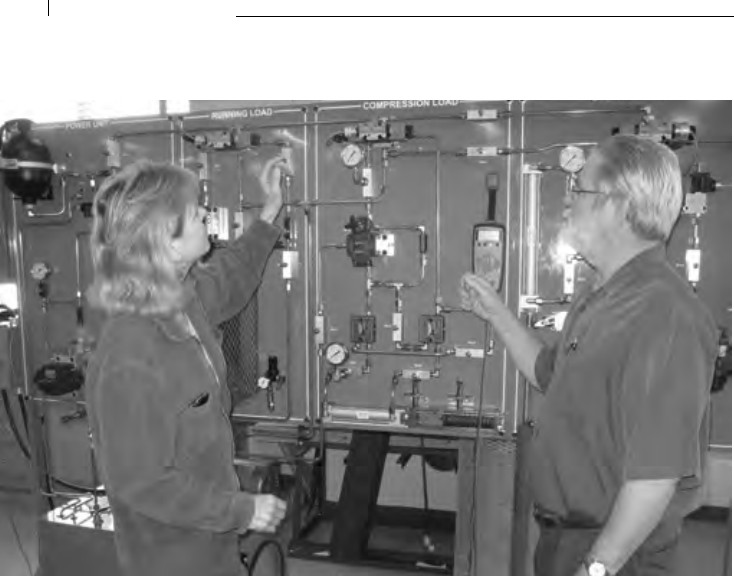
112
the course you need is oered,” says Gustus. “All you have to do is show up. You work on
your own, but the teachers are there to help when you need them.”
As a full-me employee who can only pursue his educaon on a part-me basis, Gustus
gures he needs about four years to nish his cercaon as a maintenance technician.
As of March 2014, he was about halfway there. He’s already applied for an opening in
the ranks of Carpenter’s maintenance technicians. “With my background and now these
credenals from RACC, I can go prey high on the pay scale. It’s been a big juggling act to
some extent, for me and my family. I’m 42, and my kids are six and three. I’m working 10- to
12-hour days and usually spending three mornings a week here at RACC. Luckily, I now live
about 15 minutes from school and work.”
One nal observaon on Gustus and his manufacturing career pathway. A 2010 report
by the Pennsylvania Center for Advanced Manufacturing Careers made it clear that in the
state’s manufacturing sector, there is a crical shortage of both CNC machinists and indus-
trial maintenance technicians. Gustus will be fully cered as both when he leaves RACC.
******
“I wanted something in the Reading area. And I wanted to be all but guaranteed a job
once I graduated. I also wanted to nd something I really want to do. I may be starng a
lile late in the game, but I have lots of years le to work, and life is too short to be stuck in
a job you can’t stand.”
Chapter Fourteen
Among the degree-seekers enrolled at the Schmidt Training and Technology Center is Wendy Benson.
Here in one of the center’s labs, she tells Packaging World Editor Pat Reynolds how a hardware training
module ts into the program.

113
Manufacturing Workforce Development Playbook
So says Wendy Benson, a nave of Bradford County, PA, and a stay-at-home mother of
ve for the last 13 years. With her youngest now heading for kindergarten, she wants in on
the manufacturing workforce.
Benson could have returned to Penn State University, where she had completed two
years in the Horculture Program. Horculture was no longer aracve to her, she says,
because her research told her there weren’t enough jobs in that eld. “Sll, if I was going to
return to school, I wanted to make it work at Penn State,” she says, “partly because I knew
I had those credits there. I went to Career Services and asked them who is hiring and who
is paying. They said engineering. I knew my science and math are excellent, so I gured I’d
look into engineering.”
But she gravitated toward RACC rather than Penn State University because the program is
so much more exible and because it’s located so close to where she lives. She decided to
get her feet wet by taking a course in computer technology and IT.
“Whatever path my career in manufacturing follows, I think it’s a safe bet that it’s going
to involve IT,” she says. “It was only aer I got here that I became aware of what they oer
in mechatronics. As I started asking sta and students more about it, everyone said, ‘Talk to
Bonnie,’ so I did. She took me for a tour of the mechatronics lab, and as soon as I saw that, I
knew this was the program for me.
“First of all, it’s so near where I live. And remember, I have ve kids. This program lets
me do a lot of the schoolwork through e-learning, so when we had all those snow days this
year and the kids were at home, I was home with them. But I was able to keep progressing
with my coursework. I’d jot my quesons down and get them answered by the teachers
when the snow allowed me to get to the campus. Could I have found a way to make it work
in a more tradional college or university seng? Maybe. But this is so much beer. I start-
ed in January of 2014 and hope to be done around June of 2015.”
Like the Lancaster County CTC, RACC has just as many, if not more, of the hardware
trainers that make learning come alive in the learner’s hands. “I don’t know how you can
teach this subject maer any other way,” says Benson. “You can look at a book, you can do
the simulaon on the computer. But unl you experience it in your own hands, how do you
know how much pressure you need to connect and disconnect a pneumac hose?”
When asked how this training will help her in the workforce three to ve years down
the road, her answer is simple enough: “All I can say is that as I look at job oerings in the
region, what they are looking for is exactly what I’m learning here. They make it very clear
that they prefer an associate degree like the one I’ll earn here at RACC.”
If she has one concern it’s that the eld she seeks to enter is basically populated by guys
who grew up nkering with machines and motors and all things mechanical. Lacking such a
background, she wonders if that might somehow hold her back. But in the short me she’s
been at RACC she already recognizes that the teachers in the program are all extremely
experienced in what it’s like to be on the plant oor of a manufacturing enterprise. “I’m
counng on them to clue me in,” she says.
The teachers she menons were handpicked by Spayd. “They’re classied as noncredit
adjunct faculty,” says Spayd. “Many are engineers or former maintenance engineers. Some

114
are sll employed as maintenance technicians/engineers in industry.”
The one thing a teacher at the technology center at RACC is not is an ivory tower aca-
demic. Spayd feels strongly that those who train today’s manufacturing workforce must
have rsthand knowledge and experience of what it’s like to be a manufacturer. She herself
spent 16 years in manufacturing.
“Had I not had autonomy in hiring the instructors here, I might have had a dicult me
coming on board,” she says. “Don’t get me wrong, RACC has some very good credit faculty
members here. But for this program, that was not what I needed. I needed teachers who
came from manufacturing.”
As our interviews at RACC drew to a close, one queson Spayd put to Benson was this:
How do we encourage more women to take a look at manufacturing as a career choice?
Benson’s advice was to get into the middle and high schools and engage girls more aggres-
sively at that young age.
******
Twenty-year-old Kory Koehler is about half the age of Gustus and Benson. Unlike them,
he enrolled at RACC right out of Wilson High School in West Lawn, PA. But he’s been per-
fecng his technical chops for some me now. Hanging with the cycle and dirt-bike crowd
didn’t hurt. He also launched a summerme business called Evergreen Asphalt Mainte-
nance that had him painng the line stripes in parking lots. Perhaps most signicant, he
enrolled in Project Lead The Way elecves in each of his four years of high school. A leading
Science, Technology, Engineering, and Math (STEM) iniave in more than 5,000 schools
naonwide, Project Lead The Way provides a world-class curriculum as well as teacher
guidance—all aimed at improving the quality of STEM educaon in our schools.
“Project Lead the Way gave me the opportunity to learn new technologies like CNC, CAD,
3D prinng, and modern manufacturing techniques,” says Koehler.
Koehler says he considered a four-year bachelor’s degree at places like Penn State or
Carnegie Mellon, but RACC’s focus on mechatronics proved irresisble. He hopes to grad-
uate in the summer of 2014 with his Associate in Applied Science degree in Mechatronics
Engineering Technology.
Koehler’s pathway to the manufacturing workforce has already begun in earnest. He
works as a junior service engineer three days a week at Precision Machine Tool Soluons, a
seller of CNC machines based in Sinking Spring, PA. When he rst started looking into RACC,
he wasn’t aware of how exible the program was. But now it’s one of the things he likes
best. “Geng my Associate Degree in Mechatronics Engineering and Technology is very
important to me, but because RACC is set up the way it is, I can balance educaon with oth-
er aspects of my life,” he says. “I can get my coursework in at my own pace while holding
down what’s praccally a full-me job.”
Just because he’s employed as a service engineer and on his way to an associate degree
does not mean that Koehler has ruled out a bachelor’s degree.
“In ve years I see myself connuing to work in manufacturing and using skills developed
Chapter Fourteen

115
Manufacturing Workforce Development Playbook
at RACC,” he says. “But I hope to have completed or to be pursuing a Bachelors Degree in
Engineering at Penn State Berks, as well. Why limit myself to service work? And what if I
don’t want to be working with my hands when I’m 50 or 60?”
Before saying goodbye to Koehler and leng him get back to the coursework and labs
right outside the conference room we sat in, I asked him to sum up what he liked best
about his career path. He said he liked that it allowed him to hold down a good part-me
job while pursuing his postsecondary educaon. But even more important, he said, is that
because he has a job, he is able to take what he learns at RACC and apply it in the real
world every day that he walks through his employer’s door.
“That’s what’s going to make it sck,” he says. “In my parcular case, when it comes to
learning, if I don’t use it, I lose it.”
Kory Koehler (left) enrolled in the Schmidt Training and Technology Center at Reading Area Community College
right out of high school. As he explained to Packaging World Editor Pat Reynolds, he plans to graduate in the
summer of 2014 with his Associate in Applied Science degree in Mechatronics Engineering Technology.

I
rst met Simon Nance at The Automaon Conference in 2013 where he was a speaker.
He is parally responsible for the creaon of this Playbook, because his talk excited
others throughout the conference to raise issues of workforce development. It seemed
that no maer what the topic of a conference session, the quesons always came back
to workforce issues. Aer poinng out that peculiar trend to the sponsors, we jointly
decided to develop this playbook. And given Simon’s enthusiasm for the topic, we had to
have him share his experiences in the Playbook.
Simon Peter Nance started his career as an industrial engineer in aerospace manufac-
turing, working predominantly on process improvement. In 2003, he joined STIHL Inc. as
an engineer in charge of the employee suggeson and process improvement program,
and in 2005 he became the Manager of Training & Development. By uniquely applying
engineering techniques he re-established the educaonal systems at STIHL Inc. With the
expanded role of Manager – Learning & Development, Simon broadened the on-site
programs at STIHL Inc. and set world-class standards for Manufacturing Technical Train-
ing, Employee Development, Business Skills Training, and Regional Workforce Develop-
ment. Through STIHL Inc. and in partnership with Dream !t Do !t Virginia, Simon created
an annual manufacturing summer camp program for youth that has received naonal
recognion and connues to expand.
Simon is a graduate of Worcester Polytechnic Instute with degrees in Industrial En-
gineering and Humanies, and he has his MBA from Avere University. With speciales
including instruconal design, technical wring, process improvement, and industrial
engineering applicaons, Simon has changed the common approach to the learning
arena into a discipline of “brain engineering.” Addionally, he is a cered instructor for
courses in crical thinking and teaches classes on presentaon skills, teambuilding, and
supervisory skills. In 2014, he joined Apex Tool Group as their Global Training Manager
for Power Tools. Simon acvely supports naonal and regional eorts to build a skilled
workforce and is a proponent of apprenceships and the skilled trades. He thrives in his
roles as a public speaker, teacher, and coach, but his most rewarding role is at his home,
as a husband and a father.
Simon Nance,
Manager, Learning &
Development, Stihl Inc.
Individuals and individual companies can make a big difference. Compa-
nies sponsor their own science and engineering fairs and encourage em-
ployees to serve as team coaches and judges. We collectively have much
to gain as an economy by developing an adequately skilled workforce for
manufacturing, but in the nal analysis, it is the manufacturers themselves
that have the problem, and it is up to them to inuence policy and take
direct action to solve it. Summer manufacturing camps are a tool that has
been used by workforce agencies and others. This chapter describes
how one manufacturer took on the task of developing
such a camp for kids.
Chapter Fifteen
116

by Simon Nance
T
he workforce of the future comes from the parents of today. Right now, parents,
teachers, counselors, and many trusted advisors of our youth (the workforce of the
future) have an incorrect percepon of what manufacturing is and what modern manufac-
turing looks like. The 17 addional resources listed at the end of this chapter can correct
those percepons and start a new way of thinking that will have a lasng impact on our
youth—our future workforce.
I wanted to have a posive impact on our future workforce when I realized how wrong
percepons were about manufacturing. I did this at a meeng of industry leaders in Hamp-
ton Roads, VA, in 2008; I encourage you to do the same. The next me you are with a group
of proponents of manufacturing jobs and the skilled trades, ask this queson: “Who among
you has children?” Wait for hands to go up. Then ask, “Who among you is OK with your
children not going to college?” Watch what happens with the hands. Since 2008, I have
done this a few dozen mes in a few dozen groups, and I have found that it creates a bit of
confusion in many peoples’ minds. If you have been studying the generaonal dierences
in the current workplace, you may already know the history that has built up to the current
percepons of educaon, career success, and what a “job” should look like. Asking parents
about their kids draws out two major discrepancies that can be reconciled through beer
perspecves on manufacturing.
The rst is a disparity between the concept of going to college and the concept of having
a successful career—or more accurately, having a “good job.” The second is the disso-
nant idea that jobs in the trades have lile or nothing to do with intelligence and income.
The analysis of data for college graduates, employment rates, salaries, and other related
analyses (these analyses are important, and workforce development decisions should be
based on this data) is the business of other chapters. Here we are looking at the business
of percepons; here are two. For college graduates currently employed, the percepon is
that a greater amount of the workforce is of similar educaonal level—“Everyone went to
college, right?” For employees who have good jobs (let’s say a skilled trade posion such
as a machinist) and do not have a college degree, at least three percepons exist: “College
graduates have beer jobs than me,” “My kids have to go to college to be beer o than
What the Future Workforce
Doesn’t Know
Building awareness about how cool
manufacturing really is.
Chapter Fifteen
117
Manufacturing Workforce Development Playbook

me,” “and I am worse o because of my job and degree level.” Some data will support
these percepons, other data will refute them. The issue with these percepons is that
they associate college, rather than skill, with success. Not to mince words, I will encourage
any youth to strive to go to college; I will rst, however, encourage them to get a job to
build (or realize talent in) a work skill.
The numbers behind these percepons may show the truth of the past and help us
logically develop policies and programs and make decisions about our future. But when
we think about success for our children, our emoonal desire for beer successes for
our progeny skew our logic and let us hope for beer tomorrows than the numbers may
predict. You can’t convince me to have my kids go into the trades because of average sal-
aries or predicted job growth. The logic doesn’t follow—desire for their success is based
on emoon. Using emoons, however, my kids can convince me to fully support what
they want to do when they grow up (be an astronaut, for example) because they think it
is a cool thing to do.
So how do we make our kids think manufacturing is a cool thing to do? Have them
aend a Manufacturing Technology Summer Camp. The original Manufacturing Technology
Summer Camp was conceptualized in 2009 and developed at STIHL Inc. over a two-year pe-
riod. In 2011 it was rst run at STIHL in Virginia Beach, VA. Since then, in partnership with
Dream !t Do !t Virginia and the Virginia Council on Advanced Technology Skills (VCATS), the
Manufacturing Technology Summer Camp concept has grown to a statewide iniave.
The Manufacturing Technology Summer Camp’s goal is to ensure that students are
properly introduced to modern manufacturing through tours, presentaons, small projects,
and a compeve manufacturing acvity. The camp is a four-day process where middle and
high school students learn how to design and execute a manufacturing process, brainstorm
and make decisions, and work as members of a manufacturing team. They also create pro-
ducon plans, improve processes, and learn quality assurance techniques.
On the rst day, students learn about their team members and about the camp compe-
on and producon systems they will use. Each team builds the essenal machine for
that producon system and tests its capabilies. On the second day, students construct
a manufacturing process for each of the dierent types of products the team will make
in compeon. Building these prototypes gives them the knowledge and skill necessary
to have the producon system work well. On the third day, teams receive their product
demand, which is used to determine how to balance manufacturing operaons to produce
the required number of products in the two-hour compeon. On the fourth day the teams
compete in front of family, friends, judges, and other guests, using their producon systems
to manufacture the required quanty of dierent products.
Each day of the camp has four or ve acvies, at least one presentaon from a sponsor-
ing company or organizaon, a factory tour, and a review and recap of lessons learned by
the students. As the camp has developed and evolved, the documents and reference mate-
rials have become more standardized, and in the past three years, the camp has become
something that any manufacturing company or group of companies within an industry can
host. For example, STIHL hosts a camp based on machining and assembly, using a three-ax-
118
Chapter Fifteen

is CNC tabletop mill. A prinng company in Virginia uses printers, cuers, and presses to
put together direct mailing packets for distribuon; a boling company can use tanks, valve
manifolds, and conveyors to produce lled containers. The camp design is universal, but it
takes some eort to make it work.
The rst year we ran the camp at STIHL, ve student teams, each led by a volunteer
coach and a team assistant, spent three and a half days preparing for and working in a
manufacturing compeon that built three dierent kinds of clocks. In following years, we
built printed circuit boards, robot chassis, ashlights, and lamps. Though the products have
changed over the years, the camp design and the principles experienced each day stayed
the same. Each group spent the rst day building their team and construcng, program-
ming, and tesng a three-axis CNC engraving mill. Yes, all that on the rst day. On the
second day, team members learned a number of manufacturing operaons from drilling
to tapping to painng to assembly. They were also given materials to construct prototypes
of the three dierent clocks. This is the day that the hands-on acvies showed what it
takes to turn raw materials into nished goods. Producon requirements were given to
the teams on the third day, as well as a schedule for shared resources, such as a drill press
and a paint booth. Teams needed to create a balanced producon plan for the two-hour
compeon on the following day. The two-hour manufacturing compeon started with
raw materials for 20 clocks on each team and ended with three teams compleng the pro-
ducon requirement and one team being judged the winner.
Camps cost between $200 and $2000 per team, depending on the types of machines used,
119
Manufacturing Workforce Development Playbook
Some dierent pieces of media coverage highlight STIHL’s camp since 2011:
2013 STIHL Manufacturing Technology Summer Camp
hp://wtkr.com/2013/07/18/kids-aend-manufacturing-summer-camp-in-virginia-beach/
hp://www.wavy.com/dpp/news/local_news/va_beach/shl-hosts-manufactur-
ing-camp-for-students
2012 STIHL Manufacturing Technology Summer Camp
hp://www.shlusablog.com/2012/08/shl-inc-hosts-manufacturing-camp-for.html
hp://www.workforce.com/arcle/20130305/NEWS02/130309972/shl-inslls-man-
ufacturing-skills-into-high-school-students-learning-via-summer-camp#
hp://www.shlusa.com/informaon/corporate/press/july26_shl_manufacturing-
camp_events/
hp://hamptonroads.com/2012/07/camp-students-learn-business-manufacturing
2011 STIHL Manufacturing Technology Summer Camp
hp://www.wvec.com/home/Shl-Incorporated-Summer-Camp-125593648.html
hp://ireport.cnn.com/docs/DOC-636203
hp://beldenblog.com/shl-re-tools-summer-camp/

120
the products being made, and the industries hosng them. Each team of between three and
seven students needs a coach and a team assistant, and the host company will need a core
team of at least three to administer the camp. It takes about 200 or more man-hours to pre-
pare and execute those things, some as simple as notes to parcipants. But it all needs to be
done precisely. Thirty dierent leers and e-mails go out to student parcipants, volunteers,
and parents between announcement of the camp in the late winter and running of the camp
in the summer. Eorts to get sponsors and industry and academic partners takes me and
gumpon, as does seng up scholarships and other awards for the winning students.
So why put forth so much eort? Why spend hours and dollars to have students see
manufacturing for four days? Because showing our future workforce what it takes to turn
raw materials into nished, salable goods makes an impact that lasts a lifeme. But don’t
take my word for it; these are notes from a few parents in response to the daily updates
sent home by the camp host at STIHL:
Thank you for providing Adam and his fellow campers with an amazing experience last
week! It was fascinang and inspiring to watch the kids as they worked on their projects;
worked in teams; and worked through the roadblocks that presented themselves along the
way. My husband and I (both mechanical engineers) were equally impressed by the beauful,
clean, modern campus and facility. I hope that you will connue the camp program in the fu-
ture. I’m sure you know what a challenge it is to interest 15 and 16 year old kids in ANYTHING
that doesn’t appear in a digital form. And so the fact that they were all there, all working to-
gether and all feeling great about themselves and their teams speaks volumes. - Amy Zelenka
I just wanted to thank everyone involved in the STIHL manufacturing and technology
camp. It was an excellent program and a great opportunity for high schoolers to be part of
the camp. My son, Pieter, enjoyed everything and is now convinced he will become an engi-
neer in the future. - Louise Honig
I can’t tell you how pleased I am that STIHL is pung on this program. As a local business
owner, it is very dicult to nd good people with technical skills and a clear understanding
of what it takes to work as a team, to think about “the process of producon,” and to take
pride in what they do. My son Perry came home yesterday with a profound respect for
STIHL and what your company has accomplished; moreover he is excited about a future in
industrial engineering as he is parcularly mechanical and computer oriented. My thanks to
STIHL and all involved in this most worthwhile program. - Robert Bloch
I really enjoyed my day there helping at camp! The tour and your enre facility is amaz-
ing. It was my rst experience in a factory! I am forever changed. I found myself thinking
about all that I learned and about everything I used at home and what goes into making
it... WOW. So, not only are you impacng our kids, you are also impacng your volunteering
parents too! - Helen Voorhees
As encouraging as the new perspecves from these parents were, a note I received from
a parent who has since volunteered as a coach has been an inspiraon for me and for STIHL
to share this camp with any company that wants to make a real lasng impact on their
future workforce and on their communies.
I would like to say “Thank You” for leng Zach aend the Manufacturing Camp the past
Chapter Fifteen

121
Manufacturing Workforce Development Playbook
two years. I’m sure you are not aware, but the camp has made a big dierence in Zachary’s
life. Prior to the camp last year, Zachary had diculty with group work in school. This past
school year, his teachers reported that he has had no diculty with group work. In addion,
this past school year, Zach has taken responsibility for his learning and did so well that he
earned the status of Honor Roll for 3 out of the 4 quarters. He has also done so well that he
no longer used any accommodaons or modicaons for his Ausm and no longer qualied
for any Special Educaon Services. In fact, Zach did so well in his classes that he will be
taking advanced courses next school year (Algebra II/Trigonometry, Physics, and A.P. English
11), in addion to Engineering Technology. This past year, he was at the top of his class in
the 3-D Modeling & Simulaon Program at his school
Zachary plans on going to college at VA Tech, with a major in Engineering. This past
Spring, he was chosen to aend the Spring Fling program at the Virginia Tech College of
Engineering, and he will be invited back to VT every semester unl graduaon, for various
events & acvies at the VT College of Engineering.
Zach’s aendance at the camp played a part in all of his success. Since the rst camp, he
was able to envision life beyond high school, and what he needed in order to achieve those
goals. Zachary has become determined to fulll his dream of becoming an Engineer. Thank
you very much for giving my son the opportunity to parcipate in the STIHL Manufacturing
Technology Summer Camp the past two years. I will be forever grateful! – Brenda Lamb
Changing percepons of what manufacturing is—what manufacturers can do—is vital
to the manufacturing renaissance we are starng to experience. The impact we (man-
ufacturers) can make by something as simple as opening our doors to students, so that
they can see the reality of making things, can do more than build excitement in our future
workforce, it can forever change lives.
Taking acon right now starts with the right perspecve, then the right rst step. These
17 addional resources are a sampling of some amazing work across the naon that
creates new percepons of manufacturing and what it takes to make our future workforce
great. There are undoubtedly many more resources out there. If you take half of your day
and become familiar with these, you will be empowered to make some real changes with
your new perspecve.
Websites & Web Resources:
Edge Factor
hps://edgefactor.com/home
How It’s Made
hp://www.sciencechannel.com/tv-shows/how-its-made
Max & Ben’s Mfg. Adventures
hp://www.westerntc.edu/maxandben/
Dream !t Do !t Virginia
hp://www.dreamitdoitvirginia.com/index

122
Tooling U
hp://www.toolingu.com/shortage/
The American Innovator
hp://theamericaninnovator.com/
Advanced Manufacturing Portal
hp://manufacturing.gov/welcome.html
Reports and WhitePapers:
VMA: Denion of Advanced Manufacturing (see .pfd)
Brookings, Metropolitan Policy Program “The Hidden STEM Economy”
hp://www.brookings.edu/research/interacves/2013/the-hidden-stem-economy
McKinsey Study on Educaon to Employment
hp://mckinseyonsociety.com/educaon-to-employment/report/
Organizations / Educational Foundations:
Manufacturing Skills Instute (Virginia Manufacturers Associaon)
hp://manufacturingskillsinstute.org/
Manufacturing Instute (Naonal Associaon of Manufacturers)
hp://www.themanufacturinginstute.org/
ASM Materials Educaon Foundaon (ASM Internaonal)
hp://www.asminternaonal.org/foundaon/about
Nuts Bolts & Thingamajigs (Fabricators & Manufacturers Associaon, Intl.)
hp://www.nutsandboltsfoundaon.org/
SME Educaon Foundaon (Society for Manufacturing Engineers)
hp://www.smeef.org/
FIRST Robocs
hp://www.usrst.org/
Naonal Instute for Metalworking Skills (NIMS)
hps://www.nims-skills.org/web/nims/home
Chapter Fifteen

123
Manufacturing Workforce Development Playbook

124
Chapter Sixteen
Michele Bupp,
Education Promotions
Programs Manager,
PMMI, The Association for
Packaging and Processing
Technologies
A
s word got out that this Playbook was looking for industry best pracces, we
became aware of PMMI’s JumpStart program, which is working to send the
message to youth that manufacturing is cool. In her role as educaon pro-
moons manager at PMMI, Michele Bupp specializes in markeng, strategic plan-
ning, and social media for the Educaon and Workforce Development department.
She works directly with JumpStart chapters, providing guidance and resources. Mi-
chele has 20 years of communicaons experience working for trade and profession-
al associaons and engineering companies in the Washington, D.C., area.
Industry associations are also tackling the problem of getting an accu-
rate perception of manufacturing in the minds of young people and their
parents. I am always struck by the contrast between German and U.S.
industry trade shows. In Germany, major trade exhibits extend across
weekends, during which time, mothers and fathers bring their children—
walking and in strollers—to see rsthand how exciting manufacturing can
be. Manufacturing looks like a video game, but the elements are real,
not virtual. By contrast, U.S. trade exhibits post signs at the entrance
proclaiming that absolutely no one under the age of 16 may be admitted.
By that time, the opportunity has been lost. Through their member
companies, trade associations can reach out to elementary, middle,
and high school students, parents, and guidance counselors
as the following chapter will describe.

125
Manufacturing Workforce Development Playbook
JumpStart Shows Kids that
Manufacturing Is Cool
Getting youth interested in manufacturing careers.
by Michele Bupp
W
hy do we care if kids know about packaging technology, if they understand what we
do, why we love it, and the careers available in the industry?
Because, as pointed out earlier in this book, 80% of the manufacturing workforce in the
U.S. is between the ages of 45 and 65, and one-third of these workers are nearing rere-
ment. Like the rest of manufacturing, the packaging and processing industries that are a
part of the hybrid manufacturing space need highly skilled people to join our workforce,
and what beer populaon to reach out to than youth—who are just now thinking about
what they want to do when they grow up—with our message about the excing world of
packaging and processing.
Chapter Sixteen
Daniel Edwards, Lead Assembler at Lenze Americas, completed an 18-month training program from Universal
Technical Institute, IL. Lenze Americas is a member of PMMI’s JumpStart Chicago.

126
PMMI’s JumpStart iniave was developed to help achieve that goal—to forfy and grow
the manufacturing workforce so our industry remains viable and strong today and in the
decades to come. JumpStart links packaging and processing technology companies and
end users with school students in their local areas in an eort to inspire youth to choose a
career in packaging.
“Kids have no idea how the Cheerios get in the box,” says Timm Johnson, Vice President
of Sales/Markeng at Spee-Dee Packaging Machinery in Sturtevant, WI, and a member of
JumpStart SE Wisconsin—the rst of several JumpStart chapters to form. “So our starng
point is exposure and educaon.”
A longme supporter of PMMI, Johnson is chair of PMMI’s Educaon and Workforce Devel-
opment Commiee. When asked why he’s so passionate about JumpStart, he says, “There’s a
popular percepon of factory work as dirty, hot, and boring. But the reality is [that] manufac-
turers’ plants are clean and air condioned, with new machines and challenges every day.”
One thing JumpStart aims to do is set the record straight: Manufacturing is cool. Why?
Because it involves things kids love: robocs, automaon, solving problems, creavity, and
a chance to make good money. Jobs such as mobile hydraulics engineer, packaging techni-
cian, mechatronics technician, and electrician oer real opportunies to do work that helps
people, even saves lives. Its that a stretch? Not really. Think pharmaceucals, medical-test-
ing equipment, and the fresh and frozen food we eat every day.
How JumpStart Works
Representaves from PMMI member companies and from end users—which are the compa-
nies that buy machines, materials, and services from PMMI members to process and package
their products—reach out to local elementary, middle, and high schools to nd opportuni-
es where they can educate and inspire kids. “Companies realize the overall benet their
collaboraon will have on schools, students, the industry, and even the economy, and they’re
willing to work together to achieve it,” says Maria Ferrante, VP of Educaon and Workforce
Development at PMMI.
For example, JumpStart parcipants volunteer to speak at school assemblies on Career
Day, judge school science fairs, and get involved with already-established school programs
Chapter Sixteen

127
Manufacturing Workforce Development Playbook
that focus on technology, such as STEM (Science, Technology, Engineering, and Math), First
Robocs, and Project Lead the Way, as well as engineering clubs.
“Our goal is to build interest not only in the packaging industry, but to help people learn more
about your company, as well,” says Ma Jones, Director of Sales at Dorner Manufacturing Corp.,
Hartland, WI, who leads JumpStart SE Wisconsin. “Companies can invite students and teachers
to tour their plants and learn rsthand what careers in packaging are all about,” he adds.
In addion to SE Wisconsin, JumpStart chapters are underway in Chicago and Minneap-
olis; Tampa and Philadelphia are slated to kick o later this year. In fact, JumpStart Chicago
got o to a strong start in January 2014 with these PMMI members on board: ARPAC, Ban-
ner Engineering Corporaon, Domino North America, Lenze Americas, Morrison Container
Handling Soluons, M-Tek, and Triangle Package Machinery.
The Wow Factor
“When talking to kids about packaging, it’s important to have a wow factor,” says Brian Or-
manic, Lead Applicaons Engineer and Integraon Specialist at ARPAC, Schiller Park, IL, and
co-lead of JumpStart Chicago. “Demo a robot or an automated machine for them. Show
them how products they know are packaged, like Coke or Doritos or gummy bears. Now
you’ve got them excited about something they can relate to.”
Ormanic recently accompanied his twin boys’ elementary school class on a eld trip to
the Museum of Science and Industry in Chicago, and when the group reached the packaging
machinery, he explained the technology to the kids. Even though the students were young, he
knew this was a teaching opportunity he couldn’t miss. “The kids loved it, and I had fun.”
When developing outreach plans to youth, JumpStart targets the major inuencers in
students’ lives—parents, guidance counselors, and teachers—so that they, too, understand
the advancements in manufacturing and what it oers young people.
JumpStart thrives on ingenuity, and that’s why PMMI encourages chapters to adapt ac-
vies to meet their specic needs and objecves, which can be ever-changing. “Only local
employers can truly understand what will work in their area,” says Ferrante.
PMMI’s Educaon and Workforce Development department provides resources and sup-
port to chapters, as well as a promoonal guide to publicize the chapter’s outreach acvies.

128
I
n the course of a year, I visit quite a few community colleges and career cen-
ters. While many schools have been successful at bringing adult learners into
their manufacturing programs, it is far more rare to see a strong pipeline from
high school into a community college program targeted to manufacturing careers.
When I see a such a pipeline, or I see a change in a pipeline from year to year, I
always inquire about what changed. Such an inquiry led me to nd out about the
Careers in 2 Years program in Berks County, PA. And everyone I asked about the
inux of high school students told me, “You need to speak with Jon Sco.” Not only
did I do that, but I also reached out to him to share his success in the Playbook.
In June 2004, Jon Sco was named President and CEO of Greater Reading Eco-
nomic Partnership (GREP).
Jon previously spent 10 years as President of Time Warner Cable’s Eastern Penn-
sylvania Division and later as President of Time Warner’s Binghamton, NY, Division.
At Greater Reading Economic Partnership, Jon uses his leadership skills and man-
agement experience to mobilize the mulple resources of the Greater Reading and
Berks County economic development community. His goals are to retain exisng
business, aract new industries, and foster a compeve business environment
through aggressive markeng aimed at creang sustainable and diverse employ-
ment opportunies for current and future generaons.
He currently serves on the Greater Reading Young Professionals Advisory Board,
the Foundaon for Reading Area Community College, and the Penn Corridor Inia-
ve. During Jon’s me in Berks County from 1989 through 1999, he served on the
board of directors for many not-for-prot organizaons, Jon also has been honored
with several awards in recognion of his outstanding, service to the community.
Jon served as the Co-Chair for the Ride to Prosperity that was unveiled in June of
2010, and he assists in forming the economic development roadmap for the Great-
er Reading region.
Jon received a Bachelor’s Degree in Polical Science from Kalamazoo College in
1973. He and his wife, Vee-Vee, reside in Wyomissing, PA, and they have two daugh-
ters: Genevieve, who is a vising fellow at Yale University, and Lily, who recently
graduated from Bryn Mawr.
Jon Scott,
President & CEO,
Greater Reading
Economic Partnership
Chapter Seventeen
To adequately ll the educational pipeline for manufacturing jobs, kids need
to be informed in their middle school years. In some countries, students
are put onto a track that leads directly to manufacturing. In our country,
kids are given wide latitude to choose their track, and many do so with very
limited information and with little thought to the practical realities of someday
needing to support a family. While many programs have been undertaken
under the banner of STEM (science, technology, engineering, and math)
initiatives, these are more likely to be directed at those who are in advanced
placement programs and sometimes overlook that group referred to as “the
forgotten middle half.” Innovative approaches are being tried to proper-
ly inform students and parents across the board, and these approach-
es are resulting in success. This chapter shows how a regional
economic development agency tackled the issue.

129
Manufacturing Workforce Development Playbook
S
everal years ago, it was becoming apparent that there was beginning to be a “skills gap”
between exisng manufacturers’ job requirements and the skill sets people had—par-
cularly younger individuals nishing high school. This problem became apparent to the
Greater Reading Economic Partnership (GREP) in Berks County, PA, as its sta constantly
spoke with area manufacturers. Over the course of these conversaons, there were some
predominant themes that seemed quite illogical:
• Unemployment was sll relavely high.
• Exisng and outstanding manufacturing companies had high-paying job openings they
were having diculty lling.
• There were not enough people applying for jobs that had all of the requisite skills for
careers, such as computer numerical control, welding, and mechatronics.
As GREP learned more about this dichotomy, it was clear that there was a signicant
percepon problem inuencing individuals that would choose a Career and Technology
Center (CTC) or a community college. Too many individuals felt they had lile choice. Even
if they were not sure about the direcon they wanted to choose for their profession, they
felt they had to go to a tradional four-year liberal arts school. One of the root causes of
this dilemma was that people sll perceived CTCs as “vo-tech,” which was stereotyped as
suitable for troublesome students or slow learners. GREP decided that it needed to shaer
this erroneous myth.
Its sta worked with a local integrated markeng agency, Reese, which immediately un-
derstood the core issues and developed a full mulmedia markeng, adversing, and public
relaons campaign called Careers In 2 Years (CI2Y). At its core, CI2Y had to make vo-tech cool
and change the outdated percepons for a beer appeal. While students were a key target
audience, so were their parents and educators who serve as key inuencers and gatekeepers.
Therefore, it was crical to change their atudes and beliefs about career technology ed-
ucaon. Through visuals and tesmonials, the CI2Y campaign needed to reinforce technical
training as a viable career path that is just as rewarding as the tradional collegiate route.
by Jon Scott
Careers in 2 Years:
Go from Learning to Earning Fast
A local economic development partnership promotes
manufacturing careers to kids.
Chapter Seventeen

130
Geng career and technology training could be the rst step toward someone’s future, a
mid-step, or the last step in formal training along anyone’s career opportunity ladder. What
is truly important is realizing that there are many ways for people to garner “stackable
credenals,” including various cercates as well as degrees. There is a true constellaon of
programs available for people today.
New Realities Shape the Message
There are several things that helped begin to shape the components of the message for
CI2Y. First of all, today’s workforce has very dierent training and educaonal requirements
compared to 30, 40, and even 50 years ago. Also, with the technological boom, our world
has changed dramacally. As a result, we needed to fundamentally shi how we think
about the types of training and educaon needed to prepare people for careers appropri-
ately. Today’s manufacturers need people with more than just brawn. Employees need to
be able to use both their hands and their brains simultaneously.
Another factor considered is that almost half of today’s college graduates have ex-
treme diculty in not only nding a job, but also nding one within their major. There’s a
signicant percentage of students from tradional colleges burdened by a huge amount of
debt, frequently ve to six gures, before they step foot on the job. Recently, this has been
highlighted as a potenal naonal dilemma.
With CI2Y, students can reduce the amount of debt immensely. They may start in a CTC
and advance through an apprenceship before they graduate high school, giving them a
great advantage.
CI2Y oers a new dynamic to begin changing percepons. Today’s model of educaon
looks much dierent than the tradional “ladder-climbing model”; it’s more cyclical with
mulple entry and exit paths to provide a well-rounded, growing career. CTCs and four-year
college degrees can coexist to provide the appropriate degrees and skills that workers need
for connuous educaon and a producve career. CTCs train you for dierent skills and
roles, which can be started at all dierent entry points. Working adults can use CTCs to
advance their current skills and their careers with relevant training. CTCs also are ideal for
retraining adults or veterans who choose a new career path.
CI2Y Campaign Appeal: Learn to Earn
The CI2Y campaign materials directed people and trac to three specic websites: Reading
Area Community College, Berks Career and Technology Center, and Reading Muhlenberg
Career and Technology Center.
The branding for CI2Y was specically created to appeal to younger audiences with its
edgy, bold look, and empowering feel. The campaign materials were developed in both
English and Spanish, with some materials featuring acronyms frequently used in texng—
praccally a language of its own. CI2Y’s fully integrated campaign included a large focus on
web, electronic markeng, social media, and digital ads—allowing the performance of each
message and medium to be well-tracked and measured. Public relaons taccs included
news releases, editorials, and speaking engagements that gained exposure and promoted
Chapter Seventeen

131
Manufacturing Workforce Development Playbook
CI2Y among local business and educaonal leaders. CI2Y’s campaign materials included
websites, digital and print ads, yers, posters, direct mail, billboards, and high-denion
videos. Thirty-second commercials also ran on cable networks and in well-targeted movie
theaters as trailers.
The energec, fast-paced videos and edgy ads depicted modern manufacturing envi-
ronments more accurately—clean, high-tech, and essenally hip to work in. They featured
a “Learn to Earn” message and showed people in great jobs that pay excellent money.
Local-area average salaries were featured too, and typically were at least 25% higher than
the average salaries of college graduates. CI2Y focused on very specic, available jobs in
local manufacturing companies, including welding, mechatronics, robocs and automaon,
precision machining, machine shop technology, and computerized draing technology.
The Game Changer
Although CI2Y is relavely new, it is already beginning to increase enrollment within CTCs. The
CI2Y program was highlighted at both of the 2013 Pennsylvania Economic Development As-
sociaon semi-annual meengs, and a great number of individuals from mulple counes ex-
pressed interest in using this concept to customize it for their region and their requirements.
Top execuves in Pennsylvania’s Department of Labor and Industry have encouraged GREP
to develop a full-blown program that other counes can use throughout Pennsylvania. GREP
and Reese have created CI2Y-branded templates and materials that can be customized or
slightly modied to t the needs of other locaons that may benet from the program.
GREP believes that giving people the type of training that Reading Area Community
College and the CTCs provide is an opportunity for graduates to pave a smoother road
to great-paying jobs. In fact, some area companies guarantee an interview and preferred
screening among these graduates. Since many local companies oer educaonal benet
programs, once individuals land a job with a company, they will sll have the opportunity
to expand their formal educaon—including addional skills training—and can develop
their career direcon by pursuing a four-year degree or even a master’s degree. Oen the
employers will pay some or all of the educaonal costs, further reducing personal debt.
It’s important for people—especially high school students and their parents—to under-
stand that manufacturing and technology jobs are hip, high-paying, and eminently available.
In fact, we believe that unl the negave percepon behind CTCs and community colleges
reverses, we may risk losing excellent employers who could relocate to nd the labor pool
they need. GREP knows it has the talent right here in its home region. It’s crical to make
sure there is an easy and non-sgmazed pathway for people to get the proper training.
Ulmately, the goals and metrics that are most important are the number of applicaons
and graduates from Reading Area Community College and the area’s two CTCs. Monitoring
and inuencing the number of people that land jobs as a result of proper training is key.
Many communies have workforce investment boards, economic development boards, and
the tools. But few—if any—have established the process to iniate a conversaon that leads
to collaboraon among the appropriate community players and organizaons. CI2Y outlines
the process of who to bring to the table and consideraons and decisions to make, while

132
providing CI2Y artwork and branded tools that GREP can customize for other locaons.
Over me, the CI2Y program and the solid plaorm it builds for local economic develop-
ment will connue to solve pressing needs and help nourish its community. It will help:
• Sustain skilled labor through two-year programs.
• Forecast future community need trends.
• Build local workforce by training and retaining skilled workers.
• Maintain collaboraon between educators and manufacturers to posively aect the
community’s economic development—sustaining the present and planning for the future.
CI2Y has created a process that contributes to economic development that will have a
signicant, long-lasng impact in the community. Its process facilitates the appropriate
conversaons with the right people in the community. Manufacturing companies and
educators in two-year degree programs and CTCs now collaborate to project their future
workforce needs. In turn, educators can establish the courses to train incoming students—
including working adults—in skilled labor trades.
We encourage you to visit www.CareersIn2Years.com to watch the informave and very
energec two-minute video to capture the vibe of the CI2Y program. There are also a
number of resources that will give you a clear understanding of what the CI2Y concept can
accomplish for students, adults/veterans seeking new career paths or further training, and
the overall local economy.
Chapter Seventeen

133
Manufacturing Workforce Development Playbook

134
Kevin Lipsky,
Instructor, Wisconsin
Indianhead Technical
College
I
met Kevin Lipsky years ago (I can’t remember when) at a Pack Expo trade show.
Kevin has always shown his passion for helping students nd careers in manufac-
turing, and he has taken the iniave to bring his students to Chicago or Las Vegas
for networking, student compeons, and familiarizaon with the industry. He is a
trustworthy volunteer, bringing both an industry and an educator viewpoint, when
it comes me to develop cercaon exams with PMMI. When he heard about this
Playbook, he wanted to help.
Kevin Lipsky has been an instructor at Wisconsin Indianhead Technical College
for 27 years. As such, he has experienced, more than many, the changes in both
educaonal technology and machine technology over a span of three decades. He
has developed the Automated Packaging Systems Technician program at WITC to
meet the needs of today’s world-class machine builders and end users.
Prior to becoming an instructor, Kevin was employed by Bemis Machinery Com-
pany, in Green Bay, WI, a manufacturer of sterile product lling, ow wrappers,
thermoformers, and pallet wrappers as a service engineer. He is an acve member
of the Instute of Packaging Professionals (IoPP) since 1978. He holds a Master of
Science degree in Career and Technical Educaon and a Bachelor of Science degree
in Industrial Technology, both from the University of Wisconsin Stout, in Menom-
onie, WI. He was one of the rst graduates from the WITC program he now teaches,
a program that is unique in Wisconsin.
Skilled manufacturing technicians have been referred to as “gold-collar”
workers, reecting the fact that they are worth their weight in gold and enjoy a
special role inside most companies. Some might refer to them as shop-oor
geeks. Managers acknowledge that they would be the last to be let go in a
downturn, and during the recent recession, there was ample evidence of this.
Many of these folks have been developed and promoted internally from other
manufacturing jobs. But as the pace of technology deployment increases
along with the rate of retirement, it is becoming more common for manufactur-
ers to look to technical colleges to ll the role once played by apprenticeship,
putting younger people in more responsible roles. Instructors who have
been turning out these graduates for some time have a special insight
into what works and what doesn’t as high school students make
the two-year transition to a responsible role in industry.
Chapter Eighteen

135
Manufacturing Workforce Development Playbook
I
see many students in my role as a technical college instructor. Many are recent grad-
uates from local high schools who have lile idea how to get from where they are to a
rewarding and successful career. I feel that part of my role is to serve as a mentor to help
these students nd the best careers that leverage their interest in technology, strong
technical preparaon, basic skills in math and English, and their general employability
skills (work ethic, atude, etc.). Many of these good jobs are in manufacturing and are
increasingly being referred to as Gold Collar Careers. This term reects the value that em-
ployers place upon these employees who possess good technical skills, can think on their
feet (troubleshoot), and work with their hands and mind at the same me. I would like
to share some of what I have found useful in helping students overcome the obstacles
and achieve success upon leaving our college and entering manufacturing.
But rst a bit of my own story, which is relevant here and instrucve because I had to
deal with many of the issues and challenges that young people face today. It’s a story of
how I went from high school to a four-year bachelor’s degree program in engineering
science to being a college dropout to working low-wage jobs to discovering that there
was this thing called a two-year technical college to eventually becoming an instructor in
a two-year technical college program.
My story begins with graduaon from River Falls High School in Western Wisconsin.
Encouraged by family and friends, I enrolled at the University of Wisconsin River Falls
(UWRF) for a four-year engineering science program directly out of high school with
recommendaons from family and university personnel. I had prepared academically for
college by taking college preparaon courses in math, chemistry, and physics, but I had
not prepared myself mentally for a self-movated, fast-paced course of study, nor was I
used to being in the company of so few friends from my hometown. I dropped several
courses and completed a few, but soon enough I was no longer working on a four-year
bachelor’s degree, and I didn’t have much of a plan.
I decided to work for a ski area on the li crew, and in the spring, helped build residen-
al homes with a local carpenter since I had some previous experience with construcon.
My father was a professor at UWRF, and my mother taught second grade at the local
by Kevin Lipsky
Chapter Eighteen
The Path from High School
to Gold Collar Career
Students need guidance to help them make the
choices that lead to a satisfying and successful career.

136
elementary school. They were not happy with their eldest son’s choice of low-skill and
low-wage employment. Previous jobs that I had held over several years while sll in high
school had helped me to develop my employability skills, such as being able to perform
tasks with safety in mind and pung in eort for the pay received. These jobs provid-
ed spending money that was put into my hobbies of muscle cars and downhill skiing. I
believe this background informaon is important to illustrate how young people are
frequently treated and perceived as they think about entering a career.
My father was teaching a counseling course, and the dean of student services at WITC
was in his class. The dean described a new program that had just started at the Technical
College in New Richmond. My father briey outlined for me what a technical college
was, since I was not aware, and he explained the new program that was designed to
train people on the assembly and repair of packaging machines. I was interested, since I
worked on my own equipment and my uncle’s farm equipment and enjoyed learning how
things could be xed and operated. One day, I was taken to WITC and shown the door
to the lab. I saw machines and components that were new to me, but I was fairly certain
that I would be able to master them with some pracce. I enrolled in the program and
proceeded to nd out about the eld of packaging.
I remember thinking that I could learn about packaging more quickly by spending me
with a family friend who worked for 3M and who seemed to enjoy his career. I spent me
reviewing the packaging trade journals he shared with me and geng an idea about the
terms and types of products one would need to become familiar with to be successful.
Aer my rst class trip to Pack Expo in Chicago in 1978, I was sure that the world of
packaging machinery was something that I could enjoy while earning a decent living. I
also felt that I had something to oer immediately to an employer while I was further
developing myself through experience. Aer graduaon from the one-year program at
WITC, I found a small company that was developing a machine that would mine lead shot
from trap shoong ranges, and I worked on these large pieces of machinery at several lo-
caons in Wisconsin. In the fall, I furthered my educaon at the University of Wisconsin
Stout in Menomonie, WI, earning a B.S. degree in Industrial Technology with a concentra-
on in packaging. A search in a trade journal had a news release about Bemis opening a
new packaging machinery producon facility in Green Bay, WI. I pracced my networking
skills to nd the connecon who would give me a tour and help with my applicaon and
interview. I was selected as one of the two eld service engineers who worked with food
and pharmaceucals in many parts of the world. I later accepted a posion as instructor
at WITC and began work to develop curriculum and solicit 100-plus packaging machines
that could be used for hands-on training. A working relaonship with employees and
vendors was also a major task. To earn my instructor cercaon, I added a Masters in
Science Degree in Career and Technical Educaon.
The point I’m trying to make is that while my career path, described above, was any-
thing but neat and dy, it turned out to be the perfect preparaon for the job I accepted
in 1986 and have enjoyed ever since: instructor in the Automated Packaging Systems
Technician Program at WITC. In this posion, I am able to share every day the excitement
Chapter Eighteen

137
Manufacturing Workforce Development Playbook
of making correct career choices with students who, like me, also nd manufacturing a
rewarding place to forge a career.
Unfortunately, students too oen arrive in my program having to overcome basic
mispercepons about a manufacturing career. For example, they think that manufactur-
ing has limited earning potenal and limited room for advancement. Many students see
the wages that are oered for entry-level producon work as reasonable, and since these
jobs do not require a commitment to geng an educaon, they start work without
any formal training. They somehow need to be convinced that they can advance within
manufacturing and earn more with some educaon or an associate degree. They should
enroll in a college course. But too oen, they see only two opons: going to a university,
which they reject, or going to work. The opon of a cercate or an associate degree is
not being presented to them.
The second mispercepon is that they have to delay the earning of a desireable income
while they are geng their educaon, or they have to nd a way to go to work and
school at the same me, which in our college can be dicult. These are complex issues.
We need to do a beer job of communicang opons and addressing concerns in high
school to movate and help more students transion from school to careers. Students
who are self-movated and have an innate interest in technology have overcome the
dicult quesons of what skill could I train for and will that lead to a reasonable income.
Frequently the help they have found to arrive at those decisions has come from a net-
work of friends and employers through conversaons about what might be a good t
for the individual. I try to help students each day with their important quesons about
which skills they need to get hired, whether they are good enough for an employer to
hire them, and which skills will an employer help them to develop later.
Another issue that I see in our rural area that is causing students to resist obtaining
career training and educaon is where the training and the ulmate career posion is lo-
cated. Some students would like to stay close to home and work near familiar locaons.
It can be dicult for a small-town person to make a shi to the city or vice versa. It is
also very important to recognize that most students need to work at least part me while
at school to maintain food and shelter for themselves. Fing the schedule of geng an
educaon into an already complicated life becomes another impediment to their starng
or compleng their educaon.
This brings me to a mispercepon that society in general seems to share: that technical
colleges are for the slower and more-apt-to-get-their-hands-dirty type of student. This
is another percepon issue that can make a student not want to enroll in a technical
college in the rst place. They think such training can only lead to low-skill work, and this
is completely wrong.
Another group of students that I work with is returning adults who have had entry-level
experiences and want some training to advance themselves into more pay or responsibili-
ty. These students almost always demonstrate a strong desire to get educaon and train-
ing, and most would admit that they should have made the decision to get their training
and educaon earlier in their life. Mixing incumbent workers with newly minted high

138
school graduates in the college classroom helps both. The older adults see the manage-
ment of me and the newer computerized methods used for training and skill develop-
ment as major obstacles that require extra aenon and extra eort. Students coming
from high school are not easily inmidated by these obstacles, but they somemes
have a set of other distracons. The returning adult learner usually sees the high school
student as a student with completely dierent movaon and interest areas and can be
annoyed at the perceived lack of focus and aenon to the coursework. The returning
students dier in the way they see employment, since they may have held posions that
they saw lile future in and were not very happy with. This helps the recent high school
students to comprehend the opportunity they have to earn a beer income and become
independent without having to relive the experiences of the older students, but it also
requires them to perform in the classroom without the benet of having been part of a
mature organizaon.
Developing a concept of a career pathway should start in the early stages of life. It
seems to work well around the age of 12. For the past 15 years, I have worked during the
summer sessions with 7th through 9th graders, holding sessions at the local high schools
or on our college campus. I’ve teamed up with other college instructors or with a high
school instructor and somemes use a modied curriculum oered from the naonal
program of Project Lead The Way (PLTW). We’ve found increased success by collaborat-
ing with the local 4-H and the University of Wisconsin Extension to help get the word out
to potenal students. We’ve been able to enroll students who did not have much previ-
ous experience with making things in shop class or using tools. I am not sure how much
we are able to inuence the ones who are not interested in shop class, but somemes
the word about what was accomplished gets out to others who are interested in hands-
on courses. We’ve made several wood products using cung tools and lasers, and we’ve
built remotely controlled robots from Robot Vex kits that are able to accomplish a vari-
ety of challenging tasks. These courses were set up for two weeks and included a couple
of manufacturing tours to show students how the subjects they were learning were being
used in an applicaon. They could personally see that each employee needs to have a
solid set of basic skills, and that employees must demonstrate a good work ethic to hold
their posion.
In these summer courses, we have found it good to intermix groups with several levels
of experience and to make the learning seem fun. Two things that I have learned in my
years of doing these sorts of acvies are that learning should be fun to be eecve and
that the methods used for movang young people are similar to the ones that can be
used for adults.
There is no lack of employers who want to hire newly cered technicians. Our fol-
low-up survey of WITC Automated Packaging Systems Technician graduates from 2013
indicated 13 working in the eld at an average starng salary of almost $52,000. Given
this demand, I try to help the student nd his or her best employment opportunity. This
is becoming easier with the use of the Internet and the electronic resume. Many em-
ployers visit our campus, and we have annual events like an interview day designed to get
Chapter Eighteen

139
Manufacturing Workforce Development Playbook
students connected with the posions they would like to apply for. Students communi-
cate today using new tools such as short videos and social networking media. Students
who are looking for employment are leveraging a variety of resources, and the best of
these resources seems to be other students who were recently employed. Professional
and trade organizaons are also very helpful with oering insight and networking, which
movates students to seek careers that pay well and oer challenges for the skills they
are developing. Students need to invesgate the culture of potenal employers, because
those who are a good t with an organizaon seem to accept their roles and responsibil-
ies the best. They develop posive experiences while availing themselves of ongoing
training to truly aain a Gold Collar Career for themselves. I am pleased and proud when
I see that happen, hoping that I played some small role in their success. A passion to do
something that you believe in and the opportunity to do it to the best of your ability is
very rewarding.

140
S
ince I met her a number of years ago, Emily Evans has been commied to bring-
ing manufacturing training and educaon programs to a school that had virtually
no manufacturing technical programs. She has pursued this goal steadily and
consistently, reducing the burden by leveraging best pracces from other instuons.
Every me I visit her school, I see the results of this steady progress.
As Director of Workforce Development, Emily works closely with Bucks County em-
ployers to help meet their workforce development needs, assisng them with needs
assessments and developing targeted, customized trainings. Bucks County Communi-
ty College’s Advanced Manufacturing Training Center is a direct result of developing
and growing a program to meet the specic needs of the local employers.
She also oversees mulple adult educaon, welfare-to-work, and youth
grant-funded programs and works directly with other Bucks County agencies to
create new programming in these areas. She recently iniated an In School Youth
program to bring area high school seniors into BCCC’s Advanced Manufacturing
Training Center to earn an industry recognized Producon Technician cercate
in preparaon of a future in manufacturing. She also led the development of a
Green Jobs Club, bringing juniors from mulple high schools into the College to
learn about local “green” industry and sustainability programs.
She currently sits on the boards of the Bucks County Youth Council and the Bucks
County Internaonal Trade Council. She is a graduate of Temple University with a
degree in Communicaons.
Emily Evans,
Director,
Workforce Development
Bucks County
Community College
Chapter Nineteen
In earlier chapters of the book, we’ve presented the concept of stackable
credentials and the importance of enabling students (potential or actual
manufacturing employees) to duck in and out of educational programs
as they progress in their careers. We’ve pointed out how the skill sets
needed by manufacturing employees will differ based upon the segment
of manufacturing in which they are involved. We discussed the issue of
establishing college credit on a basis other than simply faculty contact
hours. This chapter brings a number of these issues together and
shares examples of stackable credentials at work to satisfy the
needs of students and manufacturers.

141
Manufacturing Workforce Development Playbook
by Emily Evans
Chapter Nineteen
Stackable Credentials at
Work for Manufacturing
A community college builds the capability to serve
multiple industries and address the needs of students
on multiple pathways.
W
orkforce Development at Bucks County Community College falls under the division
of Connuing Educaon. One of our objecves is to partner with business and
industry to idenfy needs and design training services to help them achieve their strategic
objecves. It’s part of our mission to support local businesses to keep them strong, prot-
able, and growing in Bucks County. We oer these companies customized, short-, and long-
term engagements to meet their employees’ training needs in areas such as leadership,
soware applicaons, and workplace skills, to name a few.
But Bucks County manufacturers, especially over the last 10 years, have echoed this consis-
tent message, growing in volume with every year: “We cannot nd individuals with technical
skills, especially in mechanical maintenance.” Our school struggled to meet this need. We
had no labs and no space that was intended to accommodate hands-on advanced manufac-
turing learning. Nevertheless, we were determined that Bucks County Community College
was going to parcipate in a broader way in manufacturing workforce development.
As me went on, we heard many of the messages presented earlier in this book about
the need for educators to address the manufacturing stang crisis. We heard this from our
local workforce development board, from statewide conferences that we were aending,
and from our company contacts. About this me the U.S. Department of Labor (DOL) pub-
lished its manufacturing competency model, and everywhere we turned we heard about
new naonal models, new buzz words like “mechatronics,” and new models for delivery of
individualized technical training. We looked at what was working well at other schools in
our state. It quickly became obvious that there was no reason to reinvent the wheel. Cer-
tain regions were oering programs that were widely accepted by industry, supported by
the workforce system, and looked upon favorably by agencies that provided grant funding.
Curriculum was available, delivery models had been opmized, and we had access to cre-
denals that were being oered statewide. Our task was to decide where to begin and how
to leverage the good work that had been done elsewhere.
Starting out small
Aer consulng with our industry partners, we started with industrial maintenance. We

142
adopted curriculum that sased the requirements for the Advanced Manufacturing / Inte-
grated Systems Technology (AM/IST) level 1 credenal that had originally been created by
the Naonal Center for Integrated Systems Technology with U.S. DOL funding. Subsequent-
ly, this credenal was being managed by the Industrial Maintenance Training Center of PA
through an arrangement with DOL and some of our Workforce Investment Boards. It later
became our good fortune that the requirements for this skill set were used in the develop-
ment of the USDOL Mechatronics Competency Model upon which the PMMI Mechatronics
Cercaons were built. This allowed us to evolve from a credenal recognized primarily in
PA to a set of naonal industry-recognized credenals that were endorsed by the Naonal
Associaon of Manufacturers. It also set us up to obtain manufacturing-endorsed status
through the Manufacturing Skills Instute’s M-List.
Starng out small, we obtained industry trainers for hydraulics and programmable logic
controllers. The training equipment came with curriculum in print, computer-based, and
internet media that covered the necessary competencies of the AM/IST credenal. We
rolled this equipment into our regular classroom space and hired some local industry
experts as adjunct sta to teach evening courses. Industry response was grafying and the
rst year we trained 25 employees from four dierent manufacturing facilies.
Growing to scale
In the following years we added more equipment and curriculum, which we used in regular
academic classrooms. We added an AC/DC electrical trainer and a few Siemens PLCs. In
general, we added one or two pieces a year, following the recommendaons of our man-
ufacturing advisory board and requests from our industry partners, while staying aligned
with AM/IST. We soon lled the small tradional classroom and were running out of space.
Then an opportunity came to dramacally increase our capacity in the area of advanced
manufacturing via a federal DOL grant (TAACCCT). We began to search for addional space.
The lower end of Bucks County had seen great change in the past 50 years with the
closing of the steel mills and some long established manufacturing facilies. The county
had plenty of unused buildings, prime for resurrecon. BCCC had already obtained space
in a local, refurbished manufacturing facility for some renewable energy training programs,
and it seemed to be a natural t for our expanding manufacturing programs. We asked our
colleagues and advisors to weigh in, and it was determined to be the best locaon for the
trainers. Where beer to locate a new Advanced Manufacturing Training Center than in
the midst of an industrial plant? So we took on an addional 3,700 square feet, refur-
bished it to accommodate addional trainers and a small computer lab, and moved the
mechanical maintenance lab from our Lower Bucks Campus to the Advanced Manufactur-
ing Training Center, ve minutes from the Lower Bucks campus in Bristol.
Adapt and leverage stackable credentials
We were following the Reading Area Community College model for AM/IST but also wanted
to create smaller, more manageable blocks of learning—“stackable” credenals. For some-
one new to manufacturing, foundaonal skills/core competencies might be all that’s need-
Chapter Nineteen

143
Manufacturing Workforce Development Playbook
ed to get a foot in the door. But to keep climbing up the pay scale, addional skill sets are
needed. We wanted to group skills in a way that made sense without duplicaon, and that
would lead to or “stack up” to the AM/IST 1 credenal. This required much advice from our
advisory board, industrial trainer representaves, the IMTC subject maer experts, instruc-
tors, and our local industry partners. It was followed by hours of deliberaon. We needed
to support individuals coming to training from several dierent pathways—whether they
were transioning to a brand new career in manufacturing or simply adding a new skill set
to their repertoire. It was important to make it easy for someone to build upon what they
already knew and not make them start from the beginning. So we added test-outs along
the way. And the needs of our local industry helped dene these credenals. Cosmecs
manufacturers needed producon workers and mechanical maintenance technicians;
pharmaceucal companies needed electrical and PLC technicians; packaging and plascs
companies needed technicians with mulple skills. And all of them wanted at least a few
hires that were well versed in AM/IST. The variaon in local industry needs required oer-
ing credenals in mulple combinaons.
How the stackable credential model works
All of the cercate programs begin with Tier 1—an Introducon to Manufacturing Core
Competencies, including industrial safety, basic shop math, blueprint reading, measure-
ment tools/systems, mechanical fabricaon, soldering, communicaon, and workplace
skills (see Figure 1). Tier 2 is where students choose an entry level discipline, whether it’s
Producon Technician, CNC Machine Operator, or Industrial Welding 1. Producon Tech
is the entry to addional higher-level credenals toward the AM/IST 1 cercate and a
pre-requisite for all Tier 3 programs. Each higher numbered er builds addional skills and
culminates with the AM/IST 1 Cercate in Tier 4.
All ers require at least some computer-aided instrucon plus extensive hands-on and
instructor-led training in the lab. Program completers may sit for various industry-recog-
nized credenals along the way, from the following instuons: MSSC—Manufacturing
Skills Standards Council; NIMS—Naonal Instute for Metalworking Skills; and PMMI—the
Associaon for Packaging and Processing Technologies.
This is just one model. There are many other colleges and tech centers across the state
employing similar and/or more extensive models. These are similar but locally adapted
models that oer excellent credit and non-credit programs, several resulng in AS degrees.
BCCC recently added an Applied Engineering Technology AS degree program, and the STEM
department is currently evaluang the Advanced Manufacturing Cercate programs as a
potenal pathway to the Applied Engineering program.
Benefits for BCCC and the customers
In the course of six years, we added a suite of manufacturing classes and stackable creden-
als that address necessary occupaons in manufacturing, including: Producon Tech-
nician; Producon Assemblers; Industrial Maintenance Technician; Industrial Mechanic;
Laborers; General Maintenance and Repair Worker; Industrial Electrician; Electro-Mechan-
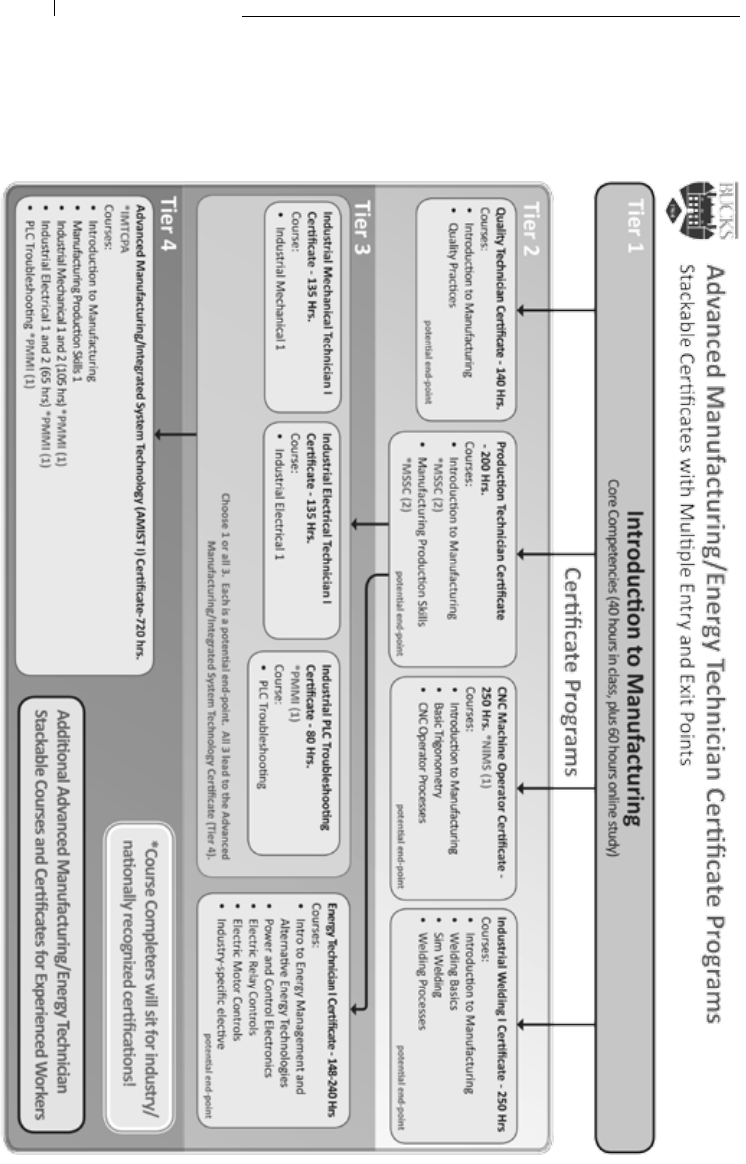
144 Chapter Nineteen
Figure 1.
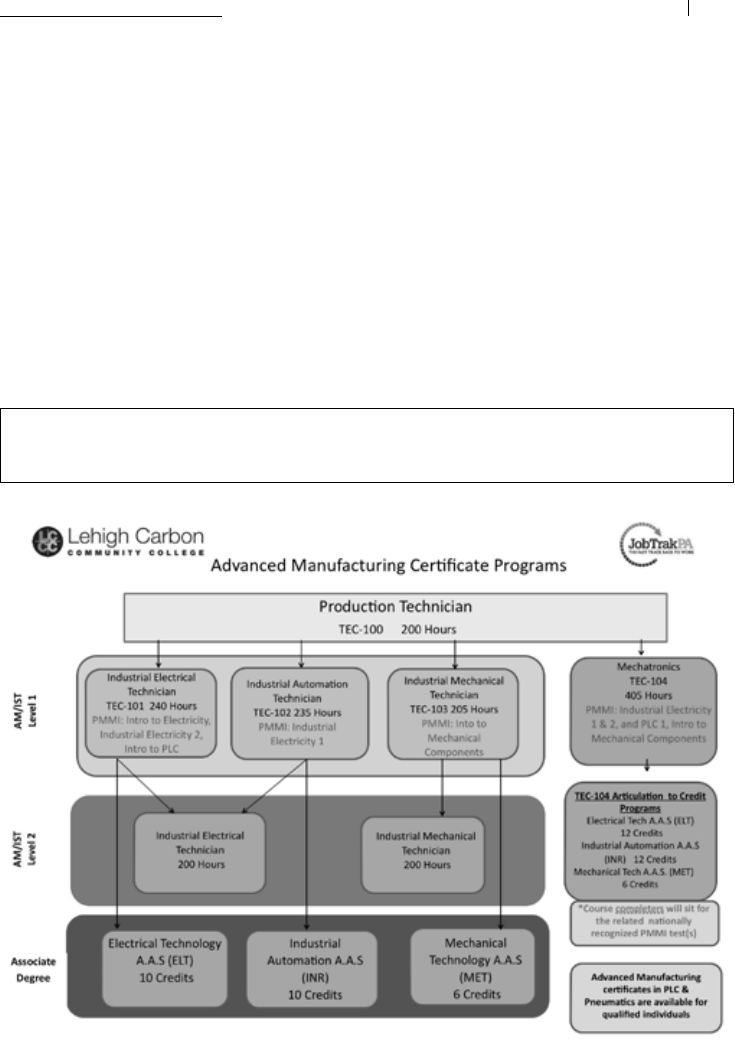
145
Manufacturing Workforce Development Playbook
ical Technician; Electronics Technician; Automaon Technician; Mechatronics Technician;
Industrial Instrument and Controls Technician; CNC Machine Operator; Precision Machine
Operator; Assistant Machine Operator; Welder; Fabricator; and General Maintenance and
Repair Workers. Because we ulize industry-sponsored and recognized credenals as the
basis of our courses, it reduces the need for customizaon when we begin working with
a new customer. The exibility that comes with stackable credenals allows us to address
the special needs of employees at various levels of their careers and of manufacturers who
have diering needs because of the parcular type of manufacturing they do (machine
shops, pharmaceucals, etc.)
Editor’s Note:
Emily menons other similar models in her chapter. Following are three variants.
(Above) Lehigh Carbon Community College has parallel paths leading to industry credentials and/or one
of three associate degrees. Stacking may be done for single-craft (electrical, mechanical) or multi-craft
(mechatronics) technicians.
“This workforce soluon was funded by a grant awarded by the U.S. Department of Labor’s Employment and Training
Administraon. The soluon was created by the grantee and does not necessarily reect the ocial posion of the U.S. Department
of Labor. The Department of Labor makes no guarantees, warranes, or assurances of any kind, express or implied, with respect
to such informaon, including any informaon on linked sites, and including, but not limited to accuracy of the informaon or its
completeness, meliness, usefulness, adequacy, connued availability or ownership.”
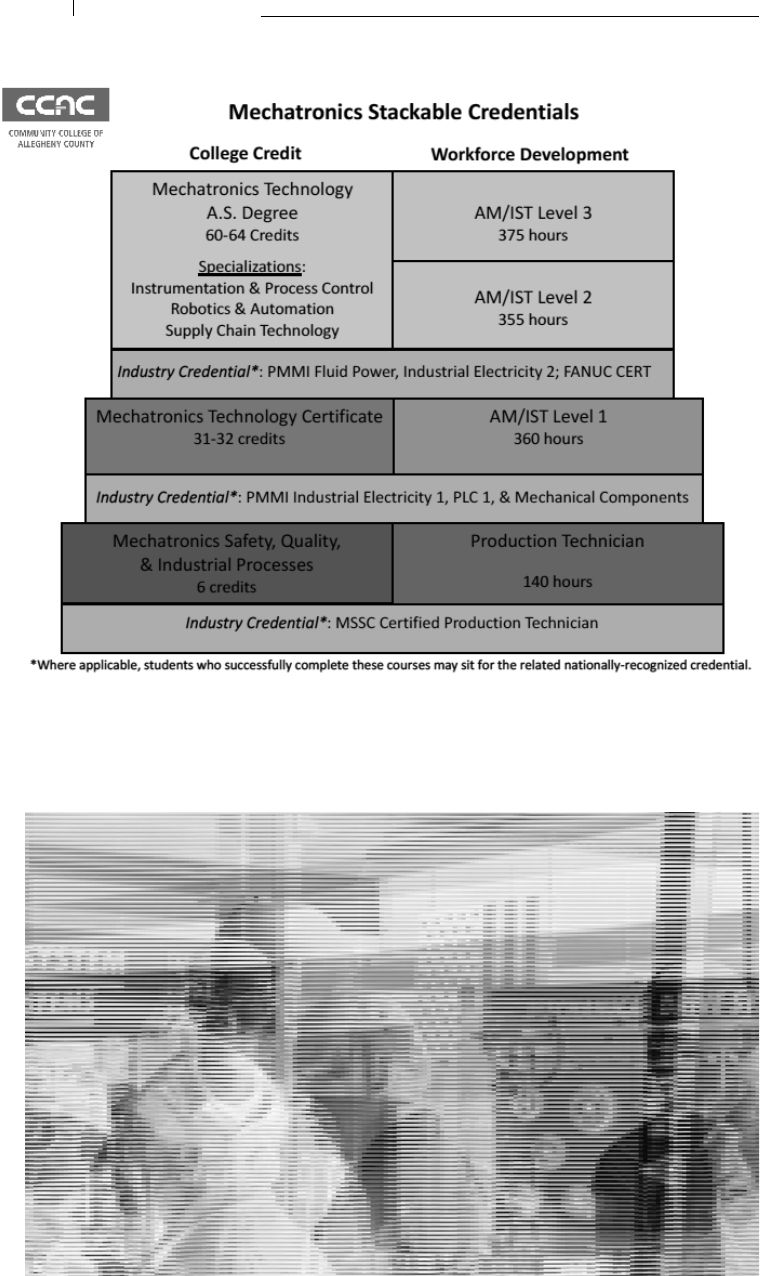
146
(Above) Community College of Allegheny County has parallel tracks for credit and non-credit, teaching
the same skills and providing the same credentials. President Obama and Vice-President Joe Biden
(below) recently toured the program, calling it a model for the nation.
Photo courtesy of CCAC and Joe Appel Photography.
Chapter Nineteen
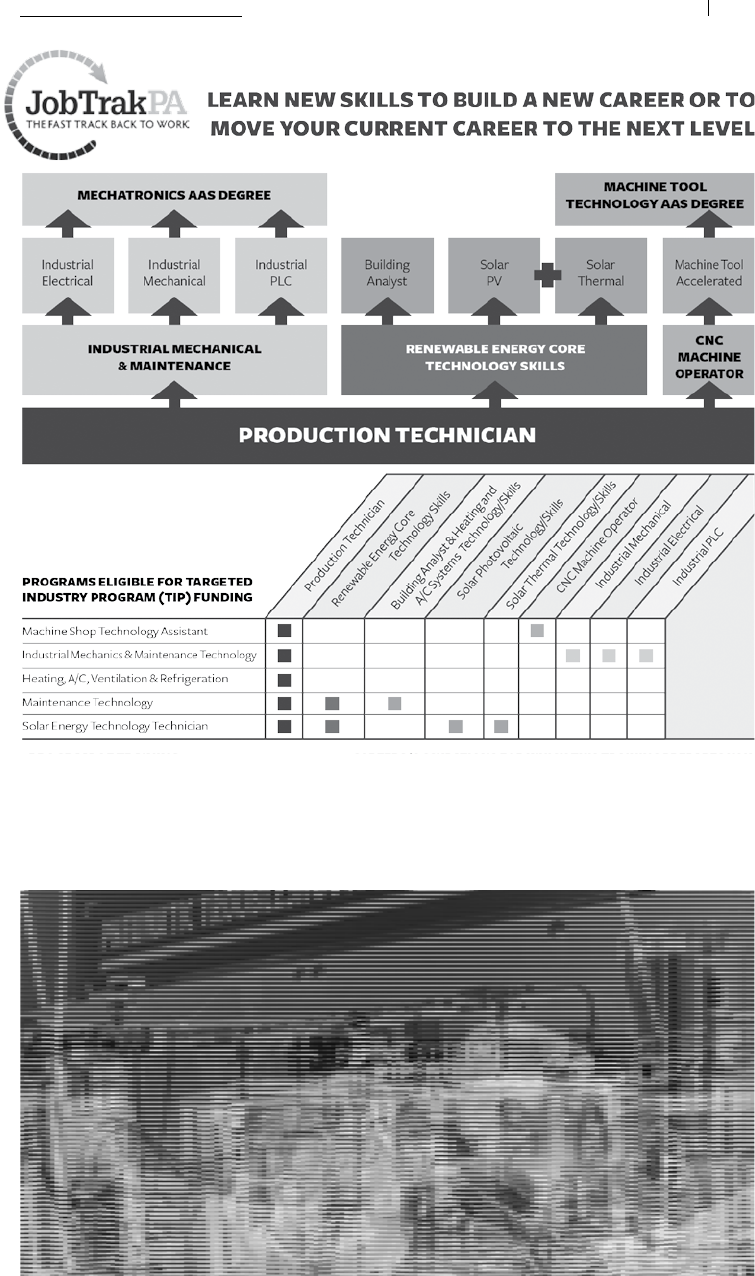
147
Manufacturing Workforce Development Playbook
(Above) Reading Area Community College offers multiple pathways to satisfy different industry
segments, leading to credentials or associate degrees. On the same day that the President visited
a community college in the Western part of PA (p. 146), Governor Corbett and Labor & Industry
Secretary Julia Hearthway were visiting a similar program further to the East at RACC (below).

148
I
have visited Central Piedmont Community College (CPCC) on at least two occa-
sions and toured the two manufacturing labs that are described in this chapter. I
have worked with sta members of Chris Paynter’s on test development projects,
though I do not know him personally. CPCC’s story is a signicant one, and who
beer than the Dean to tell it?
Chris is the Dean for Science, Technology, Engineering, and Mathemacs (STEM)
at Central Piedmont Community College (CPCC) in Charloe, NC, where he works to
support the workforce development mission of the college.
To expand the advanced manufacturing sector in Charloe and the surrounding
region, Chris works closely with local industry to develop strategies that create a
skilled workforce pipeline. A part of this strategy is to administer state-approved
apprenceship programs such as Apprenceship Charloe and Apprenceship
2000, which model the best pracces of German vocaonal training. Addional-
ly, STEM at CPCC maintains ABET and NIMS accreditaon in several technical pro-
grams and aligns program outcomes to industry cercaons such as SMSCP, Cisco,
CompTIA, PMMI and MSSC.
Widely traveled, including more than 30 countries across six connents, Chris
lived for three years in Singapore before moving to Charloe, where he aended
CPCC as a college transfer student. During his free me he enjoys playing with
daughter Ella, running, camping, hiking, and gardening.
Chris Paynter,
Dean of Science,
Technology, Engineering,
Mathematics - Central
Piedmont Community
College
The ability of a region to supply a skilled workforce is a key component of
a company’s decision-making process when trying to locate a site for a
new manufacturing plant. Economic development planners have become
much more aware of the importance of their educational infrastructure
as they promote their region to manufacturers. On the other side, I
have seen one company abandon an attempt to reopen a steel mill for
lack of enough adequately skilled maintenance workers. Community
and technical colleges play an increasingly important role in a region’s
economic success. The Charlotte, NC, area has been notably successful
in expanding its manufacturing segment, attracting a number of German
companies to the area. Central Piedmont Community College has had
a pivotal role in this success. German and American companies tend to
have somewhat different expectations of their employees, a situation that
is rooted in the differences between the German and American secondary
education systems. There is also some debate about whether what the
Germans refer to as “apprenticeship” should really be translated as
“internship.” Whatever we call it, Central Piedmont has collaborated
with industry to put in place programs tuned to the needs of
both German and American manufacturers.
Chapter Twenty

149
Manufacturing Workforce Development Playbook
M
anufacturing thrives today in the U.S. because of advanced automaon technology.
In industries such as durable goods, consumer products, medical devices, pharma-
ceucals, and electronics, automaon systems have created an environment in which fewer
employees than ever before produce a high volume of superior-quality products.
The Charloe, NC, region has seen remarkable growth in the manufacturing sector. The
region’s climate, infrastructure, and proximity to major markets serves as a magnet for
European and Asian companies looking to create a manufacturing presence in the U.S. Also
heavily represented in the area are American-based manufacturers, large and small.
More than 20 years ago, this melng pot of manufacturing began to experience the prob-
lems associated with workforce skills lagging behind automaon technology. The days of plac-
ing a help-wanted adversement and nding job candidates ready to hit the ground running
seemed to be ending. A more proacve approach was needed to nd skilled employees. A
number of German-owned manufacturing organizaons, with a strong tradion of secondary
school workforce development and apprenceships, began to discuss among themselves
ways of creang a similar “European-style” pipeline of skilled workers in North Carolina.
Fast forward 20 years. Today the local manufacturing community and Central Piedmont
Community College administer a number of successful workforce iniaves, some modeled
aer the European style and some not, that are helping to solve the manufacturing tal-
ent-pool problem. Similar programs tailored to local needs could be replicated in every area
of the U.S. The only requirement is a core group of manufacturers willing to invest me
and energy in a regional workforce development eort and a local community college with
technical training resources available to partner with them.
Apprenticeship 2000 – First Steps in Creating a Talent Pipeline
As stated above, a small group of German rms with manufacturing locaons in the Char-
loe area collecvely began to discuss the need to steadily bring young, movated, and
skilled workers into their plants. The core group eventually expanded to include Ameritech,
by Chris Paynter
21st Century Manufacturing
Success Depends on Automation
Technology and a Skilled
Workforce
Creating a high-tech pipeline
for Charlotte businesses.
Chapter Twenty

150
Blum, Chiron, Daetwyler, Pfa, Sarstedt, Siemens, and Timken. Representaves of the group
approached Central Piedmont Community College, which was recognized for its educaon-
al programs in mechanical and electrical elds.
Manufacturers and educators conducted extensive discussions on what skills were
needed in the short and long term for the manufacturing health of the area, including how
much hands-on training would be necessary at the plant and how much and what kind
of educaon would be needed at the community college level. The outline of a formal
apprenceship program began to be mapped out with elements stretching all the way from
recruitment to employment. The North Carolina Department of Commerce joined the dis-
cussion. A formal European-style apprenceship was launched and included:
• A coordinated, thorough recruitment process by the manufacturers of regional high
school juniors
• A year of paid work study—a few hours per week—for high school seniors to work and
study in the plants
• Four years of paid work study at the plants and at Central Piedmont Community Col-
lege, leading to an Associate in Applied Science Degree in Mechatronics
o
Mentors at the employers monitor each apprence’s training and progress
throughout the program
• An apprenceship cercaon from the North Carolina Department of Commerce
• Opportunity to acquire industry cercaons, including PMMI electrical and mechani-
cal and Siemen’s Mechatronic Levels 1 and 2
• Guaranteed salary, including benets, upon successful compleon of the program
• College costs paid by the employers
In 1996, the rst apprences entered the program. On the job, they received training and
mentoring. One day and one evening per week they aended classes at the community
college. This program has evolved over me, and today the Mechatronics Engineering Tech-
nology curriculum at Central Piedmont Community College provides the apprences with a
basic background in mechanical, electrical, CAD, basic computer skills, safety, automaon,
programmable logic controllers, instrumentaon, hydraulics and pneumacs, mechanical
drives, variable frequency drives, motors and controls, and basic electricity. The extent of
the exposure in these topics depends upon the degree’s curriculum track.
The latest equipment is used to provide hands-on training. Two curriculum tracks are
available: the Mechanical Track and the Electrical Track. The Mechanical Track is structured
to enable the graduate to focus on the mechanical aspects of a manufacturing and system
design funcon, while gaining a solid understanding of its electrical funcon. The Electrical
Track perspecve is focused on electrical and control aspects with a solid understanding of
mechanical components and their principles.
The rst apprences graduated in 2000, hence the name Apprenceship 2000. Each ap-
prence in the program logged 8,000 hours of hands-on work and training. Today, there are
about 100 apprences total in the four-year program with 25 apprences in each year’s class.
Chapter Twenty

151
Manufacturing Workforce Development Playbook
Since the rst class graduated, the school has connuously evaluated and improved its
automaon lab facilies. Today there are two labs at the school, the Integrated Systems
Technology Lab and the Mechatronics Engineering Technology Lab. Together these facilies
represent a more than $2 million investment in state-of-the-art hands-on learning systems.
Computer-based simulaon is delivered alongside mechanical, electrical, hydraulic, and
pneumac systems. Apprences work individually and in teams to perform lab exercises in
troubleshoong, repair, and maintenance of the equipment.
The Mechatronics lab provides a systems approach to automaon and is heavily used by
the apprences. The lab features Festo Didacc learning systems, which closely align with
the skills employers asked for. Festo Didacc and the college have an ongoing collaborave
relaonship to ensure the right systems are in place to meet the ongoing needs of the local
manufacturing community.
The Festo Didacc systems for the lab include an MPS-500, which is a modular produc-
on system trainer consisng of six staons around a conveyor, all of which demonstrate
common operaons found in industry (i.e., part sorng, tesng, assembly). The staons
are constructed from 10 training modules that can be separated, allowing for focused
analysis. The school also installed a Didacc ProLog Factory, a logiscs training system
ulizing a Robono mobile learning system with handling assistant. This system demon-
strates autonomous materials handling as well as other autonomous vehicle principles. The
third component is a Didacc MPS PA, a process control simulator. These systems are highly
integrated and complex, where students develop the ability to read documentaon and to
troubleshoot. The lab also features both Fanuc and Mitsubishi robots. Funding for the labs
comes from public and private grants.
Blum, one of the founding member companies, reports that it retains about 80% of its
apprences. About 10% of those in the program take addional classes and 7% graduate
and move on to a four-year degree. Blum has a tuion reimbursement policy for its employ-
ees. The company has seen a rise in producon eciencies in the areas where apprence
graduates work.
Overall the apprenceship companies nd a close match with the skills that are being
taught and the skills they need today. Interesngly, the employers report that the skill level
of the apprences is comparable to or higher than that of apprences in Europe.
Apprenticeship Charlotte
In 2012, Central Piedmont Community College launched Apprenceship Charloe to
accommodate the increasing interest among local manufacturers to implement apprence-
ship programs. Apprenceship Charloe provides a customizable approach to implement-
ing apprenceship programs. In this program, the Central Piedmont Community College
assists employers in tailoring an apprenceship program to their parcular business needs
and work closely with employers from the inial interest stage through full implementaon.
This typically includes all stages such as student recruitment and iniang contact with
the North Carolina Department of Commerce and the registered apprenceship process.
In keeping with a customizable approach, Apprenceship Charloe is designed to recruit

152
a broader range of students than high school seniors. There are mulple entry points for
Apprenceship Charloe, including high school graduates, veterans, and current employ-
ees of parcipang companies. Given this approach, apprences in this program are more
varied in age and background than the high school seniors in Apprenceship 2000 and
are more representave of the workforce as a whole. Apprenceship Charloe students
receive much of their training in the Integrated Systems Technology lab where PLCs, servos,
pneumacs, and other technologies are taught as units. The Amatrol learning systems in
this lab map to PMMI cercaons. Depending on the goals of the employer, students also
have access to the Mechatronics lab and that lab’s systems approach.
Employers in the Apprenceship Charloe program agree to on-the-job learning from one
to ve years. Each year in the program the apprence spends 144 hours in academic training,
and progressive wage scales are based on aainment of skill levels. Some of the companies in
the Apprenceship Charloe program are Siemens, Bosch Rexroth, and Daimler.
With Apprenceship 2000 and Apprenceship Charloe, the manufacturing community
and Central Piedmont Community College created the crical mass needed for automaon
training. Without this structure, it would have been exceponally dicult to secure the
grant funding for the two well-stocked hands-on labs.
Regional employers that are not interested in apprenceships but want to improve the
automaon skills of employees can work out a exible me to use the labs and the com-
puter-based curriculums. These employers and the school devise a modular approach to
training where only those modules—say PLC programing, pneumacs, servos, or variable
frequency drives—are taught. For example, one of the area’s major food companies is
upgrading a number of its producons lines. The company is sending a signicant number
of employees to learn new skills in the Integrated Systems Technology Lab. The comput-
er-based curriculum oers exibility in scheduling me in the lab—a exibility that accom-
modates the plant’s work schedule.
Open Enrollment
Tradional and non-tradional students not aliated with any parcular employer also
enroll in the college for the Mechatronics and other manufacturing-related programs and
tracks. These students have the opon of degrees, cercates, and cercaon training.
Each of these students does a mixture of classroom and hands-on lab work. Most if not all
of the degree students in the Mechatronics program receive job oers before graduaon.
College administrators and sta know that the curricula are providing an opmum skill set
because of the ongoing input and feedback of the manufacturing community. Representaves
from manufacturers, department of commerce, and school meet quarterly to ensure that
needs are being met and that programs connue to evolve as automaon progresses.
Central Piedmont Community College has an outreach program to other community
colleges, providing the kinds of informaon they can take back to their constuencies about
Mechatronics training. During these outreach meengs, educators realize that to ensure
successful programs, the acve involvement of a local group of manufacturers is essenal.
Chapter Twenty
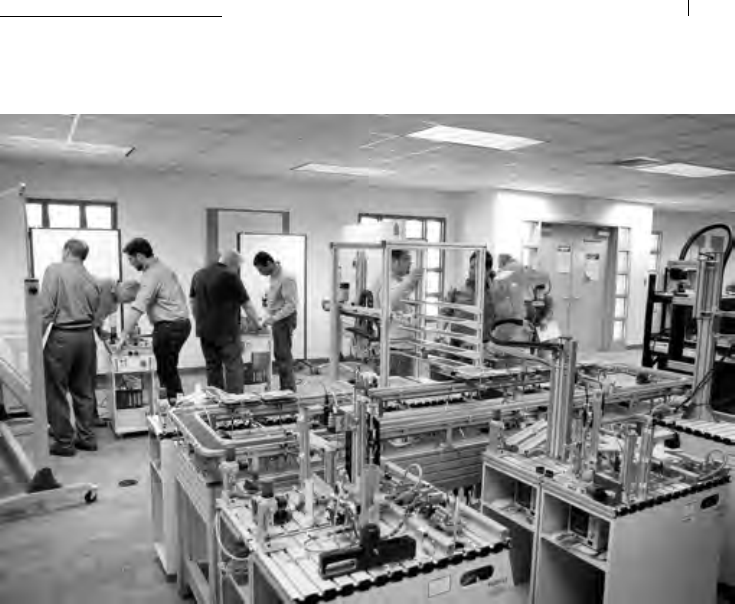
153
Manufacturing Workforce Development Playbook
These manufacturers do not have to be focused on apprenceships, or degrees, or cer-
caons. They must instead come together to determine:
• The skills they think cross company lines and are vital to the workforce of tomorrow—
foundaonal automaon skills
• Determine how many of their own employees they will put through training at the
community college on an ongoing basis
• Make a commitment to regularly meet with the school to discuss training needs and
evaluate outcomes
• Outreach to schools and other local organizaons with the message that it is vital to the
community to have a vibrant manufacturing foundaon and that employees with basic
skills are needed to make this happen
With this local commitment, the community colleges can hire sta, ll classes, and begin
the process of grant wring and development that will lead to state-of-the-art learning sys-
tems such as those oered by Festo Didacc. This type of partnership between the school,
local manufacturers, and many mes state agency personnel builds a foundaon—a crical
mass—of training that begins to sustain itself. It creates a pipeline of skilled workers who
know automaon. In the process, it creates the infrastructure for manufacturing growth
now and into the future.

154
W
hen word came from PMMI to my associates and me that a BS in Mecha-
tronics Engineering Technology was being developed at Purdue Calumet,
it wasn’t long unl I had the good fortune to meet Dr. Niaz Laf. As hard
as new programs are to start at the community college level, there are even bigger
obstacles to overcome at a major university. Dr. Laf was taking these on one by
one, and before we knew it, the program became operaonal.
Dr. Laf is the Dean of the College of Technology at Purdue University Calumet
(PUC). His academic career began as an instructor of engineering at Louisiana
State University-Eunice and then he served as an Assistant and Associate Profes-
sor at Northern Kentucky University. In 1999, he was appointed as the Professor
and Head of the Department of Industrial Technology at Purdue University, West
Lafayee and later served as an Assistant Dean for Statewide Technology Adminis-
traon in the College of Technology. In 2007, he joined Purdue University Calumet
as the Dean of the College of Technology. Dr. Laf is responsible for overseeing
eight undergraduate degree programs, which includes a new BS degree program
in Mechatronics Engineering Technology, and three graduate programs in the col-
lege. He has received grants from the Naonal Science Foundaon and the U.S.
Department of Labor for projects related to workforce development in advanced
manufacturing. Dr. Laf earned his Ph.D. from the University of Missouri—Colum-
bia and an M.S. from South Dakota State University (SDSU) in Agricultural Engineer-
ing. He received his B.Sc. in Mechanical Engineering degree from the University of
Chiagong, Bangladesh. He has authored/co-authored numerous refereed journal
arcles and peer-reviewed conference proceedings arcles and also served as the
Editor-in-Chief of the Journal of Engineering Technology.
Dr. Niaz Latif,
Dean of the College
of Technology, Purdue
University Calumet
Many believe that there is insufcient focus on engineering technology
in American universities. Our focus on engineering science leads to our
being more theoretical and less practical; able to invent, but not to apply
new technology. We are seeing an increase in the number of associate
degree programs being started in areas like industrial maintenance,
mechatronics, and machine tool technology, but we are not seeing a
signicant increase in four-year programs in this area. Purdue Calumet
has been an exception, having started a BS Degree Program in
Mechatronics Engineering Technology, at the specic request of
and for the support of manufacturers.
Chapter Twenty-one

155
Manufacturing Workforce Development Playbook
by Dr. Niaz Latif
P
urdue University Calumet introduced its mechatronics engineering technology bacca-
laureate degree program in 2008 to meet the need for trained technologists to design,
build, and service the type of complex, high-speed machinery used in the packaging indus-
try. The program combines instrucon in electrical control and mechanical design and pro-
vides students with exposure to programmable logic controllers (PLCs), conveyor systems,
machine vision and servo motors, control and sensor logic, as well as other technologies and
various industry standards, with a primary focus on packaging machinery technology. The
program prepares students for such jobs as machine designers, packaging engineers, auto-
maon specialists, and service technicians in the growing eld of high-speed packaging.
How it got started
It all started with one faculty member’s longme involvement with the packaging industry.
This involvement created a mutual awareness of industry workforce needs and opportu-
nies available at an academic instuon to meet such needs. This is where Nick Wilson,
President of Morrison Container Handling Soluons, entered the picture. Located just
across the Illinois/Indiana border in Illinois, Wilson met with faculty members in the College
of Technology and acvely promoted the advantage of an academic program that would
produce such a workforce. The basis for creang such a program was that: 1) there is a
serious need for employees with competencies in electrical, mechanical, automaon, and
control, and 2) no instuons in the region were addressing this specic need. The packag-
ing machines used in this industry are usually custom-designed mechanical systems inte-
grated with OEM electrical control products to achieve system integraon for product ow
and packaging (e.g., six water boles wrapped with clear plasc). Such systems require
technologists with knowledge in automaon, controls, and mechanical design.
To iniate the curriculum process, a team was formed consisng of packaging industry
professionals and faculty members with experse in mechanical, electrical, controls, and
automaon. Wilson, meanwhile, arculated the importance of such a team to his peer
A New BS Degree Program:
Mechatronics Engineering
Technology is a University
Success
Universities are slowly seeing the need for applied
science programs.
Chapter Twenty-one

156
group at PMMI and convinced these industry professionals to parcipate in the curric-
ulum development process. The curriculum was adjusted and became more relevant to
industry. The students gain knowledge in the following areas: 1) Computer Hardware
and Electric Circuits; 2) Electrical Power and Machinery; 3) Computer Aided Design and
Manufacturing; 4) Manufacturing Processes; 5) Process Control; and 6) Producon Design
and Specicaons. The program descripon and the plan of study are available at Purdue
University Calumet’s Department of Engineering Technology website at hp://webs.
purduecal.edu/et/eng-tech/mtb-degree/.
Industry-education partnerships
The iniave to develop and implement the Mechatronics Engineering Technology program
was a response to the regional packaging machinery industry’s expectaon from the univer-
sity and its leadership. The challenge was to arculate the need and juscaon for such a
program to the instuon and ulmately to the commission of higher educaon. Not only
was it important to show industry support for the program, but also to show documented
commitments from industry to sustain the program. The program was launched in 2008
and is being sustained by the generous support from industry in areas of curriculum devel-
opment and enhancement, laboratory development, and internship/experienal learning
for students. Of all the industry partners, six key industry partners have been signicantly
involved with the program. Out of these six partners, three are system integrators, two
are OEM products manufacturers, and one is Summit Media Group, parent company of
Packaging World, the leading business-to-business magazine in the packaging space. Repre-
sentaves from these six partners serve on the mechatronics program advisory board and
promote the program at the regional, naonal, and internaonal levels. These industries
provide internships to our students, and they sponsor funded design/development proj-
ects. They have also provided state-of-the-art industry-standard equipment for laboratories
and signicant technical help through their full-me technical personnel.
The industry and educaon partnerships have resulted in the establishment of two state-
of-the-art laboratories for the program and opportunies for paid internships for students
in the program. The laboratories in the Mechatronics Engineering Technology program of-
fer hands-on experience in both the electrical and mechanical areas of designing, installing,
and troubleshoong the complex equipment that produces and packages items that con-
sumers purchase daily. Students learn advanced programming techniques, interfacing auto-
mated equipment, sensor design, machine design, and troubleshoong in these labs. Total
industry support for this lab exceeded $1 million, and specic equipment donaons were
received from the OEMs and the system integrators (the packaging machinery industries).
Some of the equipment donated includes a high-speed digital camera, labeling machine,
photoeye, conveyors, automaon equipment, lab simulator, inverter machine, PLCs, motors
and drives, HMIs, and two complete packaging systems from two companies.
Support from professional organizations
The naonal professional associaon PMMI has been an integral partner from the very
Chapter Twenty-one

157
Manufacturing Workforce Development Playbook
beginning of the program development. In fact, their parcipaon has enhanced the
curriculum that is aligned with the competency levels in mechatronics as endorsed by the
U.S. Department of Labor, hp://www.careeronestop.org/CompetencyModel/pyramid.
aspx?ME=Y. PMMI has provided scholarships for students every year, supported travel to
Pack Expo (the annual trade show) for faculty members and students, and provided funding
through their educaon foundaon. PMMI regularly promotes the program through their
naonal and internaonal outreach. PMMI has provided training and technically relevant
support for the faculty members and students in the program. PMMI has also provided
visibility for the program through arcles in the trade press and exposure at their technical
conferences.
Program growth and student success
The BS in Mechatronics Engineering Technology program has grown signicantly in recent
years, from 17 students in spring 2013 to 61 students in spring 2014. Every year during the
2009-2012 period, students from the program parcipated at the naonal design compe-
on sponsored by PMMI, winning within the top three places. The projects usually involve
a packaging line problem in which the soluon must take into account the environmental
impact, energy consumpon, ease of use, and cost consideraons. This learning beyond
the classroom provided students with the opportunity to solve real-world problems. The
parcipaon by students in the naonal design contest has promoted the program at the
naonal level. It has also allowed students to visit with the potenal employers for net-
working, and to understand the types of jobs and job opportunies available in packaging.
All team members felt the knowledge learned and the experience of seeing their future
careers in front of them was very rewarding. Industry also learned about the program, as
evidenced through several requests received by the program (aer Pack Expo) for student
interns and graduates for full-me jobs.
Workforce development in advanced
manufacturing-Mechatronics Technicians
Aer the implementaon of the BS degree program, faculty members in the College of
Technology received two Naonal Science Foundaon (NSF) grants to enhance the mecha-
tronics-related courses and adopt modularized and alternave delivery of the courses to
benet the employees of the industry. The rst NSF grant, entled “A Mechatronics Cur-
riculum and Packaging Automaon Laboratory Facility,” supported connued research and
development of the courses and facilies within the new Mechatronics Engineering Tech-
nology program at Purdue University Calumet. Five courses were signicantly enhanced to
implement the latest in high-speed automaon equipment. In these enhanced courses,
students experience an environment that is similar to that which is typically encountered in
an entry-level job in the mechatronics eld.
The second NSF project, entled “Meeng Workforce Needs for Mechatronics Techni-
cians,” has been a partnership among three universies and colleges—Purdue University
Calumet, College of DuPage (IL), and Ivy Tech Community College—and the packaging indus-

158
try. The packaging machinery industry provided the commitment for experienal learning
opportunies for all parcipants during the three-year project period. The project involved
the course augmentaon and modularizaon, as well as the integraon and innovave deliv-
ery of experienal learning within the courses, enabling students to apply their knowledge.
Based on these successes with federal grants, the program recently (2013) received a
$2.74 million U.S. Department of Labor grant entled “Project: AWAKE: Assisng Work-
force by Advancing Knowledge for Employment” hp://webs.purduecal.edu/technology/
awake/. Three hundred parcipants are to be trained and cered with stacked and laced
credenals (Mechatronics Cercaons) developed by PMMI hp://www.pmmi.org/
Educaon/content.cfm?ItemNumber=1010&navItemNumber=1061. The objecves of
the project are: 1) to provide foundaonal skills and competencies in two similar occupa-
ons—Mechatronics Technicians and Industrial Machinery Mechanics—through developing
modularized training and delivering the program at remote locaons; and 2) credenaling
the parcipants through industry-recognized (PMMI) cercaons at four competency lev-
els as endorsed by the U.S. Department of Labor. The cercates are Industrial Electricity-1,
Industrial Electricity-2, Programmable Logic Controllers-1, and Mechanical Components-1.
The project also provides career pathways through granng college credits of up to 12
hours toward associate degrees in Ivy Tech Community College in Indiana. The 21-week
training is to be 16-hours per week (four hours/day and four days a week) and an addional
four weeks of internship in the manufacturing industry. Individuals already working in a
manufacturing-related industry will not need to go through the four weeks of internship,
therefore the training will be 21 weeks.
Chapter Twenty-one

159
Manufacturing Workforce Development Playbook

160
A
s I became more involved in industrial maintenance and mechatronics, the
name Kevin Craig came up as one of the leading academics in mechatronics in
America. At the me, he was a faculty member at my alma mater, RPI. We later
shared the podium at several events, he presenng from a university perspecve and
I from a workforce and community college perspecve.
Kevin graduated from Xavier, a Jesuit high school in New York City. He aended
the United States Military Academy at West Point, NY, played 1st-team varsity football
and baseball, and graduated with a B.S. degree and a commission as an ocer in the
U.S. Army. He later aended Columbia University and received the M.S., M.Phil., and
Ph.D. degrees. While in graduate school, he worked in the mechanical-nuclear design
department of a major engineering rm in New York City and taught and received
tenure at both the U.S. Merchant Marine Academy and Hofstra University. In 1989,
he joined the faculty at Rensselaer Polytechnic Instute. At RPI, he further developed
his leadership and administrave skills working directly for the dean of engineering as
Director of Core Engineering and as Chair of the Engineering Science Interdisciplinary
Department. As a tenured full professor of mechanical engineering, he taught and
performed research in the areas of mechatronic system design and the modeling,
analysis, and control of muldisciplinary engineering systems. With signicant con-
nuous funding from both industry and government, he developed the Mechatronics
Program at Rensselaer, which included an extensive teaching and research laboratory
and several undergraduate and graduate courses in mechatronics.
Since 2007, he has wrien a monthly column on mechatronics for praccing engi-
neers in Design News magazine. Over the past 15 years, he has conducted hands-on,
integrated, customized, mechatronics workshops for praccing engineers naonally
and internaonally. He is a Fellow of the ASME and a member of the IEEE and the ASEE.
He was chosen in January 2008 to be the Robert C. Greenheck Chair in Engineering
Design, a $5 million endowed chair, at Marquee University. His mission is to inte-
grate muldisciplinary design and discovery learning throughout the enre college, in
all years and in all departments. He has transformed students, faculty, curricula, and
facilies throughout the college and created a new engineering educaon mindset
and culture for innovaon. He was given the 2013 ASEE North-Midwest Best Teacher
Award and the 2014 ASME Outstanding Design Educator Award.
Chapter Twenty-two
Dr. Kevin Craig, Ph.D,
Greenheck Chair in
Engineering Design, and
Professor, Department of
Mechanical Engineering,
College of Engineering,
Marquette University
Preparation of engineering scientists tends to be done in silos: electri-
cal, mechanical, civil, etc. Yet on the shop oor, we are training workers
to be multiskilled, and our newest machines are mechatronic in nature,
meaning that the design was an integrated effort amongst electrical,
mechanical, controls, and computer disciplines. While other countries
have embarked upon a more integrated and systems-oriented education,
in the U.S. there is only occasionally a course or two offered on mecha-
tronics at the undergraduate level, or you may nd programs at
the post-graduate level. This chapter makes the case for changing
engineering science education to be more responsive to the
needs of society, including manufacturing.

161
Manufacturing Workforce Development Playbook
by Dr. Kevin Craig, Ph.D.
Chapter Twenty-two
B
ackground and Motivation
It is widely recognized that the future of the U.S. is increasingly dependent on scien-
c and technical innovaon. However, the U.S. is in an innovaon crisis parally fueled by
a crisis in engineering educaon. The Naonal Science Board of the U.S. has stated that a
connuaon of the status quo in engineering educaon in the U.S. is not sucient in light
of the changing workforce demographics and needs. The innovaon shorall of the past
decade is real, and there have been far too few commercial innovaons that can transform
lives and solve urgent human problems. Society’s problems are geng harder, broader, and
deeper, and they are muldisciplinary in nature. They require a muldisciplinary systems
approach to solve them, and engineers, as the solvers of these problems, need to under-
stand the impact of their soluons in a global context. Sustainability—the ability of one
generaon to meets its needs without compromising the ability of future generaons to
meet their needs—has three dimensions: economic, environmental, and social. Key tenets
of sustainability include intelligent use of resources, improvement of the quality of life, and
lessening the environmental impact.
Manufacturing Engineering:
Innovation through Model-Based
Design and Integration
A look at engineering science education
for manufacturing and beyond.
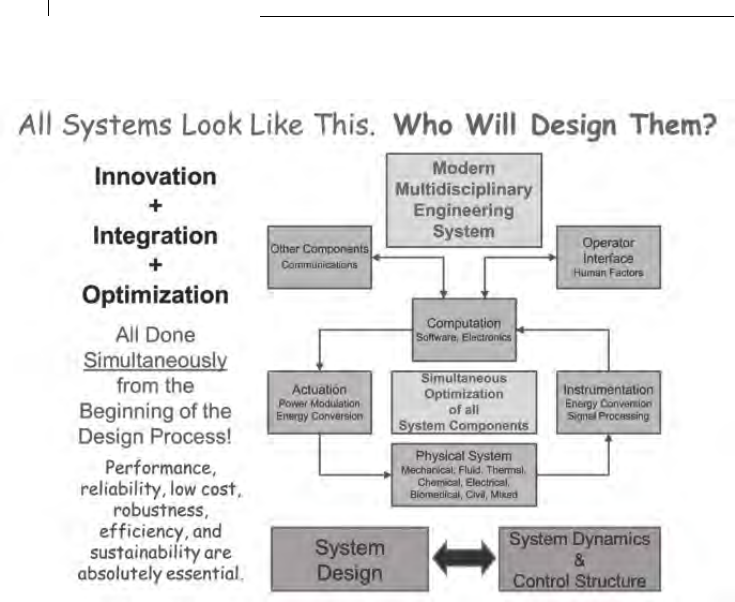
162
Perhaps as a result or as a cause of this shorall, basic STEM (science, technology,
engineering, and mathemacs) skills are viewed as separate commodies that can be
outsourced. Other countries have a compeve advantage in low-cost manufacturing and
services, with excellent commodity engineers, sciensts, and mathemacians available at a
fracon of the cost of their U.S. counterparts. To be compeve, U.S. engineers, sciensts,
and mathemacians must provide high value by being innovave, which includes being im-
mediate, integrave, conceptual, and muldisciplinary. In addion, innovaon is local—you
don’t import it and you don’t export it! You create it! Innovave soluons require a new
way of thinking, communicang, and doing; they must be human-centered, technologically
feasible, commercially viable and sustainable, usable from a complexity view, and sustain-
able in a global sense (see diagram above).
In engineering design we integrate. From the very start of the design process, we com-
bine the physical system with sensors, actuators, computer control, and human interfac-
es to give it some intelligence and decision-making capability. At its very heart, system
complexity is synonymous with power. However, this power can be for good or bad. If the
complexity in any system is not tamed, the consequences can be devastang. In a complex
system, learning how all the pieces, constant and variable, interact gives a depth of under-
standing that averts catastrophe. That is what we mean by human-centered design—under-
standing the interfaces among technology, people, communies, governments, and nature.
This is what makes complexity manageable.
All complex systems have, as a foundaon, fundamental principles or core knowledge
that cannot be ignored. Designers of these systems must have a good understanding
of those principles. However, on top of that there must be a exibility to respond to
Chapter Twenty-two
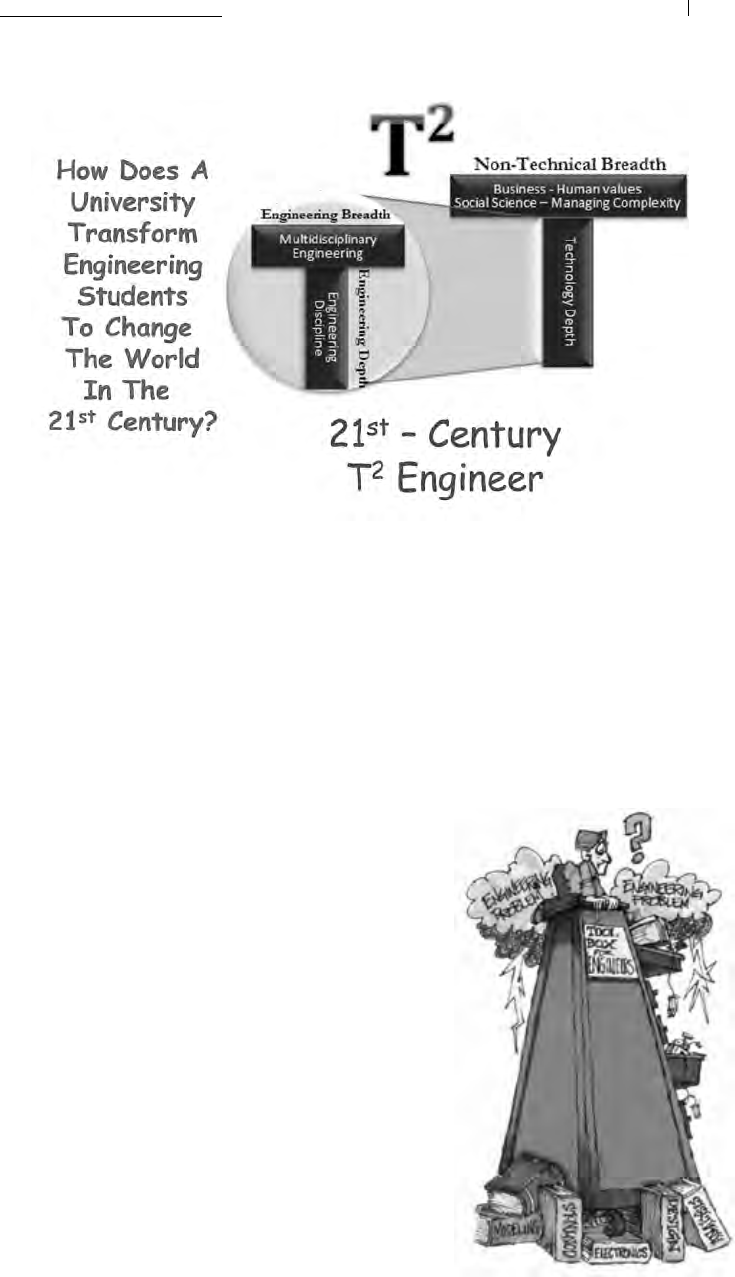
163
Manufacturing Workforce Development Playbook
the problems that inevitably arise. Clearly, the typical discipline-specic engineer is not
well equipped to manage such complexity; not even an engineer with muldisciplinary
engineering breadth can do an eecve job. Complexity demands a skill set illustrated by
the T2 Engineer (see diagram above): one with technology depth and also non-technical
breadth, specically human-centered design experse capable of managing complexity.
If a young person wants to be a complete baseball player, he must be able to eld, throw,
run the bases, hit, and hit with power, and all these
skills must be applied in an actual baseball game.
To achieve this goal, he learns all these skills at the
same me, improving gradually in each one while
playing actual games and, over me, develops into
a complete baseball player. The result is more than
just the sum of the skills learned, but a sense of
condence and savvy that makes him a winner.
In modern muldisciplinary engineering prac-
ce, the necessary skill set includes modeling and
analysis of muldisciplinary dynamic engineering
systems, control system design and implementa-
on, and sensors and actuators with the neces-
sary electronics. Theory and pracce must be in
balance when mastering these skills. If “playing a
game” means pung these together to create a
system to solve a problem, then that rarely hap-
pens in engineering educaon.
We devote separate courses to each skill and
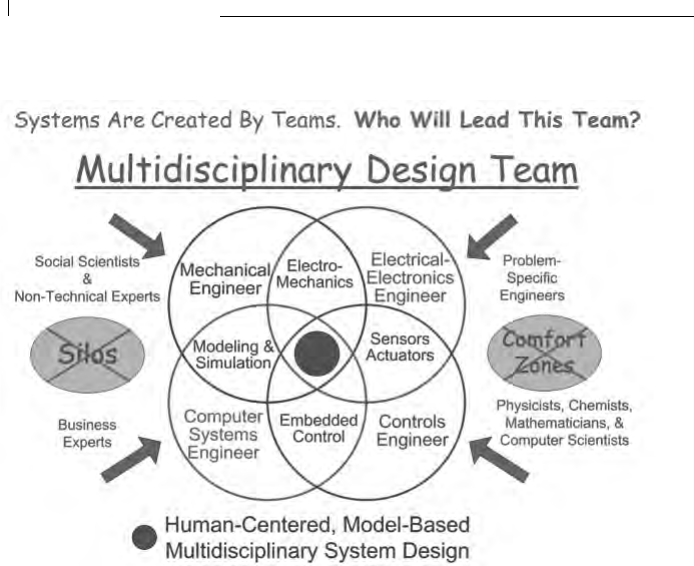
164
somehow think that learning each skill very well will somehow magically enable the
student to graduate and crically think, integrate it all, and solve a real-world problem.
This is true in both undergraduate and graduate engineering educaon. In the baseball
analogy, this would be uer madness, yet in engineering educaon, it is roune, and it
results in the situaon illustrated in the diagram above.
The present situaon then is that engineering educaon today is ineecve in pre-
paring students for muldisciplinary system integraon and opmizaon—exactly what
is needed by companies to become innovave and gain a compeve advantage in this
global economy (see diagram). While there is some movement in engineering educa-
on to change that, this change is not easy, as it involves a cultural change from the silo
approach to a holisc approach. The required senior capstone muldisciplinary design
course too oen becomes a design-build-test exercise, rather than a model-based design
exercise, with the emphasis on just geng something done. Students rarely break out
of their disciplinary comfort zone and thus fail to experience true muldisciplinary-sys-
tem, model-based design. What is needed are muldisciplinary systems courses, with a
balance between theory and hardware, between academic rigor and the best pracces
of industry, presented in an integrated way that prepares students for true muldisci-
plinary-system, model-based engineering at the senior level and beyond. This then needs
to be followed with an integrated graduate program that empowers praccing engineers
with the latest knowledge, skills, tools, and processes.
Modern mechanical engineering, which includes manufacturing engineering, now
includes engineering systems, in addion to tradional mechanics and thermal/uid engi-
neering. The courses need to be taught in the context of modern engineering pracce and
real-world problem solving following the Engineering System Design Process shown in the
Chapter Twenty-two
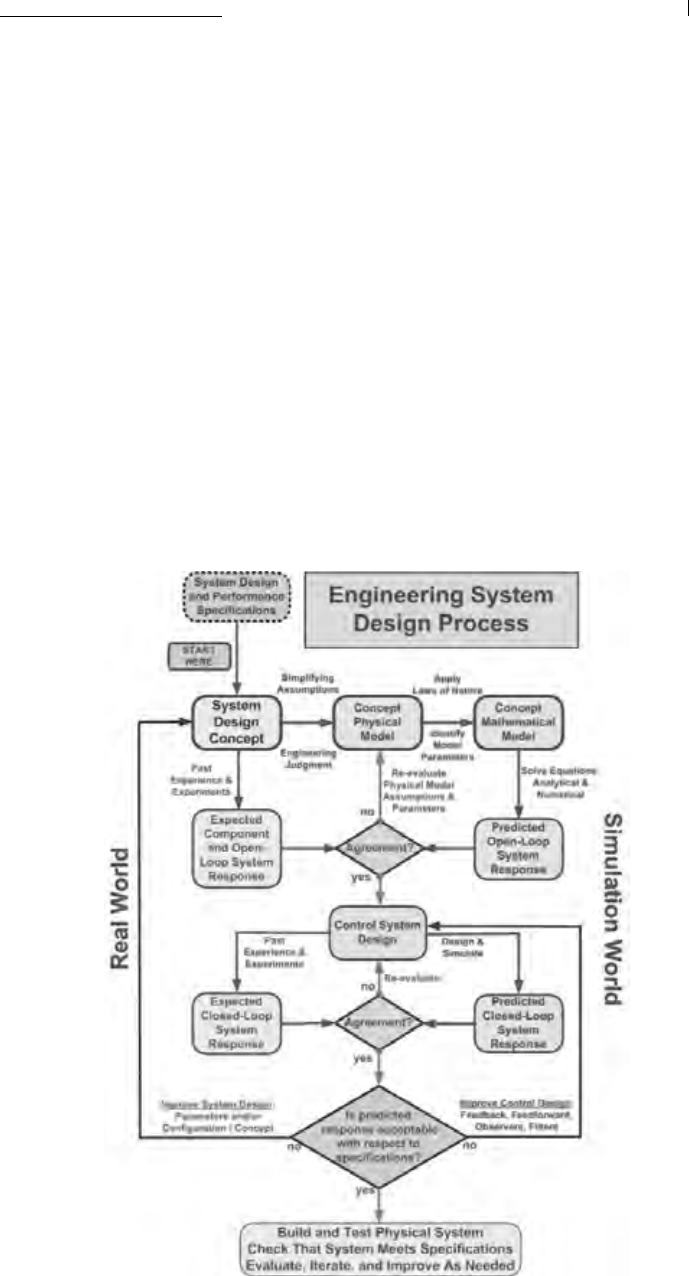
165
Manufacturing Workforce Development Playbook
diagrams below. The Engineering System Design Process provides an environment that is
rich with numerical and graphical analysis and design tools that smulate innovaon and
cooperaon within design teams. It aims to reduce the risk of not meeng the funconal
requirements by enabling early and connuous vericaon throughout the enre design
workow. The key concept in the courses is human-centered, model-based, muldisci-
plinary engineering problem solving. The key emphasis, in both classes and studios, is to
strive to uncover the quesons a student is asking himself/herself as he/she aempts to
solve a problem and then give him/her the insight and understanding, based on physical
principles and best industry pracces, to ask the right quesons.
Modern manufacturing engineering needs to embrace model-based design as the key to
innovaon. There can be no delay, as the rest of the world is recognizing the importance of
this approach and is gaining a compeve advantage.

166
M
y original outline for the Playbook did not consider issues of professional
workforce development beyond a bachelor’s degree. Jim George correct-
ly pointed out that, just as folks on the shop oor need ongoing develop-
ment, so does the sta closer to the top oor.
Jim is the Director of Educaon for the Instute of Packaging Professionals,
and his experience includes decades in publishing and 15 years in the packaging
industry. Jim was the founding editor of Shelf Impact!, a franchise focusing on
the markeng impact of packaging, the founding editor of Contract Packaging
magazine, and wrote on markeng and design and other topics for Packaging
World. Jim has led workshops on branding and package design, has been a speak-
er at numerous conferences, and also has organized a variety of packaging indus-
try conferences. In addion, Jim has served as a judge for many package-design
award compeons, and he has co-authored and edited packaging industry man-
agement reports.
Jim George,
Director of Education,
Institute of Packaging
Professionals
Chapter Twenty-three
Manufacturing workforce development must be ongoing for all
employees. Once good employees choose manufacturing as a career,
it behooves manufacturers to keep them and to help them grow and
improve. Many schools and professional organizations offer continuing
education programs. This chapter looks at the rationale for using these
programs, as seen from the Institute of Packaging Professionals.

167
Manufacturing Workforce Development Playbook
I
magine if the learning stopped. How dierent packaging would be. There would be
no modern conveniences that today we take for granted. No squeezable food tubes,
asepc pouches, or microwave dinner trays. Or channel-specic packaging to segment
target audiences or induce impulse purchases. Or e-commerce conveniences that enable
and encourage consumers to customize products and packaging to make their purchase
truly their own.
Everything would remain just as it was in your grandparents’ grocery store 50 years ago:
one avor of Coca-Cola, available only in returnable 6-oz glass boles, and packaged vege-
tables, outside of the produce department, generally sold only in n cans.
If the learning stopped, there would be no conveniences such as smartphones or smart
packaging that let consumers learn in more detail about the product or join a virtual
brand community.
If the learning stopped, today’s packaging lines would be churning out many products
just as they did generaons ago: one product in one package for the masses. Many auto-
mated or semi-automated aspects of packaging operaons sll would be done by hand—at
great costs of labor and me-to-shelf. It would be hard to imagine the mullayer bags and
containers that give packagers and designers so many opons today.
Each of these advances, and countless more outside of packaging that have improved every
aspect of life, occurred because someone was curious enough and courageous enough to ask
why, why not, or what if. They generally came about because someone had a working knowl-
edge sucient that they could ask the right quesons or thoughully challenge convenon.
The odds of such a desirable outcome occurring in your company improve when people
develop a broader background. They not only understand their job, but they also have a
working knowledge of what those around them do and why, and how one decision can
aect another.
Connuing educaon through instuons of higher learning and professional organi-
zaons can help close these learning gaps. One goal for students preparing for careers in
packaging—or for packaging professionals wanng to get beer at what they do—should
be a broader-based educaon. Besides building technical packaging knowledge, they be-
Continuing Education’s
Role in Career Development
Examples of lifelong learning focusing on
packaging professionals.
by Jim George
Chapter Twenty-three

168
come familiar with other areas of the business that packaging touches.
In recent years, some companies have taken the iniave to rotate members of their
packaging teams through other departments. Packaging engineers, for example, spend a
bit of me in the business oce learning the language of nance. Then they move through
markeng, procurement, and so on. Those in the other departments do the same. They all
come out of the exercise with a broader knowledge of what their colleagues elsewhere in
the company do, to benet the greater good.
But more diligence is needed in connuing educaon. Associaons and profession-
al sociees can complement the work of our educaonal instuons by evolving their
connuing educaon programs. This is already beginning to happen. Connuing educaon
no longer is limited to the tradional classroom seng. Face-to-face learning is sll alive
and well, but in recent years it’s been supplemented by e-learning courses and webinars.
Hybrid programs have begun to emerge that combine e-learning with in-person instrucon
or that blend independent online coursework with live Internet-based instructor-student
discussion groups.
More content choices and learning opons than ever are emerging to help companies
guide their workforce development, and also to enhance the career growth of individuals
who take their own iniave. More on that later in this chapter.
Companies are struggling universally to nd value-added packaging professionals. Beyond
that, demand is far outstripping supply for some types of packaging professionals, whether
they possess these addional skills or not, and hiring externally is very expensive. Have you
considered upgrading the skills of your exisng workforce through connuing educaon?
Your own employees stand ready to quickly build on what they learn because they’re al-
ready familiar with your company.
Some companies are stepping up to help their employees plug the knowledge gap. A
study of 300 U.S. organizaons by Bersin by Deloie found that overall spending on training
rose 15% to $1,169, on average, per learner in 2013.
But ironically, at a me when packaging has become more complex than ever, and pack-
aging decisions are becoming intertwined with business decisions, many companies remain
hesitant to allocate training dollars.
One queson oen asked of IoPP is, if my company spends potenally thousands of
dollars on employee training, where’s the ROI? First, let’s look at this in the proper context:
Connuing educaon is not an expense but an investment in your workforce. If one em-
ployee comes back from one training program with one idea for improving some aspect of
your company’s package development process, the company can be rewarded many mes
over for the cost of the training.
Aurion Learning oers some supporve numbers: Companies that approve e-learning
and other connuing educaon opportunies for their workforces generate about 26%
more revenue per employee. In addion, for every dollar a company spends on training, it
can receive $30 in producvity gains.
Those are benets that fall directly to your company’s boom line. On a micro level,
advancements and breakthroughs get your packaging teams noced. Individuals step up to
Chapter Twenty-three

169
Manufacturing Workforce Development Playbook
become leaders, go-to people within your company who gain a reputaon for solving prob-
lems. These are the types of individuals, hiring managers tell IoPP, who they want to add to
their teams. They don’t want someone who can merely “do the work,” but a well-rounded
professional who can complete tasks with an inquiring mind and be able to see the big
picture. That’s how innovaon is born.
Here’s a case in point on ROI: As explained in a report called “Quick-Changeover Packag-
ing,” wrien by packaging experts Brian Wagner and John Henry and published by Summit
Media Group a few years back, there are measurable, tangible costs to package changeover
on a producon line. In the report, Henry made the following hypothecal calculaon:
Assume a product runs at a line speed of 250 PPM and a cost of 50 cents per package.
Further assume one 60-minute changeover per day. Cost per changeover will be 250 PPM
x 60 minutes x 0.50/package, resulng in a $7,500 changeover, or $125/minute. If the line
normally runs 240 days per year, the annual cost to the company is $1.8 million.
Henry teaches IoPP’s Packaging Machinery: Basics seminar, in which he frequently inter-
jects simple cost-benet analysis discussions such as this while also providing an introduc-
on to machinery. Just think what one employee at your company could do armed with this
kind of insight, no maer the educaonal program. The opportunity to make a change that
could save some or all of the $1.8 million in the example above is a no-brainer when pied
against the investment for the employee’s training. If you’re a manager or department head
who approved your employee’s training, and the employee could bring you back this sort of
ROI, you would be a hero within your company.
Such innovave breakthroughs and boom-line enhancements are possible by empow-
ering individuals and work teams to connue learning. Even if certain people within your
company have packaging degrees, there is so much more for them to learn that can drive
packaging’s value throughout your organizaon and your value chain. A key unmet need
in packaging educaon today is the interface of packaging and machinery. They may know
materials, but chances are they don’t understand how and why materials choices can aect
line funconality and opmizaon. The wrong materials choice or package design may
disorient individual package units on the line or could shut down the line enrely, or at the
very least require slower line speeds than intended. A redesign might be required. In any
event, the boom line suers.
There’s another evoluon going on in packaging where connuing educaon can help.
Packaging issues have become business issues. A packaging professional is at a disad-
vantage without understanding how packaging is intertwined with business challenges,
including shorter product life cycles, retail channel-specic packaging, mass customizaon
and one-to-one customizaon, complex global supply chains, and ever-present pressure for
higher prots. Not to menon sustainability and environmental responsibility.
Packaging operates squarely in the crosshairs of each of these challenges. It requires a
dierent and higher level of thinking that many undergraduates coming out of packaging
schools, and many who are already working on packaging teams, are ill-prepared to ad-
dress. What if you encouraged your workforce to engage in a training program that would
empower them to think holiscally rather than linearly about packaging? In short order, you

170
could unleash posive results on the company’s boom line.
Perhaps you’ve decided at this point that connuing educaon would be good for your
company. What next? Consider group instrucon. Learning has long tended to be an indi-
vidual endeavor, but over the past couple of years, IoPP has noted the increasing frequency
of group learning, whether it’s sending mulple people at a me from the same company
through a face-to-face course or seng up a customized or semi-customized in-your-facility
training program. Why the move toward group learning? Savvy managers are realizing that
it’s not only important for their teams to learn the correct way, but the same way. Everyone
is on the same page, speaking the same language, enabling cost-saving eciencies and
innovave thinking to take root.
Where are the connuing educaon opportunies that can help in your workforce devel-
opment? Here are few opons:
• Tradional face-to-face classroom programs
• Online courses
• Online blended-learning curricula
• In-house, or at-your-facility training, customized for your needs
• Webinars
Other opons exist. Write a white paper, present at a conference, aend a conference or
workshop, or become a packaging contest judge in which you share your experse and also
learn from your peers.
Earlier, menon was made about connuing educaon and the evoluon into hybrid pro-
gram oerings. The concept began with MBA programs for busy execuves in which one por-
on of the curriculum is completed online and another is done with occasional face-to-face
classroom sessions. The idea being that the convenience and exibility of oering courses
that can be completed largely through independent online study, supplemented with period-
ic live classroom with an instructor, would be encing to busy working professionals.
Hybrid educaon programs are evolving. IoPP is introducing one of them in 2014. At-
tendees can register to parcipate in a small study group. Each group member completes
an online course independently over 10 weeks, at the rate of about four lessons per week.
Once a week, the study group joins an IoPP instructor in an online forum to discuss the les-
sons assigned for compleon that week. Soon, these IoPP study groups will be segmented
to focus on packaging applicaons to specic product industries. Through this approach
to blended learning, students get the best of both worlds—online educaon at their con-
venience and interacon with an instructor, which many sll consider to be an essenal
requirement for content understanding and retenon.
Undoubtedly, online training and addional forms of hybrid instrucon will grow in
importance as opons for connuing educaon programs that bolster workforce develop-
ment. It stands to reason: Approximately 45% of college students had taken at least one on-
line course in 2013, double the 23% who did so in 2008, according to a report from market
research company re:fuel. They are familiar and comfortable with e-learning and expect to
Chapter Twenty-three

171
Manufacturing Workforce Development Playbook
connue to learn at least in part through online training.
Emerging graduates and young professionals are tomorrow’s packaging leaders. Compa-
nies that invest in connuing educaon opportunies, and encourage those in their charge
to connue learning, can begin taking huge steps today to ensure their workforces are
properly trained to meet the challenges of tomorrow.
For informaon on any of IoPP’s packaging educaon programs, go to www.iopp.org and
browse under the Educaon tab.

172
Chapter Twenty-four
After 30 years in manufacturing, I’ve spent 10 years on the problem of
manufacturing workforce development. I’ve been taught a lot by many
good people, some of whom have contributed to this Playbook. I may not
have learned everything that others hoped to teach me, but I do have a
list of things that I have learned and that I think are important for others
to consider as they put the pieces of their particular puzzle together and
begin to execute their manufacturing workforce development plan.
Keith S. Campbell,
Principal, Campbell
Management Services LLC;
Formerly Director Automation,
The Hershey Co.
Please see bio of this author
at the back of this Playbook

173
Manufacturing Workforce Development Playbook
I
t’s been 12 years since I rered from my rst career in manufacturing. For 10 of those
years, I’ve made a second career of working with manufacturers, educators, didacc
suppliers, associaons, and workforce agencies to prepare an American workforce that
will enable American manufacturers to compete on a global basis. Compeveness
requires that we raise our expectaons for the level of technical knowledge and skill pos-
sessed by manufacturing workers from the shop oor to the top oor. I would judge that
we have met with some degree of success, especially in my home state of Pennsylvania,
and in other regions as well. Along the road, I have learned a lot, including most of what
is contained in the preceding chapters of this Playbook. In this, the next to last chap-
ter, I’d like to share some of those most important principles and learnings. In the nal
chapter, we will provide you with a list of things that you can do to solve your parcular
workforce development challenges.
• The rst and most important thing to know is that THE PROBLEM IS SOLVABLE. And,
from both a manufacturer’s perspecve and an educator’s perspecve, it needn’t be
solved internally from scratch.
• I am frequently struck by how much me and money is spent on curriculum devel-
opment. It is a misconcepon that there is not adequate curriculum for manufactur-
ing. Except perhaps for the very latest technological developments, curriculum exists
in abundance in both the private and public sectors and need only be shared, albeit
somemes for a fee. If we can get beyond “not invented here,” curriculum is available for
presentaon in convenonal, computer-based, and e-learning formats to accommodate
all learning styles.
• Curriculum is secondary to TEACHING THE RIGHT SKILLS. The focus must be on skill
development, and there are more manufacturing skills to be taught than any student
could learn in a lifeme. The challenge is idenfying the right skills for the customer
What I’ve Learned about
Manufacturing Workforce
Development
Using many of the strategies discussed in this book,
I have seen regions and companies solve their most
pressing workforce development needs.
Chapter Twenty-four
by Keith S. Campbell

174
base without watering programs down to a least common denominator. This involves
understanding the dierent types of manufacturing and the skills involved in each. Man-
ufacturers and educators need to be willing to work together to create a limited number
of soluons—not a completely custom one for each company and not a single one for all
manufacturing segments.
• In the process of idenfying the right skills, SEEK OUT THE BEST OF THE BEST manufactur-
ers. And then seek out both those who understand what is happening on the shop oor today
and those who are thinking about what the shop oor may look like in 10 years. By the me
an engineer develops enough condence in a new technology to apply it, it works its way
through the capital appropriaon process, it gets installed on the shop oor, it gets started up,
and it runs out of warranty and becomes a challenge for a maintenance manager, a technolo-
gy can easily be 10 years old. And since educaon has a pace of its own, if input is not coming
from those who see the future, it can easily be 15 years between the me a technology hits
the market and the me it works its way into educaon programs. Educators should develop a
strategy for quality and diversity on their advisory boards and invite parcipaon accordingly.
Manufacturers should be willing to commit their best people to the task. Consider a regional
advisory board that can serve the needs of more than one instuon.
• Manufacturing is so crucial to our economy and to our naonal security that adequate-
ly preparing students for manufacturing careers should be a naonal priority. As such, we
should EXPECT THE PUBLIC EDUCATION SYSTEM TO MEET THE NEED of providing training
opportunies for workers coming through the various pathways and for young students
to ll the pipeline. I do not consider it acceptable for the educaon system to shirk this
responsibility or for the workforce system and manufacturers to allow it. Private training
serves a huge role with respect to specic pieces of equipment, specic applicaons of
technology, and emerging technology. But basic skills to support manufacturing should be
being taught from high school through the bachelor’s level. If we turn to and expect public
educaon to provide incumbent worker training (for a substanal fee), it will keep the
system current on what needs to be taught. When we began our journey in Pennsylvania,
we found a system that was largely unaware of how far behind they actually were. Manu-
facturers stepped up and invited high school and college instructors to sit in on training pro-
grams that the manufacturers paid to have developed. That started a process of updang
requirements and expectaons for the system.
• For operator, technician, and applied technologist development, HANDS-ON LEARNING
WITH A FOCUS ON TROUBLESHOOTING is essenal. Manufacturing is a hands-on enter-
prise. Many who opt for manufacturing careers do so for that reason and are oen expe-
rienal learners. Troubleshoong has aspects of art to it, but may be taught as science. All
manufacturing workers are called upon to troubleshoot at some level.
• Because hands-on learning and troubleshoong require laboratories, manufacturing
programs are expensive. Whether teaching CNC machine operator skills or industrial main-
tenance skills, labs cost a lot of money—measured in high six and seven gures. And labs
need to be updated to keep pace with technology’s high rate of change. If every school at-
tempts to meet the need, there won’t be enough money or customers to go around. PLAN
Chapter Twenty-four

175
Manufacturing Workforce Development Playbook
REGIONALLY for how to make this work at the appropriate scale. Here is a huge opportunity
for the workforce system to bring folks together for both regional economic and workforce
development. Everyone can either succeed together or fail individually.
• Workers come through mulple pathways to manufacturing jobs: youth from school,
incumbents being up-skilled, unemployed being re-skilled, underemployed seeking to im-
prove, ex-oenders seeking a new start, etc. Plan to address these mulple pathways, but
start with a limited focus. Most of the me, I recommend that focus to be INCUMBENT
WORKERS FIRST. Why? Because it gets at solving the crisis in the quickest possible way; it
creates necessary bridges among stakeholders, including businesspeople, educators, and
workforce development professionals; and it brings a customer who can pay to get new
programs o the ground. High school students don’t pay for career programs, and college
tuion is not adequate by itself for the cost of these programs; but industry will pay for a
quality program. One of my favorite quotes comes from a plant manager who was asked
to prepare feedback on an industrial training program that was being oered. His feedback
was, “We’ve already spent six gures on this training, and we expect to keep spending.
What more do you want to know?”
• Training folks in many of these pathways requires FLEXIBLE SCHEDULING. It is oen
cited by students as the number one factor in their being able to parcipate in a program.
Flexibility has lots of meanings: dierent mes of day, dierent days of the week, high-in-
tensity short-duraon, low- or variable-intensity long-duraon. This is a huge departure
from our historic educaon model, but with the movement to massively open online cours-
es (MOOC), we should be geng a glimpse of the future. Hands-on learning may be the
primary added value that schools can oer to oset their MOOC compeon. The most
exible program that I have experienced allows starng any of about two dozen courses on
any Monday of the year (or other days if Mondays don’t work for you), provides e-learning
for knowledge development, permits students to aend labs with an instructor morning,
aernoon, or evening ve and somemes six days per week, and has very limited con-
straints on how lile or how much me (both clock and calendar me) it takes to complete.
At the request of an employer, courses may be customized; otherwise, not-for-credit train-
ing and for-credit educaon follow the same model. Students whose employer may have
customized a course, making it ineligible for credit, may make up the missing components
at his or her own iniave to receive college credit.
• There is no substute for EXPERIENCED INSTRUCTORS. Many mes, a number of
sll-working or recently rered adjuncts will be employed who have hands-on experience
in manufacturing. Other mes academic faulty will take summer jobs in manufacturing or
work with manufacturers on solving complex problems on the shop oor. Schools that can
mix experienced workers with high school or college students in the same class nd that a
synergy develops that is benecial to both.
• Survey work shows that many manufacturers value associate degrees for their skilled
technicians, whether those folks are programming CNC machines, performing industrial
maintenance tasks, or operang control rooms. Therefore, all training should lead to col-
lege credit. Less-than-course-length modules should be stackable unl the requirements of

176
a college course have been completed. A new metric, other than student-professor contact
hours, must be established for determining the amount of credit to be granted for courses
that ulize e-learning and hands-on laboratories. I have seen associate degrees oered for
technical coursework ranging from 300 to 1,800 hours. My own experience for programs
in industrial maintenance and mechatronics tells me that 1,400 to 1,800 hours is the
appropriate me required for the technical content of an associate degree consisng of 50
technical credits and 25 general educaon credits. This is a signicant departure from the
accepted rule of thumb that three classroom hours per week for 15 weeks equates to three
credits, and some out-of-the-box thinking may be required.
• Schools and manufacturers should work together to GRANT CREDIT FOR SKILLS AL-
READY MASTERED. A degree might require compleon of a course in metrology and one
in CNC milling. A candidate who has years of experience in programming and operang a
milling machine should be allowed to demonstrate that he has the skill and knowledge ex-
pected of someone who has taken a milling course and be allowed to focus on the material
not yet mastered. Schools have been able to develop wrien and hands-on tesng proto-
cols for evaluang students, for placing students, for tesng out training programs, and for
being granted college credit.
• We live in a lifelong learning environment. Make the transion from school to work to
school and back as easy and painless as possible. DEVELOP ARTICULATION AGREEMENTS
that allow the transfer of credits between instuons. These should work both horizontally
between schools that may be competors and vercally from high school to community
college to university.
• ADOPT AND USE INDUSTRY-RECOGNIZED CREDENTIALS to provide students with
meaningful outcomes on the way to a broader educaon and to provide manufacturers
with some standardized sense of the student’s accomplishments. In Pennsylvania, we have
15 schools—some high schools, some community colleges, some private schools—that
issue credenals standardized to the U.S. Department of Labor’s Mechatronics Competen-
cy Model. These schools may issue a sequence of credenals in Advanced Manufacturing
Integrated Systems Technology (AMIST) based upon an independent audit that shows
that students compleng and passing certain programs of study will have mastered the
appropriate set of competencies, including demonstrang hands-on capability and trou-
bleshoong skill. These same schools may oer their students the opportunity to sit for
industry-developed exams oered by PMMI that test the knowledge components from the
same competency model. Students who pass these exams receive Naonal Associaon of
Manufacturers-endorsed credenals from PMMI.
Everything that I’ve learned about pung workforce development programs in place may
not apply in your case. But hopefully some of my experience and the experiences related
by others in this Playbook will spark an idea for you—whether you are a manufacturer, an
educator, or a workforce professional—that will help with solving your workforce develop-
ment challenges.
Chapter Twenty-four

177
Manufacturing Workforce Development Playbook

178
Chapter Twenty-ve
The hardest part of solving a problem is often getting started.
Before you put this Playbook down, here is a list of ideas that the
authors of its chapters have suggested that you could do
starting right now to address your workforce issues.

179
Manufacturing Workforce Development Playbook
A Path Forward
A list of things that you could do starting today to
solve your workforce development issues.
Chapter Twenty-ve
W
e’ve assembled in this Playbook informaon about the workforce crisis in America
and how it may be dealt with from various perspecves, including those of industry,
educaon, and government. We’ve included a number of examples where various groups
have worked together to achieve success. We’ve heard from students about their needs.
Now it is me to assemble all of the pieces of the puzzle that t your parcular situaon
and embark upon nding and implemenng soluons.
I asked the author of each chapter of the Playbook to think about things that readers could
do immediately (today) to begin the journey that leads to the availability of an adequately
skilled workforce, capable of supporng a manufacturing renaissance in America. You will
nd some of those ideas here. I encourage each reader to pick out at least one acon from
the preceding chapters or the following list and to complete it TODAY. If you wish to suggest
other potenal acons for future edions of this Playbook, please e-mail the editor.
Actions for Manufacturers
• Schedule a visit to your local high school, career center, community college or univer-
sity to gain insight into their program oerings and skills training capabilies for both
students and adults.
• Volunteer to serve on a school’s industry advisory board to assist with establishing skill
needs, advising on curriculum, and evaluang lab equipment.
• Invite teachers, administrators, and guidance counselors to tour your factory to see
what manufacturing is all about.
• Talk with your sta about ways you could hire teachers to work with your company over
the summer to learn more about manufacturing.
• Call your public school administraon, encourage career guidance, and oer your em-
ployees as mentors to students.
• Call a meeng of your sta and explore how your company could benet from oering
paid internships, co-op experiences, or apprenceships for students at all levels of their
educaonal path from high school through graduate school.
a compilation by the Playbook authors

180
• Oer to sponsor incenves for local science or engineering fairs, or commit to starng
one yourself.
• Schedule a day for your employees to bring their children and a friend to tour your plant.
• Call the public school superintendent and ask where the students go aer graduang
and what the percentage of students graduang from college is aer six years. If (s)he
doesn’t know, nd out why and discuss the value of vocaonal educaon with (him)her.
• Determine which manufacturing segment you are a part of, idenfy other companies
in that same segment, and call your peers at several of these companies to begin a
discussion on similarity of needs and how your companies could collaborate on things
like creang a mul-employer training program.
• Ask your HR manager to create a chart showing the pathways that your new employees
come from and how they advance. Consider if you are taking advantage of all of the
available pathways and if you are doing enough to support the primary ones.
• Commit to sponsoring a middle school or high school team in a compeon such as
BotsIQ, BaleBots, Lego League, or one of the many such compeons available.
• Call your local schools and volunteer to help them establish or enhance 2+2+2 pro-
grams, programs that arculate training for college credit, and programs with delivery
models that provide the exibility required by adult workers.
• Contact your local economic development agency, your local industrial resource cen-
ters, and/or your local workforce development agency to see if you can sponsor or join
a group of employers to inuence regional, state, and naonal policy makers and local
educaonal instuons.
• Conduct a search (online and amongst your colleagues) for industry-recognized creden-
als that would be applicable to your workforce. Encourage the use of credenals for
recruitment and promoon.
• Review your company’s policies for training, tuion reimbursement, and educaonal
me o to see if they are development friendly.
• Review who amongst your workforce is taking advantage of training and whether they
are being given the opportunity to apply it immediately on the job.
• Review your hiring requirements to see if you are asking for things that aren’t im-
portant because they are easier to measure—like knowledge of a specic piece of
equipment or soware.
• Inquire about the means your company is using to assess skills and whether cerca-
ons or formal assessments are being used.
Actions for Educators
• Call the local workforce agency to obtain data on the types of manufacturing in the
area and the needs of manufacturers.
• Start calling the execuves of some of the larger manufacturers in the area to explore
opportunies for plant tours, internships, scholarships, summer employment for
students and teachers, acceptance and use of industry credenals, and developing
Chapter Twenty-ve

181
Manufacturing Workforce Development Playbook
recruing partnership with local career centers and community colleges.
• Encourage all sta members to become familiar with the facts related to four-year college
and career educaon as presented in this book and the resulng impact on careers.
• Assess how many of your instructors have recent manufacturing experience and seek
ways of exposing them to local manufacturing plants.
• Call local manufacturing execuves and request their parcipaon in curriculum devel-
opment acvies or ask your economic development, industrial resource, or workforce
agency to assemble such a group for you.
• Establish instuonal goals for workforce preparedness as well as for academic achievement.
• Establish goals that make it clear that lowest common-denominator soluons are never
acceptable, even when funding is elusive.
• Ask yourself if your classroom and extracurricular STEM programs are reaching all of
the student body and not just advanced placement students.
• Convene a task force to explore exible scheduling alternaves and the use of e-learning.
• Call local school administrators to explore collaborave arrangements to reduce the
infrastructure (lab) requirements for each individual school while providing maximum
hands-on exposure for students.
• Call the manufacturers, associaon or workforce agency and request opportunies for
administrators, counselors, and teachers to visit advanced manufacturing facilies.
• Assess if your manufacturing programs are aligned to the type of manufacturing done
in your area. Explore which schools are serving which types of manufacturing and form
a network with dierent schools teaching dierent speciales.
• Review the membership of all of your industrial advisory boards. Do they contain a
mixture of disciplines (HR, Maintenance, Engineering) and responsibility levels (plant
managers, discipline managers, praconers)? Do they adequately represent the types
and importance of manufacturers in your area (as measured by economic output or
employment), and are they represenng your targeted manufacturing customers?
• Establish a career day where manufacturers are invited to address the student body.
• Iniate development of a plan for aligning the goals of adult educaon and convenon-
al academic programs, with arculaon of credit for training and skills mastered.
• Conduct a search of the available industry-recognized credenals appropriate for your
programs and evaluate if you are taking full advantage of them.
• Evaluate if your postsecondary program provides for obtaining stackable job-readiness
cercaons along the way to a degree.
• Evaluate if your programs arculate credits with programs from schools above, below,
and alongside yours.
• Convene a meeng to discuss how the school can advance career guidance
around manufacturing.
• Begin planning to inform and encourage parents and students to seriously consider at-
tending a Career and Technology Center (CTC) or a community college that oers the type
of technical training that manufacturers are looking for in today’s environment. Discuss
the realies of college compleon and underemployment of many college graduates.

182
• As in industry, plan for both customer (industry) and consumer (student) sasfacon,
pung their needs ahead of all others. React quickly to changing needs.
Actions for Government Officials
• Schedule a workshop to facilitate engagement between those in manufacturing and
educaon with emphasis on the importance of addressing skills training in terms of
economic development.
• Iniate a study to determine the primary manufacturing sectors in your area, and
evaluate them in terms of both economic output and employment. Use the results to
guide priories for development acvies and to establish appropriate groupings of
industry partnerships.
• Iniate a gap analysis between manufacturing needs and educaonal capabilies.
• Iniate regional leadership of educaonal priories so that funding may be allocated in
a way to create a limited number of high-quality programs that will guarantee success
through partnership.
• Call grant providers and legislators and encourage support for skill-based programs
through funding for labs and equipment. There is more than enough good curric-
ulum available that should be shared, not developed again. Industry will pay for
quality training.
• Iniate acvies for regional market research and public relaons to determine real
needs and explain real benets to students and parents.
• Call a regional meeng of school guidance counselors to explain the needs of the
region and present the case for career and four-year educaon. Show that career
educaon and community college are both pathways to a university degree, but at sig-
nicantly lower cost and with emergency exit ramps along the way. We cannot delude
ourselves into believing that everyone has the need, ability, or desire to move directly
from high school to university.
• Schedule yourself to aend a school board meeng to explain the need for trained
technicians in local manufacturing operaons and the need for increasing career and
technical educaon programs.
• Schedule yourself with your state educaon secretary and the legislave educaon
commiee chairs, making the same case as above.
• Schedule a trip for local educators to aend a major manufacturing trade fair to get a
compressed glimpse of advanced manufacturing.
• Schedule a visit to a region that has successfully addressed some poron of the work-
force development issue to exchange best pracces.
• Call educators and encourage them to send their sta members to see what other
schools have accomplished.
• Challenge convenonal thinking regarding calculaon of college credits for skill-based
training. Act as a neutral arbiter to ensure quality and consistency of degree programs.
Chapter Twenty-ve

183
Manufacturing Workforce Development Playbook
• Encourage industry partnerships and individual manufacturers to expect more of the
public educaon system, rather than nding work-arounds to it. Industry can lead.
• Consider establishing a high-level strategic advisory board to work with all schools in a
region and to complement the taccal advisory boards that each may have.

184
Appendix
Appendix
The following are links selected by the editor that
provide additional information on the topics covered
in this Playbook. Additional links will be found in the
various chapters of the Playbook.
Federal Reports on Manufacturing Skills
Capturing Compeve Advantage in Advanced Manufacturing
hp://www.whitehouse.gov/sites/default/les/microsites/ostp/pcast_amp_steering_commiee_
report_nal_july_17_2012.pdf
State Reports on Manufacturing Skills
Three reports and several other documents on advanced manufacturing careers in PA
hp://www.paworkforce.state.pa.us/portal/server.pt/community/l_i_advisory_council_on_ad-
vanced_manufacturing/18909
Report of the PA Governor’s Manufacturing Advisory Council
hp://teampa.com/wp-content/uploads/2012/09/GMAC_FinalReportRecommendaons_Revised.pdf
Texas technology forecast on Mechatronics
hp://forecasng.tstc.edu/wp-content/uploads/2010/12/Mechatronics-TSTC_Forecast-2007.pdf
Industry Reports on Manufacturing Facts about Manufacturing
hp://www.themanufacturinginstute.org/Research/Facts-About-Manufacturing/Facts.aspx
Middle Skill Jobs
America’s Forgoen Middle-Skill Jobs
hp://www.naonalskillscoalion.org/assets/reports-/americasforgoenmiddleskilljobs_2007-11.pdf
The Forgoen Middle-Skill Jobs reports from many states may be found here
hp://www.naonalskillscoalion.org/states/state-coalions/
Pathways to Prosperity Project Report
hp://www.gse.harvard.edu/news_events/features/2011/Pathways_to_Prosperity_Feb2011.pdf

185
Manufacturing Workforce Development Playbook
Reports on Higher Education
Five Trends to Watch in Higher Educaon
hps://www.bcgperspecves.com/Images/Five_Trends_Higher_Educaon_Apr_2014_tcm80-
157815.pdf
Manufacturing Competency Models
US DOL’s Competency Model Clearinghouse
hps://www.careeronestop.org/COMPETENCYMODEL/
Advanced Manufacturing Competency Model
hps://www.careeronestop.org/COMPETENCYMODEL/competency-models/advanced-manufactur-
ing.aspx
PMMI Mechatronics Competency Model for Hybrid Manufacturing
hps://www.careeronestop.org/COMPETENCYMODEL/competency-models/mechatronics.aspx
Manufacturing Skills Certifications
The Manufacturing Instute’s Skills Cercaon Program
hp://www.themanufacturinginstute.org/Skills-Cercaon/Cercaons/NAM-Endorsed-Cer-
caons.aspx
PMMI’s Mechatronics Cercaon Program for Hybrid Manufacturers
hp://www.pmmi.org/Educaon/content.cfm?ItemNumber=1010
Naonal Instute of Metalworking Skills for Discrete Manufacturers
hps://www.nims-skills.org/web/nims/3
Schools with Industry Recognized Programs
NAM’s M-List
hp://www.themanufacturinginstute.org/Skills-Cercaon/M-List/M-List.aspx
Videos
Reading Area Community College Manufacturing Mechatronics
hps://www.youtube.com/watch?v=zj10V0XUgXo-*
hp://vimeo.com/67277269

Benefactor
Sponsors
Manufacturing
Workforce
Development
Playbook

Our thanks to these organizations for their
sponsorship of the Playbook. A portion
of net proceeds will go to the David A.
Harvey Memorial Scholarship to help fund
workforce development efforts.
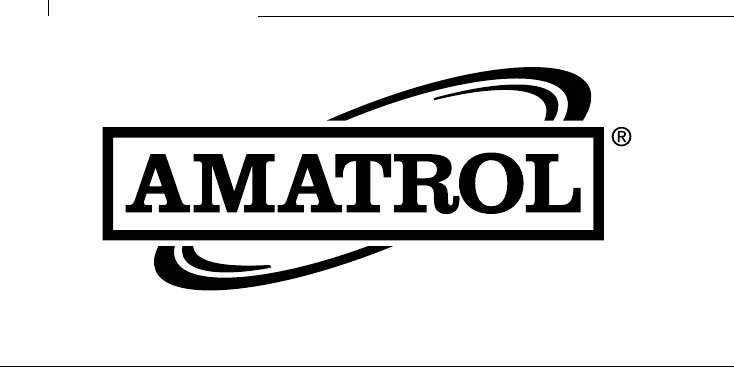
A
matrol creates innovave, interacve technical learning soluons for industry and
educaon to equip technicians and operators with the skills they need to adapt and
thrive in a rapidly-changing workplace. Our passion is to make a dierence in people’s lives.
It permeates our company and unies our acons – we all focus on doing the right thing for
our customers so they can provide the technical training needed to make learners both job
and career ready. Our technical learning systems are ulized by many types of organiza-
ons, including community colleges, industry training centers, high schools, universies,
apprenceship training centers, and vocaonal training and educaon centers.
Technical Learning Solutions
Our learning soluons cover a broad array of topics and programs in depth across many
industries. Some examples are:
Amatrol, Inc.
2400 Centennial Boulevard
Jeffersonville, IN 47130
T. 1 800 264 8285
F. 1 800 283 1582
www.amatrol.com
www.o2ed.com
Benefactor Sponsor
188
“America has a lot of unfilled, high wage jobs. We have a
skill mismatch where smart people do not have the skills
industry needs. I say let’s fix that.”
- Paul Perkins, Amatrol CEO
Electronics
Fluid Power
Automaon
Thermal
Process Control
Construcon
Lean Manufacturing
Packaging
Automove
Power & Energy
Iron and Steel
Mining

Manufacturing Workforce Development Playbook
189
These are developed with industry partner guidance from such companies such as Cater-
pillar, Ford, General Electric, and many more fortune 500 companies. In addion to our
industry partners, we are well grounded in industry needs through our roots in industrial
equipment design and manufacture. As a result, our learning products have strong align-
ment with the skill sets and training needs of industry and include:
eAssessment – An assessment soware portal to allow organizaons to assess an indi-
vidual’s current knowledge level and accelerate learning by idenfying specic training
needed, linkable to Amatrol’s eLearning content.
eLearning – Amatrol’s mulmedia library (962 learning modules across 232 topical areas)
is available anyme, anywhere with internet access.
Industrial Quality Training Systems – Our hands-on training workstaons include
industrial quality equipment that uses industry standard components most common in
work environments. We combine these learning materials with appropriate knowledge
building, detailed hands-on skill instrucons, and instructor assessment guidance to
make learners job ready.
Amatrol is especially known for technology innovaons in training such as electronic fault
inseron. We are able to oer electronic troubleshoong across a broad range of technol-
ogies through our proprietary system, FaultPro. As a skill dicult to teach with tradional
manual faults, it is the skill most in short supply in industry today. Amatrol’s electronic
fault inseron allows instructors to teach students how to problem solve both simple and
complex issues.
Amatrol’s Learning Content is Unmatched for Success
Amatrol’s learning content is created using the best instruconal design pracces to pro-
vide successful training outcomes. We use text, narraon, stunning animaons, and video
to appeal to a wide range of learners. Our learning materials include:
• Detailed Wrien Skill Instrucons – Step-by-step instrucons for all hands-on proce-
dures with explanaons on why the step is important.
• Interacve Mulmedia – Highly interacve mulmedia with meaningful knowledge
building interacons throughout to keep learners engaged.
• Voiceovers – Complete voice of all text gives learners a choice to listen or read as they
work with schemacs and interact with animaons.
• Animaons – Realisc animaons provide insights to processes that are more dicult to
comprehend, such as seeing how hydraulic uid ows through a pressure reducing valve.
• Video – Videos allow learners to actually see a procedure being performed or how a
concept is applied in the workplace.
• Self-Paced Learning – Self-paced learning content allows learners to move at their own
pace, enabling each learner the opportunity to spend as lile or as much me as need-
ed to understand the material.

Technical Certification Preparation
With the demand for technical cercaon on the rise, Amatrol is proud to be a preferred
provider of learning content for many naonally recognized cercaons:
• Associaon for Packaging and Processing Technologies’ Mechatronics
Cercate (PMMI)
• Manufacturing Skill Standards Council’s (MSSC) Cered Producon Technician (CPT)
• Naonal Instute for Metalworker Skills (NIMS). NIMS endorses Amatrol’s CNC Machine
Operator Program exclusively as the recommended preparaon method for the NIMS
CNC Machine Operator Cercaon.
Outstanding Customer Service
Amatrol’s success is built not only on excellent products, but through longstanding custom-
er relaonships. Our customers’ success is our success. We create excellent follow-up and
follow-through in our internal customer service group as well as through our many distrib-
utors located near you, wherever you are. As an award winning American company design-
ing, developing, and manufacturing in southern Indiana, we invite you to visit our facility so
you can meet our employees and experience Amatrol’s unique approach. Stay in touch with
us by vising www.amatrol.com. Use the Subscribe buon at the top of the webpage to
receive our quarterly newsleer on educaonal news and to see our new products.
Benefactor Sponsor
190

Manufacturing Workforce Development Playbook
191
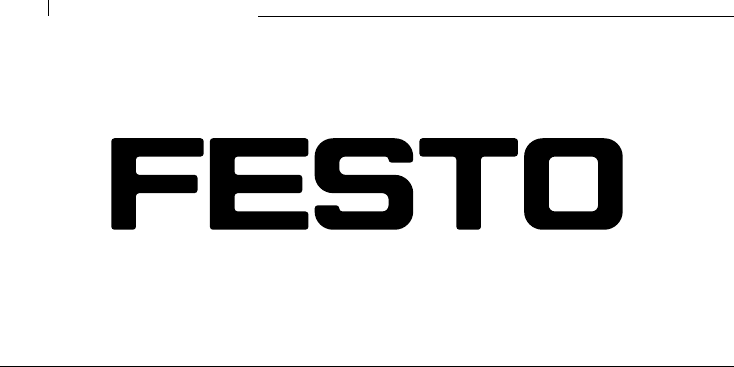
F
esto Didactic—Your Partner for
Skills Development and Consulting
Festo Didacc is a global leader in basic and further training in industry. As a provider
of skills development for manufacturing and process automaon, we oer services that
range from educaonal equipment for training facilies to training and advice for industrial
producon companies.
Our dedicaon to the advancement of automaon extends beyond technology to the
educaon of current and future automaon and roboc designers with simulaon tools,
teaching programs, and on-site services. Festo Didacc is the knowledge and learning
division of Festo Corporaon. Didacc’s charter is to provide automaon technology
training for manufacturing employees at our industrial customers worldwide.
With over 40 years of experience in the area of training and 20 years of experience
in process opmizaon, Festo provides experienced trainers and consultants and the
correct formats and methods to increase your employees’ and your company’s success—
connuously and veriably.
From basic training packages to the planning, control, and handling of complex networked
CIM systems and complete, fully equipped learning centers, we can create a customized oer
to suit your personal requirements for ecient learning and guaranteed results.
Festo Workforce Development
Everything from a single source! Festo provides workshops and corporate strategic planning
simulaons, and open or in-house courses. The main focus is on acve learning based on
actual products and training factories. Individual learning success is measurable, and the rapid
implementaon of the course content in day-to-day work is a decisive quality feature.
Festo
395 Moreland Road
Hauppauge, NY 11788
T. 1 800 99 FESTO
F. 1 800 96 FESTO
www.festo.us/training
Benefactor Sponsor
192

Our range covers all current topics in technical basic and further training:
• Technical training packages
• Learning and simulaon soware
• Courseware
• Modular training factories
• Educaon consulng
These trainings are provided on-site, at our customers’ facilies, as well as at various Festo
facilies throughout the country. Some of our training courses include:
• Fluid power, pneumacs, and hydraulics
• PLC controls troubleshoong and programming
• Mechatronics
• Electronics/electricity
• Sensor technology
• Machine Safety
• Energy savings in pneumac systems
• Customized training courses tailored to specic customer needs
Festo focuses on the total experse with the “People-Technology-Organizaon” model:
People
• Problem-solving processes
• Team facilitaon
• Ecient communicaon
• Intercultural competence
Technology
• Pneumacs, hydraulics
• Control technology
• PLC technology, robocs
• Sensors, closed loop control technology
Organizaon
• Process opmizaon
• Pull producon
• System eciency and setup opmizaon
• Value ow analysis
• Target engineering
Manufacturing Workforce Development Playbook
193

Festo Consulting: Dedicated to Creating Value
Idenfying and opmizing value-creang processes, we jointly monitor the enre
progression of a product through your company. And we always make sure that procedures
are ecient and that wastefulness is avoided. Experienced consultants will employ the
methods and tools being used by global leaders and at Festo.
The topics:
• Product development
• Lean producon
• Procurement and logiscs
• Markeng and sales
• Growth strategies
• Project management
• Connuous improvement processes
• Leadership and teamwork
Industry Specific Expertise
Whether designing new machinery or modernizing exisng systems, Festo can provide
the resources you need to meet your unique requirements in every stage of industrial
producon and manufacturing.
• Automove
• Biotech/Pharmaceucal
• Electronics/Light Assembly
• Flat Panel/Solar
• Food & Beverage
• Lab Automaon
• Prinng, Paper & Converng
• Water/Wastewater
Benefactor Sponsor
194

Manufacturing Workforce Development Playbook
195

M
orrison Container Handling Soluons is the industry leader in the innovave design
and manufacture of ming screws, change parts, custom container handling prod-
ucts, assemblies, and machines for the packaging industry. The company has a well-estab-
lished record of success in solving the most complex container handling problems, always
with Morrison’s support-built-in culture.
Morrison was founded more than 40 years ago when President Nick Wilson saw an
opportunity to advance technical experse and creave problem solving in the packaging
container handling industry. Over me, the company has become the most well-known and
respected name in its eld. One secret? A commitment to innovave educaon and learn-
ing, both for current employees and for students who might one day become employees.
Morrison believes that with an industry-wide focus on and support for educaon and
workforce development iniaves, the future of U.S. manufacturing will be bright, compe-
ve and thriving. The packaging sector is complex, with one individual posion oen requir-
ing various types of engineering skills, technological savvy, and management experience. It
is only by providing students and employees this unique mix of skills required to succeed
that leading companies in the packaging space can hope to excel as well.
Morrison is parcipang in this Workforce Development Playbook as a Benefactor be-
cause the company is passionate about rallying others to support educaon iniaves to
contribute to the success of U.S. manufacturing. What follows are specic programs Mor-
rison has supported. They could very well be a blueprint for other like-minded companies
to support educaon and workforce development iniaves in their professional networks
and communies. This support is crucial to maintaining and building the strength of manu-
facturing in the U.S.
Morrison Container Handling Solutions
335 W. 194th St.
Glenwood, IL 60425
T. 1 708 756 6660
www.morrison-chs.com
Benefactor Sponsor
196

Manufacturing Workforce Development Playbook
197
Focused Post-secondary Education
The cornerstone of Morrison’s eorts toward educaon and workforce development is
its partnership with Purdue University Calumet in Indiana. As with hundreds of other
packaging machinery companies, Morrison needs engineers with a combinaon of skills
not typically taught at the college level. It is common to nd electrical engineers and
mechanical engineers, but incredibly rare to nd a student or graduate well versed in both
elds. Typically companies had to train electrical engineers to be mechanical, or mechanical
engineers to be electrical; Morrison sought a soluon to the problem.
In 2007, President Nick Wilson developed an ongoing partnership with Purdue Calumet
that would in only one short year result in the formaon of the Mechatronics Engineer-
ing Technology Bachelor’s degree program. It took only one trip to PMMI’s Pack Expo for
the University’s Technology Dean and other educators to be convinced that the program
could be a success. And it is a success, both from the university’s perspecve and from
Morrison’s. The University can oer prospecve students a completely unique engineering
program not found at other instuons, and specically geared toward the needs of today’s
manufacturers. Students in the program have a sure-re career path to pursue, and they’re
given opportunies to make contacts throughout the course of their educaon that will
help facilitate job placement upon graduaon. Morrison has ensured itself a stable of qual-
ied engineers, equipped almost immediately upon graduaon to design and implement
the innovave packaging machinery soluons for which the company is well known.
Interns, Interns, Interns
Long before Morrison’s partnership with Purdue Calumet was underway, Morrison already
had a long-standing internship program at the company. In fact, 42 years ago, Morrison’s
rst employee – Steve Smit – was a student. Steve was part of a diversied educaon
program – one that helps prepare students for careers by integrang classroom instrucon
with real-world work experience. Smart and responsible, he worked hard, and the fact
that he had sought out such a program made it clear that he was serious about the work.
Morrison’s President Nick Wilson quickly realized how benecial working with these types
of programs could be, both for his company and for the students. Incidentally, Steve sll
works at Morrison today, and his tenure is truly a testament to how successful this type of
partnership can be.
Morrison connues to seek out interns from a variety of schools and other programs.
Most recently, the company has become involved with a program called MCIP (Manufac-
turing Careers Internship Program), funded jointly by mulple organizaons, including the
Department of Labor. The MCIP focuses on helping out-of-school youths between 18-21
interested in manufacturing nd opportunies in the eld. Morrison’s role as a Manufac-
turing Ambassador gives the company the opportunity to teach interested applicants about
manufacturing careers and the skills required to succeed in these roles. The rst intern as
part of the MCIP program completed his 6-week internship at Morrison in April, and by all
accounts he was a success.

Supporng programs like these is an easy choice for Morrison, since it helps encourage
interest in manufacturing and packaging among young people who may not otherwise
consider the eld. It also allows Morrison to idenfy individuals who have the potenal to
make great employees.
Industry Involvement
One of the easiest ways for packaging industry professionals to become involved in educa-
on and workforce development is through acve membership in PMMI, the Associaon
for Packaging and Processing Technologies.
As Chairman of PMMI in 2011 and 2012 and a longme member of the PMMI Educaon
Commiee, Morrison President Nick Wilson got a rst-hand view of the variety of opportu-
nies PMMI provides member companies to enhance their workforces.
• The PMMI Foundaon provides tuion reimbursement to employees of PMMI member
companies, reimbursing two job-related courses per year, up to $500 per course
• The PMMI Cered Trainer Program is a train-the-trainer program giving companies
strategies for successful in-house training across all skills levels – Morrison has nearly a
dozen PMMI Cered Trainers
• The PMMI Mechatronics Cercate Program tests a workforce for technical skills and
real-world problem-solving ability
• Involvement in the Educaon Commiee and its iniaves gives member companies
exposure to the myriad great programs PMMI sponsors to support educaon: scholar-
ship administraon, JumpStart, student tours, PACK soluons, and more
Addionally, Morrison employees support PMMI through acve involvement in other
PMMI commiees.
Internal Workforce Development
Unfortunately, many companies suspend their eorts once they’ve landed the employee of
their dreams. Morrison believes this is when some of the most important work begins. The
company takes educaon seriously at all levels, and provides 100% tuion reimbursement
for employees to further their educaon and skills. Addionally, Morrison takes advantage
of the aforemenoned cercaon and scholarship programs through PMMI and other
programs, helping dierenate employees to the company’s customers.
All of these iniaves that Morrison seeks out and supports serve two goals: one, a
dynamic, innovave Morrison workforce, and two, the broad but crical goal of keeping
manufacturing jobs in the U.S. The company believes it can help achieve this by bridging
the gap between educaon and praccal applicaon, and supporng educaon and
workforce iniaves wherever it can. It is one of the guiding forces for Morrison now and
into the future.
Benefactor Sponsor
198

Manufacturing Workforce Development Playbook
199
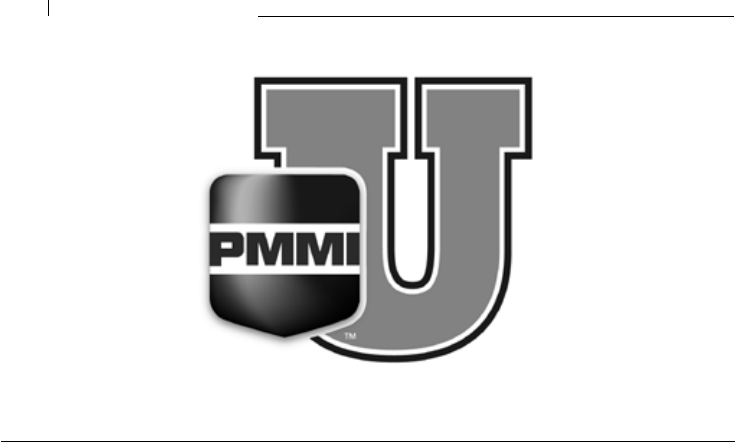
A
Well-Trained Workforce Equals a Strong Industry
As companies along the enre packaging and processing supply chain strive to nd,
train, and retain the top talent in our industry, PMMI provides programming and resourc-
es to enhance and grow your workforce. And in doing so, PMMI builds awareness of the
packaging and processing industry across the United States and in many other countries.
Many of our top-notch educaon and training oerings are available online—so, we make
learning cost eecve, convenient, and exible.
Build a strong foundation
Our eLearning courses teach the basic skills necessary for your operaon. Available 24/7,
these courses provide a strong foundaon for your operators, technicians, and mainte-
nance sta—preparing them for anything that happens on the plant oor.
PMMI’s Learning Management System allows you easy access to our online courses, the
ability to track a student’s progress, and print a cercate of compleon. Our special group
feature makes it easy for managers to track the progress of their sta.
eLearning courses include: Fundamentals of Risk Assessment; Introducon to Packaging
Machinery; Basic Electrical Components; Basic Mechanical Components; Troubleshoong
Packaging Machinery (Available in English and Spanish)
Find talent
PMMI’s job board, Pack Pro Jobs, is highly specialized for the packaging and processing
PMMI U
11911 Freedom Drive, Suite 600
Reston, VA 20190
T. 1 571 612 3200
Pmmi.org/pmmiu
Benefactor Sponsor
200

Manufacturing Workforce Development Playbook
201
industry. Use it to post a job or nd a job. It’s that simple. And it links to other job boards
featuring posions in manufacturing, like Indeed, Ladders, and SimplyHired.
Evaluate knowledge
PMMI’s Mechatronics
Cercate Tests help assess
your workforce for the core
technical skills and real-world
applicaon needed in today’s
manufacturing environment.
Our Mechatronics Tests are a
great hiring tool: have poten-
al employees take a Mecha-
tronics test to make sure they
have the right skills before you
hire them. Mechatronics Cercate Tests are great for current employees, too, giving them
a solid advantage when compeng for a promoon.
Mechatronics is recognized by the U.S. Department of Labor and endorsed by the Naon-
al Associaon of Manufacturer’s Skills Cercaon System.
These tests are based on industry-developed competencies and are taken online. The
tests available are: Fluid Power 1; Industrial Electricity 1; Industrial Electricity 2; Mechanical
Components 1; Programmable Logic Controllers (PLCs) 1
Train well
PMMI’s Cered Trainer Workshop gives companies the strategies and taccs to train well
across all employee skill levels. We currently have 85 machinery manufacturers and CPG
companies that have PMMI Cered Trainers.
Cered Trainer, a leading train-the-trainer program, helps trainers maximize producv-
ity, enhance safety, increase machinery eciency, lower operang costs and reduce waste,
and provide clear documentaon.
PMMI also oers a Customized Workshop, which is designed specically for your compa-
ny. This in-plant workshop is an eecve and praccal way to train several team members.
Assess risk, comply with standards
Risk assessment is crical to meeng industry standards and keeping your customers’ em-
ployees safe. PMMI’s Risk Assessment Workshop gives you the necessary tools to nd out
what standards are essenal and how to apply them at your facility.
Risk assessment is required for compliance to the ANSI/PMMI B155.1-2011 standard
and EU machinery direcve 2006/42/EC. Therefore, PMMI has expanded the scope of the
PMMI risk assessment training to include the important issues that generate the most
quesons from PMMI members.

Honor high achievers
The Packaging Hall of Fame is the packaging and processing industry’s highest honor and
recognizes a lifeme of innovaon and achievement. Awarded every other year, those
chosen are leaders who have dedicated themselves to the industry through expanding
knowledge and volunteer leadership, and have personally advanced the eld of packaging.
The next inductee(s) to the Packaging Hall of Fame is announced at PACK EXPO Internaon-
al this November.
Alliance for Innovation and Operational Excellence
In addion to the strong training programs, The Alliance for Innovaon and
Operaonal Excellence (AIOE), a group founded by PMMI in 2011, brings to-
gether CPG execuves and suppliers to address issues of common concern,
develop soluons and provide tools and guidelines to the industry.
The AIOE has mulple soluons groups addressing best pracces for
Operaonal Reliability, Total Cost of Ownership, Workforce Engagement and three other
areas. The need for eecve workforce engagement is underscored by the connued im-
provement demanded of operaons.
Chaired by Greg Flickenger, Snyder’s Lance VP Manufacturing & Engineering, the Work-
force Development Soluons group has been developing a workforce engagement model
for producon operaons. This model (see Framework) describes the 3 key principles of
Engagement, the six primary aributes and their corresponding characteriscs.
These are discussed in four workplace environments – tradional (top down); beginner;
intermediate; and advanced –that span the workplace engagement connuum. A company
moving toward fuller workforce engagement idenes their posion based on the de-
scripon of each aribute, then gains insight into moving to the next level of engagement.
Leadership guidance is presented.
The team developing this framework has already received strong, posive feedback from
other professional groups focused on workforce engagement. Specic comments reect the
crical need for an engage-
ment model focused on
the manufacturing work-
force. We welcome more
involvement in this area.
Contact Steve Schlegel
(sschlegel@pmmialliance.
org) to become involved.
For more informaon on
all AIOE programs, visit
www.pmmi.org/aioe.
Benefactor Sponsor
202

Manufacturing Workforce Development Playbook
203
Offer support
PMMI Scholarships provide over $100,000 of nancial support each year to students
aending PMMI’s Partner schools (there are currently 28).
Teach. Learn. Grow.
The Amazing Packaging Race is an annual fun and excing event on the PACK EXPO show
oor where teams of college students race against the clock and one another to complete
challenging packaging tasks at exhibitor booths.
In its second year, PMMI hosts a week of interesng and fun plant tours for college students
at machinery manufacturers and end users facilies. In 2013, the annual “How It’s Packaged”
Student Tour hit Greater Chicago; this year, the group heads to Greater Minneapolis.
JumpStart, a grass-roots iniave new in 2013, links equipment and supplier member
companies and their customers with an avenue to connect with students in their local area.
So far, JumpStart chapters have been established in Chicago, Milwaukee, and Minneapolis
by PMMI member companies in those regions. Philadelphia and Tampa are forming later
this year.
Also an annual event at PACK EXPO, PACK Soluons Challenge is a student contest
that pits colleges and universies against one another in creang a packaging soluon to
a complex packaging problem. Experts from CPG companies select the winners. In 2013,
Rutgers University took top prize and received college scholarships supported by sponsor
B&R Automaon; Purdue University Calumet was runner-up, and third place went to
Clemson University.
Make the industry better, stronger
Markeng, sales, and operaonal execuves of PMMI member companies aend our an-
nual MarketTrends Roundtable to keep abreast of trends aecng the industry. Colleagues
collaborate and learn during this interacve, 2-day conference designed and for PMMI
members only. Each roundtable features a new theme; this year’s is Gaining the Edge.
Held annually, PMMI’s Need 2 Know conference on safety, standards, and technology is
open to PMMI members
as well as end users of
packaging and processing
equipment. This 2-day
event provides parci-
pants’ important infor-
maon needed to op-
erate, maintain, design,
and build packaging and
processing machinery in
today’s marketplace.

A
ddressing Today’s Business Challenges Through
Workforce Development Planning
Today, most companies’ goals include maximizing producvity, globalizaon, increasing
innovaon and improving sustainability pracces. To achieve this, investments in advanced
technologies and interconnected systems are being made, but are you invesng in your
most crical asset – your people?
The days of having specialists for each facet of your facility have passed and focus is
now on nding employees with diverse skills to cover a wide range of funcons. Finding
new employees with the right skills to hire is becoming more dicult and the most skilled
employees are nearing rerement age. This worldwide skills gap has contributed to
increased plant downme and decreased producon. Because of this skills gap, preparing
current and new employees for the realies of today’s producon environments has taken
on a much greater importance.
The demands of your businesses are going up and the availability of skilled employees is
going down. Do you have a plan to address these issues? As the world’s largest company
dedicated to industrial automaon and informaon, Rockwell Automaon can help.
We rmly believe with a clear workforce development strategy in place, following our
workforce development model, your business can solve the workforce challenges you face
today. We oer a complete training porolio, with global delivery in local languages.
Not Just a Catalog of Classes – A Holistic Approach to Training
Businesses oen see employee talent as a cost rather than an investment; we’re changing
that percepon. With dedicated plans and strategies, your business cannot only realize the
benets of a loyal and more producve workforce, but you will be able to measure it with
Rockwell Automation, Inc.
1201 South Second Street,
Milwaukee, WI 53204-2496
T. 1 440-646-3434, Select Option: Customer Training.
www.rockwellautomation.com
Benefactor Sponsor
204

key metrics to show your return on investment.
Important quesons to consider:
• Can you create a training strategy based on data rather than historical preferences
or opinion?
• Do you know the workforce’s current skill and knowledge levels prior to invesng
in training?
• Can you idenfy individuals who have the potenal to be exemplary performers?
• Have you jused training expenditures that relate to improving producvity,
generang a return on investment, or bringing the best results?
Assess: The First Step to Developing Your Workforce
Understanding the current skills across your workforce is the rst step to truly verifying
and execung your plan for workforce development. Your employees are individuals with
varying levels of knowledge, so in order to ll gaps you need to properly assess and create a
specic plan to train based on job tasks.
Training Advisor
Training Advisor helps you determine a tailored training path for your workforce to obtain
the knowledge required to successfully improve on-the-job performance. This online
tool helps you idenfy knowledge gaps hindering producon performance and develop a
training strategy that maximizes job performance and eecveness.
• Verify knowledge levels of new hires and determine ways for closing any skill gaps
• Gauge workforce knowledge in areas such as controllers, networks, moon control,
drives control, safety, visualizaon, process control and general industrial control
• Create a strategic training plan with a recommended list of specic courses to meet
each employee’s parcular needs
• Prepare your workforce for new automaon technology and develop a specic
training plan
Integrated Performance Assessment
An integrated performance assessment is a comprehensive on-site analysis of employees’
job skills and knowledge levels of automaon and control equipment for specic jobs
and tasks (maintenance, programming, etc.). It includes supporng informaon and
recommendaons to improve your employees’ performance while remaining closely
aligned to your company’s business and training goals.
Manufacturing Workforce Development Playbook
205

You may want to consider an Integrated Performance Assessment if you:
• Need to obtain a clear understanding of where you have workforce
competency deciencies
• Require a more comprehensive and hands-on soluon for assessing your
workforce needs
• Desire customizaon of knowledge assessments based on your specic equipment
and job tasks
Train: Taking Action to Fill Your Workforce Knowledge Gaps
We provide a comprehensive selecon of rst class industrial automaon and cra skills
courses to meet your changing needs.
• Open Enrollment: Over 200 instructor-led courses can be conducted at a Rockwell
Automaon locaon. Courses are designed around the use of automaon technologies
and job funcon.
• Private Classes: Along with your tradional Open Enrollment courses, Private Classes
give the ability for course delivery to be in your own facility. These classes include cra
skills and mechanical concepts courses to develop core competencies, fundamentals,
advanced fundamentals and equipment specic skills.
• Virtual Classroom: Just like our tradional open enrollment oering, only provided live
online rather than in person. These classes oer locaon exibility so employees can
limit their me away from work without compromising the interacve experience.
• Custom Courses: We can help you develop a custom curriculum based on your
automaon environment. Your employees will be taught by a highly-skilled Rockwell
Automaon instructor, but the instructor will incorporate your automaon equipment,
soware and system conguraon for a custom experience.
• E-Learning: In addion to the instructor-led opons that Rockwell Automaon oers,
computer-based e-learning soluons are available as well. Using e-learning, your
employees receive the exibility to avoid travel costs and me away from producon.
• Web-Based: Ideal vehicle for delivering training to individuals anywhere in the world
at any me and allows on-demand training stored in a server and accessed across a
network via the Internet. This opon allows you to customize the pacing and direcon
of the courses your employees experience.
• iBooks: Truly a self-paced, independent and immersive learning experience. Each iBook
walks you through the fundamentals of automaon from the convenience of an iPad.
iBooks are available for download through the iTunes iBooks Store.
Apply & Measure:
Continuous Learning for Continuous Improvement
A pillar of our approach to workforce development is that even though a specic training
acvity may end, learning does not. Aer implementaon of your training strategy, there
Benefactor Sponsor
206

Manufacturing Workforce Development Playbook
207
needs to be a level of engagement for your employees to connue their development
and polish their newly learned skills. Subsequent measurement of the results of training
engagements is also crucial.
Apply
Begin to see Results and Applicaon of Knowledge from Learning Engagements
• Workstaons: Training workstaons are the ideal tool to reinforce and pracce
maintenance, troubleshoong and programming skills, train new employees on your
technologies and ease the transion from one technology to another.
• Job Aids: Our award-winning job aids provide your employees with essenal job task
informaon, thereby minimizing errors that can occur at the most inopportune moments.
• Troubleshoong App: This app walks your employees through a variety of faults and
issues that can arise in a producon environment. Full of procedures, error code
informaon, recommended acons and hardware/soware diagrams, your employees
can supplement their formal knowledge on their iPhone or iPad. Apps are available for
download through the iTunes App Store.
Measure
Understand the Value of Your Workforce Development Investment
• ROI Tool: The ROI Forecasng tool includes common manufacturing metrics related to
producon, quality and service that are impacted by employee training.
• Pre and Post Tesng: We can oer pre and post tests as standalone oerings aer
private classes are executed to see if your employees lled their knowledge.
• Cercate Programs: Cercate programs oer professional recognion and help your
employees develop and apply technical skills and knowledge to your plant.
Real Soluons
Rockwell Automaon helps our customers become more producve and the world more
sustainable. We can help increase the consistency, experience and competency of your
employees to improve enterprise-wide producvity and protability.

Educational
Sponsors
Manufacturing
Workforce
Development
Playbook

Our thanks to these organizations for their
sponsorship of the Playbook. A portion
of net proceeds will go to the David A.
Harvey Memorial Scholarship to help fund
workforce development efforts.
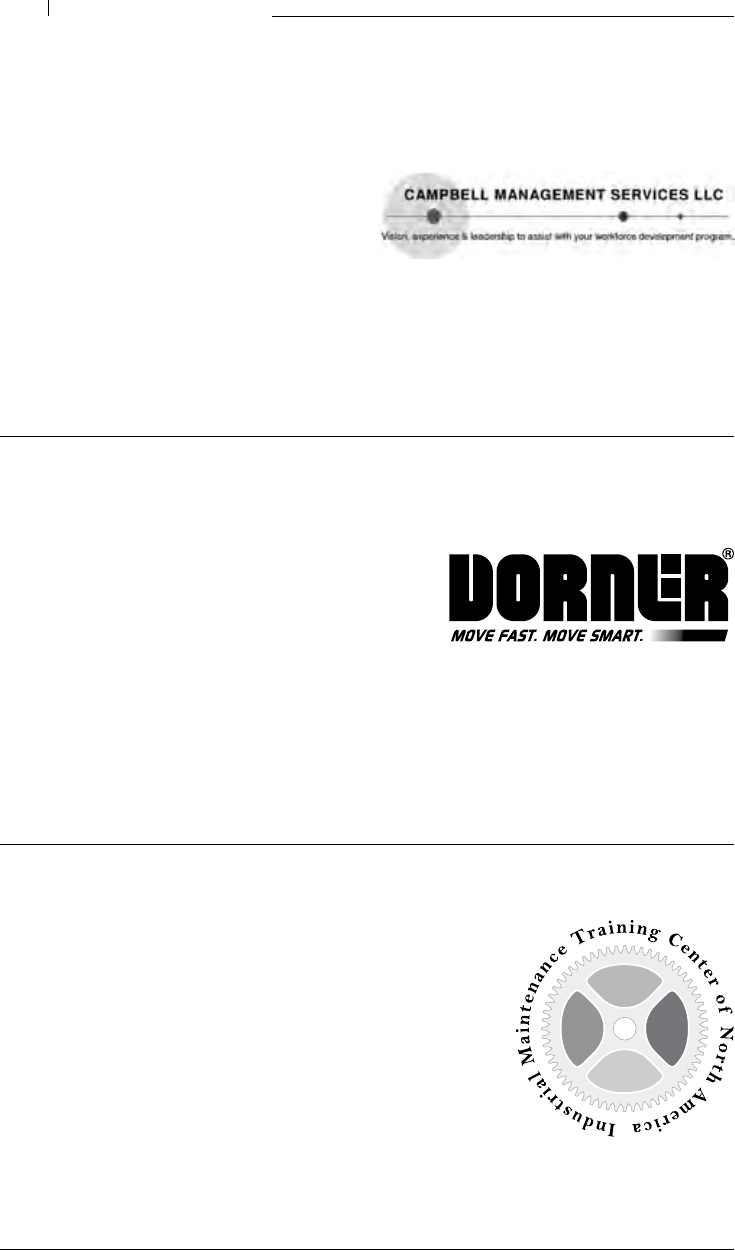
Dorner Mfg. Corp.
Campbell Management Services LLC
From Precision Indexing to
Small Product Transfers,
Smart Solutions Moving Your
Product with Speed & Care.
Vision, experience & leadership
to assist with your workforce
development program.
Industrial Maintenance Training
Center of North America
975 Cottonwood Ave
Hartland, WI 53029
United States
T. 800 397 8664
F. 800 369 2440
www.dorner.com
6 Highland Drive
Palmyra, PA 17078
United States
313 W. Liberty St. Suite 114
Lancaster, PA 17603
United States
T. 717 735 0333
www.imtcna.com
Educational Sponsors
210
Industrial Maintenance
Training Center of NA
www.campbellmanagementservices.com
www.linkedin.com/in/keithcmsllc
www.ontheedgeblog.com
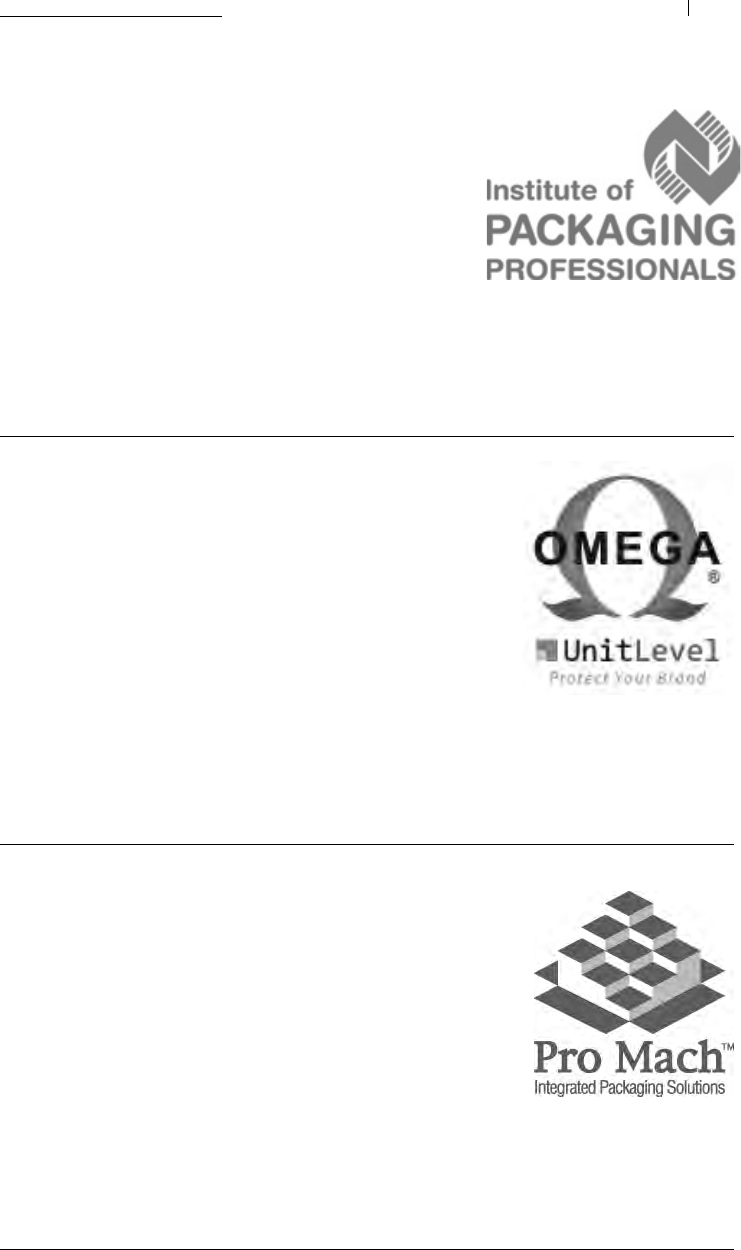
Omega
Design Corp.
Integrated Packaging Solutions
211 Philips Rd
Exton, PA 19341
United States
T. 610 363 6555
www.omegadesign.com
1833 Centre Point Circle
Suite 123
Naperville, IL 60563
United States
T. 630 544 5050
www.iopp.org
6279 Tri-Ridge Boulevard,
Suite 410
Loveland, OH 45140
United States
T. 866 PRO MACH (776-6624)
www.ProMachInc.com
Manufacturing Workforce Development Playbook
211
Institute of
Packaging
Professionals
Pro Mach, Inc.
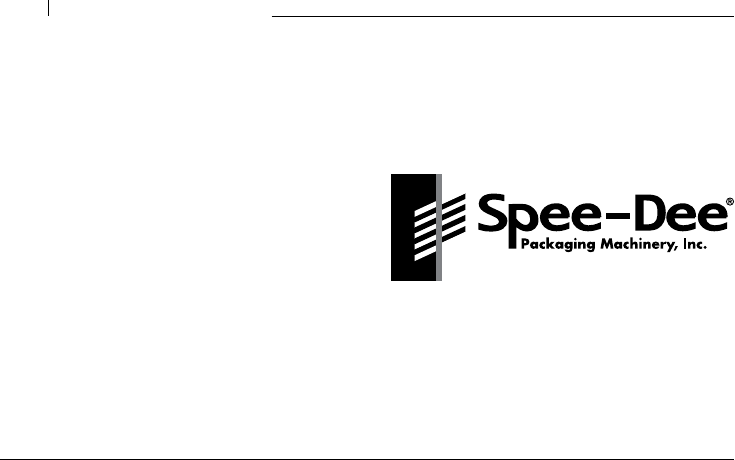
Educational Sponsors
212
Spee-Dee Packaging
Machinery, Inc.
Superior Dry Filling Systems
and Solutions
1360 Grandview Parkway
Sturtevant, WI 53177
United States
T. 877 375 2121
F. 262 886 5502
www.spee-dee.com

213
Manufacturing Workforce Development Playbook

K
eith S. Campbell, creator and editor of this Playbook, has been a contribung
editor to Packaging World and writer of OnTheEdgeBlog since rering from The
Hershey Company aer a career of 28 years. While there, he worked on several
projects with Packaging World that highlighted Hershey’s use of advanced manufacturing
technology. At rerement, Keith was Senior Director of Automaon & Integraon
Engineering, from which posion he led an engineering sta, led the corporaon’s
manufacturing technology planning acvity, and served as a member of the capital
investment commiee. Previous to that, he was a Director in Corporate Informaon
Technology, serving as Relaonship Manager for the manufacturing, engineering, R&D,
and quality business units. He served the automaon industry as Director of ISA’s Food
and Pharmaceucal Industries Division and was the founding director and later Execuve
Director of the OMAC Packaging Workgroup.
Earlier, Keith spent 13 years in various maintenance and engineering roles in the world’s
largest chocolate factory. In the early 70s he led an eort to develop maintenance strategies
for transioning from electro-mechanical automaon through electronic automaon and on
to programmable automaon. He installed PLCs in the mid 70s followed by microcomputers
and factory networks. In the mid 80s he speculated on the potenal for mechatronics
(although no one had that word yet) and spearheaded the applicaon of mechatronics for
packaging in the late 80s and early 90s. He was chief systems architect for a Greeneld
confeconery plant that employed DCS, PLC, and computer automaon technologies to
empower the workforce. With Keith’s work at the leading edge of manufacturing automaon,
workforce development has always been an area in which he has been involved.
About Keith S. Campbell

Keith currently operates Campbell Management Services, LLC, a rm providing guidance
related to manufacturing technology planning, workforce development, and organizaonal
development. His clients include manufacturers, technology providers, machine builders,
professional associaons, schools, and workforce agencies. Keith has had the opportunity
to see educaon and workforce development from many points of view as he visits, audits,
and advises technical high schools, community colleges, and universies. He has worked
with many of the contributors to this book. He works with naonal associaons, regional
Workforce Investment Boards, and economic development agencies, and he frequently
speaks and writes on topics related to manufacturing workforce development.
Keith holds a B.S. Cum Laude in Physics from Rensselaer Polytechnic instute. His
background in physics and systems engineering has contributed to his rejecon of pursuing
technology in silos. He is an outspoken advocate for mechatronics in manufacturing and
for muldisciplinary industrial maintenance.
Keith lives near Hershey, PA, with his wife of 43 years. Fran has been acve in community
development and was the chief fund-raiser and project manager of a project to build a
new town square in their town. Before Keith founded his company, she recruited him and
two other recently-rered engineers to oversee the construcon. Keith and Fran have two
grown children. Their son Troy aended high school at a regional career center where
he apprenced in a number of manufacturing shops before going on to the PA College of
Technology, where he pursued a dual major in Automated Manufacturing and Machine Tool
Technology. He is a cered farrier (blacksmith) and is employed as a machine tool service
engineer with DMG Mori. Daughter Leanne Berget and her husband, Todd, are graduates
of compeng ivy-league schools, Cornel and Columbia, and are both involved in design
and construcon in the Annapolis/Washington D.C. area. Granddaughter Norah is a great
joy, and a second grandchild is expected soon. Keith has beneed signicantly from the
experiences of his extended family in understanding the needs, similaries, and dierences
of the manufacturing and construcon industries, and wants to acknowledge the support
and guidance of his family in the preparaon of this Playbook.
In addion to his work and family interests, Keith restores anque automobiles and sails
a Tartan 3400 sailboat on the Chesapeake Bay. He judges youth engineering and science
fairs and over the years has been involved with many church and scoung youth acvies.
His work is movated by the belief that a vibrant manufacturing sector is essenal to the
economic future of America, his children, and grandchildren. This Playbook evolved from a
commitment to that belief.
You can follow Keith on his blog at www.OnTheEdgeBlog.com, on LinkedIn at www.
linkedin.com/in/keithcmsllc, or you may reach him by e-mail at Campbell@Packworld.com.

M
anufacturing Workforce Development Playbook could not come at a more crical me for manufacturing
companies. As a manufacturer with plants in several states, I can tell you that the topics and details covered
here provide guidance that is universal for all locaons and opportunies. The hiring, development, and retenon
of manufacturing jobs requires the proacve methods presented in this Playbook. Each secon takes a praccal,
real-world approach that is easily translated into a variety of situaons.
Kevin Myers, Director of Purchasing, Utz Quality Foods, Inc.
T
here is no topic more important than the future of Manufacturing in the U.S., and this book nails how to
strengthen it: By reframing both our educaonal approach to growing a high-producvity manufacturing
workforce and by clearly communicang the desirability of manufacturing careers.
While many people assume that the U.S. long ago gave away all manufacturing to China – the truth is that it
wasn’t unl about 2010 that the value add of goods manufactured in China equaled that of the U.S. The further
truth is that we created that value here with just 10% of China’s workforce. (Source: World Bank data shared
at the 2012 MIT LGO Conference). High producvity trumps cheap labor every me. It is crical for the U.S. to
revitalize technical educaon in high schools, vocaonal schools, and two- and four-year university degrees to build
and maintain a high-producvity work force.
From the must read opening arcle by Fogarty thru strong supporng arcles on virtually every facet of our
technical educaon system as it pertains to building a high-producvity work force, this book is worth reading, and
the format facilitates using it as a future reference.
James A. Keighley, PE, Vice President of Engineering, Kraft Foods
